This report details the activities and achievements of the Ministry of Personnel, Public Grievances & Pensions for the fiscal year 2016-2017. It covers various departments including Personnel & Training, Administrative Reforms & Public Grievances, and Pensions & Pensioners’ Welfare. Key initiatives include reforms in government policies, enhancement of e-governance, management of public grievances, and promotion of training programs for government officials. The report also highlights efforts in areas such as the progressive use of Hindi, staff selection, and administrative tribunal functions.
SOURCE PDF LINK :
Click to access AnnualReport_2016-17_ENG.pdf
Click to view full document content
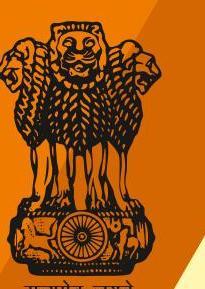
ANNUAL REPORT 2016-2017
MINISTRY OF PERSONNEL, PUBLIC GRIEVANCES & PENSIONS
GOVERNMENT OF INDIA
.
ANNUAL REPORT 2016 – 2017
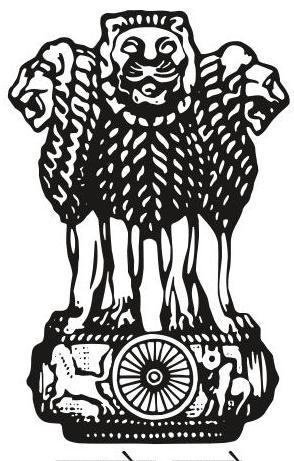
Ministry of Personnel, Public Grievances and Pensions
Government of India
.
CONTENTS
| List of chapters | Page Nos. | |
|---|---|---|
| Vision and Mission | ||
| Executive Summary | ||
| DEPARTMENT OF PERSONNEL AND TRAINING | ||
| 1 | Overview | 01 |
| 2 | Major Initiatives/Achievements/Events during the year | 07 |
| 3 | Personnel Policies | 23 |
| 4 | Reservation in the Central Government services | 51 |
| 5 | Cadre Management | 58 |
| a) Indian Administrative Service (IAS) | 58 | |
| b) Central Secretariat Service (CSS) | 63 | |
| c) Central Secretariat Stenographer Service (CSSS) | 67 | |
| d) State Reorganisation | 68 | |
| 6 | Senior Appointments under Government of India | 72 |
| 7 | Training Policy and Programmes | 77 |
| 8 | Training Institutions | 89 |
| 9 | Administrative Vigilance Division | 106 |
| 10 | International Cooperation | 115 |
| 11 | Central Bureau of Investigation | 119 |
| 12 | Joint Consultative Machinery | 131 |
| 13 | Administrative Tribunals | 133 |
| 14 | Staff Welfare | 138 |
| 15 | Right to Information | 147 |
| 16 | Grievance Redressal Mechanism & Citizens’ Charter | 153 |
| 17 | Progressive Use of Hindi in Official Works | 155 |
| 18 | Financial Management | 159 |
| 19 | DEPARTMENT OF ADMINISTRATIVE REFORMS AND PUBLIC GRIEVANCES | 167 |
| 20 | Administrative Reforms | 178 |
| 21 | Public Grievances | 181 |
|---|---|---|
| 22 | Organisation and Methods Division | 191 |
| 23 | E-Governance | 192 |
| 24 | International Exchange & Cooperation (IE&C) | 194 |
| 25 | Documentation and Dissemination Division (D&D) | 201 |
| 26 | Hindi Section | 206 |
| 27 | DEPARTMENT OF PENSIONS AND PENSIONSERS’ WELFARE | 207 |
| ANNEXURES | 218 | |
| 28 | Department of Personnel and Training | 219 |
| Annexure I – Incumbency Position of Under Secretary level Officers and above in DoPT | ||
| 29 | Department of Administrative Reforms and Public Grievances (DARPG) | 223 |
| Annexure II – Organisational Chart of DARPG | 223 | |
| Annexure III – Incumbency position of Under Secretary level officers and above in DARPG | 224 | |
| Annexure IV – Prevention of Sexual Harassment of Women at Workplace | 225 | |
| Annexure V – Welfare of SC, ST, OBC and Person with Disability(PWD) | 226 | |
| 30 | Department of Pensions and Pensioners’ Welfare | 227 |
| Annexure VI – Organisation Chart | 227 | |
| Annexure VII – Incumbency Position of Group ‘A’ officers in D/o PPW | 228 |
Ministry of Personnel, Public Grievances and Pensions Department of Personnel & Training
Vision
To create an enabling environment for the development and management of Human Resources of the Government for efficient, effective, accountable, responsive and transparent and ethical governance.
Mission
Development and management of government personnel by attracting the best talent, providing excellent career advancement opportunities, encouraging competence and innovation, adopting a dynamic framework of personnel policies and procedures, ensuring capacity building at all levels, inculcating and supporting a culture of transparency, accountability and zero tolerance of corruption in public affairs, and institutionalizing a system of continuous and constructive engagement with stake-holders to make the public services in India more efficient, effective, accountable and responsive.
.
EXECUTIVE SUMMARY
The Ministry of Personnel, Public Grievances and Pensions is the nodal Ministry responsible for personnel matters, especially in respect of issues concerning recruitment, training, career development, staff welfare and the post retirement dispensation. The Ministry also works towards promotion of responsive, peopleoriented and modern administration.
The Ministry comprises three Departments:
(i) Department of Personnel and Training (DoP&T)
(ii) Department of Administrative Reforms and Public Grievances (DARPG)
(iii) Department of Pensions and Pensioners’ Welfare (DPPW)
DEPARTMENT OF PERSONNEL \& TRAINING
Various wings of DoP\&T are as under:
- Establishment Officer’s (EO) Wing
- Services \& Vigilance (S\&V) Wing
- Establishment (Estt.) Wing
- Training (Trg.) Wing
- Administration Wing
The Establishment Officer’s Wing deals with the matter relating to senior appointments under the Government of India requiring approval of the ACC.
The Services \& Vigilance Wing handles matters relating to Cadre Management of All India Services and acts as the nodal agency in the arena of vigilance and anti-corruption. This wing in addition to governing the implementation of RTI Act, also handles the administrative matters relating to the Administrative Tribunals and Central Information Commission. This wing also handles the work related to Cadre Restructuring in respect of the other Central Services.
The Establishment Wing is responsible for framing and revising rules and regulations regarding service conditions of the employees and personnel policies of the Central Government employees other than All India Service Officers. This wing also handles the work related to Civil Services Officers’ Institute (CSOI).
The Training Wing acts as the nodal agency for training of Government functionaries and is primarily responsible for formulating policies with regard to training.
Administration Wing deals with the matters related to Cadre Management of the Central Secretariat Service, Central Secretariat Stenographers Service and the Central Secretariat Clerical Service. This wing, also handles the administrative matters relating to the State Reogranization, Reservation Policy of the Government and Welfare Activities for benefit of the employees of the Government except CSOI.
The Department of Personnel & Training also handles the administrative work relating to the following Institutions: –
- Union Public Service Commission
- Central Vigilance Commission
- Lokpal
- Central Administrative Tribunals
- Central Information Commission
- Central Bureau of Investigation
- Staff Selection Commission
- Public Enterprises Selection Board
- Lal Bahadur Shastri National Academy of Administration
- Institute of Secretariat Training \& Management
DEPARTMENT OF ADMINISTRATIVE REFORMS \& PUBLIC GRIEVANCES
The Department of Administrative Reforms and Public Grievances is the nodal agency of the Government of India for administrative reforms as well as redressal of public grievances relating to the States in general and those pertaining to the Central Government agencies in particular. The Department endeavours to document and disseminate successful governance practices by way of audio-visual media and publications. The Department also undertakes activities in the field of international exchange and cooperation to promote public service reforms. There are 7 Divisions in the Department namely Administrative Reforms, Organization \& Methods, E-Governance, Documentation \& Dissemination, International Cooperation, Administration \& Coordination and Public Grievances.
DEPARTMENT OF PENSIONS AND PENSIONERS’WELFARE
The Department of Pension \& Pensioners’ Welfare was set up in 1985 as part of the Ministry of Personnel, Public Grievances and Pensions to formulate policy and coordination of matters relating to retirement benefits of Central Government employees (Civil, Defence and Railway Pensioners).
Chapter 1
OVERVIEW
1.0 The Ministry of Personnel, Public Grievances and Pensions acts as the formulator of policies pertaining to recruitment, regulation of service conditions, and deputation of personnel besides advising all organizations of the Central Government on issues pertaining to personnel management. The Organizational chart of the Department is at next page.
Major Initiatives/Achievements/Events during the year (Chapter 2)
1.1 Major Initiatives/Achievements during the period April 2016 – January, 2017 have been brought out in Chapter 2.
Personnel Policies (Chapter 3)
1.2 The Department is responsible for framing rules and regulations governing service conditions including recruitment rules, promotions and seniority, Flexible Complementing Scheme, Leave Travel Concession, deputation and Child Care Leave of employees. Personnel are recruited for the Central Government by the Union Public Service Commission through competitive examinations conducted by them for appointments to higher civil services and through the Staff Selection Commission of non-gazetted staff in Group ‘B’ & ‘C’ categories.
Reservation (Chapter 4)
1.3 In order to achieve the objective of upliftment and welfare of the Scheduled Castes
and Scheduled Tribes, Other Backward Classes and Persons with Disabilities, the Department frames policies to provide reservation to these groups in various Central Government services and for monitoring its implementation.
Cadre Management (Chapter 5)
1.4 This Department is responsible for management of the cadres of All India Services (AIS) (IAS, IPS and IFS) and all three Secretariat Services namely Central Secretariat Services (CSS), Central Secretariat Stenographers’ Services (CSSS) and Central Secretariat Clerical Services (CSCS). In addition, this Department frames and also revises Rules and Regulations regarding conditions of the All India Services, such as Indian Police Service (IPS) and Indian Forest Service (IFS), in consultation with the Ministry of Home Affairs and Ministry of Environment, Forest and Climate Change respectively. This Department is also responsible for cadre review of 59 Central Group ‘A’ Services on a periodic basis.
Senior Appointments under the Government of India (Chapter 6)
1.5 The Department deals with appointments at senior level and personnel policies of the Government of India. All proposals for senior appointments under the Government of India, which require the approval of the Appointments Committee of the Cabinet (ACC), are processed by the Department. These include board level
appointments to Central Public Sector Undertakings and appointments under the Central Staffing Scheme for posts of Joint Secretaries, Directors and Deputy Secretaries in Ministries
/Departments. In addition, all appointments by promotion, which require the approval of the ACC, are also processed by the Department.
Organisation Chart for Department of Personnel & Training
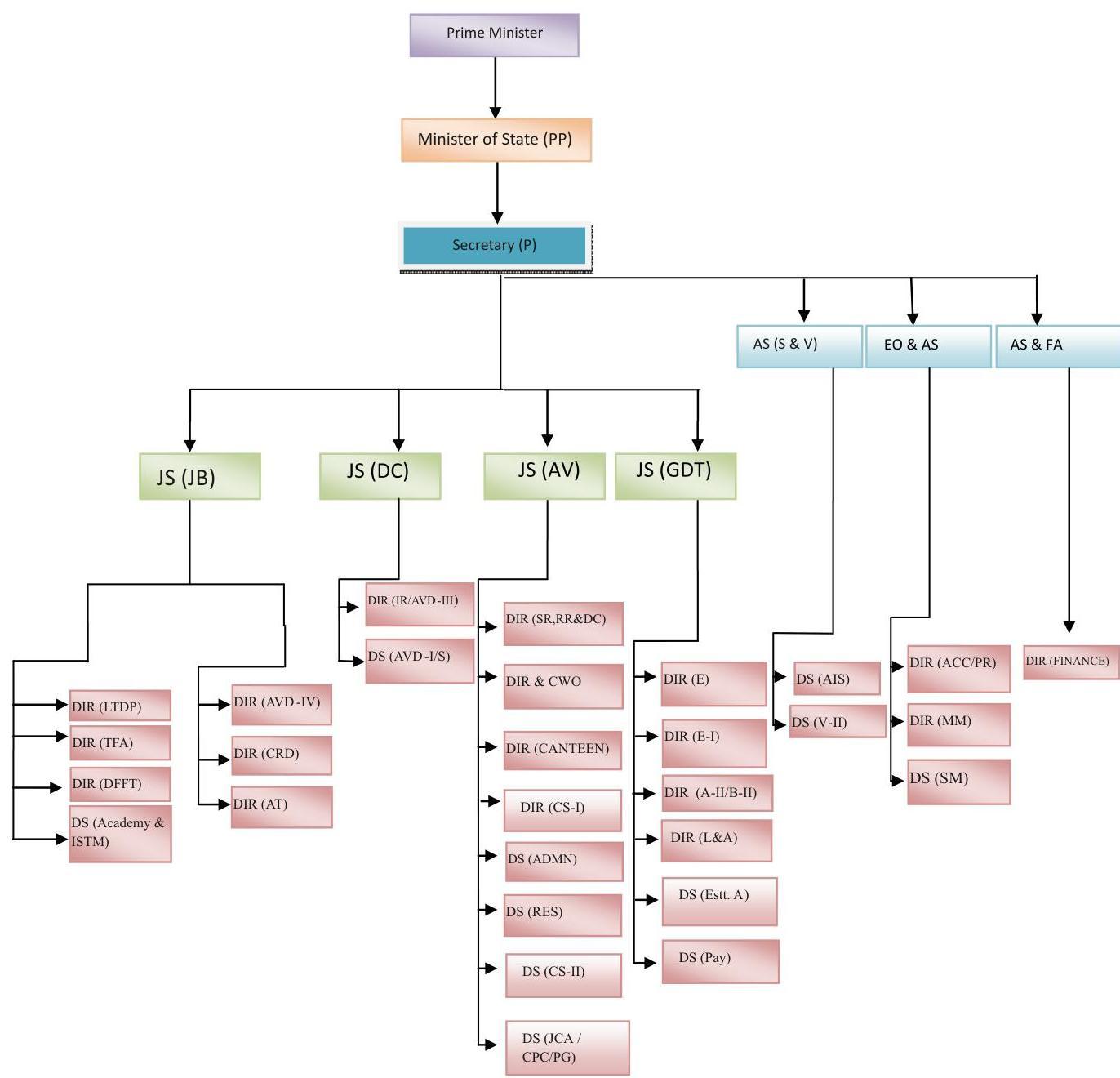
| Abbreviations Used in the Organization Chart | |
|---|---|
| ACC | Appointments Committee of Cabinet |
| AVD | Administrative Vigilance Division |
| ADMIN | Administration |
| AIS | All India Services |
| AS | Additional Secretary |
| B&C | Budget \& Coordination |
| CS | Central Secretariat |
| CPC | Central Pay Commission |
| CRD | Cadre Review Division |
| CWO | Chief Welfare Officer |
| DFFT | Domestic Funding of Foreign Training |
| DS | Deputy Secretary |
| DIR | Director |
| E | Establishment |
| EO | Establishment Officer |
| IR | Information Rights |
| JS | Joint Secretary |
| JCA | Joint Consultative Machinery and Arbitration |
| LTTP | Long Term Training Programme |
| L\&A | Leave Allowances |
| MoS | Minister of State |
| MM | Middle Management |
| PR | Personal Records |
| PIIA | Pathways for an Inclusive India Administration |
| PESB | Public Enterprises Selection Board |
| PP | Personnel \& Pension |
| RES | Reservation |
| RR\&DC | Redeployments \& Retraining \& Departmental Council |
| S\&V | Services \& Vigilance |
| S | Services |
| SM | Senior Management |
| SR | State Reorganization |
| TRG | Training |
| V | Vigilance |
Training Policy and Programmes (Chapter 7)
1.6 The Department is the nodal Department to impart training to the government functionaries. The Training Wing of the Department formulates policies and implements its training programmes by identifying areas of training, designing training programmes, development of trainers and training capabilities and administering policies in training. Major training activities undertaken during the year are (i) In-service training of IAS officers (ii) Mid-Career Training of IAS Officers (iii) Domestic Funding of Foreign Training (iv) Post Graduate Programmes in Public Policy (v) Training Support, (vi) Intensive Training Programme, (vii) Augmentation of the Capacity of training institutions (viii) Capacity Building for poverty reduction (ix) Distance and e-learning initiatives and (x) e-Governance initiatives.
Training Institutions (Chapter 8)
1.7 Lal Bahadur Shastri National Academy of Administration (LBSNAA), Mussourie, Uttarakhand and Institute of Secretariat Training and Management (ISTM), Delhi are two premier training institutions, attached to this Department. These institutes cater to the needs of human resource development by imparting training to all officers of Central Government at frequent intervals for their career progression. The Department also supports the Indian Institute of Public Administration (IIPA) which is an autonomous organisation, in undertaking advance training programmes for administrators as well as researchers on issues relating to public administration.
Administrative Vigilance Division (Chapter 9)
1.8 The Department is the nodal agency responsible for formulation and implementation of vigilance and anti-corruption policies of the Government. Administrative Vigilance Wing in the Department oversees government programme for maintenance of discipline and eradication of corruption from public service. The Central Vigilance Commission (CVC) advises the Central Government on all vigilance matters. The jurisdiction of the Commission extends to all the organisations to which the executive powers of the Union of India extend.
International Cooperation (Chapter 10)
1.9 The Department of Personnel and Training is the nodal Department for anti corruption. To deal with international cooperation on these aspects an International Cooperation Cell was created in this Department. The primary tasks of this Cell emanate from the follow up to the ratification of the United Nations Convention Against Corruption (UNCAC) and the other consequential international collaborative efforts, on global platforms. This Cell acts in conjunction with specialized agencies like the Central Bureau of Investigation, the Enforcement Directorate and the other line Ministries entrusted with the specific ancillary tasks within their respective administrative domain, viz. corporate governance, extradition matters, prevention of money laundering, mutual legal assistance treaties etc.
Central Bureau of Investigation (Chapter 11)
1.10 Central Bureau of Investigation (CBI) was set up by the Government of India by a Resolution dated April 1, 1963 to not only investigate cases of
bribery and corruption, but also violation of central fiscal laws, major frauds relating to Government of India Departments, Public Joint Stock Companies, passport frauds and serious crimes committed by organized gangs and professional criminals. CBI was further strengthened by the addition of Economic Offences Wing by the Government of India by Resolution dated February 2, 1964.
Joint Consultative Machinery (Chapter 12)
1.11 The Government provides for a Joint Consultative Machinery for joint consultation at three levels between the Central Government and its employees for promoting harmonious relations and securing optimum level of co-operation between the Central Government and its employees in matters of common concern. The objective is to increase the efficiency of public services along with the well-being of the employees. The three tiers are:
a) National Council – at the apex level, functioning under the Department of Personnel and Training.
b) Department Councils – functioning at the level of the Ministries / Departments.
c) Office Councils – functioning at offices/organisations under various Ministries / Departments.
1.12 The Scheme has proved to be an effective forum for amicable settlement of grievances of the Central Government employees relating to their service matters etc.
Administrative Tribunal (Chapter 13)
1.13 In order to provide speedy and inexpensive justice delivery system to the employees who feel
aggrieved by Government decisions, the Government set up the Central Administrative Tribunal (CAT) in 1985, which now deals with all cases relating to service matters. The CAT has 17 regular benches, 15 of which operate at the Principal seats of High Courts and the remaining two are at Jaipur and Lucknow.
Staff Welfare (Chapter 14)
1.14 The Central Government being the largest single employer in the country discharges its responsibility for looking after the welfare of employees through various welfare measures. The Department also extends support to various staff welfare measures. The DoPT is the nodal Department for four registered societies set up for the welfare of the Government employees and their families. In addition, the Department lays down policies for Departmental Canteens and supports the Resident Welfare Associations.
Right to Information (Chapter 15)
1.15 The Department has brought out a comprehensive law in order to ensure right to information to the citizens of India in almost entire matters of governance at all levels from Central Government to the local self-government. The Law (RTI Act, 2005) has provided a mechanism where the Central Information Commission, being the apex body at the Centre, facilitates its citizenry in accessing information in a time bound, hassle free and affordable manner.
Grievance Redressal Mechanism & Citizens’ Charter (Chapter 16)
1.16 DOP\&T has identified some of the core services being offered by its various divisions and
their standards for the purpose in its first charter. This has been undertaken by a Task Force in consultation with the Stakeholders. While identifying the services the focus has been on measurable and verifiable services and their standards. The charter contains Grievance Redress Mechanism related to the services mentioned in the Citizens’/Clients’ Charter. The Charter also provides links for other grievances which are not related to the Citizens’/Clients’ Charter. Time lines have been prescribed for final disposal of the complaint arising out of the Citizens’/Client’s Charter.
Progressive Use of Hindi (Chapter 17)
1.17 The Department is fully committed to promote the use of Hindi as the official language, in official matters and motivate compliance of the provisions of the Official Language Act, 1963, the rules framed thereunder. The Department also ensures that the spirit of various orders and guidelines issued by the Department of Official Language is appropriately enforced for
implementation of the official language policy of the Union. The Department has an Official Language Division which monitors the implementation of the policy in the Department.
Financial Management (Chapter 18)
1.18 In order to promote the various programmes administered by Ministry of Personnel , Public Grievances and Pensions , an annual allocation of Rs. 258.00 crores was made in the Annual Plan/ Scheme Outlay for the year 2016-17 (RE 2016-17) and Rs. 1000.00 crores under Non-Plan/Non -Scheme allocation for the year 2016-17 (RE 2016-17). The corresponding figures for 2017-18 are Rs. 340.00 crore as annual Scheme Outlay & Rs. 1083.00 crore under NonScheme allocation. The requirements and priorities of its attached and subordinate offices were kept in view while making budgetary allocation to them by this Department. 1 PAC para is pending in this Ministry. However, no C\&AG Para is pending.
Chapter 2.
Major Initiatives/Achievements/ Events during the year
Posting of the second batch of IAS Officers as Assistant Secretary in Government of India:-
2.1172 IAS officers of 2014 batch were posted as Assistant Secretary in the Ministries/Departments of Government of India for a period of 3 months from 01.08.2016 to 31.10.2016 on Central Deputation.
The objective of providing wider exposure to the working of Central Government, macro perspective on policy formulation, strengthening cooperative federalism & citizen centric implementation of schemes has been carried forward in the second year of the Scheme.
2.2 The Hon’ble PM addressed the Assistant Secretaries in the inaugural session on $2^{\text {nd }}$ August, 2016 as well as the Valedictory Session on $27^{\text {th }}$ October 2016.
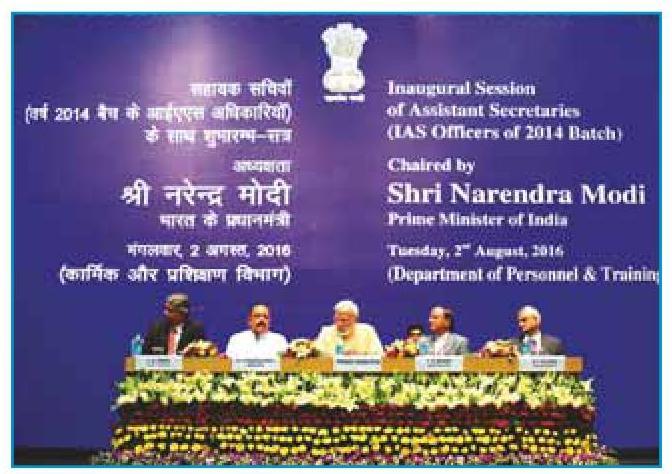
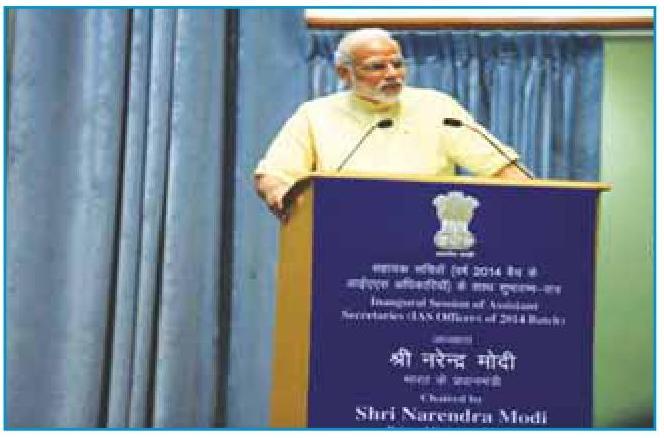
2.3 Several interactive sessions with Assistant Secretaries (IAS-2014 Batch) were organized by DoP\&T, NITI Aayog, Cabinet Secretariat, D/o AR\&PG on different topics in which a large number of dignitaries/Heads of Departments/ Heads of Organizations /Senior Officers participated. Positive feedbacks on the posting were received from the officers in the feedback session organized on $21^{\text {st }}$ October, 2016.
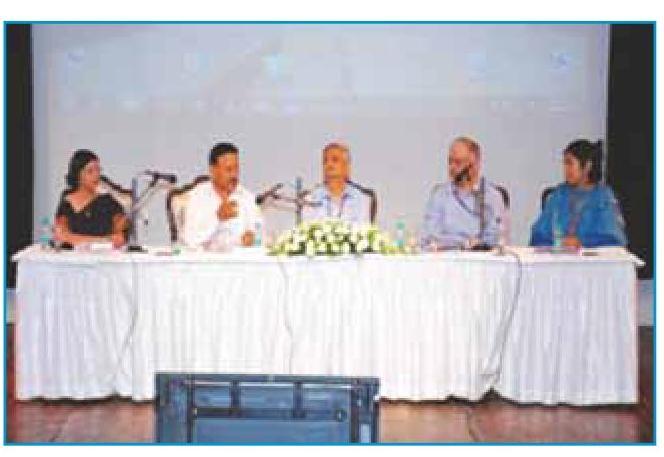
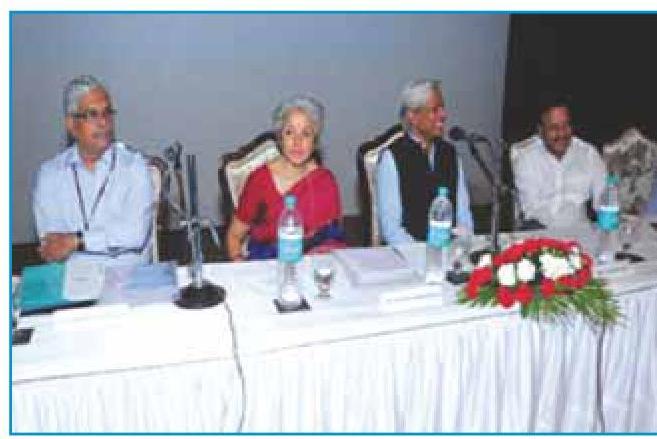
2.4 Hon’ble Prime Minister also addressed the Valedictory Session of the Assistant Secretaries (IAS-2014 batch) at DRDO Auditorium, New Delhi on $27^{\text {th }}$ October, 2016. During the Valedictory session, eight (8) Assistant Secretaries made presentations on various topics in which many useful suggestions were made before the Hon’ble PM.
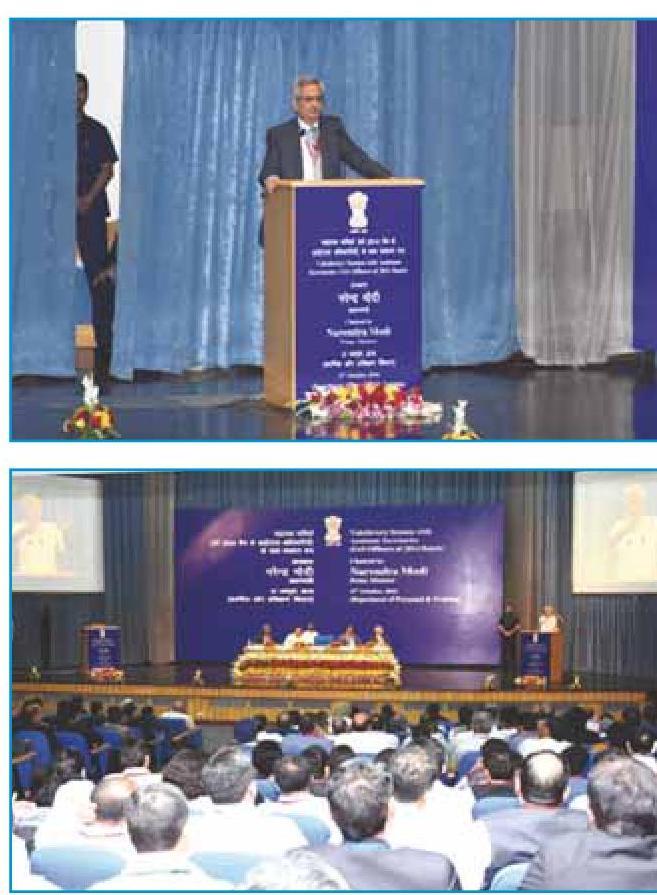
Introduction of conducting examinations by SSC on Computer Based Mode:
2.5 The Central Government has approved the introduction of conducting examination by SSC through the Computer based mode for transparency and elimination of malpractice. The following examinations are to switch over from the O.M.R. mode to the C.B.E.
i. Re-examination for Recruitment of Sub Inspectors in Delhi Police, Central Armed Police Forces and Assistant Sub Inspectors in Central Industrial Security Force Examination, 2016
ii. Combined Graduate Level Examination 2016
iii. Combined Higher Secondary Level Examination (10+2) 2016
iv. Junior Engineer (Civil, Electrical & Mechanical) Examination, 2016
v. Upper Division Clerk Limited Departmental competitive Examination, 2016.
vi. Recruitment of Scientific Assistant in Indian Meteorological Department
Discontinuation of Interview at Junior Level Posts (Abolition of Interviews):-
2.6 On the occasion of Independence Day 2015, Hon’ble Prime Minister had impressed upon the State Governments and their colleagues in the Government to discontinue interview for recruitment to junior level posts in the Government, as soon as possible. Both State Governments and Central Government have come forward and initiated steps for discontinuation of interviews in junior level posts.
2.7 Government of India decided to dispense with the requirement of interview for recruitment to all Group ‘ $C$ ‘, Group ‘ $D$ ‘ (which are now reclassified as Group ‘ $C$ ‘), Group ‘ $B$ ‘ (nongazetted) and all equivalent posts from 1st January 2016, in Government of India Ministries/ Departments/Attached Offices/Subordinate Offices/Autonomous Bodies/Public Sector Undertakings. All the advertisement for future vacancies will be without mentioning interview to remain as part of the recruitment process for these posts. As the skill test or Physical Test is different from interview, they may continue to hold these tests. However, these tests will only be of qualifying nature. Assessment will not be done on the basis of marks for such tests. In case of specific posts for which any particular Central Ministry/Department considers interview absolutely essential, clearance of Department of Personnel & Training (DoPT) would be obtained.
2.8 Staff Selection Commission, a major central recruitment agency, discontinued interview for all Competitive Recruitment Examinations w.e.f. 1.1.2016. Central Public Sector Enterprises (CPSEs) were also advised to dispense with the interviews in recruitment for non-executive level posts.
2.914 States and three Union Territories, namely Assam, Bihar, Chhattisgarh, Goa, Gujarat, Jharkhand, Karnataka, Kerala, Maharashtra, Punjab, Rajasthan, Tamil Nadu, Telangana, Uttarakhand, Puducherry, Dadra \& Nagar Haveli and Daman \& Diu have initiated concrete steps to discontinue interview in recruitments to lower level posts. Other states have been requested to take appropriate decision for discontinuation of interview at junior level posts.
Launch of DoPT initiatives on the occasion of Good Governance Day
2.10 Good Governance Day is being observed on December 25 since the year 2014, coinciding with the birthday of former Prime Minister Shri Atal Bihari Vajpayee. DoPT has taken many concrete steps for bringing citizen centricity to the core of all its delivery mechanisms. Hon’ble Minister of State (Personnel) launched several initiatives on this occasion.
1) Revamped Website of DoPT:- NIC, DoPT extended necessary technology support to facilitate this department in revising, redesigning their website to make them compliant to Guidelines for Indian Government websites and to make them usable, citizen centric and universally accessible. The revamped website of DoPT is bilingual and compliant with the ‘Guidelines for Indian Government Website (GIGW)’. The redesigned website of DoPT is CMF (Content Management Framework) compliant and is aligned to the mandate to standardize all the websites of Government of India under the Digital India Programme. The main feature of the revamped website of DoPT includes standardization of Content Architecture, User Interface Design and layout and along with certain important key features such as accessibility, responsive design etc., in order to simplify the information dissemination and access by common citizens even through hand held devices (i.e. mobiles, tablets etc) to the various government services.
2) Recruitment Rules Framing, Amendment and Monitoring System (RRFAMS):-
- The Recruitment Rules (RRs) for various Central Government civilian posts in the category of Group A and Group B are framed with the approval of DoPT, UPSC and Ministry of Law. The RRs are initiated by the cadre controlling Ministries and forwarded to DoPT for approval. After the Rules are approved by DoPT, the Concerned Ministry/Department consults UPSC in respect of those posts which are not exempted from such consultation. This is followed by vetting of the draft notification by the Legislative Department. Thereafter, the RRs are sent to the Government Press for publishing in the Gazette. This procedure is followed for framing new RRs as well as for amendment of existing RRs.
- For consultation with DOPT, an electronic system, namely, Recruitment Rules Framing, Amendment and Monitoring System (RRFAMS) was introduced in 2009. Under this system, Recruitment Rules are examined and frozen by DoPT. The Ministries have to take printout and submit proposals on physical files. Thereafter, approval of the RRs is conveyed on physical file. Thus the system involves lot of paper work and involves two stages of consultation with DOPT.
- In keeping with the objective of ‘Digital India’, a new RRFAMS has been developed. The new RRFAMS enables fully computerised Online examination of proposal relating to framing and
amendment of RRs by DOPT. The Ministries/Departments can submit their proposals in the online mode. The remarks/observations/approvals of DOPT are conveyed through the system in the online mode. This marks a step towards evolving to a stage of Paperless Office. The benefits of the new system are many, to mention a few, it will lead to reduction in time required for approval of proposals, simplification of procedure for framing and amendment of RRs and keep an electronic trail of the examination/ comments made by various functionaries. - In the coming year, this system will be further expanded for electronic transmission and online consultation/approval of RRs by UPSC/ Legislative Department and electronic transmission to the Government Press for notification.
- The new RRFAMS, besides increasing the speed of processing will also help in creation of an electronic library of Recruitment Rules.
3) e-Service book and HRMS:-
- Service book is the most vital document of Govt. employees and all data related with service of employees are recorded in the service book e.g. joining of employee, their promotion, transfer, salary, leave etc.
- Through e-Service Book platform all service related matters affecting the service of employee will be automated. Simultaneously necessary steps will be taken for implementation in other ministries and departments of Governments of India
considering specific requirement of a particular Ministry/ Department.
- In case of transfer of an employee from one office to other, Service book will be transferred online and all data related with employee will be instantly available to new organisation.
- The roll out of e-Service Book is a vital step towards establishing a fully automated Human Resource Management System (HRMS) with an employee portal covering all employees of Government of India so that all processes of personnel management from “hiring to retiring” are carried out on digital platform thus dispensing with the manual system of handling personnel management.
4) Mandatory online filing of APAR by officers:-
- As a measure towards good governance, Department of Personnel & Training made online filing of Performance Appraisal Reports (PAR) mandatory in respect of IAS officers in Smart Performance Appraisal Report Recording Online Window (SPARROW), a software developed for this purpose.
- Instructions were also issued to the Cadre Controlling Authorities of other All India Services and all organised Gr. ‘A’ Services such as the Indian Police Service, Indian Forest Service, Indian Revenue Service and various Railway Services, etc. to introduce the system of online filing of APARs for their respective Services with effect from the assessment year 2015-16. Besides IAS, Indian Police Service and
Indian Forest Service have introduced online filing of Annual Performance Appraisal Reports (APARs). Other Central Group ‘A’ services are in process of making online filing of APARs mandatory.
- Further, similar instructions have also been issued to the Department of Public Enterprises and the Department of Financial Services with respect to Central Public Sector Enterprises and Public Sector Banks/Financial Institutions/Public Sector Insurance Companies respectively. Regular monitoring of the progress in this regard is also being done by DoPT.
- Online filing of APARs is crucial for good governance as it eliminates the possibility of any manipulation in the physical forms and ensures timely submission and finalisation of APARs which are invaluable tools for assessing the performance of officers with a view to chalking out their career progression and training needs. Further, availability of APARs online makes them readily accessible to the officers concerned thereby making the system transparent and immune to inefficiencies associated with physical transit of APARs.
5) Online Filing of Immovable Property Return to be effective from 1.1.2017
- The Government decided to introduce online filing of Immovable Property Returns (IPRs) by IAS officers for the year 2015-16 as on 1.1.2017 for which the National Informatics Centre (NIC) developed a module which has been made available on Smart Performance Appraisal Report Recording Online Window
(SPARROW) platform, an online portal for filing of Performance Appraisal Report. The software was inaugurated by Hon’ble MOS (PP) on 25.12.2016 as part of the Good Governance Day celebration. For filing IPR online, the officer will have the option to either upload hard copy of the return in the module or to digitally sign the return available on module through Digital Signature Certificate (DSC) or eSign application. In order to facilitate filing of return, a ‘User Manual-IPR’ has been provided on the Home Page of SPARROW.
- The portal would become operational w.e.f. 01.01.2017. The portal could be accessed by the serving IAS officers through their NIC email IDs and passwords, already provided to them for online filing of PARs in SPARROW.
- The introduction of online filing of IPRs would be able to address issues like manual IPRs getting lost in transition, IPRs though submitted by the officer but not uploaded by the State Governments, IPRs without date getting uploaded in the system, antedating of IPRs. This is another step towards promoting transparency and probity in governance. It will be convenient for the officers, as instead of sending it in hard copies they would have the option to upload it in the system or to file it online. This system would also help DoPT and State Governments in easy monitoring for ensuring that all officers file their property return in time. It would also make the entire process hassle free as the hard copies would be dispensed with thereby resulting in saving of man-hours in handling the papers.
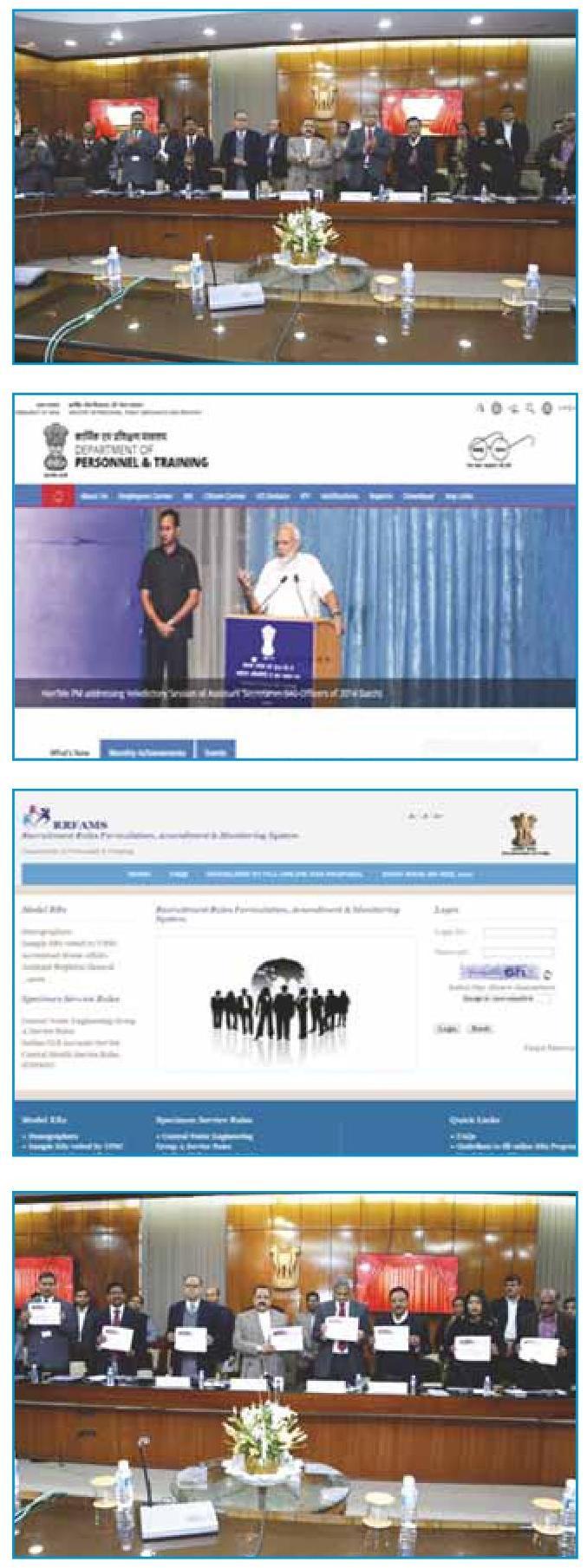
Launch of the Employees Online (EO) Mobile App
2.11 Hon’ble MoS (PP) launched the Employees Online (EO) Mobile App of DoP&T on $28^{\text {th }}$ October, 2016 to enable its users to stay updated on real time basis with appointments and postings at senior level in the Government of India. The IOS version was launched on the Good Governance Day.
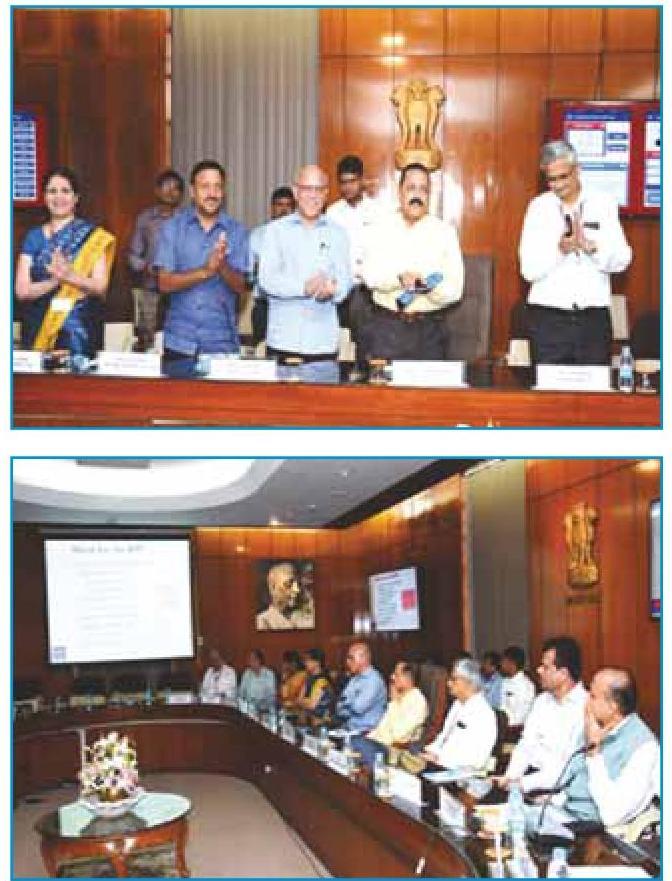
Induction Training Programme:-
2.12 In order to promote a citizen centric attitude in the employees, for better public service delivery and promote good practices towards achieving the vision of citizen centric governance, Department of Personnel and Training had launched a capacity building programme on pilot basis in three States of Jammu \& Kashmir, Maharashtra and Tamil Nadu
for 3000 newly recruited cutting edge level government functionaries to develop in them Generic \& Domain specific competencies covering 15 districts in the financial year 2014-15.
2.13 After successful completion of the Pilot, a 12-Day Induction Training Programme (ITP) was launched in the year 2015-16 in 103 districts of 21 States with a Two Day Regional Training of Trainers (ToT) Workshop at various State ATIs for training of 7000 frontline State government functionaries. A motivational talk by locally available inspirational achievers/national award winners/sports persons in the inaugural session of the ToT Workshop and training programme in the districts, one day blood donation camp during the middle of the course and one night stay in the village as part of field/NGO visit were compulsory component of the 12 Days Induction Training Programme.
2.14 In the year 2016-17, the Induction Training Programme is being implemented in 117 new districts of 22 States.
National Symposium on Excellence in Training:-
2.152 nd National Symposium on Excellence in Training (NSET) was organised on 27-28 May, 2016 with the objective of providing platform to training fraternity for experience sharing, exposure and showcasing global best practices. The $2^{\text {nd }}$ NSET is designed with the citizen centric governance at the core of all its sessions. It aims to provide exposure on innovations in training with the primary focus on increasing capabilities of trainers, training managers and administrators of
National/State Training Institutes, and emphasizing the need to focus the overall aim of training towards developing and sustaining a citizen centric attitude to ensure efficient public service delivery.
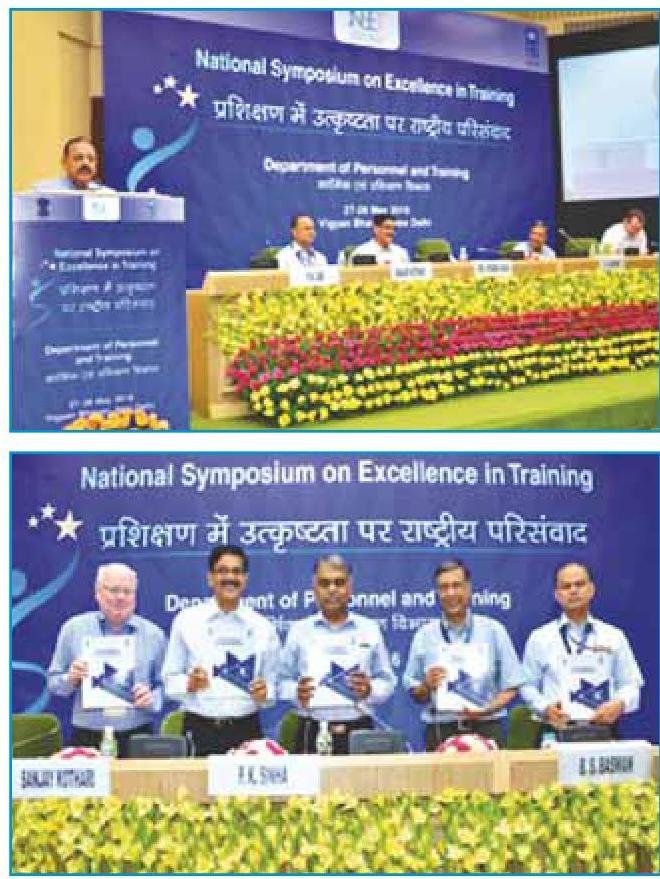
2.16 The National Symposiums are expected to improve the capability of trainers in delivering quality training to address competency gaps at various levels, which in turn will lead to efficient, and citizen centric public service delivery. The Symposium will emphasize the significance of aligning organizational mission, culture, work and trainings with the core theme of promoting Citizen Centricity in government functioning and will showcase experiences in training design, content and methodology that have promoted a citizen oriented attitude. Sharing and recognition of good practices will lead to improved
motivation of trainers and training establishments, and will instill a culture of service and excellence to ensure efficiencies in public service delivery. Monitoring and Evaluation will be recognised as an integral component of all trainings to measure impact and improve efficiency and effectiveness. The symposium will encourage peer learning which will be leveraged in the online forum for idea exchange and help in continuous capacity building of trainers.
Initiatives for Swachhata Pakhwara
2.17 DoP&T undertook massive cleanliness drive and activities during the Swachhta Pakhwada i.e. 01.12.2016 to 15.12.2016. Hon’ble MoS (PP) inaugurated the above fortnight long Swachhta Pakhwada activities on 01.12.2016. On the inaugural day of the Swachhta Pakhwada, a special cleanliness drive was undertaken by the Department in collaboration with the Institute of Secretariat Training and Management (ISTM) in and around Ber Sarai market. During the Swachhta Pakhwada, various activities were undertaken by the Department such as Poster(s)/ Slogan Competition, Shramadans for cleanliness of North Block, Lok Nayak Bhawan, ISTM building (Old JNU Campus), Grih Kalyan Kendras/Samaj Sadan. The various other Statutory attached offices also undertook various activities during the Swachhta Pakhwara.
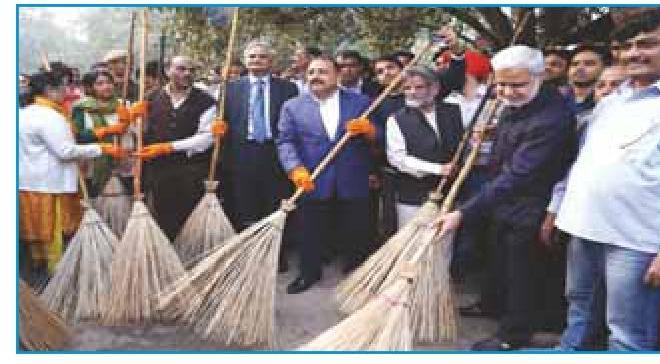
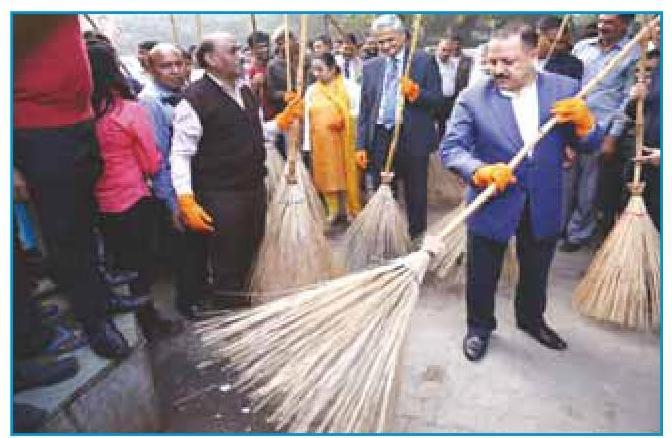
10th Meeting of Hindi Salahkar Samiti:-
2.18 Hindi Salahkar Samiti is a High Level Committee consisting of 30 members. The Hindi Salahakar Samiti of this Ministry was reconstituted on 13.04.2014 after the constitution of $16^{\text {th }}$ Lok Sabha. The first meeting of the reconstituted committee was held in New Delhi under the chairmanship of Hon’ble Minister of State (PP) on $8^{\text {th }}$ June, 2016 in which progressive use of Hindi in official work of the Ministry was reviewed.
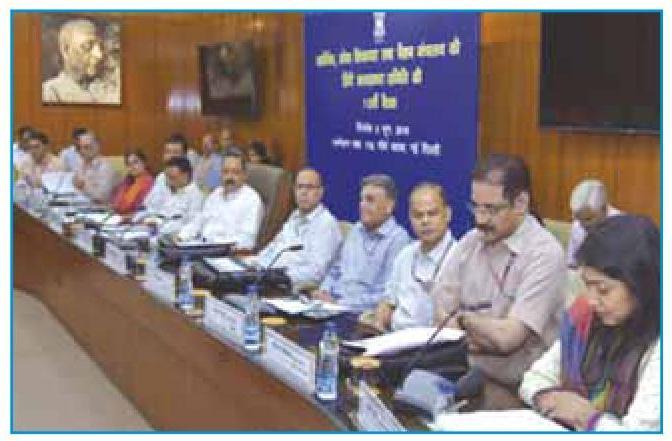
Hindi Workshop
2.19 Hindi workshop was organized by this Department on $21^{\text {st }}$ December, 2016 at CSOI, New Delhi in which officers of DoP&T had participated. The aim of the workshop was to enhance awareness and knowledge of participants towards effective implementation of official
language policy in DoP\&T. Hon’ble MoS (PP) and newly nominated members of the reconstituted Hindi Advisory Committee addressed all the participants in the Workshop.
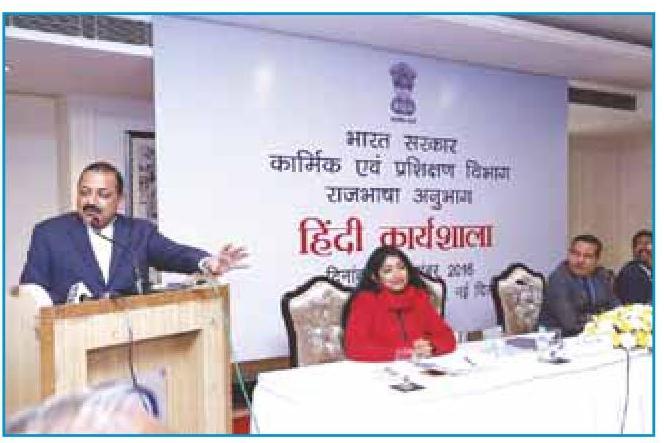
Annual Convention of Central Information Commission
2.20 Hon’ble Union Home Minister inaugurated Two-day Annual Convention of the Central Information Commission (CIC) on 07.11.2016. Hon’ble MoS (PP) also attended the convention. It contributed immensely in generating awareness about innovative use of RTI provisions for the benefit of the citizenry thereby strengthening public trust in democracy. On the above occasion, the Hon’ble Union Home Minister launched ‘e-Court Software’. The eCourt system aims at enabling speedy disposal of Appeals/Complaints by using digital technology. During the two days of the conference, various sessions were organised on topics such as RTI in Railways, RTI Web portal by DoPT, RTI in Public Sector Undertakings, RTI in Banking/Insurance, Academic papers on RTI and RTI in States. These sessions were attended by eminent panelists and experts in these areas. Many suggestions were made for amendment to the RTI Act 2005 to preserve trust amongst stakeholders, arguing also
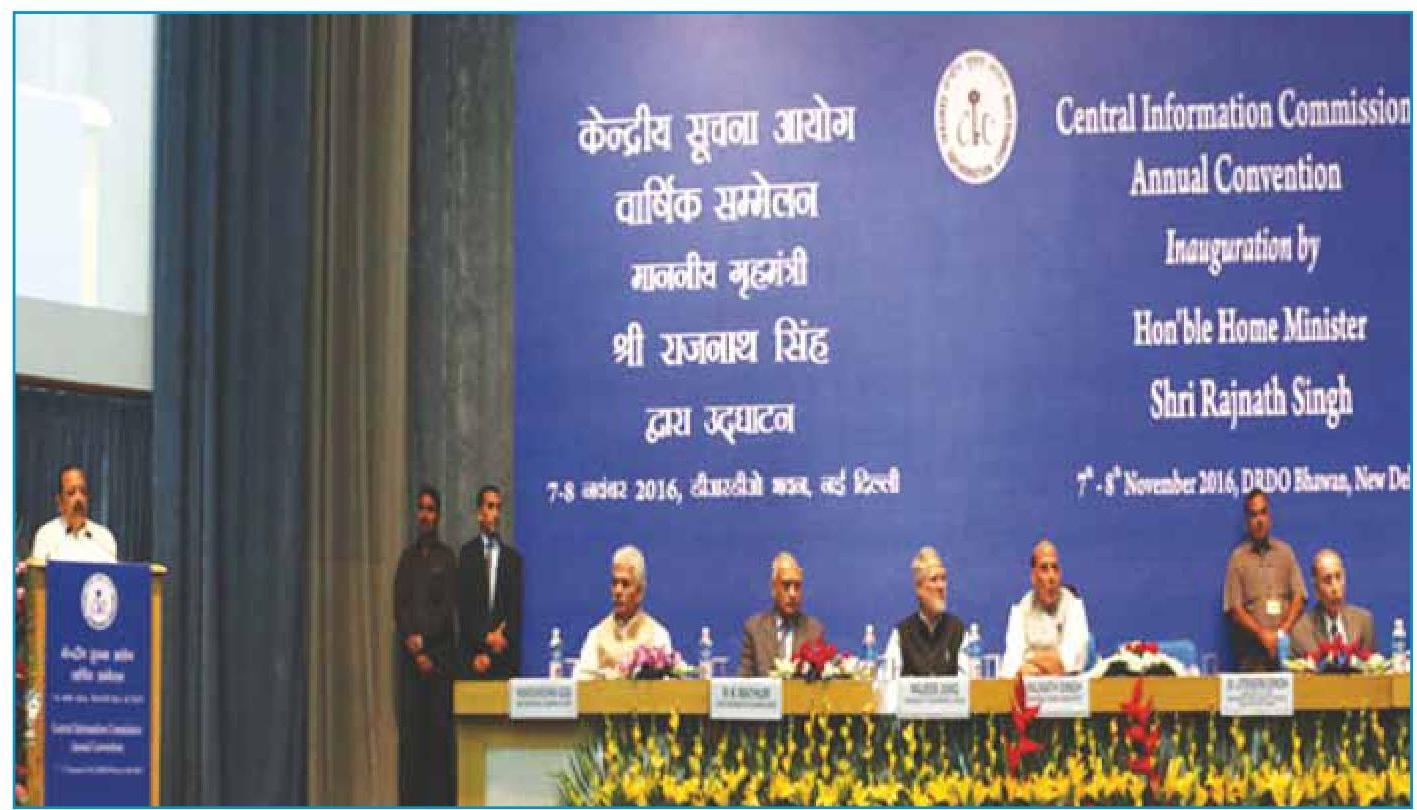
for reduction in scope of exemptions under Section 8 of the RTI Act 2005 and against misuse of the Act.
Issue of SC/ST/Residence Certificate in School:-
2.21 In order to facilitate a uniform procedure, as a citizen friendly initiative, an advisory regarding issue of SC/ST/Residence Certificate in School has been prepared and circulated to all the States/ Union Territories for their consideration.
Grant of Pension in the case of Casual
Labourers regularized after 31.12.2003:-
2.22 Casual Labourers working in Central Government who had completed one year of service as on 01.09 .1993 had been given temporary status. Those who were regularized after 31.12.2003 were not getting pension. Government decided that even those casual
labourers who had been given temporary status but had been regularized after 31.12.2003 will be given pension.
Benefit of paid holiday to casual workers:-
2.23 Government also decided that casual workers working in Government Departments be given a paid holiday after working for five days, i.e. forty hours in the week.
Amendment to the PESB Resolution:-
2.24 The Government amended the Public Enterprises Selection Board (PESB) Resolution dated 03.03.1987 on 10.06.2016 to the effect that “Candidates from State Public Sector Enterprises and the private sector subject to fulfilling the eligibility criteria will also be considered as non internal candidates along with the candidates of other public sector enterprises, for a period of five years in CPSEs”.
Meeting with Personnel Secretaries (Personnel/GAD) of all State/UT Governments:-
2.25 MoS (PP) held a meeting with Principal Secretaries (Personnel/GAD) of the State Governments on 22.04.2016 to discuss various personnel issues of the States. MoS(PP) in his address, also expressed satisfaction over the interest shown by many States in replicating various initiatives taken by the present Government towards Good Governance such as self attestation, abolition of interviews, and also towards providing workable environment such as LTC claim simplification, introduction of Yoga etc. He also appreciated the Indian bureaucracy for showing tremendous adaptability towards the changing requirements of the $21^{\text {st }}$ century. MoS (PP) further informed of launch of pension portal on $25^{\text {th }}$ December, 2015 (marked as Good Governance day) which will minimize the information required for pension preparation. He suggested that the States could also replicate the same to their advantage.
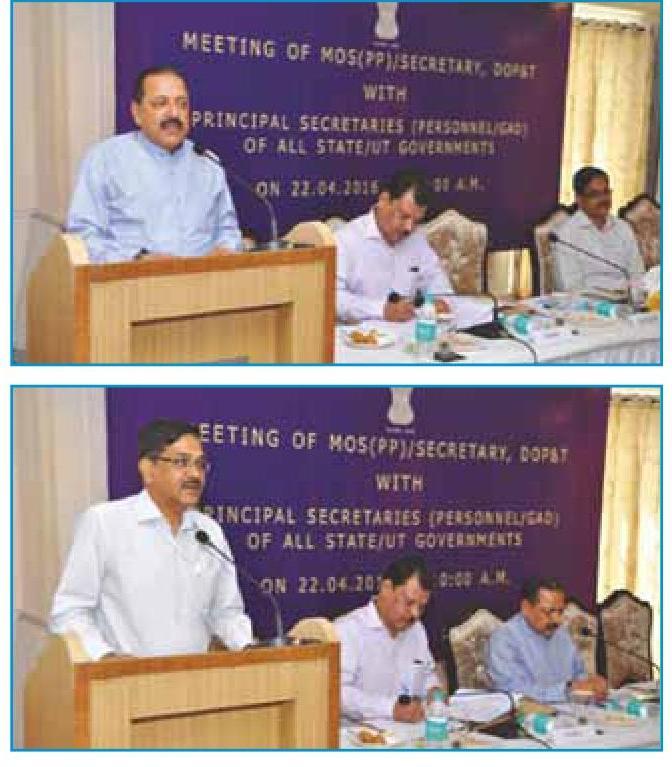
Continuation of Yoga Camps and adventure sports for wellbeing of employees and improving performance:-
2.26 The Department continued the free Yoga Training, Summer Coaching Camps and Adventure Sports Scheme for Central Government Employees. On the occasion of $2^{\text {nd }}$ International Day of Yoga on $21^{\text {st }}$ June, 2016, Yoga related activities were undertaken in the Samaj Sadans of Grih Kalyan Kendra of DOP&T.
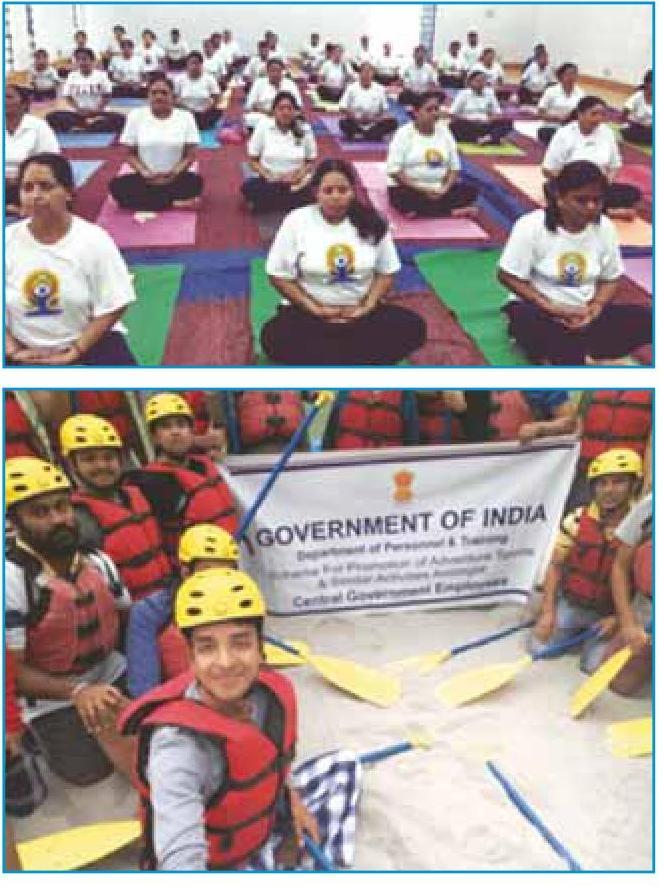
2.27 The 10 day adventure sports scheme has components of environmental awareness, disaster management, team spirit, capacity building, Swachh Bharat and activities like Trekking, Mountaineering, Rock-Climbing, Cycling in a difficult terrain, Skiing, Rafting, Para Sailing, Jungle Safari and Environmental Awareness Camps etc. The Department is providing financial
assistance of Rs. 20,000/- (maximum) to the eligible Central Govt. Employees. There is also provision for Special Casual Leave for the programme. It is expected that participation by Central Govt. Employees in adventure sports and similar activities will give them a platform where they would learn lessons from nature and use the knowledge acquired for welfare of the society. It would also foster spirit of risk-taking, cooperative team work, capacity of readiness, vital response to challenging situations, endurance and environmental awareness.
Blood Donation Camps
2.28 In order to inculcate in the employees of Central Government the spirit of participation in Citizen Centric activities, this Department is organizing Blood Donation Camps in association with the Indian Red Cross Society, New Delhi on monthly basis since June 2015 in all major buildings where Government offices are situated. Blood Donation Camp was also organised by DOP&T at North Block, New Delhi on 15.06.2016 and 88 employees donated blood in this camp. In the year 2016 (as on 24/10/2016), 10 Camps have been organized at various locations and 603 units of blood have been collected.
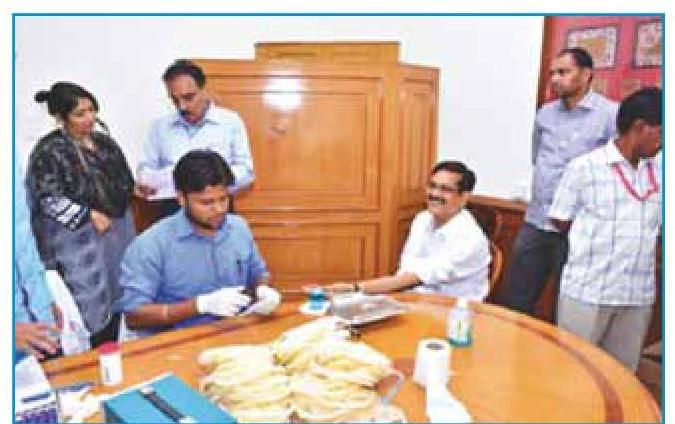
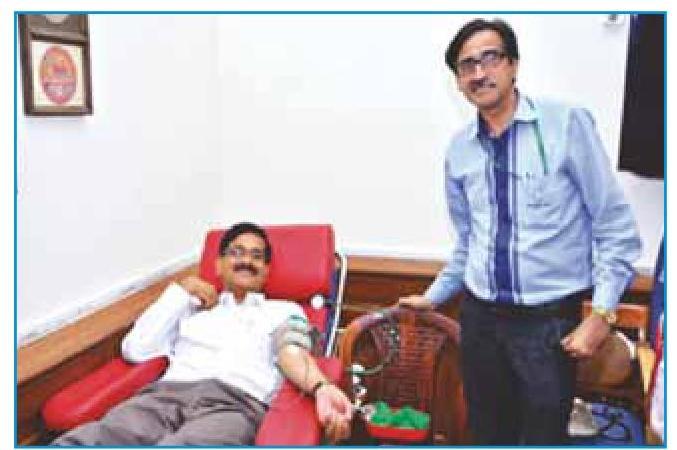
Training/briefings to be arranged for drivers of DoPT to make them aware about fuel efficiency:-
2.29 A workshop was organised on 04.06.2016 for awareness on fuel efficiency in collaboration with Petroleum Conservation Research Association (PCRA) in which all Drivers of this Department had participated.
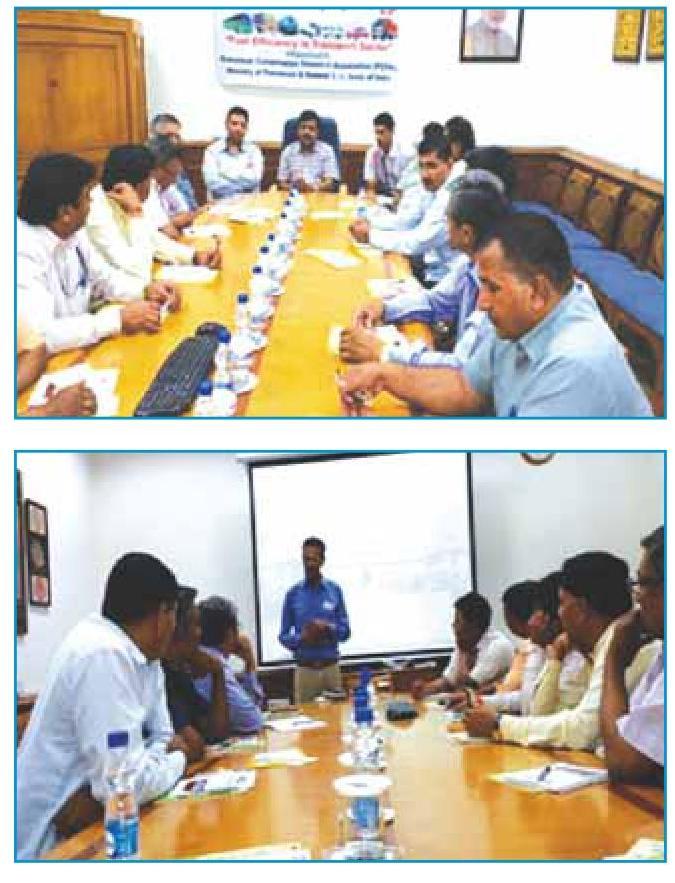
In-House Training Programme
2.30 With a view to building the capacity of employees, a weekly One Hour Training for the officials of DoPT from LDC to Director Level on various topics was started w.e.f. 09.10.2014. Weekly training also includes training of official of CSSS upto the rank of PPS. So far six modules viz. ‘Filing System’, ‘Noting and Drafting’, ‘Gender Sensitization’, ‘Litigation Management (Handling of Court and CAT Cases)’and Preventive Vigilance were completed. Seven modules on ‘Records Management’ was started from 09.11.2016.
Celebration of International Women’s Day:-
2.31 International Women’s Day was celebrated by the Department on $8^{\text {th }}$ March, 2016, where women employees of all the three Departments of the Ministry participated. Hon’ble MoS (PP) also addressed the gathering on the occasion.
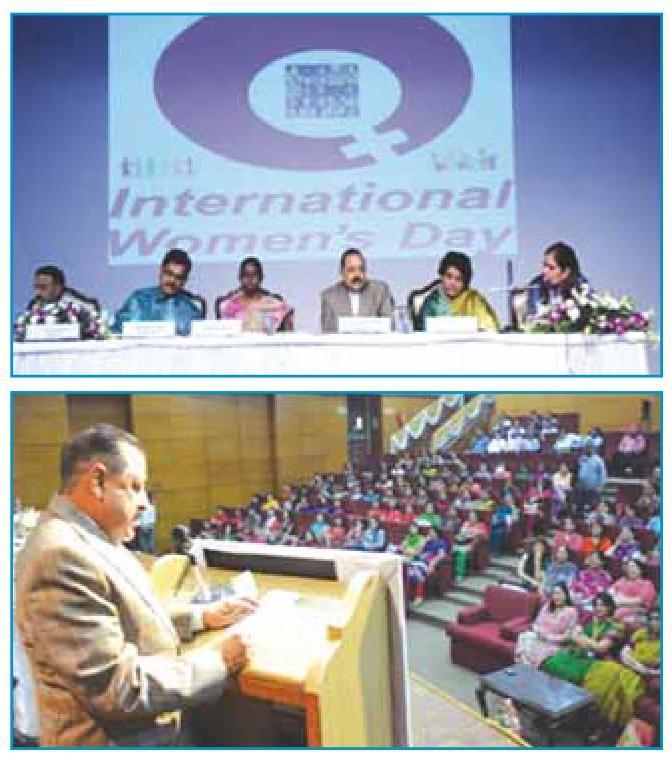
Felicitation of IAS Toppers of 2015 batch:-
2.32 MoS (PP) chaired the felicitation ceremony held on 01.06.2016 for top achievers of Civil Services Examination-2015.
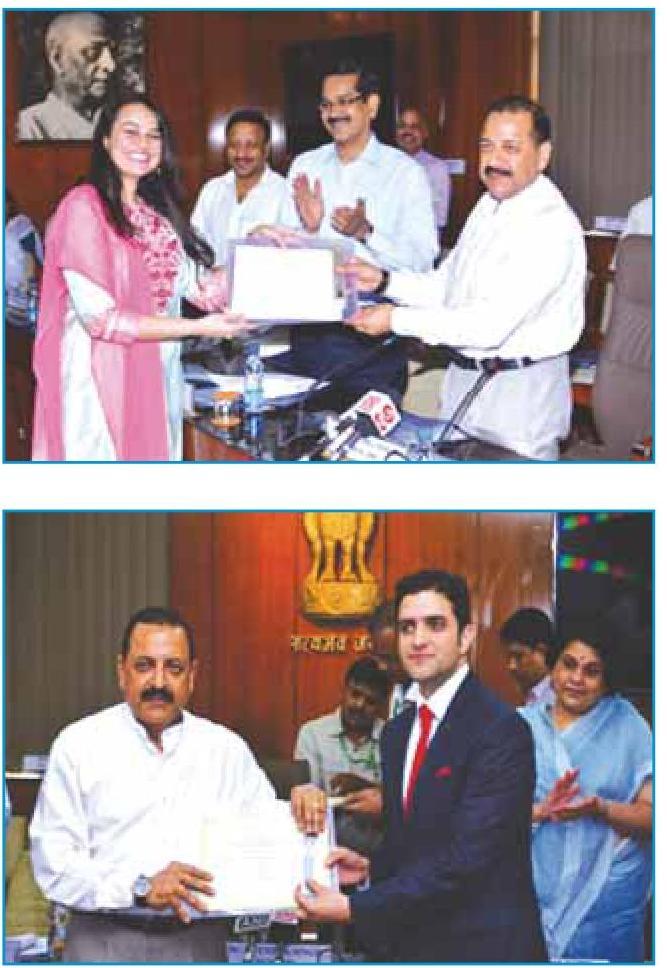
Certificate of Excellence Award to employees of DoP&T:-
2.33 Felicitation of awardees of ‘Certificate of Excellence’ for 2014-15 by Hon’ble MoS (PP) was organized in CSOI, New Delhi on 22.02.2016 to acknowledge, recognize and reward the meritorious works done by the employees of DoP\&T.
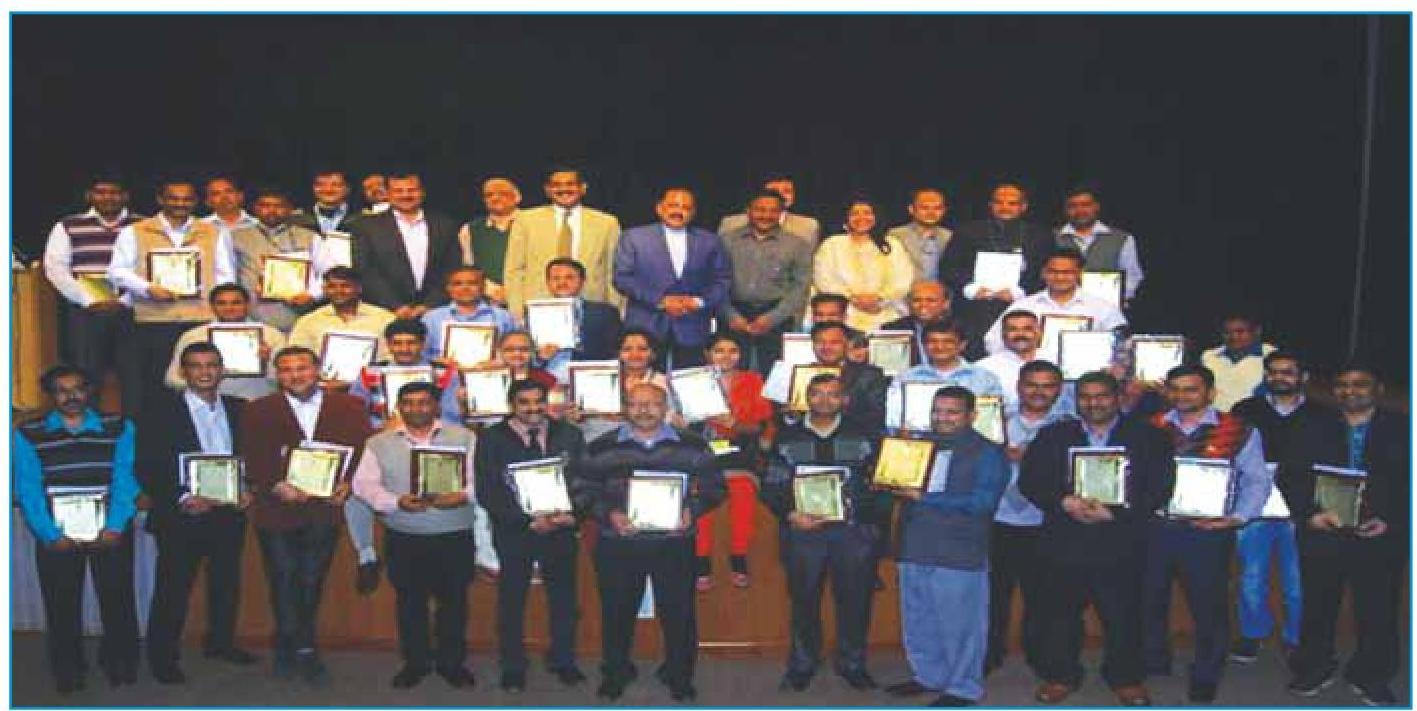
2.34 Similarly, this Department declared the names of employees ranging from Multi Tasking Staff to Under Secretary as ‘Employee of the Month’ for the months of May 2016 to October, 2016 to appreciate the hard work, sincerity and diligence shown by the employees in handling the tasks assigned to them. The “Employee of the
Month” awards were given by Hon’ble MoS (PP). Awards were given to the winners of various competitions held in DoPT during 2016 i.e. Hindi Pakhwada, Swachhta Pakhwada and Vigilance Awareness Week on 02.01.2017 at CSOI, Vinay Marg, New Delhi by Hon’ble MoS (PP).
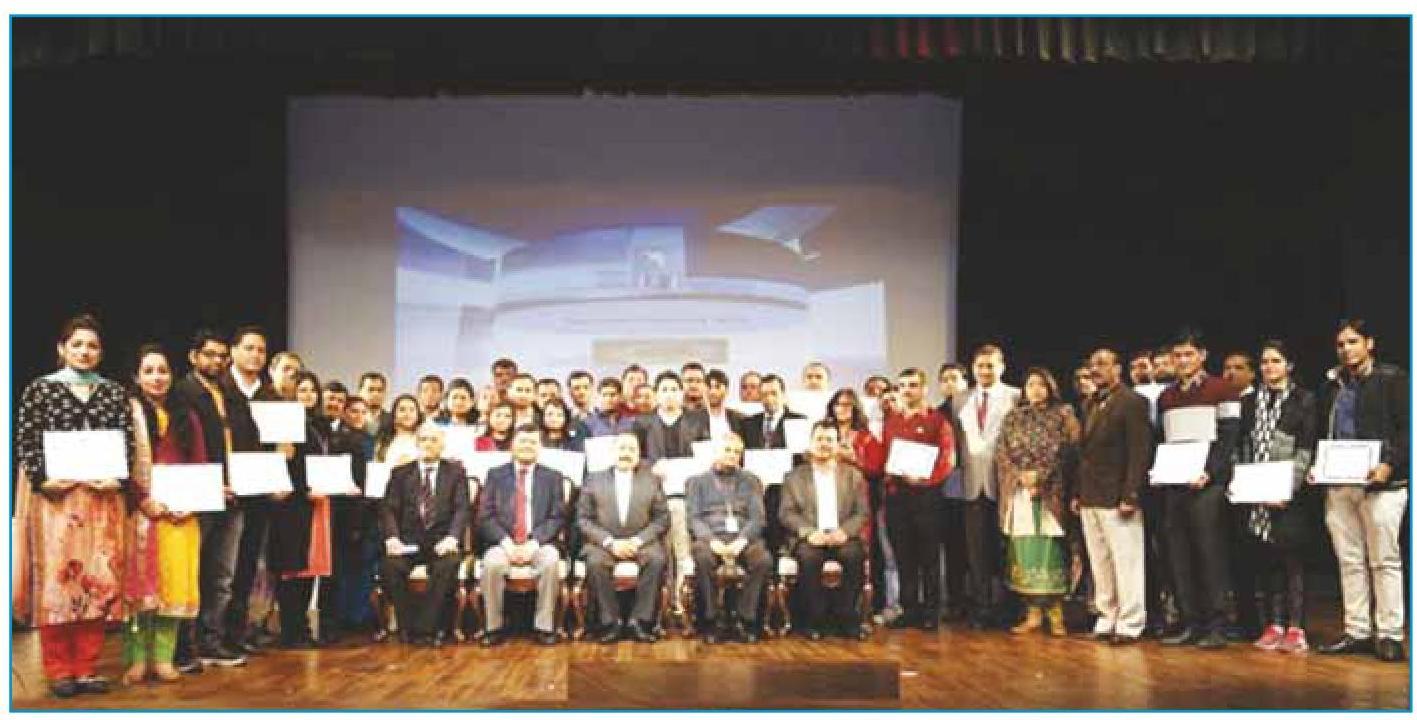
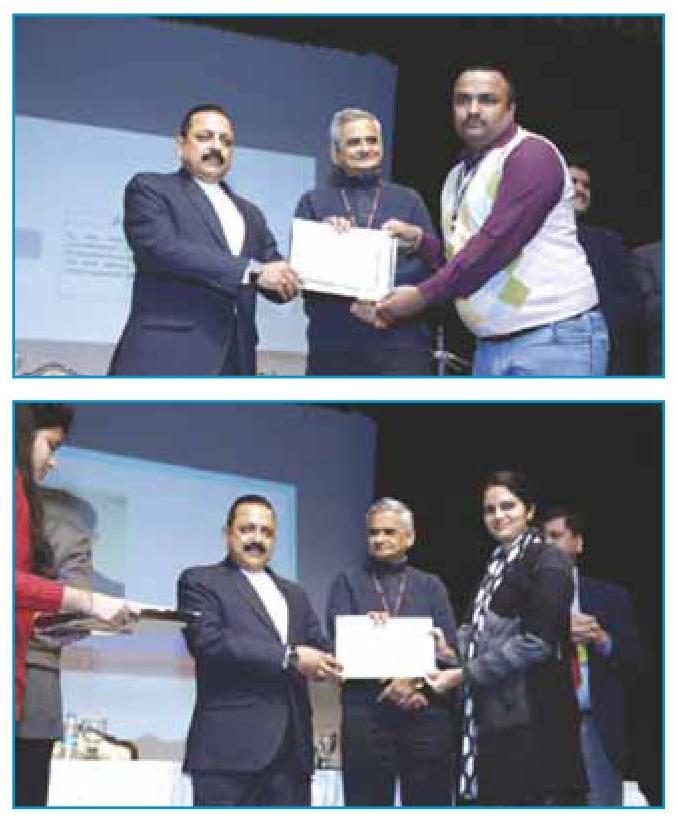
Single Page Form Initiative:-
2.35. In order to ease the difficulties faced by the common citizens, single page form initiatives of DoP&T in collaboration with National Centre for Good Governance (NCGG) was launched on Good Governance Day (i.e. $25^{\text {th }}$ December, 2015). The overall aim of this initiative was to make the forms as simple and small (a single A4 size page) as possible for the beneficiary and contents of the forms easy to understand and complete.
2.36. This Department took an initiative for simplification of forms in association with National Centre for Good Governance (NCGG). A series of meetings were held from 20.06.2016 to 24.06.2016 with various Divisions and attached/subordinate offices of this Department. A technical workshop was organized on 29.06.2016, in which all DS / Directors of this Department and officials from NCGG had
participated. In the meetings/workshops, various aspects relating to forms were discussed at length and suggestions were made to simplify forms. Out of 119 forms discussed, 52 forms had been reduced to single page and uploaded on the DoPT website under Link forms.
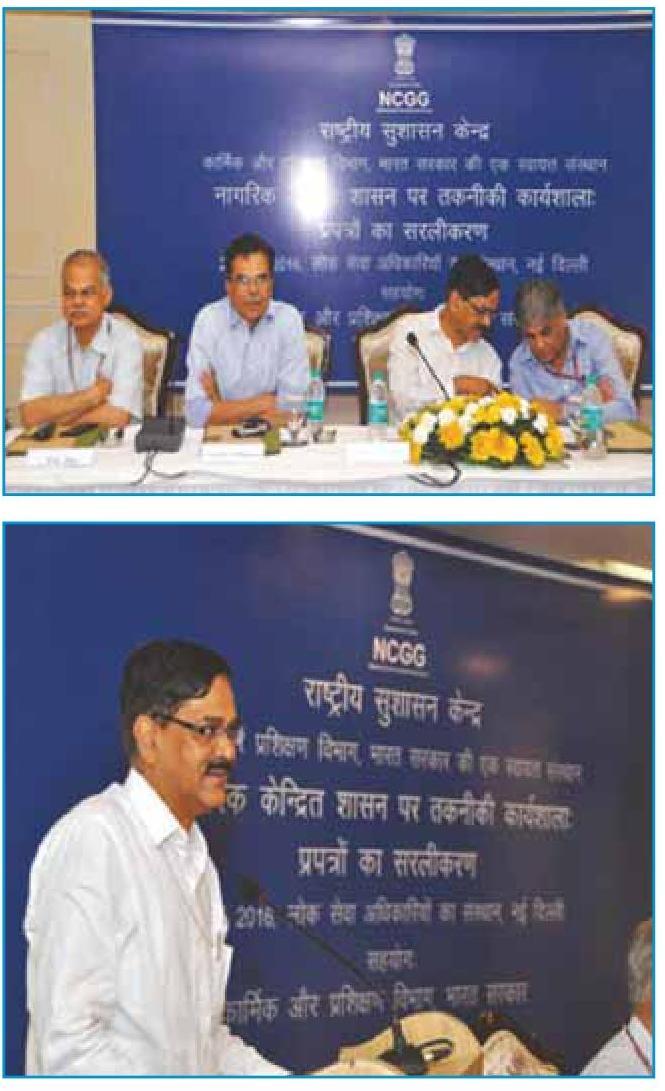
2.37 NCGG is mandated to do the work of simplification of forms of 9 departments till March 2017. The methodology adopted so far involves four steps: forming a core group consisting of departmental employees; working intensively with the core group over a week or so; organizing one or more technical workshops involving stakeholders as well as concerned
departmental officials for discussion on suggested changes and adoption of proposed changes by the Department. Workshops involving DoPT, Rural Development, Labour departments, Department of Ex-Servicemen Welfare, Department of Empowerment of Persons with Disabilities, Department of Fertilizers, Ministry of Civil Aviation & Directorate General of Labour Welfare have been held. 3 Departments/ Ministries shall be completed by January – March 2017.
2.38. A Health Check-Up Camp has been organized in North Block near Gate No 6 at Jalebi Chowk from 10.00AM to 2.00 PM on $5^{\text {th }} \& 6^{\text {th }}$ January, 2017 for the employees of Department of Personnel and Training. The camp had been inaugurated by Secretary (P).
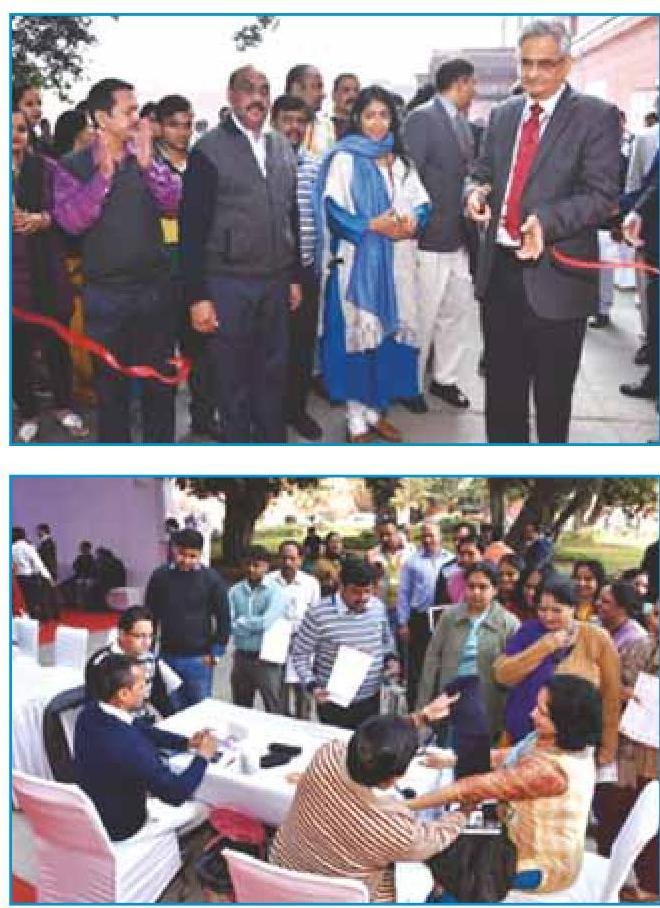
2.39. An RTI Online Portal was officially launched in the month of August, 2013 with an objective to make it convenient for citizens to file RTI requests and First Appeals through a web based tool. Since its inception a total of 1404 Central Public Authorities (as on 31.12.2016) have been aligned with RTI online Portal. Facility for citizens to file online RTI applications and first appeals in Hindi was also made available w.e.f. $3^{\text {rd }}$ March, 2016. Now a citizen is able to seek information online (in Hindi or English) from any Central Ministry / Department and other listed Central Government public authorities. Since April, 2014 till 31.01.2017, a total of 1404 Central Public Authorities (as on 31.12.2016) have been aligned with RTI online Portal. Out of these 1404 Public Authorities, 927 Public Authorities have been aligned only in this year from April, 2016 to $31^{\text {st }}$ December, 2016. The year-wise break up is as under:
| Financial Year | No. of PAs aligned |
|---|---|
| $2013-14$ | 96 |
| $2014-15$ | 88 |
| $2015-16$ | 293 |
| $2016-17$ (till 18.01 .2017$)$ | 1071 |
| Total | 1548 |
2.40 Incumbency Position of Group ‘A’ Officers in D/o Personnel and Training as on 31.12.2016 is given at Annexure-I.
Chapter 3.
PERSONNEL POLICIES
- Matters relating to framing and amendment of recruitment rules/service rules for Group “A” and “B” posts
- Framing of policy relating to the procedure for Departmental Promotion Committee(s)
- Policy on seniority
- General policy matters relating to:-
a) Flexible complementing scheme,
b) Modified Assured Career Progression Scheme,
c) Leave travel concession,
d) Deputation,
e) Child care leave,
f) Pay & allowances,
g) Holiday policy,
h) Age relaxation and
i) Other matters concerning service conditions. - Administration of UPSC and SSC including exams except the Civil Service Examination
- Policy matters of PESB
- Policy on Character verification before appointment
- Disagreement cases with UPSC from various Ministries except on appointment cases
- UPSC (Exemption from Consultation) Regulations
- Policy on APAR.
- Commercial employment after retirement
- Policy on
(a) Retirement, extension, re-employment,
(b) Posting and transfers, Conduct and CCA Rules,
(c) Sealed Cover procedure,
(d) Status of Women in Central Government,
(e) Temporary Service Rules, Etc.
(f) Lien, Probation, confirmation,
(g) Daily Wage Casual Labourers
Prevention of Sexual Harassment of working women at workplace- provision for a representation by the aggrieved Woman O.M. No. 11013/2/2014-Estt.A-III dated 09.09.2016 and O.M. No. 11012/5/2016-Estt.A-III dated 2.08.2016.
3.0 In accordance with the provisions of the Sexual Harassment of Women at Workplace (Prevention, Prohibition and Redressal) Acts and Rules, 2013, it has been decided that in all cases of allegations of sexual harassment, where a
Complaint Committee has not recommended any action against the employee against whom the allegation have been made in a case involving allegations of sexual harassment, the Disciplinary Authority shall supply a copy of the Report of the Complaint Committee to the complainant and shall consider her representation, if any submitted, before coming to a final conclusion. The representation shall be deemed to be an appeal under section 18(1) of the Harassment of Women at Workplace (Prevention, Prohibition and Redressal) Act, 2013.
3.1 It has been clarified that no prejudice is caused to the charged officer, if the Chairperson of the Complaint Committee being junior to the suspect officer or the charged officer. However, to ensure fair inquiry, Ministries/Departments may also consider transferring the suspect officer/ charged officer to another office to obviate any risk of that officer using the authority of his office to influence the proceedings of the Complaints Committee.
Clarification of the Definition of “Members of Family” in the context of Rule 4 of the Central Civil Service (Conduct) Rules, 1964: O.M. No. 22013 /4/2016-Estt.(A-III) dated 20.07.2016.
3.2 To ensure that no Government uses his position or influence directly or indirectly to secure employment for any member of his family in any company or firm as per provisions of CCS(Conduct Rules), it has been clarified that in the comfort of Rule 4(1) and 4(3) of the CCS (conduct) Rules, 1964 “Members of family” in relation to a Government servant include the wife or husband, son or daughter, parents, brothers or sisters or any person related to any of them by blood or marriage, whether they are dependent on the Government servant or not.
Instructions regarding timely issue of Charge-sheet: O.M. No.11012/04/2016Estt.(A) dated 23.08.2016.
3.3 Instructions have been issued that where a Government servant is placed under suspension, the order of suspension should not extend beyond three months, if within this period the charge-
sheet is not served to the charged officer and it should be ensured that the charge sheet is issued before expiry of 90 days from the date of suspension. As the suspension will lapse in case this time line is not adhered to, a close watch needs to be kept at all levels to ensure that the charge sheet is issued in time. These instructions were issued in compliance to the Judgement of the Apex Court on the matter.
Action where advice of the Union Public Service Commission (UPSC) not communicated to the delinquent Government servant and penalty is set aside: O.M. No.11012/05/2015-Estt (A-III) dated 14.07.2016.
3.4 The Hon’ble Supreme Court in its judgment on 16.03.2011, while dismissing the Government’s Civil Appeal No. 5341 of 2006, held that it is a settled principle of natural justice that if any material is to be relied upon in departmental proceedings, a copy of the same must be supplied in advance to the charge sheeted employee so that he may have a chance to rebut the same. The judgement was made in respect of the advice of the Union Public Service Commission and the Apex Court observed that a copy of the advice should be supplied in advance to the concerned employee, otherwise, there will be violation of the principles of natural justice.
3.5 Accordingly, Rules $15,16,17,19,27,29$ and 29-A of the Central Civil Services (Classification, Control and Appeal) Rules, 1965, were amended vide G.S.R. No. 769(E) dated 31.10.2014. Now, vide O.M. dated 14.17.2016, the Government has clarified that cases decided
after $16^{\text {th }}$ March, 2011 need not be reopened. In cases decided after $16^{\text {th }}$ March, 2011, where a penalty was imposed after relying upon the advice of UPSC, but where a copy of such advice was not given to the Charged Officer before the decision, the penalty may be set aside and inquiry taken up from the stage of supply of copy of the advice of UPSC.
Simultaneous action of prosecution and initiation of departmental proceedings: O.M. No.11012/6/2007-Estt (A-III) dated 21.07.2016.
3.6 The Hon’ble Supreme Court in its judgment in a case, Ajay Kumar Choudhary vs Union of India through its Secretary & Anr, Civil Appeal No. 1912 of 2015, (JT 2015 (2) SC 487), 2015 (2) SCALE, the apex Court directed that the currency of suspension order should not extend beyond three months if within this period a Memorandum of charges/ charge sheet is not served on the delinquent officer/ employee.
3.7 It is noticed that in many cases charge sheets are not issued, despite clear prima facie evidence of misconduct on the ground that the matter is under investigation by an investigating agency like Central Bureau of Investigation. In the aforesaid judgement, the Hon’ble Court has also superseded the direction of the Central Vigilance Commission that pending a criminal investigation; departmental proceedings are to be held in abeyance.
3.8 Accordingly, this Department has clarified on the following issues: (i) Issues of charge sheet against an officer against whom an investigating agency is conducting an investigation
or against whom a charge sheet has been filed in a court; (ii) Effect of acquittal in criminal case on departmental inquiry; and (iii) Action where an employee convicted by court files an appeal in a higher court.
CCS (LTC) Rules, 1988 – Extension of relaxation to travel by air to visit NER, J\&K and A\&N: O.M. No. 31011/3/2014-Estt.A-IV dated 19.09.2016.
3.9 To boost tourism, the Government has decided to extend the scheme of travel by air to visit North-East Region (NER), Jammu and Kashmir and Andaman \& Nicobar Islands (A\&N) against conversion of one block of Home Town LTC, for a period of further two years with effect from 26.09.2016. The facility to travel by private airlines to J\&K on LTC has also been included in this scheme for a period of two years.
Clarification regarding contribution to GPF and Pension under the old pension scheme: O.M. No. 49014/2/2014-Estt.(C) dated 26/02/2016.
3.10 This O.M. was issued for the casual labourers who were given Temporary status under the scheme of 1993. Initially these CL-TS(Casual labours with temporary status) were treated at par with the erstwhile Group ‘D’ employees for contribution towards GPF and $50 %$ of the services of these casual labours was counted for their retirement benefits. Prior to the issue of this O.M. the casual labours with temporary status who were regularized after 1.1.2004 were covered under the New Pension Scheme as per the O.M. No.49014/1/2004 -Estt (C) dated the $26^{\text {th }}$ April, 2004. The above O.M. was quashed by
various benches of CAT/High Courts. In consultation with the Department of Expenditure it was decided vide this O.M. dated 26.02.2016 that the casual labourers who had been granted temporary status under the scheme, and have completed 3 years of continuous service after that, are entitled to contribute to the General Provident Fund. Also, $50 %$ of the service rendered under temporary status would be counted for the purpose of retirement benefits in respect of those casual labourers who have been regularised in terms of para 8 of the O.M. dated 10.09.1993 even if they were regularized after 1.1.2004.
One day paid weekly off for casual workers working in Government offices observing 5 days a week: O.M. No. 49019/1/95-Estt-(C) dated-19/07/2016.
3.11 As per the provisions of the Department of Personnel and Training O.M. No.49014/2/86-Estt (C) dated $7^{\text {th }}$ June, 1988 on recruitment of Casual Workers and daily wagers, the Casual workers were to be given one paid weekly off after six days of continuous work. The issue of paid weekly day off for casual workers employed in offices observing five day week has been examined in the light of dismissal of the SLP by the Hon’ble Supreme Court in the Bhikaben Pratapbhai Prajapati case. It was observed that whether the office observed 5 days a week or six it was not at the behest of casual labours so in order not to discriminate between them, this O.M. was issued. It has been decided that casual workers working in offices having a five day week may be allowed one day paid weekly off provided they have worked for a minimum of 40 hours during the said week.
Consolidated Guidelines on Lien & Technical resignation: O.M.No. 28020/1/2010-Estt.(C) dated-17/08/2016.
3.12 For the ease of implementation of various instructions related to technical resignation and lien, these instructions were previously consolidated vide No.28020/1/2010-Estt(C) dated 26/12/2013. This O.M. contained some aspects related to Lien \& Technical resignation like termination of lien, transfer of lien and continuity of service after technical resignation apart from the basic definition of Lien \& Technical Resignation. But there were several other instructions related to these subjects which were not present in the previous O.M. e.g. carry forward of leave benefits, LTC, pay protection in case of technical resignation and joining time and TA in case of lien. All such instructions were compiled after consulting the various concerned Sections and the consolidated guidelines were issued vide O.M. dated 17/08/2016. In this O.M. instructions on carry forward of leave benefits, LTC, pay protection, need for medical examination and character and antecedents verification in case of technical resignation and joining time and TA in case of lien in addition to the basic definitions of lien and technical resignation so as to avoid ambiguities and better implementation of these guidelines.
Establishment (Allowances) Section
3.13 The Service Book is being modernized to make it more user friendly. The Comptroller and Auditor General have accorded approval to the revised format. Accordingly, steps are being taken to amend rules, wherever necessary. Keeping in view the impetus on Digital India,
instructions have been issued to accept e-receipt produced by the Central Government servants as a proof of payment of fee to avail reimbursement of Children Education Allowance and Hostel Subsidy in respect of the children.
Establishment (Leave) Section
3.14 Establishment (Leave) Section, issued revised package of concessions to the Central Government Employees working in Kashmir Valley in attached/subordinate offices or PSUs falling under the control of Central Government were issued in August, 2016. In the package the per diem allowance paid for each day of attendance to compensate for any additional expense in transportation to and from office etc. is Rs.50/- per day. Messing allowance is Rs. 85.96.
3.15 During the year 2016-17, the Establishment (RR) Division has taken some important initiatives with a view to streamline the procedure for finalizing Recruitment Rules for various posts in Central Government and to enable quick decision making. In this regard, guidelines have been prescribed on the following issues:-
I. Model Recruitment Rules for the posts of Labour Officer/Labour Welfare Officer/Draughtsman Cadre have been issued. Ministries/Departments have been requested to review the existing Recruitment Rules in line with Model Recruitment Rules.
II. Ministries/Departments have been requested to adhere to the time-limit in notifying Recruitment Rules i.e. within 10 weeks from the date of receipt of
advice letter from the Union Public Service Commission. Further, DoPT instructions dated 31.12.2010 provide that the Recruitment Rules should be reviewed once in 5 years with a view to effect such changes as are necessary to bring them in conformity with the latest instructions. These instructions have been reiterated vide DoPT O.M. No. AB-14017/61/2008 dated 17.03.2016 and Ministries/Departments have been requested to revise the RRs accordingly.
III. To simplify the procedure for approval of constitution of Search-cum-Selection Committee, it has been decided that Ministries/Departments may submit their proposal through e-mail.
IV. In order to streamline the processing of RRs, the RRFAMS portal has been upgraded and a new system has been developed. Instructions have been issued vide O.M. No.AB-14017/19/2016Estt.(RR) dated 22.12.2016 for sending proposals in the new system. The new system is a fully computerized system and it enables correspondences between Ministries/Departments and DoPT, including grant of final approval to the Recruitment Rules in the on-line mode. With the introduction of this system, the requirement of sending physical file to DOP&T has been dispensed with.
Establishment D Section
O.M. No.22011/4/2007-Estt (D) dated 21.11.2016 (Guidelines on treatment of effect of penalties on promotion – role of
penalties on promotion – role of Department Promotion Committee).
3.16 This Department vide O.M. No.22011/ 4/2007-Estt(D) dated 21.11.2016 had issued guidelines on treatment of effect of penalties on promotion – role of Departmental Promotion Committee. In this regard questions have been raised by the Ministries and Departments whether these guidelines are applicable in the case of censure also. It is reiterated that provisions contained in para 7(d), 7(f) and 7(g) in OM dated 28.4.2014 are applicable in all the recognized penalties under CCS(CCA) Rules including the minor penalty of censure as well for which no currency has been prescribed. It would mean that as per para $7(\mathrm{~g})$, if the DPC considers officer fit for promotion notwithstanding the award of censure, he/she can be promoted without referring to the currency of penalty.
O.M. No.22011/1/2011-Estt(D) dated 27.10.2016 (Timely and advance action in convening of Departmental Promotion Committee meeting in terms of Model Calendar)-reg.
3.17 This Department had issued instructions to all Ministries/Departments as contained in O.M. No.22011/9/98-Estt(D) dated $8^{\text {th }}$ September, 1998 as modified vide OM No.22011/4/2013Estt(D) dated 28.1.2015 prescribing a time schedule for timely and advance action for convening of Departmental Promotion Committees. However, it has been brought to the notice that many promotion posts are lying vacant due to abnormal delay in convening DPCs. The object of timely promotion of employees in various Ministries/Departments can be achieved
only by holding timely DPC meetings. In view of this all Ministries/Departments have been advised to ensure strict compliance of instructions contained in the Model Calendar for holding DPCs so that approved panels for promotion are prepared within the prescribed time frame.
O.M. No.35034/3/2015-Estt (D) dated 27/28.9.2016 (Modified Assured Career Progression Scheme (MACPS) for the Central Government Civilian EmployeesImplementation of Seventh CPC recommendations)
3.18 Instructions have been issued vide this Department’s O.M. No.35034/3/2015-Estt(D) dated 28.9.2016 modifying the Paragraphs 1, 2 and 17 of the MACP Scheme contained in this Department OM No. 35034/3/2008-Estt(D) dated 19.5.2009 for implementation of the recommendations of 7 th CPC as under:
- There shall be three financial upgradations under the MACPS as per 7th CPC recommendations, counted from the direct entry grade on Completion of 10, 20 and 30 years services respectively or 10 years of continuous service in the same, in Pay Matrix, whichever is earlier.
- The MACP envisages merely placement in the immediate next higher level in the Pay Matrix as given in PART A of Schedule of CCS (Revised Pay) Rules, 2016. Thus, the level in the Pay Matrix at the time of financial upgradation under the MACPS can, in certain cases where regular promotion is not between two successive levels in the Pay matrix, be different than what is available at the time
of regular promotion. In such cases, the higher level in the Pay Matrix attached to the next promotion post in the hierarchy of the concerned cadre/organisation will be given only at the time of regular promotion.
3. For grant of financial upgradation under the MACPS, the prescribed benchmark would be ‘Very Good’ for all the post.
O.M. No.14014/02/2012-Estt(D) dated 5.9.2016 (Consolidated Instructions on Compassionate Appointment – Review of FAQs dated 30.5.2015 with regard to married son)
3.19 This Department O.M. No.14014/6/ 1994-Estt(D) dated $9^{\text {th }}$ October, 1998 and O.M. of even number dated $16^{\text {th }}$ January, 2013 vide which Consolidated Instructions on compassionate appointment were issued. Subsequently, vide FAQ No. 13 dated 30.5.2013 it has been clarified that married sons are not considered as dependent family member and hence not eligible for consideration for compassionate appointment. The clarification with regard to married son as stipulated in FAQ No. 13 dated 30.5.2013 has been reviewed vide FAQ No. 60 of even number dated 25.2.2015. Vide above mentioned instructions dated $5^{\text {th }}$ September 2016 FAQ No. 13 dated 30.5.2013 and FAQ No. 60 dated 25.2.2015 have been withdrawn from the date of their issue. Further the cases of compassionate appointment rejected solely on the grounds of marital status in terms of FAQ No. 13 dated 30.5.2013 during the intervening period i.e. w.e.f. 30.5.2013 to 25.2.2015 in respect of married son may be re-
opened/reconsidered against vacancies occurring after issue of this OM.
O.M. No.14024/1/2016-Estt(D) dated 13.6.2016 (Recruitment of Staff through Employment Exchange)
3.20 This Department O.M. No.14024/2/96Estt(D) dated 18.5.1998 and further amendment issued vide O.M. of even no. dated 9.11.2005 it has been prescribed that all vacancies to be filled on regular basis, except those which fall within the purview of UPSC/SSC are to be notified in the Local Employment Exchange/Central Employment Exchange as per the provisions of Employment Exchange (Compulsory Notification of Vacancies) Act, 1959. In addition to reporting of vacancies to the Local Employment Exchange/Central Employment Exchange it has been stipulated that the vacancies should be given wide publicity on all India basis. In this regard, it is also provided that an advertisement should be placed in the Employment News/Rozgar Samachar. Vide above mentioned O.M. dated $13^{\text {th }}$ June 2016 it has now been decided that in addition to the above procedure, advertisement of vacancies may also be placed at the National Career Service (NCS) Portal of Ministry of Labour and Employment which has been developed primarily to connect opportunities with the aspiration of youth.
O.M. No.43011/4/2015-Estt(D) dated 7.6.2016 (References from Ministries/Departments seeking advice of the DOPT regarding further course of action to be taken on the order of Tribunal/Courts)
3.21 The Ministries/ Departments make references to this Department seeking advice
regarding the course of action to be taken on the order of Tribunal / Courts. Generally, if the direction of the Tribunals / Court is not in consonance with the policy of DoP&T, the administrative Ministry /Department concerned is advised for filing an appeal / review in the High Court in consultation with the Department of Legal Affairs. In a few of these cases, the advice of the Department of Legal Affairs is contrary to the advice of the DoP\&T. Under such circumstances, the administrative Ministries / Departments make a second reference to DoP\&T and DoLA for resolving the matter. The matter has been considered in the DoP\&T and it has also been discussed with D/o Legal Affairs and representatives of Department of Revenue, Ministry of Health \& Family Welfare, who have in the recent past made a few references of this type. In order to avoid second reference and to effectively deal with Court Cases, it has been decided that the following course of action may be followed:-
(a) Wherever the direction of the Tribunal or court is not in consonance with the policy of DoP\&T, the DoP\&T may not insist on the Administrative Ministry obtaining the advice of Department of Legal Affairs.
(b) In all the cases filed in Tribunals/Courts, the Administrative Ministry shall defend the policy of DoP\&T as laid in various OMs and instructions by filing an appeal or review in the appropriate court.
(c) The Ministry of Law and Justice to designate a counsel for each Ministry so that the court cases are defended well.
(d) The Administrative Ministry / Department must ensure that an officer of the level of Under Secretary or above is present in the court when important issues having policy issues or contempt petitions come up for hearing in the court.
(e) Where necessary, DOP\&T while giving advice on the references pertaining to court cases, will indicate that an officer of DOP\&T shall be co-opted for briefing ASG. In such cases, the Administrative Ministry/Department shall fix an appointment with ASG and inform this Department in advance accordingly (i.e. venue, date and time).
(f) Wherever there is a case of delay, the Administrative Ministry may fix responsibility for the same.
It has also been provided that while defending court cases, as far as possible the DoP\&T, Ministry of Law and line Ministry / Department should be on the same page and put up arguments on behalf of Union of India in a coherent manner and uphold the policy of the Government applicable in the relevant case.
O.M. No.22034/04/2013-Estt(D) dated 17.5.2016 (References/ Representations/ Court cases in various Ministries/ Departments/Organisations for grant of MACPS benefits in the promotional hierarchy regarding)
3.22 This Department O.M. No.35034/3/2008Estt(D) dated 19.5.2009 contains the details of
MACP Scheme. As per this Scheme MACP envisages merely placement in the immediate next higher grade pay in the hierarchy of the recommended revised pay bands and grade pay as given in CCS (Revised Pay) Rules, 2008. However, some court cases have been filed by applicants demanding MACP in the promotional hierarchy. In this regard Hon’ble CAT Kolkata Bench In OA No. 351/0195/2014 filed by Shri S.H.K. Murti and Others Vs. Union of India and others dismissed the prayer of the applicants for grant of MACP in the promotional hierarchy. The Hon’ble Tribunal in the aforesaid decision dated 28.4.2016 has held that MACP benefit would be given in hierarchy of next higher grade pay and not in the grade pay of promotional hierarchy which will be payable at actual promotion. In this regard vide above mentioned O.M. dated 17.5.2016 all Ministries/Departments have been requested to upload it at their website for wider publicity.
RECRUITMENT AGENCIES
3.23 The Union Public Service Commission (UPSC) and the Staff Selection Commission (SSC) are the two designated recruitment agencies administered by the Department of Personnel and Training. While the UPSC is a Constitutional body set up under Article 315 of the Constitution, the Staff Selection Commission has been set up by Resolution of the Government and it has the status of an attached office of the Department of Personnel and Training. Both these agencies enjoy the reputation for selecting candidates for the Government services in fair, objective and impartial manner. The candidates for the various examinations come from a variety
of social environment and having studied in different disciplines.
SET UP AND FUNCTIONS OF UNION PUBLIC SERVICE COMMISSION
3.24 The Union Public Service Commission comprises a Chairman and ten Members. The UPSC makes recruitment for All India Service, Group ‘A’ Central Civil Services /posts, and Group ‘B’ Gazetted posts in Ministries/Departments of the Central Government. The Commission also conducts the examination for recruitment of Commissioned Officers in the Defence forces. Some Union Territories (UTs) also avail the services of the Union Public Service Commission for recruitment to the posts under the UT.
3.25 The functions of the Commission are as specified in Article 320 of the Constitution. By exercise of powers conferred by the proviso to Article 320 (3) of the Constitution the President has made the UPSC (Exemption from Consultation) Regulations, 1958 as amended from time to time, as respects the All India Services and also as respects other services and posts in connection with the affairs of the Union specifying the matters in which it shall not be necessary for the UPSC to be consulted. The latest $66^{\text {th }}$ Annual Report (2015-16) of the Union Public Service Commission for the year ending March, 2016 is yet to be placed on the Table of both the Houses of Parliament. The major activities of the Commission during the period 2015-16, as included in the above Annual Report are given below:-
Examination
- The Commission conducted a total of 13 examinations under the method of
Recruitment by Examinations. Of these, 09 examinations for selection to Civil Services/ Posts and 04 for Defence Services were conducted. For these examinations, a total of 29,20,392 applications were received and processed and 9,064 candidates interviewed for Civil Services/Posts. The interviews for Defence Services were conducted by Services Selection Board (SSB) of Ministry of Defence. A total of 5,659 [5,350+309 (Reserve list)] candidates were recommended for appointment to various posts. A total of 4,356 candidates (including 309 candidates through Reserve List) were recommended for Civil Services/ Posts and 1,303 for Defence Services/Posts.
- Of the 2,294 posts reserved for SC, ST and OBC candidates to be filled up under method of Recruitment by Examination, the Commission recommended 1,977 SC, ST and OBC candidates. Furthermore, 47 reserved category candidates were recommended against unreserved posts.
- The Commission recommended in-service training to 11 candidates with disabilities (which includes 01 SC, 01 ST and 04 OBC candidates) who were selected for appointment on the basis of relaxed standards so that they could come up to the general standard.
- The General Studies Paper-II (CSAT) in the Civil Services (Preliminary) Examination was a qualifying Paper with minimum qualifying marks fixed at $33 %$. The English Language Comprehension Skill portion from General Studies Paper-II of Civil Services (Preliminary) Examination continues to
remain excluded from the General Studies Paper-II (CSAT). An additional attempt in CSE, 2015 was allowed to those candidates who were otherwise eligible for CSE, 2011 and had appeared in CSE, 2011 irrespective of their age and number of attempts already availed. The General Studies Paper-II of the Civil Services Examination, also acts as a screening test for the Indian Forest Service Examination. - An Expert Committee was constituted to comprehensively examine the various issues raised from time to time regarding the Civil Services Examination, with respect to eligibility, syllabus, scheme and pattern of the Examination. The Committee is to submit its report by $11^{\text {th }}$ August, 2016.
- The Nodal Ministry i.e. Ministry of Railways has decided with the approval of the Competent Authority that recruitment of candidates for induction into IRSME through the SCRA Examination should be discontinued forthwith i.e. from year 2016. The requirement of IRSME officers will henceforth be met through the annual Engineering Services Examination (ESE).
- Under the method of Recruitment by Examination, the offer of appointment is made by the Ministries/Department concerned. A delay in issuing the offer of appointment was reported in 349 cases by different Ministries/Departments.
- Thirteen cases of malpractices committed by the candidates were reported to the Commission relating to suppression of information, submission of false information/fabricated documents, using
unfair means and copying etc. The Commission took serious note of such cases and, after following due process, imposed penalties on the delinquent candidates, ranging from cancellation of their candidature to their debarment from the future Examination/Selections, conducted by the Commission, for periods varying from five years to permanent debarment.
Direct Recruitment by Selection
- For Direct Recruitment by Selection, the Commission received 314 requisitions for 2,577 posts from various Ministries/ Departments. After adding the cases carried forward from the previous year, a total of 502 requisitions for 3,952 posts were processed during the year. Of these, 68 requisitions for 995 posts were deemed as closed for want of clarifications from the Ministries/ Departments concerned, or withdrawn at the pre-advertisement stage by them.
- A total of 1,534 posts against 244 requisitions were advertised during the year and 4,85,535 applications were received. The recruitment process was cancelled in respect of 13 requisitions for 56 posts and modified in respect of 04 requisitions, subsequent to the publications of advertisement.
- During the year, a total of 1,05,471 applications were finalized which includes applications received in the preceding year; 6,323 candidates were called for interview and 5,043 candidates were interviewed. The number of candidates recommended for recruitment was 1,207 , against 1,357 posts requisitioned in 245 cases. The applicant to
Post Ratio was 78 and the Recommendation to Post Ratio was 0.89 .
- Computer Based Recruitment Tests (CBRTs) were conducted in 16 cases of Direct Recruitment by Selection, where the number of applicants was disproportionately high vis-à-vis the number of vacancies.
- Under this method, the process of selection to 150 posts was rendered infructuous due to non-availability of suitable candidates. Most of these posts required specialized medical, engineering or scientific qualifications.
- A total of 145 SC, 80 ST and 305 OBC candidates were recommended through Direct Recruitment by Selection. Thus 87.9 percent of the posts for reserved category were filled up. Furthermore, 20 SC, 02 ST and 92 OBC candidates were recommended for selection against the unreserved post.
- The Commission recommended 30 candidates against 61 posts reserved for Persons with Disabilities to be filled up through Direct Recruitment by Selection.
- A delay was reported in the issuance of offer letters of appointment, by the Ministry/ Department concerned, to the candidates recommended by the Commission, in 57 cases of Direct Recruitment by Selection. The delay was reported for a period of more than one year. In certain cases, the Ministry/ Department concerned had not provided information regarding the issuance of the offer letters of appointment to the recommended candidates.
Appointments
- The Commission made recommendations
regarding the suitability of candidates/ officials for promotion, deputation, absorption etc. in respect of 8,572 officers/ posts.
- The Commission considered the service records of 14,070 officers and recommended (a) 8,396 officers for promotion in Central Services and (b) 176 officers for appointment on Deputation (ISTC)/Absorption.
Visits by Foreign delegations
3.26 A delegation led by Hon’ble Chairman, Bangladesh Public Service Commission visited the Commission and held interaction/ discussion on various issues of mutual interest.
Progressive use of Hindi in official work
3.27 The Commission continued to make sincere and concerted efforts to ensure compliance of the provisions of the Official Language Act/Rules as also the various orders/ instructions issued by the Department of Official Language from time to time regarding the progressive use of Hindi for official purposes.
(a) Implementation of Government’s Language Policy and Programmes
The Commission has a Hindi Branch under the charge of a Director (Official Language) with two Deputy Director (Official Language), four Assistant Directors (Official Language), and other supporting staff. Apart from guiding and monitoring the implementation of the
Official language policy and programs of the Government, this Branch also performs the work relating to the translation of documents, which are required to be issued in Hindi or bilingually.
(b) The Official Language Implementation Committee
During 2015-16, four meetings of the Official Language Implementation Committee of the Commission were held and necessary follow-up action was taken to implement its decisions.
(c) Correspondences in Hindi
In pursuance of Section 3(3) of the Official Language Act, 1963, general orders, resolutions, notifications, press communiques, administrative reports, tender notices, tender forms etc. were issued bilingually during 2015-16. Correspondence with offices located in “A” and “B” regions were generally carried out in Hindi.
(d) Training in Hindi
During 2015-16, 06 stenographers received stenography training and 29 officials received typing training under Hindi Teaching Scheme.
(e) Hindi Workshop
In order to encourage the officers/ officials of the Commission to perform their official work in Hindi, 04 workshops were organized during 2015-16
(f) Cash Awards and Incentive Schemes
In accordance with the Incentive Scheme of the Raj Bhasha Vibhag to
encourage the officers/officials for doing their official work originally in Hindi, the Commission awarded 02 first prizes of ₹ 2000/- each, 03 second prizes of ₹ 1200/-each, 05 third prizes of ₹ 600/each and 16 consolation prizes of $₹ 400 /-$ each to its officers/officials. Similarly, 02 cash prizes of ₹ 2000/- each and certificates were also given under the Incentives Scheme for Officers for giving dictation in Hindi. In addition to these incentives provided under the Official Language Policy, the Commission is also implementing an incentive Scheme for rewarding those Sections who have performed their maximum official work in Hindi.
(g) Hindi Divas and Hindi Pakhwara
Hindi Pakhwara (Fortnight) was organized from September 01, 2015 to September 15, 2015. The Pakhwara started with an appeal made by the Chairman of the Commission, requesting the officers/officials of the Commission to perform their maximum official work in Hindi. During this period, competitions on Noting and Drafting in Hindi, Essay writing and typing in Hindi were held. To conclude the Hindi Pakhwara, the main function was organized on September 14, 2015 under the Chairmanship of Hon’ble Chairman of UPSC, Shri. Deepak Gupta wherein Prizes and Certificates were distributed.
(h) Inspections
The use of Hindi is closely monitored
through scrutiny and review of Quarterly Progress Reports received from the Sections and also through O&M meetings conducted by the Branch Heads and inspections by Assistant Directors of the Official Language Branch. During 2015-16, a total of 40 Sections in the Commission were inspected for compliance with the Official Language Policy and Programmes.
THE STAFF SELECTION COMMISSION A. INTRODUCTION
3.28 The Staff Selection Commission is one of the largest recruiting agencies in India in terms of the number of applicants who apply for posts in the Central Government. The number of applicants has gone up progressively from 19 lakh in 2009-10 to approx. 1.48 crore in 2015-16 and is expected to touch a figure of approx. 2.17 crore in 2016-17.
3.29 The Staff Selection Commission is mandated to make recruitment to Group ‘B’ (NonGazetted) and Group ‘C’ (Non-Technical) Posts in Government of India. The Commission has also been assigned the additional responsibility of making recruitment to Group ‘B’ (Gazetted) Posts of Assistant Accounts Officer and Assistant Audit Officer for the Indian Audit and Accounts Department.
3.30 The Commission makes its recruitment through two modes i.e.
(i) All India Open Competitive Examinations for filling up regular vacancies; and
(ii) Selection Method for recruitment to isolated posts in various Ministries/ Departments where the number of vacancies is small and the Essential Qualifications vary from Matriculation to Post Graduate Degree specific to the job requirements.
B. EXAMINATIONS CONDUCTED BY THE COMMISSION
3.31 Mandated Examinations: The Commission is mandated to conduct eight All India Open Competitive Examinations in a year, viz.
(i) Combined Graduate Level Examination
(ii) Combined Higher Secondary Level Examination
(iii) Junior Engineers Examination
(iv) Sub Inspectors in Delhi Police and CAPFs & Assistant Sub Inspectors in CISF Examination
(v) Combined Junior Hindi Translators Examination, Junior Translators, Senior Translator and Hindi Pradhyapak Examination
(vi) Junior Translators (CSOLS) Examination
(vii) Multi Tasking Staff (Non-Technical) Examination
(viii) Stenographer Grade C' \&D’ Examination
3.32 Non-mandated Examinations: In addition to the above, two non-mandated
examinations are also being conducted by the Commission on the specific directions of the Government. These two examinations are (i) Constables (GD) in CAPFs, NIA \& SSF and Rifleman (GD) in Assam Rifles Examination and (ii) Constables (Executive) (Male \& Female) in Delhi Police Examination. For the latter examination, which is to be conducted in the Computer Based Mode, the Commission has entered into a Memorandum of Understanding (MoU) with the Delhi Police.
3.33 Departmental Examinations: Besides, the Commission also conducts three Limited Departmental Competitive Examinations in a year for promotion from (i) Multi-Tasking Staff (MTS) to Lower Division Clerk (LDC) Grade, (ii) Lower Division Clerk (LDC) to Upper Division Clerk (UDC) Grade and (iii) Stenographer Grade ‘D’to Stenographer Grade ‘C’.
3.34 Selection Posts: The Commission also makes recruitment to isolated posts (not covered by the open competitive examinations) conducted by the Commission through the selection method for different Group B' (Non-gazetted) and GroupC’ (Non-Technical) posts in different Ministries/ Departments and Attached and Subordinate Offices of the Government of India. These posts were earlier filled through interviews only. As interviews have been dispensed with by the Government of India from lower level posts w.e.f. 1.1.2016, the said posts are now been filled through written examinations, conducted in the format of objective multiple choice questions, in the computer based mode
C. INNOVATIVE MEASURES ADOPTED IN THE EXAMINATION SYSTEM
Introduction of Computer Based Mode of Examination for conduct of various examinations by the Staff Selection Commission
3.35 Up to the financial year 2015-2016, all the examinations of the Commission were conducted in the OMR Mode. In the current year 2016-17, with the prior approval of the Government, the Commission has taken a fresh initiative to conduct most of its mandated examinations, barring the Multi Tasking Staff (Non-Technical) Examination, in the Computer Based Mode, in place of the OMR based mode. Some of these examinations inter-alia include (i) Combined Graduate Level Examination, 2016, (ii) Combined Higher Secondary Level (10+2) Examination, 2016 and (iii) Junior Engineers Examination, 2016. The rationale for changing the mode of conducting the said examinations from the OMR Based Mode to Computer Based Mode is based on the following grounds:
(i) The Computer Based Mode of Examination is more effective and with adequate safeguards in place the said modality is more reliable, efficient and robust.
(ii) Human intervention is much less which reduces the chances of the examination being compromised.
(iii) Greater flexibility and higher confidentiality in Question Paper Management and Administration.
(iv) Complete automation leading to greater
accuracy and faster processing of results.
(v) Better data management, analysis and report generation.
3.36 While adopting the Computer Based Mode of examination, the Commission has taken several measures, in advance, to ensure that the said modality of examination is easily accessible and adaptable by the candidates from rural and remote areas. Some of the measures taken by the Commission inter-alia include:
(i) Simplification of the format/procedures for on-line registration for all candidates which also includes the candidates from rural and remote areas.
(ii) Uploading of an ‘Animated Walk through Module’ on the Websites of the Commission and its Regional Offices, to comprehensively educate the candidates on the salient processes involved in the conduct of the Computer Based Mode of Examination.
(iii) Uploading of ‘Practice Tests’ and ‘Mock Drills’ for the candidates on the website of the Commission and its Regional Offices, in advance, so that the candidates can regularly practise and adapt themselves to the Computer Based Mode of Examination.
(iv) Online uploading of Admission Certificates of the Examination for the benefit of the candidates to avert any complaints from candidates about nonreceipt of Admission Certificates to the Examination.
Computer Based Mode of Examination
3.37 The Commission has so far conducted the following examinations in the Computer Based Mode: (i) Sub Inspectors in Delhi Police and CAPFs & Assistant Sub Inspectors in CISF Examination (Tier-I) in June, 2016 and (Tier-II) in December, 2016 (ii) The Combined Graduate Level Examination, 2016, (Tier-I) in AugustSeptember, 2016 and (Tier-II) in NovemberDecember, 2016 and (iii) Upper Division Clerk
Limited Departmental Examination, 2016 in December, 2016. The Commission is on the threshold of conducting the Combined Higher Secondary Level Examination, 2016, the largest mandated examination of the Commission, in the Computer Based Examination Mode in the months of January-February, 2017. Number of candidates registered in various Examinations during the year 2016-17 is given in Table-I as under:
Table-I: Number of candidates registered in various Examinations of the Commission during 2016-17
| Sl. No. |
Name of Examination | No. of Registered candidates |
|---|---|---|
| 1. | SIs in CAPFs, Delhi Police Examination, 2016 (Paper-I) Re-Examination | $6,93,767$ |
| 2. | Junior Hindi Translator Examination, 2016 | 25,298 |
| 3. | Stenographer Grade ‘C’ Limited Departmental Examination, 2015 | 214 |
| 4. | Selection Post Examination-2016 (for various Posts) | 6,330 |
| 5. | Junior Engineer (Civil, Electrical \& Mechanical) Examination 2015 (Tier-II) | 6,788 |
| 6. | Stenographer Grade ‘C’ and ‘D’ Examination, 2016 | $4,57,680$ |
| 7. | Combined Graduate Level Examination, 2016 (Tier-I) | $38,03,748$ |
| 8. | SIs in CAPFs, Delhi Police Examination, 2016 (Paper-II) | 12,048 |
| 9. | Combined Graduate Level Examination, 2016 (Tier-II) | $1,49,319$ |
| 10. | UDC Grade Limited Departmental Examination, 2016 | 348 |
| 11. | Combined Higher Secondary Level Examination, 2016 (Tier-I) | $64,09,965$ |
| 12. | Junior Engineer (Civil, Electrical \& Mechanical) Examination-2016 (Paper-I) | $6,22,041$ |
| 13. | Multi Tasking (Non-Technical) Staff Examination-2016 | $50,00,000$ |
| 14. | Recruitment of SI in CAPFs, ASI in CISF and SI in Delhi Police Examination-2017 (Tier-I) |
$7,00,000$ |
| 15. | Combined Graduate Level Examination-2017 (Tier-I) | $38,00,000$ |
| 16. | Clerks’ Grade (for Multi Tasking Staff only) Examination-2017 | 500 |
| TOTAL | $\mathbf{2 , 1 6 , 8 8 , 0 4 6}$ |
One-Time Registration
3.38 The Commission has devised a simplified format for one time online application registration procedure. Under this process, candidates may register once and thereafter use the same User ID and Password for applying for any other examination conducted by SSC. The registered candidates may log into the system and can proceed ahead for application filling. The Onetime Registration modality is the permanent database of the candidates, wherein basic information available on the NIC server is autoappended without modification during filling up of new applications by the candidates. The Registration facility is available to the candidates throughout the year on the website ssc.nic.in. to enable candidates to suitably update their profile, barring mandatory fields, from time to time. This modality has certain distinct advantages. It restricts generation of multiple registration numbers, restricts debarred candidates from applying and automatically bars over aged and under-aged candidates.
On-Line Data Verification
3.39 One of the major initiatives taken by the Commission in the area of digitization has been the introduction of online data verification, as accuracy of data is an essential pre-requisite for ensuring accurate results. One of the major challenges faced by the Commission in this task was to comprehensively re-examine and eliminate inaccuracies in the database. This comprehensive exercise has improved the quality of the database besides providing candidates with an opportunity to re-examine the details filled by them and correct any inadvertent errors committed by them while filling up their forms.
On-Line Finger Print Collection
3.40 The Commission has also started capturing online the finger prints of candidates at the stage of document verification. The finger prints so captured, enable the Commission to detect possible attempts at impersonation and the said finger prints database is proposed to be shared by the Commission with the User Departments to facilitate the identification of candidates by them, at the time of nomination of candidates.
No need for submission of documents with application
3.41 No documents are required to be submitted at the time of application except for sundry posts requiring experience (called selection posts). Documents are collected and verified physically by the Regional/Sub Regional Offices of the Commission before final selection. Even when certificates are required to ensure relevance of experience etc. (as in the case of Selection Posts), self certified copies of the relevant documents are accepted.
Use of SMS and E-mail for instant communication with candidates
3.42 E-mails and phone numbers of all the candidates get registered at the time of mandatory One Time Registration. Candidates are informed through E-mails and SMS on their registered Email Ids/Mobile numbers, about any sort of rectification of deficiencies, change in the examination schedule etc. by the Regional/Sub Regional Offices of the Commission.
On-line Receipt of Applications and Shortlisting of candidates for Selection Posts
3.43 The Commission has initiated action for
computerized receipt of applications and shortlisting of candidates for Selection Posts. Scrutiny of applications is the most time consuming activity in the recruitment process to the Selection Posts and the Commission proposes to computerize this activity to reduce the time taken in the processing of applications.
Discontinuation of interviews for junior level posts
3.44 In pursuance of the decision taken by the Government, the Commission has w.e.f. 1.1.2016 dispensed with interviews in its selection/ examination processes. There is no clause relating to interviews in the Notices issued on or after 1.1.2016 for various recruitments conducted by the Commission.
Online Dossier Tracking System
3.45 The Commission has introduced the online Dossier Tracking System in respect of qualified candidates for monitoring the movement of dossiers of the candidates to the User Departments/Ministries/Offices, once the result of an examination is declared and the candidates are nominated to the concerned Department/Ministry/Office.
Voice Recorded Dictation for Stenography Test
3.46 With a view to bring about uniformity in the administration of skill tests for stenography, the Commission has, as an innovative measure, introduced audio-recorded stenography passages for Stenography Skill Tests. Besides improving the quality in administering the skill test, this initiative has also considerably reduced the cost of conducting Stenography Test.
Provision to capture the AADHAR Card Number in the application form by the candidates
3.47 The provision to capture the AADHAR card number (on optional basis) and visible Mark of Identification along with the Permanent Address in the Application Form had been made in the Examination Notice and Application Form of SI in CPOs Examination-2016 and has thereafter also been included in all subsequent examinations of the Commission. Mentioning of AADHAR card number in application forms would help in effectively curbing the possibility of impersonations.
Facilities for the Physically Handicapped Persons
3.48 The Commission extends the facility of Scribe for Written Examination/Computer Based Mode of Examination and Passage Reader for Skill Test along with compensatory time of 20 minutes per hour to Visually Handicapped (VH) candidates (with a disability of $40 %$ or more) and the candidates afflicted by Cerebral Palsy. The Commission also provides scribes and compensatory time of 20 minutes per hour to candidates who are orthopedically handicapped with locomotor disability ( $40 \%$ or more) wherein the dominant writing extremity is affected to the extent of slowing the performance of the candidate. Alternate questions which do not have any component of Maps/Graphs /Analysis of Figure based Statistical Data/Interpretation of Diagrams /Figures /Pie Chart, etc. are administered to VH candidates.
D. PROGRESSIVE USE OF HINDI IN COMMISSION’S WORK
3.49 During the period under review, Provision of Section 3(3) of Official Languages Act, 1963 and Official Language Rule, 1976 were duly complied with. All Notices of various examinations published during the said period were issued bilingually and emphasis was laid on increasing the original correspondence in Hindi with all the three regions namely $\mathrm{A}, \mathrm{B}$ and C , regions in conformity with the targets prescribed by the Department of Official Languages. Three Regional/ Sub-Regional offices of SSC namely SSC(Madhya Pradesh Region) Raipur (RegionA); SSC (Western Region) Mumbai (Region-B) and SSC (Kerala Karnataka Region) Bangalore (Region-C) were awarded the Rajbhasha Shield under the Scheme of commendable work done in the Official Language Hindi for the year 2015-16. Five cash awards under the Scheme of Original work in Hindi were also awarded to the employees for the year 2015-16.
3.50 In order to progressively encourage the use of Hindi in official work and to create an interest among the officers /officials for its usage, Hindi software supported by Unicode compliance is being used. The Commission (HQ) along with all Regional / Sub-Regional Offices of the Commission are using the said Hindi software/ fonts. A One-day Hindi Workshop was organized on $27^{\text {th }}$ September, 2016 on “Unicode and IT Tools”. Seventeen participants were trained in this Workshop.
3.51 In addition to this, the Commission organized the ‘Hindi Fortnight’ from $16^{\text {th }}$ September, 2016 to $30^{\text {th }}$ September, 2016. During
the fortnight, various competitions like Hindi Typing, Story Writing, Noting and Drafting, Poem Recitation, Debate, and Hindi Dictation were held. Certificates were distributed to the winners of the Competition by the Chairman of SSC in the concluding session held on $27^{\text {th }}$ October, 2016.
E. MAJOR EVENTS DURING 2016-17
Regional Directors’ Conference at New Delhi during $19^{\text {th }}-20^{\text {th }}$ July, 2016
3.52 The Commission organized its Annual Conference of Regional Directors / Deputy Directors at New Delhi during $19^{\text {th }}-20^{\text {th }}$ July, 2016. All officers of the Commission’s Headquarters and its Regional Directors / Deputy Directors participated in the Conference. The Agenda of the Conference included a comprehensive, region wise performance review of various examinations conducted by the Commission, including evolving of a revised procedure for recruitment to Selection Posts, consequent to the Government decision to dispense with interview for all Group ‘B’ (NonGazetted) and Group ‘C’ (Non-Technical) Posts. A dedicated session was also organised to comprehensively discuss the modality of conducting examinations in the Computer Based Mode with the representatives of the Service Provider M/s Sify Technologies. Important policy and administrative issues were also discussed in the Conference.
Periodical Video Conference with Regional Directors/Deputy Directors and Officers of Commission’s HQs.
3.53 To facilitate near real time exchange of information on the administration of various
examinations conducted by the Commission and for discussion on other important/pressing issues which warrant immediate attention, the Commission has adopted the modality of video conferencing with the Regional Directors / Deputy Directors of the Nine Regions of the Commission on a regular day to day basis.
Public Enterprises Selection Board
3.54 The Public Enterprises Selection Board (PESB) is a high powered body constituted by Government of India Resolution dated 3.3.1987 which was subsequently amended from time-totime, the latest being on 10.06.2016. The PESB has been set up with the objective of evolving a sound managerial policy for the Central Public Sector Enterprises (CPSE) and, in particular to advise Government on appointment to top management posts. The PESB is headed by a full – time Chairman with three Members.
3.55 The specific functions assigned to the PESB include the following:
(i) to be responsible for the selection of personnel for the posts of Chairman, Managing Director or Chairman-cum-Managing Director and Functional Director in CPSEs as well as in posts at any other level as may be specified by the government;
(ii) to advise Government on matters relating to appointments, confirmation or extension of tenure and termination of services of the personnel of the above mentioned levels;
(iii) to advise Government on the desired
structures at the Board level, and for senior management personnel, for each PSE or a group of PSEs;
(iv) to advise Government on a suitable performance appraisal system for both the PSEs and the managerial personnel in such enterprises;
(v) to advise Government on formulation and enforcement of a code of conduct and ethics for managerial personnel in PSEs;
(vi) to advise Government on evolving suitable training and development programs for management personnel in PSEs; and
(vii) to build data bank containing data relating to the performance of PSEs and their officers
3.56 During the year 2016-2017 (up to 31.12.2016), the PESB has conducted 63 Selection meetings for appointment of Board level executives. PESB has also recommended extension/non-extension in one case and categorization of CPSE in one case. Recommendations are being sent six months in advance of the occurrence of anticipated vacancies and within four month of occurrence of unforeseen vacancies. Candidates from State Public Sector Enterprises and the private sector subject to fulfilling the eligibility criteria will also be considered as non internal candidates along with the candidates of other public sector enterprises, for a period of five years from the date of the Resolution dated 10.06.2016.
3.57 Keeping in view the specific role assigned
to the PESB, the Administrative Ministries/ Departments have been advised to consult the PESB in all cases of non-confirmation and nonextension of tenure, wherein the incumbents do not meet the bench mark
3.58 As per extant procedure, Ministries are required to send proposals to PESB only in cases of non-confirmation of tenure of Board level incumbents on performance grounds i.e. in cases where the score on the Special Performance Report (SPR) is less than 37.5
3.58(a) A CMD/MD/Functional Director would be deemed to be confirmed unless the Ministry/ Department sends a proposal to the PESB, to the contrary, within 30 days after the expiry of one year of the executive’s contractual period.
Within this stipulated period of one year and thirty days, the Ministry/ Department shall issue necessary order for confirmation, if the Ministry fails to send a proposal to the contrary, to the PESB.
3.58 (b) Now only proposals of non-extension on performance grounds are required to be sent to PESB by the Administrative Ministries. All cases of extension are to be placed before to the ACC directly by the concerned Ministry.
3.59 The PESB in consultation with DPE has evolved a benchmarking system to be applicable while considering proposals for extension. All proposals in which the incumbent meets the
benchmark and the Ministry/Department decides to recommend extension are to be referred to the ACC for approval, not later than two months before the scheduled expiry of the tenure of the incumbent. No reference would be needed to be made to the PESB in such cases.
3.60 All proposals wherein the incumbent does not meet the benchmark are to be referred to the PESB by the Ministry/Department concerned. This reference has to be made six months before the scheduled expiry of tenure of the incumbent. The recommendation of the PESB would then be submitted to the ACC for orders.
3.61 In view of large number of applications being received for Board level positions in CPSEs, shortlisting of eligible candidates is restricted to only fifteen applicants for a Selection Meeting.
3.62 A software for inviting online applications for the Board level posts of various CPSEs is under development in PESB as a part of eGovernance initiated by the Government.
3.63 Under the Swachh Bharat Mission, old records/files have been reviewed and weeded out/recorded as per the guidelines of record retention schedule. A mass cleanliness drive had also been undertaken under this mission to clear the office spaces of obstacles in fire safety measures and a schedule drawn up to monitor our cleanliness drive.
3.64 POLICY AND PROCEDURES RELATING TO CENTRAL PUBLIC SECTOR ENTERPRISES (CPSEs) FOLLOWED BY PUBLIC ENTERPRISES SELECTION BOARD (PESB
| Initiation of Selection procedure | The PESB keeps a close and constant watch on the vacancies that are likely to arise and initiates the process of selection 16 months before the occurrence of the vacancies. The Board initiates selection process by sending job description of the post to the concerned Administrative Ministry/Department with a request to update the company profile and the job description within 15 days followed by reminder. In case, the Ministries/Departments do not respond within the aforesaid time frame the job description of the post is circulated suo moto. A period of 60/45 days is normally given to receive the applications after circulation of the vacancy for superannuation/unforeseen vacancies respectively. |
|---|---|
| Date of Vacancy | The date of vacancy of a post is reckoned with reference to the date it will fall vacant or has fallen vacant as follows: |
| Post newly created or kept in abeyance. Date of issue of order creating/reviving the post. |
|
| Panel recommended by PESB scrapped by the ACC. |
|
| Circulation of the post | The post is circulated among all Central PSEs, Ministries and State Chief Secretaries, and also uploaded on the Board website. Further no eligible application should be withheld by the PSU or the Ministries/Department. |
| Shortlist of candidates | Applications, including names from data bank wherever applicable, are considered with reference to the job description and eligibility criteria in the following manner; subject to a maximum of 15 : 8 : Internal (from the same CPSE or its subsidiary). 3 : Sectoral (from PSEs of the same Administrative Ministry). 2 : External (from any other CPSE). 2 : Govt. The shortfalls in a category is carried forward and distributed between the remaining categories on a pro rata basis. |
| Scheduling of selection date | Selection meeting is scheduled in consultation with the Secretary of the Administrative Ministry/Department. |
|---|---|
| Assistance by Ministry representative and CMD/MD of the PSE | Secretary is invited to assist the PESB on behalf of the Administrative Ministry/Department. However, the concerned Secretary may nominate an officer not below the rank of Additional Secretary to represent him for a Board level post other than CMD of schedule A company. In the case of selection of Functional Directors, the concerned regular Chief Executive of the concerned enterprise is invariably invited to assist the PESB. However, in the case of subsidiaries, the Chairman of the holding Company is invited to assist the Board. |
| Joint venture PSE | In the case of Joint Venture Enterprises with the State Governments, Chief Secretary of concerned State Government is also invited. |
| Recirculation/ constitution of search committee/ Press Advertisement | After the first round of Selection Interview, in case no candidate is found suitable and the Board wishes to see some more candidates, the post is recirculated. The Board may also decide to convert itself into a Search-cum-Selection Committee and follow the Search Committee mechanism for making selection. The Board may also decide to advertise the post in prominent dailies in which case the eligibility pay scales for the post are in the next below schedule. Selection interviews are held on the basis of the open advertisement. |
| Rule of immediate absorption | Officers from Organized Services will be considered only on “immediate absorption basis”, unless the posts have been exempted specifically from the rule of immediate absorption with the approval of the Competent Authority. |
| Exemption from the rule of immediate absorption | Provided if no suitable candidate is found and the Administrative Ministry so desires, the question of granting exemption from the rule of immediate absorption may be recommended by the Board. |
| Vigilance clearance by CVC | The Board while sending its recommendations to the concerned Administrative Ministry/Department also conveys the recommendation to the Central Vigilance Commission to enable them to initiate advance action for processing vigilance clearance. |
|---|---|
| Internal candidate | Internal candidate is one, who is an employee of an enterprise who has put in a minimum of two years of continuous service in it immediately preceding date of vacancy, and who does not hold a lien in any other PSE/Government. An employee who holds a lien on a post in a CPSE can also be considered as an internal candidate of that enterprise, provided he/she has put in a minimum of two years of continuous service in that enterprise, on the date of acquiring the lien and the period for which he/she is away from the enterprise is not more than 5 years. |
| Age criteria | On the date of occurrence of Vacancy: |
| Schedule of PSE Age of superannuation 60 years | |
| Internal External | |
| Min. | Max. | Min. | Max. | |
| CMD Schedule A/Director Schedule A/ CMD Schedule B | 45 | 58 | 45 | 57 | |
| Director Schedule B/CMD Schedule C/ Director Schedule C/CMD Schedule D | 40 | 58 | 40 | 57 |
|
| Age of superannuation 58 years | |
| Internal External | |
| CMD Schedule A/Director Schedule A/ CMD Schedule B | 45 | 56 | 45 | 55 | |
| Director Schedule B/CMD Schedule C/ Director Schedule C/CMD Schedule D | 40 | 56 | 40 | 55 |
ELIGIBILITY PAY SCALES FOR VARIOUS BOARD LEVEL POSTS
| Pay scale of the Board level post |
PSE executives | Eligibility for Government officers |
|---|---|---|
| Schedule A CMD (in rupees) |
||
| $27750-31500($ Pre 2007) $80000-125000$ |
$8250-9250($ IDA) Pre 01.01 .92$11500-13500(IDA)Post 01.01 .92$23750-28550($ IDA) Post 01.01 .97$62000-80000($ IDA) Post 01.01 .07$22400-24500(CDA) Pre revised$67000-79000(CDA)$ | Addl. Secretary or equivalent/ Lt. General in the Army or Vice Admiral in Navy or Air Marshal in the Air Force. |
| Schedule ADirector Schedule B CMD |
||
| $25750-30950$ $75000-100000$ $75000-90000$ | $7250-8250($ IDA) Pre 01.01 .92$9500-11500(IDA) Post 01.01 .92$20500-26500($ IDA) Post 01.01 .97$51300-73000($ IDA) Post 01.01 .07$18400-22400(CDA) Pre revised$37400-67000+$ GP 10000(CDA) | Joint Secretary or equivalent/ Major General in the Army or Rear Admiral in Navy or Air Vice Marshal in the Air Force. |
| Schedule B Director Schedule C CMD |
||
| $22500-27300($ Pre 2007) $65000-75000$ | $6250-7475($ IDA) Pre 01.01 .92$8520-10050(IDA) Post 01.01 .92$18500-23900($ IDA) Post 01.01 .97$43200-66000($ IDA) Post 01.01 .07$14300-18300(CDA) Pre revised$37400-67000+$ GP 8700(CDA) | Director or equivalent/Brigadier in the Army or Commodore in Navy or Air Commodore in the Air Force. |
| Schedule C Director Schedule D CMD |
||
| $20500-25000($ Pre revised) $51300-73000$ | $5550-6870($ IDA) $7500-9900($ IDA)Post 01.01 .92$17500-23000 (IDA)Post01.01 .97$36600–62000 (IDA)Post01.01 .07$12000-16500(CDA) Pre revised$15600–39100+$ GP 7600 (CDA) | Deputy Secretary or equivalent/ Lt. Colonel in the Army or Captain in Navy or Group Captain in the Air Force. |
| Period of service in the eligible scale | The minimum length of service required in the eligible scale will be one year for internal candidates, and two years for others as on the date of vacancy. |
|---|---|
| Job hopping | 1. For PESB the concept of job hopping is valid only when a candidate has taken a position at the Board level. 2. When a candidate moves from Company A to Company B on a Board level position, he is expected to work for minimum two years in order that restriction of job hopping does not apply to him. If he has put in less than 2 years, the rule of job hopping will apply to him for a position in other companies. 3. If a position falls vacant in the same company at a higher level, the restriction of job hopping will not apply to a Director as ‘vertical hopping’ is permitted in the same Company. For example, if an incumbent has moved from company A to company B he will be eligible for applying for CMD’s position in company B but not in company A even if he holds lien in company A . 4. Job hopping restriction will apply to an incumbent for lateral movement within the company as well as in any other company. 5. There is an embargo of six months for a candidate holding No. 1 position in a panel. |
| Candidate recommended earlier not considered another post for six months | Candidate recommended as No. 1 in the panel for a Board level post is not considered for another Board level post for a period of six months from the date of selection interview or till the approval of the concerned panel, for whichever is earlier. |
| Tenure of appointment at board level | The Board level functionary will be considered for appointment for a period of 5 years or till the age of superannuation, whichever is earlier, on contract at basis, with a provision that the Government will have the option to terminate the services with three months’ notice. |
| Relaxations in appointment of Chief Executive and Directors in sick/loss making PSE where revival package has been approved | In the case of sick/loss making CPSE for which revival plan has been approved by the Government, the following relaxation could be provided:- In case, any Board level incumbent of such CPSE has contributed exceedingly well in the turnaround of that sick CPSE, his tenure may be extended till he attains the age of 65 years. Since, the selection process to a board level post is being initiated by PESB one year prior to the due date of superannuation of the incumbent, the proposal for extension of tenure beyond |
| the age of superannuation will have to be initiated at least one year prior to the date of superannuation of the incumbent. In case, the balance period of tenure of incumbent is less than one year at the time of approval of revival package by the Government, such proposal for extension of tenure may be initiated immediately after approval of revival package by the Government. The decision on the extension of tenure beyond the normal retirement age will be taken as per the extant procedure for extension of tenure of Board level executives, i.e. joint appraisal by PESB followed by the approval of the competent authority. Further, such extension would be subject to annual review of the performance of the incumbent to be conducted by Secretary of the concerned Administrative Ministry. Where fresh appointment of the Chief Executive or any Functional Director is proposed and if the PESB procedure of circulation of vacancy does not ultimately lead to a panel for consideration by the competent authority, then relaxation of cut-off age for applying, to 62 years, with minimum tenure of 3 years, could be considered. In such cases, serving/retired CPSE executives, Government servants and private sector executives could be considered. Chief Executives and Functional Directors of these CPSEs would be considered for a lump-sum incentive up to maximum of Rs. 10 lakh out of the profits of the CPSE besides usual pay, allowances and perks attached to the post. |
|
|---|---|
| Competent Authority | Appointments Committee of Cabinet is the competent authority for appointment and extension of CMD/MD/Functional Directors of Schedule A and B PSEs, and the Minister in-charge is the competent authority for appointment and extension of Board level posts belonging to schedule C and D CPEs. |
| Validity of Panel | As per D.O.No. 29 (3) EO/2008(ACC) dated $27^{\text {th }}$ May, 2008 of Cabinet Secretary, the panel of names recommended by PESB is valid for one year and need to be revalidated before submission to ACC. |
| Number of appearance in a year | A candidate may apply any number of times in a calendar year, but he may be allowed to appear only up to four times in selection meetings, in a calendar year. This restriction in number of appearances has come into effect from $1^{\text {st }}$ January 2013. |
| Incomplete Application |
If any candidate fails to fill up any column in his application, the same will be rejected as incomplete. Applications for Board level posts that are received through proper channel sometimes leave column no -9 (with respect to penalty / enquiry etc.) blank. PESB has decided that henceforth such applications will be treated as incomplete and rejected. |
|---|---|
| Eligibility of incumbent Directors when the schedule of Company is up-graded. |
(i) Pre-upgradation Posts: Vacancies arising for the first time after upgradation- If the date of first time vacancy is within 2 years of the date of upgradation (as notified by DPE), the eligibility criteria for internal candidates (only) will be the same as was applicable prior to upgradation. (ii) Posts created after upgradation- As per norms applicable to the Schedule to which PSU has been upgraded. |
3.65 BUDGETESTIMATES 2016-2017(IN THOUSANDS OF RUPEES)
| HEADS | PLAN | NON-PLAN | TOTAL |
|---|---|---|---|
| SALARIES | 0 | 28070 | 28070 |
| WAGES | 0 | 180 | 180 |
| OVER TIME ALLOWANCE | 0 | 120 | 120 |
| MEDICALTREATMENT | 0 | 500 | 500 |
| DOMESTIC TRAVEL EXPENSES | 0 | 550 | 550 |
| FOREIGN TRAVEL EXPENSES | 0 | 200 | 200 |
| OFFICE EXPENSES | 0 | 8000 | 8000 |
| PUBLICATION | 0 | 200 | 200 |
| MINOR WORKS | 0 | 500 | 500 |
| PROFESSIONAL SERVICES | 0 | 100 | 100 |
| OAE | 0 | 600 | 600 |
| TOTAL | $\mathbf{0}$ | $\mathbf{3 9 0 2 0}$ | $\mathbf{3 9 0 2 0}$ |
Chapter 4.
RESERVATION IN THE CENTRAL GOVERNMENT SERVICES
MANDATE
Policy matters regarding Reservation in Services in Central Government for the following:-
- Scheduled Castes, Scheduled Tribes & Other Backward Classes;
- Persons with Disabilities;
- Ex-servicemen.
The Government has taken several steps for the upliftment and welfare of the Scheduled Castes, the Scheduled Tribes, and the Other Backward Classes. One of the welfare measure is to give them reservation in services under the State. In addition to these three categories, Persons with Disabilities and Ex-servicemen also get the benefit of reservation in services.
RESERVATION FOR SCs, STs AND OBCs:
4.1 Clause (4) of Article 16 of the Constitution of India enables the State to make provision for reservation of appointments or posts in favour of any backward class of citizens which, in the opinion of the State, is not adequately represented in the services under the State. Clause (4A) of the same Article enables the State to provide reservation for the members of the Scheduled Castes and Scheduled Tribes in the matter of promotion. Article 335 provides that the claims of the members of the Scheduled Castes and the Scheduled Tribes shall be taken into consideration, consistently with the maintenance of efficiency of administration, in the making of appointments to services and posts in connection with the affairs of the Union or of a State.
4.2 In consonance with the powers given by the Constitution, the Government has issued various instructions from time to time providing for reservation in services for the members of the Scheduled Castes (SCs), the Scheduled Tribes (STs) and the Other Backward Classes (OBCs). Such members of Other Backward Classes who fall in creamy layer, however, do not get the benefit of reservation. The income limit for determining the creamy layer status amongst the OBCs to exclude the socially advanced persons/sections is presently Rs.6.0 lakh per annum.
4.3 Reservation to SCs, STs and OBCs, in case of direct recruitment, is available in all groups of posts. When direct recruitment is made on all India basis by open competition, reservation for SCs, STs and OBCs is $15 %, 7.5 \%$ and $27 \%$ respectively 1 ; In direct recruitment made on all India basis otherwise than by open competition, it is $16.66 \%, 7.5 \%$ and $25.84 \%$ respectively.
4.4. In case of direct recruitment to Groups C and D posts normally attracting candidates from a locality or a region, percentage of reservation for
SCs and STs is generally fixed in proportion to the population of SCs and STs in the respective States/UTs and reservation for OBCs in such cases is fixed keeping in view their proportion in the population of the State/UT and it cannot be more than $27 %$ and that total reservation for SCs, STs and OBCs does not exceed the limit of $50 \%$, prescribed by the 9 Bench Constitutional Bench of the Hon’ble Supreme Court in Indira Sawhney judgment.
4.5 The Government had provided a subquota of 4.5 per cent for minority communities from within the $27 \%$ reservation for OBCs. However the Hon’ble High Court of Andhra Pradesh quashed the same. A Special Leave Petition (SLP) has been filed by Ministry of Human Resources Development/Union of India in the Hon’ble Supreme Court against the decision of the High Court of Andhra Pradesh and the matter is sub-judice.
4.6 Reservation in promotion by nonselection method is available to SCs and STs in all groups of services at the rate of $15 \%$ and $7.5 \%$ respectively. In case of promotion by selection method, SCs and STs get the benefit of reservation upto the lowest rung of Group ‘ $A$ ‘. However, no reservation is given in the matter of promotion to the grades of posts or services in which the element of direct recruitment, if any, exceeds 75 percent. There is no reservation for OBCs in the matter of promotion.
4.7 In promotion by selection to posts within Group ‘A’ which carry a Grade Pay of Rs.8700/or less (in pre-revised pay scale), there is no reservation, but the Scheduled Caste/Scheduled Tribe officers who are senior enough in the zone
of consideration for promotion so as to be within the number of vacancies for which the select list is to be drawn up, are included in that list provided they are not considered unfit for promotion.
4.8 Relaxations and concessions are given to SC and ST candidates with a view to increase their representation in services. They get relaxation in upper age limit, unlimited number of chances within the relaxed age limit prescribed for appearing in the competitive examinations, exemption from payment of examination fees and relaxation in standards of suitability.
4.9. Likewise, the OBC candidates get concessions like relaxations in the upper age limit upto three years, relaxation in number of chances upto seven within the relaxed age limit for appearing in the Civil Services Examination etc. The SC/ST/OBC candidates appointed on their own merit are adjusted against unreserved vacancies. However, the Office Memoradum relating to the concept of own merit issued by this Department on 10.8.2010 is under challenge and is presently subjudice in the Hon’ble Supreme Court.
4.10. To ensure that posts reserved for SCs, STs and OBCs are filled by candidates belonging to these categories of persons only, there is general ban on de-reservation of vacancies in case of direct recruitment.
4.11 Provision of reservation has, over the period, helped in increasing the representation of Scheduled Castes and Scheduled Tribes in services of the Government of India. As per available information, there were only $13.17 \%$ Scheduled Castes and 2.25\% Scheduled Tribes in
services as on $1^{\text {st }}$ January, 1965, which has increased to $17.55 %$ and $8.37 \%$, respectively, as on 01.01.2015. Representation of Scheduled Castes and Scheduled Tribes in Group A service has increased from $1.64 \%$ in 1965 to about $13.31 \%$ as on 01.01.2015. Likewise, the representation of Scheduled Tribes in Group ‘A’ services has increased from $0.27 \%$ in 1965 to about $5.89 \%$ as on 01.01.2015.
4.12. Representation of Other Backward Classes in services, as per information received from various Ministries/ Departments, is $19.28 \%$ as on
01.01.2014. Reservation for the Other Backward Classes started in the year 1993. Moreover, there are employees of Other Backward Classes who were appointed prior to introduction of reservation for them or who fall within the creamy layer. It is expected that as a result of introduction of reservation, their representation in services would increase in due course of time. As on 20.1.2017, 63 Ministries / Departments have supplied information on the representation of Scheduled Castes, Scheduled Tribes and Other Backward Classes as on $1^{\text {st }}$ January, 2015, which is summarized below:-
| GROUP | Number of persons | |||||||
|---|---|---|---|---|---|---|---|---|
| Total Number of Employees | SC | ST | OBC | |||||
| Number | \% | Number | \% | Number | \% | |||
| A | 76066 | 10122 | 13.31 | 4484 | 5.89 | 8952 | 11.77 | |
| B | 224337 | 36502 | 16.27 | 15132 | 6.75 | 27801 | 12.39 | |
| C(excluding Safai Karamcharis) |
2851905 | 494678 | 17.35 | 245190 | 8.6 | 541047 | 18.97 | |
| C(Safai Karamcharis) | 47631 | 20442 | 42.92 | 2881 | 6.05 | 5857 | 12.3 | |
| Total | 3199939 | 561744 | 17.55 | 267687 | 8.37 | 583657 | 18.24 |
4.13 The details of number of vacancies reserved in Indian Administrative Service, Indian Foreign Service and Indian Police Service for the year of Examination, 2015 and vacancies filled up are given in the following statement:
| Unreserved | Scheduled Castes | Scheduled Tribes | Other Backward Classes |
|||||
|---|---|---|---|---|---|---|---|---|
| Servicve | Vacancies earmarked unreserved |
Service allocated as unreserved |
Vacancies earmarked reserved for SCs |
Service allocated to SCs |
Vacancies earmarked/ reserved for STs |
Service allocated to STs |
Vacancies earmarked/ reserved for OBCs |
Service allocated to OBCs |
| I.A.S | 91 | 84 | 27 | 27 | 13 | 13 | 49 | $49+7 *$ |
| I.F.S. | 25 | 25 | 07 | 07 | 0 | 0 | 13 | 13 |
| I.P.S. | 77 | $75 #$ | 23 | 23 | 13 | 13 | 37 | $37+1^{*}$ |
4.14 The quantum of reservation for the SCs, STs and OBCs in any grade/cadre is determined on the basis of number of posts in the grade/cadre. However, in small cadres having less than 14 posts, where it is not possible to give reservation to all the three categories on the basis of this principle, reservation is provided by rotation by way of L-Shaped 14-Point roster prescribed by Department of Personnel and Training Office Memorandum No.36012/2/96-Estt.(Res.) dated 2.7.1997.
4.15 While determining reservation, it is ensured that total number of reserved posts for SCs, STs and OBCs in any cadre does not exceed $50 %$ of the total number of posts in the cadre. At the same time, the total number of vacancies earmarked reserved in a year in any cadre should not be more than $50 \%$ of the total vacancies of the year. However, the backlog reserved vacancies are treated as a separate and distinct group, on which limit of $50 \%$ does not apply. This provision to treat backlog reserved vacancies has been done through an Amendment in the Constitution.
4.16 In each Ministry/Department, an officer of the rank of Deputy Secretary in-charge of administration or any other officer at least of the rank of Deputy Secretary is appointed to act as Liaison Officer in respect of matters relating to the representation of Scheduled Castes and Scheduled Tribes in all establishments and services under the administrative control of the Ministry/Department. He is, inter alia, responsible for ensuring due compliance, by the subordinate appointing authorities, of the orders and instructions pertaining to the reservation of vacancies in favour of Scheduled Castes and
Scheduled Tribes and other benefits admissible to them. Each Ministry/ Department is supposed to have a Cell within the Ministry/Department under the direct control of the Liaison Officer to assist him to discharge his duties effectively. In offices under the control of Head of Department also, a Liaison Officer is nominated for work relating to representation of Scheduled Castes and Scheduled Tribes. The duties of Liaison Officers for offices under such Heads of Departments are similar to those of Liaison Officer of the Ministry/Department in respect of offices under their charge.
4.17 Orders were issued on 6-3-1997 and reiterated from time to time for appointment of separate Liaison Officers in each Ministry/ Department for looking into the matters concerning reservation for Other Backward Classes.
4.18 In view of the extant instructions, separate liaison officers for matters relating to representation of SCs, STs & PWDs and matters relating to representation of OBCs were appointed on 23.10.2015 by the Department of Personnel and Training.
4.19 Instructions exist to the effect that a clause providing for reservation should be included in terms and conditions while giving grant to the voluntary agencies employing more than 20 persons on regular basis and meeting at least 50 percent of their recurring expenditure from grants-in-aid from Central Government.
4.20 Government has been launching Special Recruitment Drives to fulfill the backlog vacancies reserved for SCs and STs from time to
time. The last Special Recruitment Drive was launched in November, 2008 to fill up the backlog reserved vacancies of SCs, STs and OBCs. The drive was concluded on 31.03.2012. As per information received from the Ministries/ Departments, there were 75,522 backlog reserved vacancies of which 48,034 were filled up.
The Government considered the status of filling up of backlog reserved vacancies and desired that concerted efforts be made to fill up the backlog reserved vacancies at the earliest. General instructions were issued in June, 2013 to all concerned to make concerted efforts to fill up backlog reserved vacancies. As per information received by this Department till August, 2015, 52,231 backlog reserved vacancies of Scheduled Castes, Scheduled Tribes and Other Backward Classes were further filled up after the conclusion of the Drive by some major Ministries/ Departments which include their attached/ subordinate offices and also banks/ financial institutions. Ministries/Departments have also been requested to constitute an in-house Committee to take various time bound measures including study of the root cause of backlog reserved vacancies, initiation of measures to remove such factors, filling up of backlog reserved vacancies.
4.21 The Government considered the status of filling up of backlog reserved vacancies and desired that concerted efforts be made to fill up the backlog reserved vacancies at the earliest. General instructions were issued in June, 2013 to all concerned to make concerted efforts to fill up backlog reserved vacancies. As per information received by this Department till August, 2015,
52,231 backlog reserved vacancies of Scheduled Castes, Scheduled Tribes and Other Backward Classes were further filled up after the conclusion of the Drive by some major Ministries/ Departments which include their attached/ subordinate offices and also banks/ financial institutions. Ministries/Departments have also been requested to constitute an in-house Committee to take various time bound measures including study of the root cause of backlog reserved vacancies, initiation of measures to remove such factors, filling up of backlog reserved vacancies.
4.22 Instructions were issued on $13^{\text {th }}$ February, 2014 to the effect that wherever a Selection Committee/Board exists or has to be constituted for making recruitment to 10 or more vacancies in any level of posts or services, it is mandatory to have one member belonging to SC/ST, one member belonging to OBC and one member belonging to Minority Community in such Committees/Boards. One of the members of the Selection Committee/Board, whether from the general category or from the minority community or from SC/ST/OBC, should be a lady failing which a lady member should be co-opted on the Committee/Board. It is also to be ensured that where the number of vacancies against which selection is to be made is less than 10 , no effort should be spared in finding a Scheduled Caste/Scheduled Tribe/Other Backward Class Officer, a Minority Community officer and a lady officer for inclusion in such Committees/Boards.
4.23 Reservation for ex-servicemen and physically handicapped persons is termed as “horizontal” reservation and reservation for SCs, STs and OBCs is termed as “vertical” reservation.
Guidelines have been issued which are available on the website of this Department explaining how the “horizontal” reservation is to be adjusted against the “vertical” reservation.
RESERVATION FOR PERSONS WITH DISABILITIES (Divyangs):
4.24. The Rights of Persons with Disabilities Act, 2016 has been notified by the Government on 27.12.2016 for general information Department of Empowerment of Persons with Disabilities, Ministry of Social Justice and Empowerment is the nodal Department for administering this Act. Section 102 of the 2016 Act provides that the Persons with Disabilities (Equal Opportunity Protection of Rights and Full Participation) Act, 1995 has been repealed. The Act shall come into force on such date as the Central Government may, by notification in the Official Gazette, appoint, which is to be notified later.
4.25 As on 20.1.2017, data received from 63 Ministries/Departments, the representation of persons with disabilities(Divyangs) in the Central Government services as on 1.1.2015 was as under:-
| GROUP | Number of Persons with Disabilities |
|||
|---|---|---|---|---|
| VH | HH | OH | Total | |
| A | 19 | 56 | 336 | 411 |
| B | 163 | 184 | 1702 | 2049 |
| C (Excluding Safai Karmchari) |
1865 | 3162 | 12017 | 17044 |
| C (Safai Karmchari) |
216 | 269 | 829 | 1314 |
| Total | 2263 | 3671 | 14884 | 20818 |
(Source: Data uploaded on rrcps.nic.in by Departments/Ministries)
4.26 A Special Recruitment Drive was launched to fill up the backlog reserved vacancies for persons with disabilities (Divyangs) in November, 2009 which concluded on 31.3.2012. As per information received from Ministries/ Departments, 2388 vacancies were filled up by the end of the Drive i.e. 31.03.2012.
4.27 The Hon’ble Supreme Court in Contempt Petition No.499/2014 in Civil Appeal No. 9096/2013 filed by the National Federation of Blind Vs Secretary, DOPT noted the steps taken by the Government to expedite the process of filling up of vacancies already identified for persons with disabilities. A Committee had been constituted on 22.05.2015 with representatives from Departments of Empowerment of Persons with Disabilities, Office of Chief Commissioner for Persons with Disabilities, UPSC, SSC and representatives from major Ministries/ Departments namely Ministry of Railways, Department of Financial Services, Department of Defence, Department of Defence Production and Department of Public Enterprises to monitor progress in filling up of more than 15,000 identified vacancies for Persons with Disabilities(Divyangs). An OM dated 22.05.2015 was issued for conducting Special Recruitment Drive for filling up of vacancies identified for PwDs.
4.28. Sixteen meetings at the level of Secretary, DOPT/Additional Secretary have been held with Departments/Ministries concerned to monitor and expedite filling up of these vacancies. As reported by various Ministries/Departments 12907 vacancies for persons with disabilities have been filled up.
RESERVATION FOR EX-SERVICEMEN:
4.29. Reservation for ex-servicemen is available in terms of the Ex-servicemen (Reemployment in Central Civil Services and Posts) Rules, 1979 as amended from time to time. As per these Rules, ten percent of the vacancies in the posts upto of the level of Assistant Commandant in para-military forces, ten percent of the vacancies in Group ‘ C ‘ and posts, and twenty per cent of the vacancies in Group ‘D’ posts are reserved for ex-servicemen to be filled by direct recruitment in any year. A compendium of instructions on reservation for ex-servicemen was issued on 25.2.2014 and is now available in the public domain of this Department namely persmin.gov.in > DOPT > OMs & Orders > Estt. (Reservation) > Ex-servicemen. The DG (Resettlement), Ministry of Defence monitors the
implementation of resettlement of exservicemen.
4.30. As per Office Memorandum dated 14.08.2014, if an ex-servicemen applies for various vacancies before joining any civil employment, (s)he can avail of the benefit of reservation as ex-servicemen for any subsequent employment, which are filled through direct recruitment and wherever reservation is applicable to the ex-servicemen. However, to avail of this benefit, an ex-servicemen as soon as (s)he joins any civil employment, should give self-declaration/undertaking to the concerned employer about date-wise details of application for various vacancies for which (s)he had applied for before joining the initial civil employment. These Orders took effect from the date of the Office Memorandum i.e. $14^{\text {th }}$ August, 2014.
Chapter 5
CADRE MANAGEMENT
MANDATE
The Services Division is responsible for Cadre Management of All India Services (IAS, IPS and IFS) which includes framing and revising rules and regulations regarding service conditions of the employees, in consultation with the Ministry of Home Affairs and Ministry of Environment and Forests. Matters relating to framing and amendment of recruitment rules, clarification related to rules etc., are examined and processed in this Division. Some of the important issues/initiatives taken during the year include:
5.0 Amendments in AIS Rules
(i) IFS (Probationers’ Final Examination) Regulations 2016 was notified on 02.03.2016.
(ii) Amendment in IAS (Pay) Rules, 2016 related to pay of IAS officers was notified on 08.09.2016.
(iii) Amendment in IPS (Pay) Rules, 2016 related to pay of IPS officers was notified on 23.09.2016.
(iv) Amendment in IFS (Pay) Rules, 2016 related to pay of IFS officers was notified on 28.09.2016.
Cadre strength of IAS
5.1 The Total Authorized Cadre Strength of the IAS as on 01.01.2016 was 6396 and the number of officers in position was 4926. The corresponding figures are 6500 and 5038 (tentative) as on 01.01.2017 respectively. The authorized cadre strength and the number of officers in position in different years since 1951 are as given below:
| Year | Authorized cadre strength |
Number of officers in position (As on 1st January) |
|---|---|---|
| 1951 (At the time of initial constitution of the service) |
1232 | 957 (Including 336 officers of the Indian Civil Service) |
| 1961 | 1862 | 1722 (Including 215 officers of the Indian Civil Service) |
| 1971 | 3203 | 2754 (Including 88 officers of the Indian Civil Service) |
| 1981 | 4599 | 3883 |
| 1991 | 5334 | 4881 |
| 2001 | 5159 | 5118 |
| 2002 | 5159 | 5051 |
|---|---|---|
| 2003 | 5159 | 4871 |
| 2004 | 5159 | 4791 |
| 2005 | 5261 | 4788 |
| 2006 | 5337 | 4790 |
| 2007 | 5422 | 4731 |
| 2008 | 5460 | 4761 |
| 2009 | 5671 | 4572 |
| 2010 | 5689 | 4534 |
| 2011 | 6077 | 4456 |
| 2012 | 6154 | 4377 |
| 2013 | 6217 | 4737 |
| 2014 | 6270 | 4619 |
| 2015 | 6375 | 4802 |
| 2016 | 6396 | 4926 |
| 2017 | 6500 | 5038 (tentative) |
5.2 There is a provision for quinquennial cadre review in respect of every cadre of the three All India Services under the relevant Cadre Rules.
5.3 In the year 2016, notifications have been issued revising the strength and composition of the following cadres participating in the All India Services:
| Indian Administrative Service | |
|---|---|
| 1. | Telangana |
| 2. | Manipur |
| 3. | Chhattisgarh |
| 4. | Rajasthan |
| 5. | Madhya Pradesh |
| Indian Police Service | |
| 1. | West Bengal |
| 2. | Himachal Pradesh |
| 3. | Telangana |
| 4. | Kerala |
| Indian Forest Service | |
|---|---|
| 1. | Maharashtra |
| 2. | Uttarakhand |
| 3. | Tripura |
Commercial Employment
5.6 As per Rule 26 of the All India Services (Death-Cum-Retirement Benefits) Rules, 1958 a pensioner shall not accept any commercial employment before the expiry of one year from the date of his retirement, except with the previous sanction of the Central Government. During the year 2016, permission of the Central Government were granted to 4 (four) retired IAS officers for accepting commercial employment (post retirement) under this rule.
Resignation of AIS Officers
5.7 The issue of resignation of AIS officers is governed by Rule 5 of AIS (DCRB) Rules, 1958.
Rule 5(1) of AIS (DCRB) Rules, 1958 provides that no retirement benefits may be granted to a person who has been dismissed or removed from the service or who has resigned from service. During the current year i.e. 2016, two cases of resignation of IAS officer were examined. However, one case is withdrawn by the member of Service and one case is under process.
5.8 In 2015-16, the Union Public Service Commission conducted the Civil Services Examination, 2015 for recruitment in the following 23 services (i.e., 19 Group ‘A’ Services and the remaining 4 Group ‘B’ Services).
i) The Indian Administrative Service.
ii) The Indian Foreign Service.
iii) The Indian Police Service.
iv) The Indian P&T Accounts and Finance Services. Group ‘A’
v) The Indian Audit and Accounts Service, Group ‘A’
vi) Indian Revenue Service (Customs \& Central Excise) Gr. ‘A’
vii) The Indian Defence Accounts Service, Group ‘A’
viii) The Indian Revenue Service, (I.T) Group ‘A’
ix) The Indian Ordnance Factories Service, Group ‘A’ (Asstt. Works Manager-Nontechnical).
x) The Indian Postal service, Group ‘A’
xi) The Indian Civil Accounts Service, Group ‘A’
xii) The Indian Railway Traffic Service, Group ‘A’
xiii) The Indian Railway Accounts Service, Group ‘A’
xiv) The Indian Railway Personnel Service, Group ‘A’
xv) Post of Assistant Security Officer, Group ‘A’ in Railway Protection Force.
xvi) The Indian Defence Estates Service, Group ‘A’
xvii) The Indian Information Service, Junior Grade Group ‘A’
xviii) The Indian Trade Service, Group “A’ (Gr.III)
xix) The Indian Corporate Law Service, Group ‘A’.
xx) The Armed Forces Headquarters Civil Service, Group ‘B’ (Section Officer’s Grade).
xxi) The Delhi, Andaman and Nicobar Islands, Lakshadweep, Daman \& Diu and Dadra \& Nagar Haveli Civil Service, Group ‘B’
xxii) The Delhi, Andaman and Nicobar Islands, Laskhadweep, Daman \& Diu and Dadra \& Nagar Haveli Police Service, Group ‘B’
xxiii) Pondicherry Civil Service, Group ‘B’
Service Allocation on the basis of CSE 2015.
5.9 During the year 2016 (January 2016 to December 2016), services are allocated to 1039 candidates out of 1164 candidates recommended by Union Public Service Commission (UPSC) on the basis of Civil Service Examination-2015. In addition to this, service allocation to 97 candidates out of 126 candidates recommended by UPSC on the basis of Civil Service Examination-2014 (Reserve List) has also been
done. Further, cadre allocation to all the 180 candidates who have been allocated to Indian Administrative Service in the batch of 2016 based upon CSE-2015 is also done by AIS Division before the commencement of the $91^{\text {st }}$ Foundation Course which started on $29^{\text {th }}$ August 2016 in Lal Bahadur Shastri National Academy of Administration, Mussoorie.
Appointment by Promotion/ Selection:-
5.10 Filling up of the posts in IAS through Appointment by Promotion/ Selection is important to achieve the objective of bridging up the shortage of officers in the service. During 2016, this Department made some concerted efforts to make appointment from SCS/Non-SCS category to the IAS. As a first step towards that, all the proposals regarding determination of vacancies received from cadres/ segments were finalized. 122 officers have been appointed from SCS/ Non-SCS to IAS during the period from 01.04.2016 till date in various cadres.
IAS Regulation of Seniority:-
5.11 Seniority /Year of Allotment is determined by seniority desk in accordance with the provision contained in IAS (Regulation of Seniority) Rules, 1987 as amended from time to time. During 2016, seniority/year of allotment pertaining to 17 cadres/States on receipt of proposal from them, have been determined, and orders have been issued.
INTER-CADRE DEPUTATION/ TRANSFER DURING 2016
Inter-Cadre deputation:-
5.12 Inter-cadre deputation is permissible to All India Service officers on completion of their nine
years of service and before attaining promotion to super-time scale in his/ her own home cadre. Such deputation is considered in view of the personal difficulties of the officers concerned and is permissible for a maximum period of 5 years in the entire service career of the officers.
Inter-cadre Transfer:-
5.13 Inter-cadre transfer is normally permissible to an All India Service officer on the ground of his/ her marriage to another officer of the All India Service. Other grounds for cadre transfer of All India service officers is ‘extreme hardship’ which includes (a) threat to the life of the officer or his immediate family and (b) severe health problems to the officer or his immediate due to the climate or environment of the state to which he is allotted. In the case of lady officers borne on North eastern cadres who is to married officer borne on another cadre, the lady officer is mandatorily transferred to her spouse’s cadre if she so requests except her home cadre.
Data Regarding Inter Cadre Deputation/ Deputation
5.14 During the year 2016 (January 2016 to December 2016) ACC approval has been obtained for inter-cadre transfer, inter-cadre deputation, regularization of overstay and extension on inter-cadre deputation, in the following number of cases:-
| TYPE OF CASE | NUMBER |
|---|---|
| Inter-cadre transfer | 11 |
| Inter-cadre deputation | 12 |
| Extension on inter-cadre deputation |
8 |
| Premature repatriation | 3 |
Cadre Review of Group ‘A’ Services
5.15 The Department of Personnel & Training is the nodal agency of the Govt. of India for personnel management policies. One of the major functions envisaged for the Department of Personnel \& Training is periodical review of central Group ‘A’ Services. Cadre review encompasses several key elements of cadre management such as manpower projection, recruitment planning, training, deputation, etc. It helps to realign a service to the ever changing organizational needs and maintain congruence between functional needs and legitimate aspirations of the officers.
5.16 Cadre Review Division facilitates cadre review of 60 Central Group ‘A’ Services in consultation with D/o Expenditure and Cadre Review Committee headed by Cabinet Secretary and with approval of the Cabinet.
5.17 In 2016-17, proposals for cadre review of Indian Postal Service, Central Reserve Police Force, Indian Information Service, Border Security Force, Indian P \& T Accounts and Finance Service, Indian Telecom Service have been processed and completed to strengthen these
services and the organizations concerned. In addition, cadre review proposals of Central Engineering Service (Roads), Indian Defence Accounts Service, 8 Railway Services, Indian P\&T Building Works and Sashastra Seema Bal are under process at various stages.
5.18 In addition, proposal of Micro, Small and Medium Enterprises Development Organisation has been recommended by the Cadre Review Committee to form a new Group ‘A’ Central Service namely ‘Indian Enterprise Development Service’. A proposal of Ministry of Commerce to form a new Group ‘A’ Central Service namely ‘Indian Petroleum and Explosives Safety Service (IPESS)’ has also been recommended by the Cadre Review Committee.
5.19 As per the directions of ACC, a Task Force has been constituted under the Chairmanship of Shri T. Jacob, Additional Secretary, DoPT for comprehensive study of the cadre structures of all the Organised Group ‘A’ Services in Government of India and address their issues in a time bound manner. The Task Force is likely to submit its report in January, 2017.
CENTRAL SECRETARIAT SERVICE (CSS)
Mandate of CS-I Division
5.20 CS-I Division is responsible for the cadre management of the Central Secretariat Service (CSS) comprising the grades, starting from the entry grade of Assistant Section Officer, Section Officer, Grade-I (Under Secretary), Selection Grade (Deputy Secretary) and Senior Selection Grade (Director). The responsibility involves, inter alia, policy making, framing CSS Rules and Regulations, encadrement of posts in CSS & CSSS and managing the human resources of the service viz. recruitment, posting and transfer.
5.21The details of the grades comprising CSS are as under:-
| Grade and Classifcation | Pay Scale and Grade Pay | Sanctioned Strength as on 03.12.2015 |
|---|---|---|
| Senior Selection Grade (Director);Group ‘A'(Gazetted) |
Level 13 -Rs. 118500-214100 | |
| Selection Grade (Deputy Secretary); Group ‘A’ Gazetted) |
Level 12 – Rs. 78800-209200 | $624^{*}$ |
| Grade-I (Under Secretary); Group ‘A'(Gazetted) |
Level 11 – Rs. 67700-208700 | 1615 |
| Section Officers’ Grade Group ‘B’ (Gazetted) |
Level 8 – Rs. 47600-151100 Level 10 – Rs. 56100-177500 (after 4 years of approved service) |
3193 |
| Assistants’ Grade Group ‘B’ (Non-Gazetted) |
Level 7 – Rs. 44900-142400 | 6680 |
- The strength of Deputy Secretary/Director is operated on combined basis with inter se flexibility. CSS officers empanelled as Joint Secretaries under Central Staffing Scheme are also given in situ promotion as Joint Secretary in SAG grade at their current places of posting till they are placed under the Central Staffing Scheme, with such in-situ promotions restricted to 40 in number. In the combined strength the ceiling for Director grade is 220 . Any unfilled post at Dir/ JS (in-situ) is operated at the level of DS.
5.22 Cadre management of the grades of Under Secretary and above of CSS is centrally administered in the CS-I Division and that of the grades of Assistant and Section Officer is partly centralized. Functions such as conduct of DPC for promotions, cadre clearance for deputations,
acceptance of resignation, voluntary retirement, disciplinary powers etc. are carried out by the respective Ministries/Departments (also known as cadre units) in so far as the grades of Assistant and SO are concerned. However, issue of zone of consideration for promotions, calculation of
vacancies, maintenance of reservation roster etc. for these grades are, however, done centrally by the CS.I Division.
Major developments during the year
5.23 Promotions/appointments
5.23.1 Joint Secretary (in-situ): Orders of appointment of Joint Secretary (in- situ) in respect of one CSS officer was issued.
5.23.2 Director: 66 CSS officers were promoted as Director on regular basis against Select List year 2016. 20 SC/ST officers of CSS were interpolated in appropriate Senior Section Grade (Director) Select Lists in consequence of their place in revised Deputy Secretary Select List.
5.23.3 Deputy Secretary: 150 CSS officers were promoted as Deputy Secretary (DS) on regular basis against Select List year 2012. 44 officers were promoted as Deputy Secretary (DS) on adhoc basis.
5.23.4 Under Secretary: 94 officers were promoted to the grade of Under Secretary on adhoc basis with a view to fill up the vacancies pending regular promotion. Civil List of Grade- I (Under Secretary) and above of the CSS for the year 2016 is under preparation.
5.23.5 Section Officer: Common Seniority List 2009 for Section Officers was issued in September 2016.
5.23.6 Assistant Section Officer’s Grade: 75% in this grade are filled by direct recruitment through Combined Graduate Level Examination (CGLE) conducted by the Staff Selection Commission (SSC). On the basis of CGLE, 2015,
597 candidates were nominated by SSC for the post of ASO in CSS. Out of the total nominated candidates, only 572 candidates have responded so far and out of these 572 candidates, 566 candidates have already been nominated for mandatory Foundational Training Programme. Nomination of remaining 6 candidates is under consideration of this Department.
5.24 Encadrement of posts in CSS
Newly created posts in the Ministries/ Departments are encadred in relevant grades of CSS as per laid down policy, thus raising the strength of each grade in CSS. On the basis of proposals received from the Ministries/ Departments, 46 posts were encadred in CSS/CSSS.
5.25 Annual Property Returns of CSS Officers
Immovable Property Returns of CSS officers of Under Secretary and above levels are maintained in CS-I Division. Out of 2430 Officers of these levels, 2398 have submitted the Immovable Property Returns for the year 2015 which was due on 31.01.2016.
5.26 Annual Performance Appraisal Report of CSS officers:
CS-I Division is entrusted with the task of maintenance and upkeep of the APARs of Under Secretary and above level officers of CSS. The position regarding availability and completion of APARs of the officers are regularly published in the website of the Department and also being monitored through Web Based Cadre Management System. The scanned APARs are also being linked to the web based cadre managementsystem. In addition, on line recording of APAR (SPARROW) has been
introduced for CSS officers of Deputy Secretary and above levels and equivalent levels in Central Secretariat Stenographers Services (CSSS). It has also been decided to extend SPARROW to Under Secretary Level officers in CSS and equivalent level in CSSS.
5.27 Web based cadre management of CSS
A web-based cadre management system has been developed for effective and efficient cadre management of CSS to facilitate timely and better quality of decision making for activities such as postings, training, promotions etc. The System is continuously being improved. Forms for declaration of assets and liabilities by the CSS Officers, with regard to their property details/returns under the Lokpal & Lokayuktas Act, 2013 have also been added to the system. As
a part of the PMO and Niti Ayog’s initiatives, a SUPREMO Dashboard for the CSS Officials has also been operationalised. The system has been operational for the past two years and a number of cadre management activities are being done through the system.
5.28 Cadre Training Plan for CSS
A comprehensive Cadre Training Plan (CTP) is in place for CSS officers. The training programmes under CSS (CTP) are mandatory and promotion linked.
5.29 ISTM is the nodal agency for training of CSS officers, including foundational training for Direct Recruit Assistants. During the year 201617, ISTM has so far conducted 35 training programmes under the CSS-CTP. The table below gives the level-wise details:
| S.No | Training Programme |
Eligible officers | Duration | Number of training courses held |
Officers nominated during the year |
|---|---|---|---|---|---|
| 1 | Assistant DR | Direct Recruit Assistants on joining |
8 weeks | 9 | 425 |
| 2 | Level A | UDCs with eight years of approved service |
4 weeks | 7 | 309 |
| 3 | Level B | Assistants with six years of approved service |
5 weeks | 8 | 367 |
| 4 | Level D | Section Officers with six years of approved service |
8 weeks | 5 | 222 |
| 5 | Level E | Under Secretaries with four years of approved service |
6 weeks | 5 | 223 |
| 6 | Level F | Deputy Secretaries with four years of approved service |
3 weeks | 1 | 42 |
5.30 Cadre Review of CSS: Recommendations of the Committee on Cadre Restructuring of the CSS ( $3^{\text {rd }}$ Cadre Restructuring) were examined and decisions taken. A proposal for creation of posts as recommended by the Committee is also under
consideration of the Government.
5.31 Rotational Transfer Policy: Rotational Transfer of 178 Under Secretaries were carried out in the month of September 2016 in terms of the revised rotational transfer policy.
5.32 Review of Officers under FR56 (j): During the month(s) of April to November 2016, 170 officers of the grades of Deputy Secretary and
Under Secretary (61-DS 109 US) have been reviewed under FR 56(J).
5.33 MANDATE OF CS-II DIVISION
(i) Matters pertaining to Central Secretariat Stenographers’ Service (CSSS) including:
(a) General policy and framing and interpretation of CSSS Rules.
(b) Open competitive / departmental examinations, recruitment and allocation of candidates to different grades of CSSS.
(c) Advice to Cadre Authorities on individual cases of promotion, confirmation, seniority and other related service matters.
(d) Preparation of panels of Senior Principal Private Secretary (Sr. PPS) and Principal Private Secretary (PPS) of CSSS.
(e) Cadre clearance in respect of PPS and Sr. PPS / Principal Staff Officer (PSO) of CSSS.
(f) Fixation of Zones of promotions for various grades in CSSS.
(g) Allocation and transfers of personnel to other Ministries / Departments.
(h) Policy regarding training courses for officers of CSSS cadre on various subjects including mandatory training programmes.
(i) Direct Recruitment of candidates to Stenographers Grade ‘D’ through competitive examination conducted by Staff Selection Commission (SSC).
(j) Matters relating to compassionate appointment in Steno Grade. ‘D’ of CSSS.
(ii) All matters pertaining to Central Secretariat Clerical’ Service (CSCS) including:
(a) General policy and framing and interpretation of CSCS Rules.
(b) Open competitive and/or departmental examinations, recruitment and allocation of candidates to different grades of CSCS.
(c) Advice to Cadre Authorities on individual cases of promotion, confirmation, seniority and other related service matters.
(d) Fixation of Zones of promotions for various grades in CSCS/ CSS (SSA/ASO).
(e) Allocation and transfers of personnel to other cadres under the zoning schemes and inter-cadre transfers.
(f) Policy regarding training courses for the members of CSCS Cadre.
(g) Matters relating to appointment of eligible employees in the SSA Grade of CSCS.
(iii) Matters relating to personal staff of the members of the Union Council of Ministers.
Central Secretariat Stenographers’Service (CSSS):
5.34 The Central Secretariat Stenographer’ Service (CSSS) is one of the three services in the
Central Secretariat. CS-II Division is the cadre controlling authority in respect of the CSSS.
CSSS comprises of the following grades:-
| Grade | Classification | Pay Scales (Rs.) | Grade (Pay Band) (Rs.) |
Sanctioned Strength |
|---|---|---|---|---|
| Principal Staff Officer (PSO) | Group ‘A'(Gazetted) | Level-13, Rs.118500-214100 | 138 | |
| Senior Principal Private Secretary (Sr. PPS) | Group ‘A'(Gazetted) | Level-12, Rs.78800-209200 | ||
| Principal Private Secretary (PPS) |
Group ‘A'(Gazetted) | Level-11, Rs.67700-200700 | 773 | |
| Private Secretary (PS) (after 4 years service) Private Secretary (PS) (entry grade for 4 years) |
Group ‘B’ (Gazetted) | Level-10, Rs.56100-177500 Level-8, Rs.47600-151100 |
2095 | |
| Personal Assistant (PA) | Group ‘B’ (Non-Gazetted) |
Level-7, Rs.44900-142400 | 2637 | |
| Stenographer Grade ‘D’ | Group ‘C’ (Non-Gazetted) |
Level-4, Rs.25500-81100 | 1328 | |
| TOTAL | 6971 |
5.34.1 Consequent upon the cadre review, sanctioned strength of CSSS was revised w.e.f. 20/01/2011. However, the cadre strength is subject to variation in view of the further encadrement / decadrement in various grades from time to time.
5.34.2 The grades of PSO, Sr.PPS and PPS are centrally administered by Department of Personnel & Training and all matters relating to cadre management to these grades are directly dealt with by CS-II Division of the Department.
5.34.3 The other three grades viz. PS, PA \& Steno Grade D are decentralized into 48 cadre
units. This Division coordinates the process of filling up the vacancies in these grades. Accordingly, as provided in CSSS Rules, 2010 and CSSS Regulations, 2010, the CS-II Division prescribes the zone of promotion in respect of vacancies to be filled up through seniority quota on the basis of seniority-cum-fitness. In respect of vacancies to be filled up through direct recruitment in Stenographers Grade ‘D’ as well as Limited Departmental Competitive examinations in the grades of PSs and PAs, the vacancies are reported by this Division to the recruiting agency, namely, Union Public Service Commission (UPSC) \& Staff Selection Commission (SSC) respectively.
5.35 During the year under report, Select List for the year 2016 for Principal Staff Officers (PSO) Grade of CSSS has been issued and all the eligible Sr.PPSs has been promoted as PSO. Select List of PA Grade for seniority quota for SLY-2016 has been issued.
Cadre Training Plan:
5.36 With a view to ensure that the officials are suitably trained before they are promoted to the next higher grade, officials have been regularly nominated to the various training programmes under CTP as per the calendar ofISTM.
Cadre Review of CSSS:
5.37 The Committee constituted to review the structure of CSSS vide order dated 29.12.2014 submitted its report on 27.02.2015. The recommendations of the Committee are still under consideration of the Government.
CENTRAL SECRETARIAT CLERICAL SERVICE (CSCS):
5.38 The Central Secretariat Clerical Service (CSCS) is one of the three services in the Central Secretariat. CS-II Division is the cadre controlling authority in respect of the service.
CSCS comprises the following grades:-
| Grade | Classification | Level in Pay Matrix |
|---|---|---|
| Senior Secretariat Assistant (SSA) | Group ‘C’ (Non-Gazetted) |
Level-4, Rs. 25500-81100 |
| Junior Secretariat Assistant (JSA) | Group ‘C’ (Non-Gazetted) |
Level-2, Rs.19900-63200 |
5.39 The Central Secretariat Clerical Service (CSCS) is decentralized into 41 cadre units. This Division coordinates the process of filling up the vacancies in the grade of Senior Secretariat Assistant as reported by the cadre units. Accordingly, as provided in CSCS Rules and extant instructions, the CS-II Division prescribes the zone of promotion in respect of vacancies to be filled up in Senior Secretariat Assistant grade through seniority quota on the basis of seniority-cum-fitness. In respect of vacancies to be filled up through Limited Departmental Competitive Examination, the vacancies are reported, after compiling the inputs received from participating Ministries / Department, to the recruiting agency namely, Staff Selection Commission (SSC). In addition, CS-II Division also prescribes the range
of seniority for promotion under Seniority Quota to the Assistant Grade of CSS.
5.40 CS-II Division also coordinates the filling up of vacancies in the Junior Secretariat Assistant grade of CSCS through Limited Departmental Examination for eligible Group C staff (Level-1, Rs. 18000-56900).
5.41 During the year, Common Seniority List, 2004-2009 in the grade of SSAs was issued.
STATE REORGANISATION DIVISION
5.42 The State Reorganisation (SR) Division in the Department of Personnel & Training is entrusted with the task of allocation of the State Governments’ employees (other than All India Services) between the successor States.
Allocation of State Cadre Employees of Andhra Pradesh (other than AIS) between the Successor States of Andhra Pradesh and Telangana
5.43 Consequent upon the enactment of the Andhra Pradesh Reorganization Act, 2014, an Advisory Committee was constituted under Section 80(1) of the Act under the Chairmanship of Shri C.R. Kamalanathan (IAS: Retd. 1965: AP). On recommendations of the Advisory Committee, guidelines for Final Allocation of the State Cadre employees (other than AIS) of the erstwhile State of Andhra Pradesh between the Successor States of Andhra Pradesh and Telangana were issued by the Government of India on 29.10.2014.
5.44 A total of 90 Departments (153 units) were identified, for bifurcation of State Cadre employees between the Successor States of Andhra Pradesh and Telangana. After finalization of the guidelines in October 2014, first responsibility of the State Governments / Advisory Committee was to fix the cadre strength of the various cadres in the departments as on 01.06.2014. Subsequently, Tentative Allocation list based on the number of sanctioned posts, option / status of employee etc. were prepared and published calling for representations from the concerned employees. After considering the representations / objections of the employees, the Advisory Committee submits its recommendations based on which final allocation orders are issued by the Government of India. The process of allocation has been computerized and the details of the cadre strengths of Departments, details of individual employees, their representations and comments of HoDs / recommendations of the Advisory Committee thereon, relevant /other
documents viz. option forms, etc. are available online to the concerned authorities. The allocation process has been completely fair and transparent. The process of allocation and job done by the Advisory Committee so far is commendable.
5.45 So far twenty-one (21) meetings of the Advisory Committee have been held out of which five (5) meetings were held during the year 201617. Based on the recommendations of the Advisory Committee first final allocation order was issued by the Government of India on 10.11.2015 and in a span of less than 12 months final allocation orders have been issued in respect of 151 units of 88 departments. At present final allocation is pending in respect of only two (2) departments and few leftover categories / individuals, some of which are pending on account of interim stay granted by the Hon’ble APAT / High Court of Judicature at Hyderabad.
5.46 The status of allocation as on 1st November 2016 is as under:
| Total No. of Departments identified |
90 |
|---|---|
| Total No. of Departments where the Advisory Committee has submitted its recommendations |
90 |
| Total No. of Departments where Final Allocation order have been issued |
88 |
| Total No. of Employees in the Final allocation |
46672 |
Status of allocation in Madhya Pradesh / Chattisgarh, Bihar / Jharkhand and Uttar Pradesh / Uttarakhand
5.47 The State Reorganisation Acts were enacted by the Parliament in the year 2000 for Reorganisation of UP, MP and Bihar. As substantial allocation work has been completed, State Advisory Committee have been discontinued and the residual, deferred allocation and matters relating to revision of allocation are being considered by the respective Advisory Committees headed by Joint Secretary (AV), who is in-charge of SR Division in the Ministry.
| Madhya Pradesh/Chhattisgarh | |
|---|---|
| No. of the meeting of the Advisory Committee |
1 (One) |
| Total representations/cases considered in the meeting |
114 |
| Total representations/cases disposed of | 98 |
| Total No. of Court cases in various High Courts as on 01.04.2016 |
151 |
| Court Cases disposed of | 10 |
| Court Cases filed during the year 2016-17 |
11 |
| Total No. of Court cases in various High Courts as on date |
152 |
| Bihar/Jharkhand | |
|---|---|
| Total No. of Court cases in various High Courts as on 01.04.2016 |
26 |
| Court Cases disposed of | 3 |
| Court Cases filed during the year 2016-17 |
2 |
| Total No. of Court cases in various High Courts as on date |
25 |
Uttar Pradesh / Uttarakhand
5.48 A large number of Court Cases were filed by the employees of, who were allocated to a
successor State against their option/domicile. A total of 156 Court cases are still pending before the concerned High Court(s) / Supreme Court in respect of such employees of UP / Uttarakhand.
REDEPLOYMENT OF SURPLUS STAFF
5.49 Central Government employees rendered surplus as a result of reorganization etc. are taken on surplus rolls and redeployed in suitable vacancies by this Department. The scheme for redeployment of personnel declared surplus has been in operation since 1966 and has undergone various modifications and improvements. Salient Provisions of the revised Scheme are:-
- Surplus employees enjoy first priority for absorption against the vacancies meant for direct recruitment;
- Such appointment is not subject to any test, interview, fresh medical examination or age limit;
- Prescribed educational qualifications may also be relaxed by DoPT, if necessary for redeployment;
- The provisions of relevant recruitment rules would be deemed to have been amended to the extent required for redeployment;
- A redeployed surplus employee enjoys protection of pay;
- Past service, however, does not count for seniority and promotion;
- There is no time limit for redeployment and a surplus employee can remain on surplus roll until he is redeployed or retired;
5.50 In order to make the Scheme of redeployment of surplus staff more effective, proactive measures have been adopted to ensure that
the prior claim of surplus staff is considered before any action for fresh recruitment is initiated by the Ministries/Departments/offices of the Government of India covered under the scheme.
5.51 Details of activities from 01.04.2016 to 31.12.2016 in respect of surplus employees are listed below:-
| Sl. No. |
Details of Activities | No. of Surplus Employee(s) |
|---|---|---|
| 1. | Surplus employees available for redeployment as on 01.04.2016 |
265 |
| 2. | urplus employees taken on surplus roll |
15 |
| 3. | Surplus employees nominated for redeployment |
28 |
| 4. | Surplus employees retired on superannuation |
19 |
| 5. | Surplus employees nominated for readjustment |
1 |
| 6. | Surplus employees available for redeployment as date |
233 |
Departmental Council
5.52 Functioning of the Departmental Council which is a vital part of Joint Consultative Machinery formed with the very important purpose of promotion of harmonious relations and ensuring cooperation between Government and its employees.
5.53 The present Council is headed by Secretary (Personnel) with Senior Officers of this Department, Ministry of Home Affairs, Department of Expenditure, Ministry of External Affairs, Ministry of Railways and Ministry of Defence as members of Official Side.
5.54 Recognition/Reverification of Service Associations under CSS (RSA) Rules, 1990 is also under process. These associations were directed to provide supporting documents to prove their membership strength as required under the Rules.
Chapter 6.
SENIOR APPOINTMENTS UNDER THE GOVERNMENT OF INDIA
6.0 The Department of Personnel & Training (DOPT) is not only responsible for the personnel policy of the Government of India but also looks after appointments at senior levels. For this purpose, the Establishment Officer in the Department is the Secretary to the Appointments Committee of the Cabinet (ACC). All proposals for senior appointments under the Government of India requiring approval of the ACC, as per the Government of India (Transaction of Business Rules, 1961) are processed through the Establishment Officer. These include Board level appointments in Public Sector Undertakings and appointment to posts at the level of Joint Secretary. In addition, all appointments by promotion, which require approval of the ACC, are also processed through the Establishment Officer.
6.1 The Establishment Officer is the Member Secretary of the Civil Services Board (CSB) chaired by the Cabinet Secretary and Central Establishment Board (CEB) chaired by the Secretary (Personnel). While CSB makes recommendations for appointments in respect of posts at the level of Deputy Secretary, Director and Joint Secretary under the Central Staffing Scheme and for inclusion of officers in the Joint Secretaries’ suitability list, CEB makes assessment of Central Secretariat Service officers for appointment at Deputy Secretary/Director level in the Ministries/Departments. The Establishment Officer also assists the Screening
Committee chaired by the Cabinet Secretary for considering cases of Foreign Assignments for AIS officers under Rule 6 (2)(ii) of the AIS (Cadre) Rules 1954 and para 2.1 of the CDG for members of the organized Group A and the Group B Services of the Central Government (Officers of JS level \& above).
THE CENTRAL STAFFING SCHEME
6.2 The Central Staffing Scheme provides a systematic arrangement for the selection and appointment of officers to senior administrative posts at the Centre, excluding posts which are specifically encadred for the organized Group ‘A’ services or filled by recruitment through the Union Public Service Commission, by borrowing from the All India Services and participating Group ‘A’ services. The raison d’être of such a scheme is the Centre’s need for fresh inputs at senior levels in policy formulation and programmer implementation from diverse sources viz. the All-India Services and the participating organized Group ‘A’ Services. The officer’s serving for specified periods on deputation and return to their respective cadres at the end of their tenure. This two-way movement is of mutual benefit to the service cadres and the Government of India.
PLACEMENT AT MIDDLE \& SENIOR MANAGEMENT LEVELS
6.3 A total of 493 Officers have been appointed under the Central Staffing Scheme during the
period 01/01/2016 to 31/12/2016, out of which 89 officers are at Secretary/Equivalent level, 61 officers are at Additional Secretary/Equivalent level, 155 officers are at Joint Secretary/ Equivalent level and 188 officers are at Director and below levels. Out of these, 247 officers are from IAS and 246 officers from the organized Group ‘A’ Services. These appointments include 88 women officers.
6.432 meetings of various Experts Panels and 7 meetings of the civil Services Board have been convened during the year 2016-17 (up to 30.11.2016) for assessment of 328 officers belonging to 25 different batches of participating services for Empanelment to hold Joint Secretary level post at the centre.
NUMBER OF APPOINTMENTS MADE UNDER CENTRAL STAFFING SCHEME DURING THE LAST FIVE YEARS
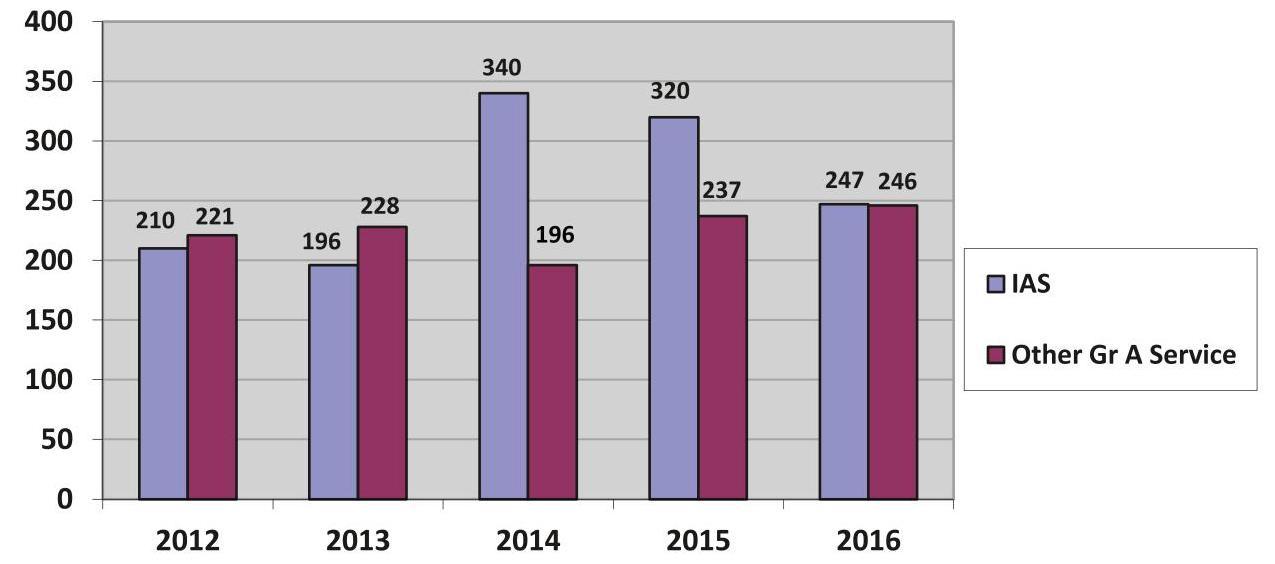
CENTRAL DEPUTATION RESERVE
6.5 The Establishment Officer (EO) Division in the Department of Personnel & Training maintains an electronic database of all IAS officers and Group ‘A’ officers working at the Centre under the Central Staffing Scheme. These records are maintained on the basis of orders/letters/notifications issued by the DOPT, various Central Ministries/Departments and the State Governments. The maintenance/updation of this database is significant, as it helps in
providing readily available digitized information in respect of all officers and also processing of cases for foreign appointments/assignments and training etc.
6.6 The Central Deputation Reserve statement in respect of Indian Administrative Service summarizes the state wise number of officers that are on central deputation vis a vis the senior duty posts. It also indicates the number of officers at various levels presently on central deputation from each cadre.
Central Deputation Reserve (CDR)
| S. No. |
Cadre | No. of Senior Duty Posts |
CDR | No. of officers at Centre |
CDR Utilization (Col. 5 as % of Col. 4 |
|---|---|---|---|---|---|
| $\mathbf{1}$ | $\mathbf{2}$ | $\mathbf{3}$ | $\mathbf{4}$ | $\mathbf{5}$ | $\mathbf{6}$ |
| 1 | Andhra Pradesh | 115 | 46 | 19 | 41.3 |
| 2 | A G M U T | 183 | 73 | 44 | 60.3 |
| 3 | Assam Meghalya | 143 | 57 | 38 | 66.7 |
| 4 | Bihar | 186 | 74 | 41 | 55.4 |
| 5 | Chhattisgarh | 97 | 38 | 5 | 13.2 |
| 6 | Gujarat | 162 | 64 | 18 | 28.1 |
| 7 | Haryana | 112 | 44 | 15 | 34.1 |
| 8 | Himachal Pradesh | 80 | 32 | 23 | 71.9 |
| 9 | Jammu & Kashmir | 75 | 30 | 9 | 30.0 |
| 10 | Jharkhand | 117 | 46 | 9 | 19.6 |
| 11 | Karnataka | 171 | 68 | 19 | 27.9 |
| 12 | Kerala | 126 | 50 | 38 | 76.0 |
| 13 | Madhya Pradesh | 226 | 90 | 29 | 32.2 |
| 14 | Maharashtra | 196 | 78 | 21 | 26.9 |
| 15 | Manipur | 60 | 24 | 14 | 58.3 |
| 16 | Nagaland | 52 | 20 | 8 | 40.0 |
| 17 | Odisha | 129 | 51 | 21 | 41.2 |
| 18 | Punjab | 120 | 48 | 16 | 33.3 |
| 19 | Rajasthan | 161 | 64 | 18 | 28.1 |
| 20 | Sikkim | 27 | 10 | 3 | 30.0 |
| 21 | Tamil Nadu | 204 | 81 | 22 | 27.2 |
| 22 | Telangana | 89 | 35 | 12 | 34.3 |
| 23 | Tripura | 53 | 21 | 13 | 61.9 |
| 24 | Uttarakhand | 66 | 26 | 10 | 38.5 |
| 25 | Uttar Pradesh | 337 | 134 | 68 | 50.7 |
| 26 | West Bengal | 195 | 78 | 12 | 15.4 |
| Total | $\mathbf{3 4 8 2}$ | $\mathbf{1 3 8 2}$ | $\mathbf{5 4 5}$ | $\mathbf{3 9 . 4}$ |
6.7 In addition to the appointments under the Central Staffing Scheme, a total number of 278 appointments as Chairman/ CMDs/MDs/ Deputy
Governor/Chairman/Vice-Chairman/ Members/Executive Directors/Officers Employee Directors/Workmen Employee Directors/
Functional Directors/ Non Official Director were made on the Boards of Public Sector Undertakings and Banks/Financial Institutions during the period 1.1.2016 to 31.12.2016. During the same period, 262 appointments were made at the level of Chairman/Financial Commissioner/General Managers equivalent/ Members/Additional Members/Director General in the Railway Board/Zonal Railways/RCT and Promotion/ empanelment was carried out for appointments to Higher Administrative Grade in Rs. 67,000-
79,000/- and Rs. 75,500-80,000/-to various Group ‘A’Services under the Ministry of Railways.
6.8 Besides, 257 Officers were also approved during the above period for additional charge/current charge/extension of tenure/nonextension of tenure/ad-hoc/rejection/termination of service of GM/DG/VC/CMDs/MDs, Functional Directors, Non-Official Directors in PSUs/ Banks/Financial Institutions, and the Ministry of Railways. Out of these 797 appointments/ additional charge, 29 are women officers.
NUMBER OF APPOINTMENTS OF CHAIRMAN -CUM-MANAGING DIRECTOR/MANAGING DIRECTOR ETC IN PSUs/BANKs
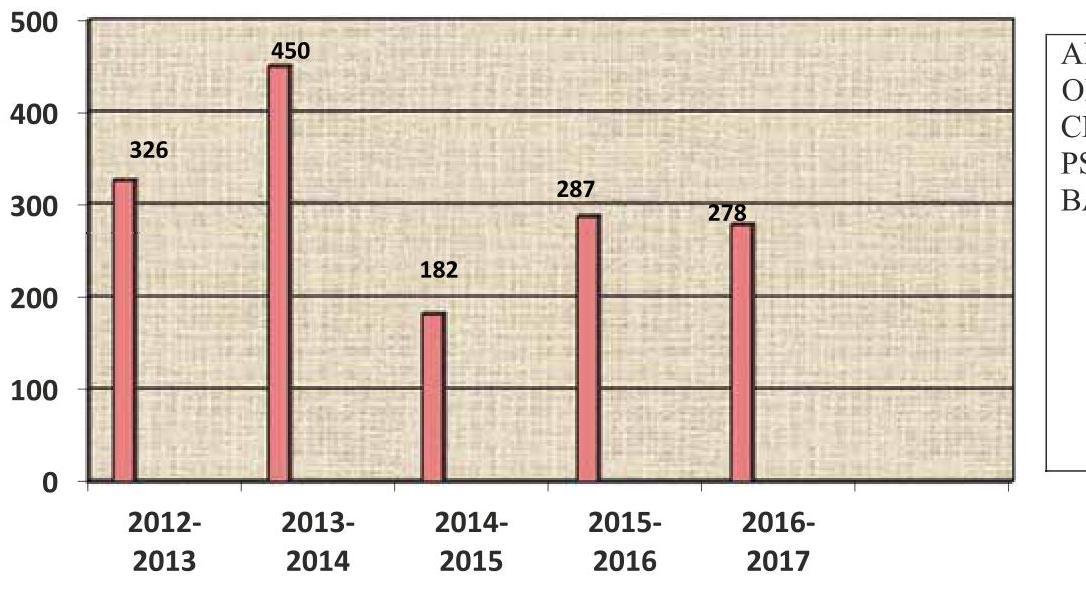
(Up to $31 / 12 / 2016$ )
6.9 During this period 189 Member/Chairman/ Chief Executive Officer/Advisor/ were approved in various Autonomous Bodies, Administrative Tribunals, Labour Courts, and Regulatory Bodies. Out of these 15 are Women officers.
6.10 A total of 1510 officers were approved for empanelment for promotion to posts of and above the level of Joint Secretary in various organized Central Services which are not included in the
Central Staffing Scheme. Out of these, 285 were women officers.
6.11 During the year 2016, the Election Commission of India has asked for nomination of 89 IAS officers for appointment as General Observers for Elections to the State Legislative Assembly of Uttarakhand, Punjab, Manipur, Uttar Pradesh and Goa for bye-elections in various States during the first half of calendar year
2017.Accordingly, nomination of 78 officers was sent to Election Commission of India (ECI) for appointment as Observers during the year 201617 (till 5.1.2017).
GENDER ISSUES
6.12 While taking up empanelment of officers to JS rank, it is ensured that women officers get adequate representation.
6.13 A total of 88 women officers were appointed under Central Staffing Scheme during the period from 1/1/2016 to 31/12/2016 including 64 women officers at Secretary/Addl. Secretary/ Joint Secretary Level.
6.1429 women officers were approved for appointments/holding additional current
charge/Extension of tenure /service as CMDs/MDs, Executive Directors, Functional Directors, Non-official Directors in PSUs/Banks, Financial Institutions, Railway Claim Tribunal (Indian Railways)during the above period.
6.15 A total of 285 women officers were approved for appointment to posts of Joint Secretary level and above in various organized Central Services excluding appointments under the Central Staffing Scheme.
6.1615 women officers were approved for appointment as Member/Chairperson/CEO etc. in various Autonomous Bodies, Administrative Tribunals, Labour Courts, and Regulatory Bodies.
Chapter 7.
TRAINING POLICY AND PROGRAMMES
7.0 The Training Division of the Department of Personnel and Training is the nodal agency for training of government functionaries and is primarily responsible for formulating policies with regard to training. It also implements certain components of training directly. In the implementation of its mandate, the Division has set the following objectives:
- Administering Policy matters in training
- Identification of functional areas of training
- Designing and implementing training programs for officers involved in the priority development sectors
- Development of trainers and training capability
7.1 The ultimate goal of the Training Division is to attain “Training for All” which means that training would be imparted to all rungs of Civil Services starting from the lowest and cutting-edge to the highest in policy making.
Major Activities
1) In-service Training of IAS Officers
2) Mid Career Training of IAS Officers
3) Domestic Funding of Foreign Training
4) Post Graduate Programmes in Public Policy
5) Training Support
6) Intensive Training Programme
7) Augmentation of the Capacity of training institutions
9) E-governance initiatives.
Long-Term Domestic Post Graduate programmes in Public Policy and Management
7.2 These programmes were envisaged to enhance the competence of Mid-Career Civil Servants in Public Policy and Management by –
(i) Broadening awareness of the latest trends in policy approaches,
(ii) Developing technical, analytical and leadership skills for public policy,
(iii) Providing opportunity in specialization and
(iv) Exposing them to alternative systems of public management in other countries.
At present, IIM- Bangalore, MDI- Gurgaon and TERI University- New Delhi are offering these programmes. In order to provide international policy perspective to the participants, each programme has incorporated an international component of 2 weeks in association with reputed international institutes. From year 2015-16 a new one year Hybrid Programme “Management of Public Policy Programme (MPPP)” at Indian School of Business (ISB)Hyderabad/ Mohali was also conducted.
During 2016-17, $15^{\text {th }}$ Batch of Post Graduation Programme in Public Policy and Management (PGPPM) at Indian Institute of ManagementBangalore, $8^{\text {th }}$ Batch of Programme in Public Policy & Sustainable Development (PP \& SD) at TERI University- New Delhi and $10^{\text {th }}$ Batch of Post Graduation Diploma Programme in Public Policy and Management were launched.
Mid-Career Interaction between Armed Forces and Civil Services Officers
7.3 Mid-Career interactions between Armed Forces and Civil Services Officers are being organized at the Central Training Institutes/State Administrative Training Institutes and Defence Institutions in various parts of the country with an objective to benefit both the Armed Forces and Civil Services Officers by way of mutual learning from each other’s strength and also by imbibing the best points of each other’s work culture, ethos and customs. This, in the long run, is expected to help the participating officers to combat future challenges to national security in a better manner.
During the current financial year 2016-17, 6 programmes have been planned so far on themes like Drug Trafficking, Counterfeit Currency, Eastern Maritime Theater- Opportunities, Challenges and sea based threats, Misuse of social mass comm. (Media) Facilities for anti National activities and remedial measures, Cyber Security and Crime, Low Intensity Conflict Operations, Employment of Air Power. Three programmes have already been conducted so far and remaining three are to be conducted from January 2017 onwards.
Capacity Building Programmes for State Civil/Secretariat Service Officers of North Eastern Region
7.4 DoP\&T has approved two Capacity Building Training Programmes of two weeks’ duration for the State Secretariat Service Officers and State Civil Services Officers of North Eastern Region States at Institute of Secretariat Training and Management (ISTM)- New Delhi and Yashwantrao Chavan Academy of Development Administration (YASHDA)- Pune respectively during the current financial year. Capacity Building Training Programme for State Secretariat Service Officers at ISTM-New Delhi was attended by 31 officers of Meghalaya, Mizoram and Assam. Training Programme for the State Civil Services Officers of North Eastern Region States is to be conducted at YASHDAPune during the month of January, 2017. The objectives of these programmes are capacity building, personality development and sensitization to national and developmental issues. The programme also covers inputs on Good Governance, Public Service Delivery, Project Appraisal \& Management and Public Private Partnership.
TRAINING SUPPORT
THEMATIC TRAINING PROGRAMMES : STATE CATEGORY TRAINING PROGRAMME
7.5 Under the scheme of “Training for All”, support is provided to State Administrative Training Institutions (ATIs) by way of sponsoring training programmes in the areas accorded priority by the Central Government. The Training Programmes conducted by the State ATIs are
designed to develop management skills and knowledge in different areas for senior and middle level officers of State Govt. /State Public Sector Undertakings and State autonomous bodies. These training courses are also meant to sensitize the officers to new and important issues facing our society. The courses are also being conducted at District and Sub District Centres of the State ATIs. These courses cover a large variety of subjects under broad thematic groups.
During the year 2016-17, 513 such shortterm courses have been sponsored at various State ATIs on subjects such as Computer & IT, Human Rights, Leadership \& Team Building, Court Procedures, Office Procedures, Audit \& Budget, Women Empowerment, Child Development, Consumer Rights, Role of NGOs, Public Private Partnership, Labour Law, Panchyati Raj, Road Safety, Right to Information, Establishment Rules, Gender Issues, Disability Issues, Minority Issues, Ethics \& Values in Governance, Decentralized Planning, Disaster Management, Financial Management, Urban Management, EGovernance, Cyber Security, Environment Issues etc. As on December 31, 2016, out of 513 sponsored courses, 302 courses have actually been conducted and 8475 participants have been trained under this Scheme.
TRAINER DEVELOPMENT PROGRAMME
7.6 Recognizing the importance of trainers in the training function, Training Division started the Trainer Development Programme in the early 1990s. Initially, faculty members of various training institutions were developed as Master Trainers and Recognized Trainers of various “Training of Trainers (ToT)” packages in
collaboration with the Thames Valley University of U.K. Over a period of time, indigenous mechanisms were evolved for developing a cadre of professional trainers and resource persons in the country to create a cascading and multiplier effect. The programme has gone a long way in embedding the Systematic Approach to Training (SAT) into the process of designing and imparting effective training to government officials.
7.7 Currently, the following ToT programmes are sponsored under Trainer Development Programme at various training institutions across the country:
- Training Needs Analysis (TNA)
- Design of Training (DOT)
- Direct Trainer Skills (DTS)
- Evaluation of Training (EoT)
- Management of Training (MoT)
- Experiential Learning Tools (ELT)
- Mentoring Skills
- Facilitation Skills
- Introduction to SAT courses
7.8 The Department has developed a pool of 59 Master Trainers and 333 Recognized Trainers in different packages under this Scheme, who are called upon to conduct TDP courses. DoPT has sponsored 89 TDP courses on various packages during the current financial year 2016-17. As on December 31, 2016, out of 89 sponsored courses, 64 courses have actually been conducted and 955 faculty have been trained under this Scheme.
INTENSIVE TRAINING PROGRAMME
7.9 Intensive training programme for frontline Government functionaries of State Governments was initiated during the year 2008-09. The focus
of this programme is on demand-driven training of frontline personnel and is conducted in close coordination with line Departments by the State Administrative Training Institutes (ATIs). The programme was given a momentum through issue of new ITP implementation and management guidelines to all the Chief Secretaries and the State ATIs; holding three workshops in the beginning covering all 29 States at Delhi, Hyderabad and Assam; followed by workshops, mid-term-reviews of this programme in Chandigarh, Shillong and Goa.
The intensive training programme has been implemented in more than 130 districts and approximately 11000 officials have been trained so far. Some of the sectors covered under the Programme include – Public Health, School Education, Public Distribution System, Revenue, Water and Sanitation, Integrated Child Development Services, Dairy Development, Registration, Social Welfare, Police, Citizen Centric Delivery and Right to Public Services Act. A national documentation-cum-facilitation centre for this programme has been established (www.itpndfc.in) under which an ITP knowledge portal is in existence for the benefit of general public and for the use of all those who are involved in the process of implementation of this Programme.
INDUCTION TRAINING PROGRAMME
7.10 In order to promote a citizen centric attitude in the employees, for better public service delivery and promote good practices towards achieving the vision of citizen centric governance Department of Personnel and Training had launched a capacity building programme on pilot basis in three States of Jammu & Kashmir,
Maharashtra and Tamil Nadu for 3000 newly recruited cutting edge level government functionaries to develop in them Generic \& Domain specific competencies covering 15 districts in the financial year 2014-15.
After successful completion of the Pilot, a 12Days Induction Training Programme (ITP) was launched in the year 2015-16 in 103 districts of 21 States with a Two Day Regional Training of Trainers (ToT) Workshop at various State ATIs for training of 7000 frontline State government functionaries. A motivational talk by locally available inspirational achievers/national award winners/sports persons in the inaugural session of the ToT Workshop and training programme in the districts, one day blood donation camp during the middle of the course and one night stay in the village as part of field/NGO visit were compulsory component of the 12 Days Induction Training Programme.
In the year 2016-17, the Induction Training Programme is being implemented in 117 new districts of 22 States.
DOPT-UNDP PROJECT ‘STRENGTHENING HUMAN RESOURCE MANAGEMENT OF CIVIL SERVICE’ (SHRM)
7.11 SHRM project is a five year partnership between UNDP and DOPT. The main outcomes of the project are shift towards competency-based human resource management of civil services; strengthening capacities of LBSNAA, NCGG, State ATIs and other Government Training Institutions; and development and piloting of Innovative training tools and methodologies.
After the development of Competency Dictionary for Civil Services 2013, as a further step towards competency-based approach, DoPT had conducted a pilot on Competency Mapping in two Departments, namely DoPT and the Ministry of Corporate Affairs (MCA) and other cadre i.e. Central Secretariat Services (CSS). In 2016 the pilot has moved further to its next step of Assessment and Development Centers for a select group of 80 officers from DoPT and CSS. The idea is to use the Assessment and Development centers for identifying training needs of the select officers.
An effort to build capacities of civil servants through the initiative on National Pool of Trainers has been taken further in 2016. The initiative focuses on developing modules and National Pool of Trainers on two thematic areas of Gender and Urban Planning & Management. The objective is to promote a high quality module developed by reputed institutes and delivered by scientifically trained National Facilitators on a pan India basis to ensure better learning of the skills.
With a view to streamline implementation of National Training Policy (NTP), a Functional Manual for Training Managers has been created. The purpose of this Manual is to develop competence of Training Managers in the Ministries/Departments so that they are able to establish training function in the department as envisaged in the National Training Policy; adopt training function to effectively support government initiatives and programmes; provide support and guidance to Ministries in the design and implementation of capacity building schemes, and become facilitators in competency
based human resource management. Three workshops for Training Managers have been organized in the year 2016 to give them practical experience to enable them to fulfill the mandate of NTP.
LEARNING RESOURCE CENTRE
7.12 National Training Policy – 2012 recommended setting up of a Learning Resource Centre (LRC) for identifying and adapting the leading national and international practices in the field of training techniques and technologies; for strengthening of Trainers Development Programme(TDP).
LRC reviewed the existing TDP packages, conducted Focused Group Discussions (FGDs) and workshops for stakeholder consultation and upgraded the Training Need Analysis (TNA) as a blended package. In continuation LRC has reviewed and conducted a stakeholder workshop to upgrade the Design of Training (DOT) module. A core group was set up to review and develop blended modules on National Training Policy (NTP) and Systematic Approach to Training (SAT). LRC has reviewed and will subsequently undertake strengthening and upgrade of all the TDP packages namely DTS, ELT, Facilitation, Mentoring, EoT and MoT.
LRC has been actively involved in supporting DoPT on various initiatives related to training and development. The content module and Training of Trainer programme was designed for the Induction Training Programme (ITP) for frontline functionaries of State government and more than 20 ToT workshops were conducted for master trainers of 26 States since the launch of the
Programme. LRC has also been instrumental in creating a resource bank of NGOs by visiting State ATI recommended NGOs, which can offer immersion programmes for government functionaries.
LRC has actively supported DoPT in Developing the concept note, workshop framework, website content, planning and implementation of the National Symposium on Excellence in Training.
National Centre for Good Governance
7.13 The National Centre for Good Governance (NCGG) has been established by the Government of India under the aegis of the Department of Personnel and Training by upgrading the erstwhile National Institution of Administrative Research (NIAR), Lal Bahadur Shastri National Academy of Administration (LBSNAA), Mussoorie, with an expanded Mandate The focus of the NCGG is action-oriented research on good Governance. The Centre also functions as a national repository on information on best practices, initiatives and methodologies that promote good Governance, e-Governance initiatives, change management and capacitybuilding within the Government. NCGG is an autonomous institution registered as a Society under the Society Registration Act 1860, with its Head Office at New Delhi and a registered office at Mussoorie.
Mandate of NCGG:
7.14 The National Centre for Good Governance is an apex think- tank of the country that would guide and help to implement good Governance
reforms. It is a high-level institute for research and training to deal with the entire gamut of governance issues from the National to State to the local level and in sectors across the Government. NCGG is a national level multidisciplinary institute devoted to action-research and analytical studies for supporting good governance strategy, action plan and their implementation with its jurisdiction all over India.
The NCGG is working towards resolution of key issues in Governance, analyze policy and programme implementation, develop action plans, support governance reforms and help in developing synergy across various sectors and Ministries/Departments.
Governing Body:
7.15 NCGG is governed by a Governing Body, under the Chairmanship of the Cabinet Secretary. The affairs of the Society are being managed under the overall superintendence, direction and control of the Governing Body. The other members include ex-officio members from the GoI, the Secretary, DOPT and key Government Secretaries as well as eminent academician, distinguished personalities from the private sector and non-government organizations with expertise and interest in governance reforms.
Management Committee:
7.16 NCGG also has a Management Committee with Secretary, Department of Personnel & Training (DOPT) as the Chairperson. The other members are heads of reputed training institutes, research organizations and eminent administrators and academicians.
7.17 Activities of NCGG during the year 2016-17
A. Training Programmes ( $1^{\text {st }}$ April 2016 to $31^{\text {st }}$ December, 2016)
i. International Programmes
| SI. No. | Name of the programme | Dates | No. of Participants |
|---|---|---|---|
| 1. | Mid-Career Training Programme in Field Administration for Civil Servants of Bangladesh (27 MCTP) |
$23^{\text {rd }}$ May, 2016 to $4^{\text {th }}$ June, 2016 |
27 |
| 2. | Mid-Career Training Programme in Field Administration for Civil Servants of Bangladesh (28 MCTP) |
$13^{\text {th }}$ July, 2016 to $25^{\text {th }}$ July, 2016 |
27 |
| 3. | Mid-Career Training Programme in Field Administration for Civil Servants of Bangladesh (29 MCTP) |
$1^{\text {st }}$ August, 2016 to $11^{\text {th }}$ August, 2016 |
19 |
| 4. | Mid-Career Training Programme in Field Administration for Civil Servants of Bangladesh (30 MCTP) |
$28^{\text {th }}$ September, 2016 to $10^{\text {th }}$ October, 2016 |
26 |
| 5. | Mid-Career Training Programme in Field Administration for Civil Servants of Bangladesh (31 MCTP) |
$7^{\text {th }}$ November, 2016 to $19^{\text {th }}$ November, 2016 |
32 |
| 6. | Mid-Career Training Programme in Field Administration for Civil Servants of Bangladesh (33 MCTP) |
$29^{\text {th }}$ November, 2016 to $11^{\text {th }}$ December, 2016 |
26 |
ii. National Programmes
| SI. No. | Name of the programme | Dates | No. of Participants |
|---|---|---|---|
| 1. | Management Development Programme for Senior Officers of Lok Sabha Secretariat |
$13^{\text {th }}$ June,2016- $17^{\text {th }}$ June, 2016 |
19 |
| 2. | Residential Domestic Training Programme for the officers of Odisha Administrative Service |
$17^{\text {th }}$ October,2016- $21^{\text {st }}$ October, 2016 |
24 |
B. Proposed training programmes from 1st January, 2017 to 31st March, 2017)
i. International Programmes
| SI. No. | Name of the programme | Dates | No. of Participants |
|---|---|---|---|
| 1. | Mid-Career Training Programme in Field Administration for Civil Servants of Bangladesh (34 MCTP) (On Going) |
$2^{\text {nd }}$ January, 2017 to $14^{\text {th }}$ January, 2017 |
28 |
| 2. | Mid-Career Training Programme in Field Administration for Civil Servants of Bangladesh(35 th MCTP) |
$6^{\text {th }}$ March ,2017 – $18^{\text {th }}$ March, 2017 |
30 |
|---|---|---|---|
| 3. | First Advanced Leadership Development Programme on Governance & Public Policy for African Civil Servants |
$7^{\text {th }}$ March ,2017 – $19^{\text {th }}$ March, 2017 |
30 |
| 4. | $5^{\text {th }}$ Special Training Programme for Deputy Commissioners of Bangladesh |
$26^{\text {th }}$ March ,2017 – $5^{\text {th }}$ April, 2017 |
16 |
C. List of Training Programmes held from April 2016 to till date (KRC)
| S No |
Training Subject | Month/Year | Venue |
|---|---|---|---|
| 1. | 5-Days ToT Workshop for KRCs on CATS/CLTS | 4-8 April, 2016 | Mau, U.P. |
| 2. | 3-Days Capacity Building Training Programme on Swachh Bharat Mission (G) for Block Development Officers for the State of Uttar Pradesh | 11-13 April, 2016 | SIRD, Bakshi Ka Talab, Lucknow |
| 3. | 5-Days ToT Workshop for KRCs on CATS/CLTS | 16-20 May, 2016 | Aligarh Club, Aligarh (U.P.) |
| 4. | 2-Days Capacity Building Training Programme for District Magistrate/District Collectors on Swachh Bharat Mission (G) | 20-21 June, 2016 | IIC, New Delhi |
| 5. | 2-Days Capacity Building Training Programme for District Magistrate/District Collectors on Swachh Bharat Mission (G) | 18-19 July, 2016 | IIC, New Delhi |
| 6. | 2-Days Capacity Building Training Programme for DMs/DCs on Swachh Bharat Mission (G) | 16-17 August, 2016 | IIC, New Delhi |
| 7. | 2-Days Capacity Building Training Programme for DMs/DCs on Swachh Bharat Mission (G) | 30-31 August, 2016 | IIC, New Delhi |
| 8. | 2-Days Capacity Building Training Programme for DMs/DCs on Swachh Bharat Mission (G) | 26-27 Sept., 2016 | IIC, New Delhi |
| 9 . | 2-Days Capacity Building Training Programme for DMs/DCs on Swachh Bharat Mission (G) | 20-21 Oct., 2016 | IIC, New Delhi |
| 10. | 2-Days Capacity Building Training Programme for DMs/DCs on Swachh Bharat Mission (G) | 24-25 Oct., 2016 | IIC, New Delhi |
| 11. | 2-Days Capacity Building Training Programme for DMs/DCs on Swachh Bharat Mission (G) | 7-8 Nov., 2016 | IIC, New Delhi |
| 12. | 2-Days Capacity Building Training Programme for DMs/DCs on Swachh Bharat Mission (G) |
$15-16$ Nov., 2016 | IIC, New Delhi |
|---|---|---|---|
| 13. | 3 Days Capacity Building Training Programme on Swachh Bharat Mission (G) for Block Development Officers for the State of Chhattisgarh |
$7-9$ Dec., 2016 | Chhattisgarh Academy of Administration, Nimora, Raipur |
| 14. | 2-Days Capacity Building Training Programme for DMs/DCs on Swachh Bharat Mission (G) |
$19-20$ Dec., 2016 | IIC, New Delhi |
D. List of Tentative/Proposed Training Programmes upto March, 2017 (KRC)
| S No |
Training Subject | Month/Year | Venue |
|---|---|---|---|
| 1. | 3 Days Capacity Building Training Programme on Swachh Bharat Mission (G) for Block Development Officers for the State of Bihar |
$23-25$ Jan., 2017 | BIPARD, Patna |
| 2. | 3 Days Capacity Building Training Programme on Swachh Bharat Mission (G) for Swachh Bharat Mission (Fellow) |
$8-10$ Feb., 2017 | New Delhi |
| 3. | 3 Days Capacity Building Training Programme on Swachh Bharat Mission (G) for Swachh Bharat Mission (Fellow) |
$21-23$ Feb., 2017 | New Delhi |
| 4. | 3 Days Capacity Building Training Programme on Swachh Bharat Mission (G) for Swachh Bharat Mission (Fellow) |
$7-9$ March, 2017 | New Delhi |
| 5. | 3 Days Capacity Building Training Programme on Swachh Bharat Mission (G) for Swachh Bharat Mission (Fellow) |
$21-23$ March, 2017 | New Delhi |
E. Work of simplification
7.18 NCGG is mandated to do the work of simplification of forms of 9 departments till March 2017. The methodology adopted so far involves four steps: forming a core group consisting of departmental employees; working intensively with the core group over a week or so; organizing one or more technical workshops involving stakeholders as well as concerned departmental officials for discussion on suggested changes and adoption of proposed changes by the department. Workshops involving DoPT, Rural
Development, Labour departments, Department of Ex-Servicemen Welfare, Department of Empowerment of Persons with Disabilities, Department of Fertilizers, Ministry of Civil Aviation & Directorate General of Labour Welfare have been held. 3 Departments/ ministries shall be completed by January – March 2017.
7.19 Mid Career Training Programme (MCTP)
Mid Career Training policy for IAS officers was reviewed during 2015-16 and approved the following for the various phases of MCTP:
(i) The first Phases of MCTP would be for officers of 7-9 years of service seniority for duration of four weeks.
(ii) The second Phase of MCTP would be for officers of 14-16 years of service seniority for duration of four weeks with one week foreign component;
(iii) The third phase of MCTP would be for officers at 26-28 years of service seniority for duration of two/three weeks.
In addition, it was also decided that all Cadre Controlling Authorities would take appropriate action to re-organize MCTP in the similar manner as finalized for the IAS.
Accordingly, all Ministries/Departments have been requested to re-organize MCTP in the similar manner for other Group ‘A’ Service officers of their cadres.
Overseas Training Programmes
7.20 Department of Personnel and Training has been nominating officers for training programs abroad. In the past, these programs were funded by bilateral or multilateral assistance. However, over the years, this assistance had come down. Keeping in view the importance and benefits of providing international exposure to the officers, a scheme of Domestic Funding of Foreign Training (DFFT) was started in 2001. This covers both long term and short-term training in various universities/institutes in several countries. A scheme of “Partial Funding of Foreign Study” was also started in 2002-03 as another component of the scheme of DFFT. Under this scheme, Government of India provides limited financial assistance to such officers who secure admission on their own in reputed universities and in
programs relevant to their present or future job context.
During the financial year (as on 06/01/2017), 21 officers were nominated for long term foreign training programmes and 262 officers were nominated under short term foreign training programmes. Further, 8 officers have also been granted partial funding assistance under the DFFT Scheme. During the remaining period of 2016-17, 33 officers are slotted to go in Short Term programs under DFFT scheme.
Scheme of scholarship by Private Foundation Trust
7.21 A scheme for scholarship offered by private foundation/trust in top 10 ranked universities as per the world university ranking for officers of all the three All India Services has been approved by the Government. Funding under this scheme is available for pursuing programmes in Master in Public Policy/Public Administration/ International Development and Master in Business Administration, subject to the eligibility conditions.
Under this scheme, ‘Desai Sethi Family Foundation’ has offered ‘Desai Sethi Family Foundation Fellowship’. On this, two fellowships/scholarships are available for officers belonging to Indian Administrative Service, Indian Foreign Service, Indian Police Service and Indian Forest Service for pursuing a 2 year Masters programme in Public Policy/Public Administration/International Development at Harvard Kennedy School, Harvard University. The funding is US$ 50,000 per officer per year. The guideline on the fellowship is available on the website of this Department.
One-week In-Service Training (IST) Programs for Officers of All India Services and for those working under Central Staffing Scheme- Sponsored by Department of Personnel & Training
7.22 The Training Division sponsors ‘In-Service Training Programme’ of ‘one-week duration’ in various ATIs/CTIs/Other Premier Training Institutes in the country by inviting proposals from them on relevant themes. During current year (2016-17), 20 programmes have been offered at 13 selected institutions. These programmes provide select middle to higher management level officers an opportunity to update their skills in area of their own choice-in a sector they are currently working in, or in an area they expect to work in near future, or in a theme they feel they should specialize. These programs also provide a valuable platform for horizontal and vertical knowledge sharing.
7.23 The primary objective of the IST program is to sensitize the participants to national concerns and the values enshrined in the Constitution; to provide for exchange of experience and adequate discussion on issues of values, ethics and attitudes; to make the participants more confident to face problems in their work areas and attempt solutions; and to train the participants to look at problems in an integrated manner and develop a systems approach.
7.24 In past, these programs have been offered in diverse and broad thematic area: such as governance issues; sector specific coverage of agriculture, education, rural development, urban development, social policy; climate change, Natural Resource Management; ethics,
corruption; e-Governance; fiscal policy and macroeconomic management, WTO and trade issues; PPP, Project Appraisal, Environment Impact Assessment, Project Analysis; Public Policy making, Decision science, and quantitative methods.
In-House Training Programme
7.25 With a view to build the capacity of employees and as per the direction of Hon’ble Prime Minister, weekly One Hour Training for the officials of DoPT from LDC to Director Level on various topics has been started w.e.f. 09.10.2014. Weekly training also includes training of official of CSSS upto the rank of PPS. So far six modules viz. ‘Filing System’, ‘Noting and Drafting’ and ‘Gender Sensitization’, ‘Litigation Management (Handling of Court and CAT Cases)’and Preventive Vigilance have been completed. Seven modules on ‘Records Management’ has been started from 09.11.2016.
Half day workshop(s) on ‘File Management’ for the Officers/Officials of DoP\&T in Institute of Secretariat Training \& Management
7.26 DoPT conducted a workshop in collaboration with ISTM for its employees for creation and up keeping of files in good shape, as per the provisions contained in Central Secretariat Manual of Office Procedures in eleven batches. The CSS officials at the level of Assistant Section Officer to Under Secretaries and CSSS officials at the level of PA to PPS are benefitted with this workshop.
Advanced Professional Programme in Public Administration (APPPA) At Indian Institute of Public Administration, New Delhi
7.27 The Training Division has been sponsoring a ten-month Advanced Professional Programme in Public Administration (APPPA) at the Indian Institute of Public Administration (IIPA), New Delhi every year since 1975-76.
7.28 The objectives of this programme is to prepare the participants to make a greater contribution to better governance, develop attitudes that focus on citizen services and also to strengthen leadership qualities in the civil service. It provides an opportunity to the participants to analyze major contemporary issues in Governance, learn about recent developments in the social sciences and their application in administration; review their experiences by making a critical analysis of environmental and other factors, apply relevant concepts, skills and techniques relating to policy, behavioral and administrative sciences and to demonstrate their creative and analytical abilities individually and in groups. It also seeks to develop interpersonal skills and sensitiveness to the needs of the people with a view to making administration more responsive and result oriented.
7.29 The course covers classroom studies relating to various facets of administration viz, Social, Political, Economic, Legal and Administrative Systems, Organizational
Behavior, Social Science and Research Methods, Operational Research, Information Technology in Management and Financial Management. Participants are also required to conduct rural and urban field studies and prepare a project report and dissertation. They are expected to select an area for specialization relevant to their present and likely future assignments from following fields of study: Advanced Information Technology and MIS, Comparative Development Experience, Project Management, Constitutional Law, Disaster Management, Economics of Regulation, Inter Governmental Relations, Management Systems, Organizational Needs Analysis, Public Expenditure Management, Public Organizational Theory, TQM, Finance, Personnel, Corporate or Public Sector Management, General Administration, Planning and Rural Development etc.
7.30 This 10 month programme includes three semesters, rural and urban field visits in India and a 10 day foreign study tour. In the $41^{\text {st }} A P P P A$ Programme, the participants visited in two groups to Brazil & Netherlands and South Africa \& Sweden. The $42^{\text {nd }}$ APPPA Programme in this series is being held from July 1, 2016 to April 29, 2017. 48 participants are attending this programme.
Chapter 8.
TRAINING INSTITUTIONS
LAL BAHADUR SHASTRI NATIONAL ACADEMY OF ADMINISTRATION, MUSSOORIE (UTTARAKHAND)
Introduction
8.0 The Lal Bahadur Shastri National Academy of Administration (LBSNAA), Mussoorie is Government of India’s premier institution for the training of higher civil services in the country. The Academy imparts induction level and in-service training. A common Foundation Course is held for entrants to All India Services and all Group “A” services of the Union. The professional training to regular recruits of the Indian Administrative Service (IAS) and members of the Royal Bhutan Civil Service is conducted after the Foundation Course. The Academy also conducts in-service and Mid-Career Training Program (MCTP) for members of the IAS and Induction Training program for officers promoted to the IAS from State Civil Services, as well as workshops and seminars on various issues in public administration.
8.1 To ensure that the academic curriculum is relevant, it is constantly reviewed and updated through extensive consultations with the representatives of the state governments, the central government and other scholars and practitioners. Given the limitations of conventional classroom lectures, new pedagogical methods have been introduced to deliver training inputs in a more effective manner. Most courses operate on a modular structure whereby relevant themes are chosen and dealt with in a consolidated fashion to
ensure that all aspects relating to them are covered comprehensively.
8.2 In order to promote all-round development of the personality, due emphasis is placed on outdoor and co-curricular events. Physical training, team games and tennis, badminton cross-country running, yoga, horse riding, and adventure sports like river rafting, para-gliding, bungee jumping and rifle shooting are some of the activities that the officer trainees are involved in. Exposure to public speaking, theatre workshops, motor mechanic skills, gardening, photography and music appreciation are some of the cocurricular activities offered to the young administrators.
To nurture the values of integrity, moral courage, empathy and respect for the underprivileged, and freedom from any sectarian prejudices based on religion, region, caste, class or gender, Officer Trainees are encouraged to participate in diverse social activities. Various Clubs and Societies have been formed to which the Officer Trainees are elected as office-bearers. They organize and take part in quizzes, debates, poetry competitions and numerous other activities after class hours. This lends a spirit of bonhomie and also promotes esprit de corps.
Induction Training Courses
8.3 The Academy conducts Induction training courses for direct recruits to the IAS and other senior civil services as well as officers promoted to the IAS.
Foundation Course (15 Weeks)
8.4 The Foundation Course is the flagship course of Induction training and is intended for fresh entrant to the All-India Services, i.e. the Indian Administrative Service, the Indian Police Service and the Indian Forest Service, and the various Central Services (Group-A) of the Union. It is a fifteen-week course conducted from September to December every year. The course aims at imparting a basic understanding of the constitutional, political, socio-economic and legal framework of the country; and also fostering
greater co-ordination among the members of the different public services by building esprit-decorps and cultivating an attitude of co-operation and inter-dependence. This year total of 377 Officer Trainees including 05 officers from RBCS and RBFS participated in the Course scheduled from $29^{\text {th }}$ August, 2016 to $9^{\text {th }}$ December, 2016. Hon’ble President of India Shri Pranab Mukherjee was the Chief Guest on the valediction of the Course on December $9^{\text {th }}, 2016$. The course was inaugurated by the Shri Rajeev Kapoor, IAS, Director, LBSNAA.
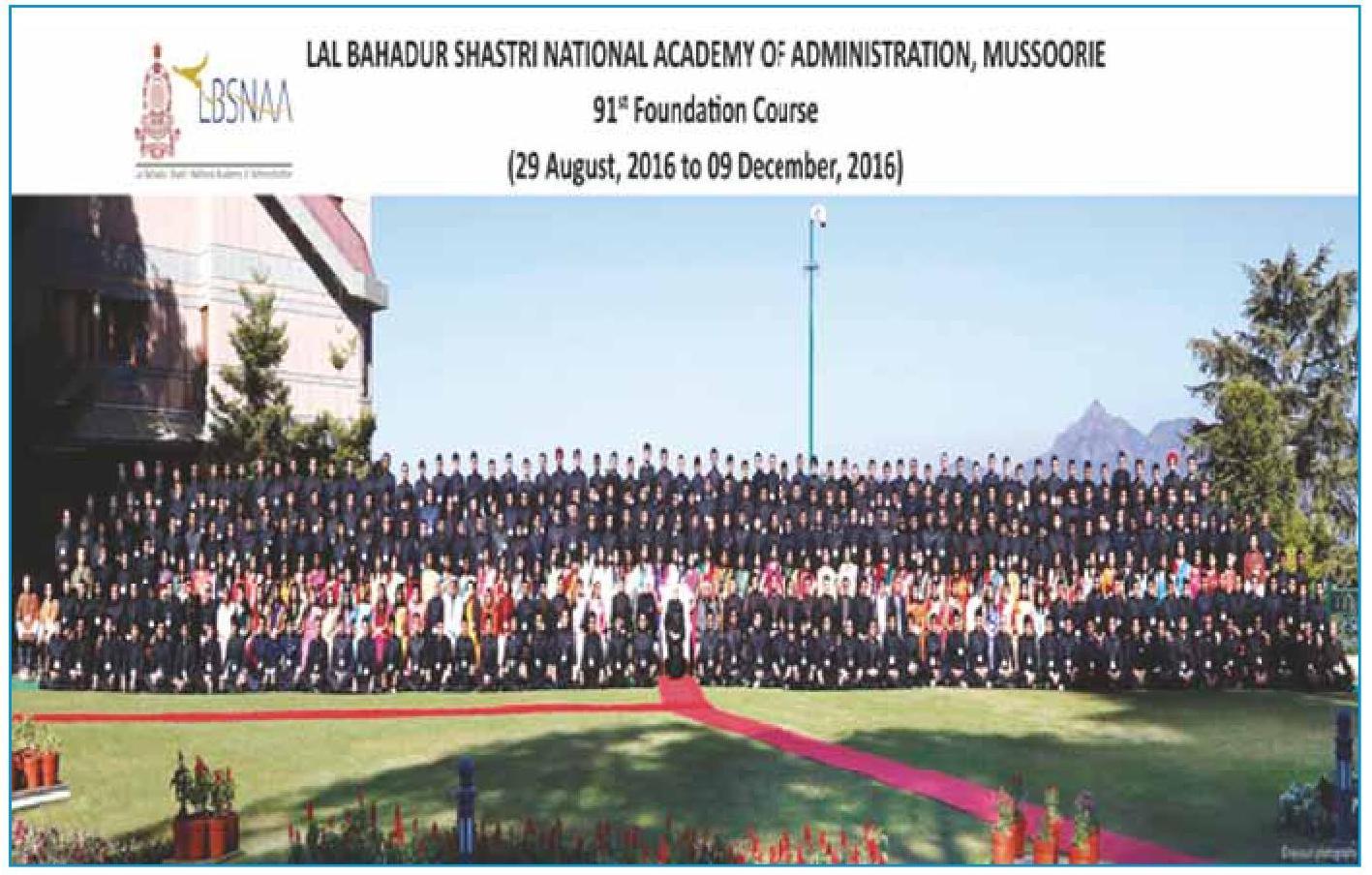
Valediction of $91^{\text {st }}$ Foundation Course, 2016
Parallel Foundation Courses were also conducted at MCR HRD Institute, Hyderabad and RCVP Noronha Academy of Administration, Bhopal.
The main activities organized during the Foundation Courses were:
- Trekking: The objective of trek is to inculcate the spirit of adventure and to strengthen Esprit de corps in the Officer Trainees. The trek is
also a significant learning experience in group dynamics, interpersonal relations, courage, endurance and love and respect for nature.
2. Village Visit Programme: Officer Trainees spent one week in select villages in Uttar Pradesh, Bihar, Madhya Pradesh and Rajasthan in groups of 6 . Here they were sensitized to the empirical realities of rural India, through a structured study of a village. A special feature of the village visit this year was organization of “Swachatta Diwas” in each of the selected villages when the trainees
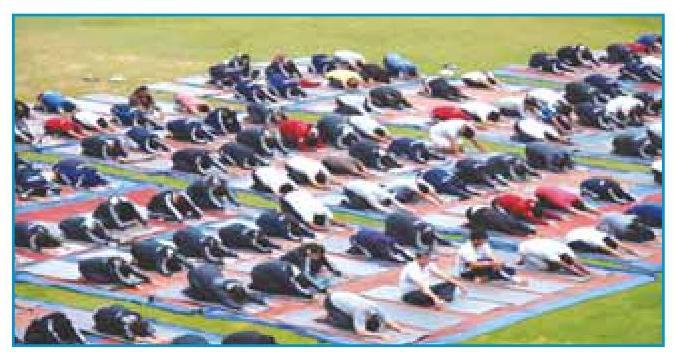
Yoga at the Academy on International Yoga Day on June 21, 2016
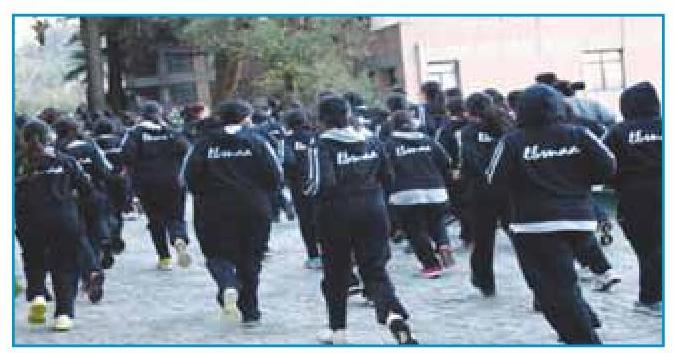
CROSS-COUNTRY RACE IN $91^{\text {st }}$ FOUNDATION COURSE
raised awareness about the cleanliness mission of the Government and also undertook cleanliness drives in the villages along with the residents.
3. Extra-Curricular Activities are conducted in the afternoons and evenings in order to impart
skills other than purely academic to the trainees in recognition of the need for an officer to have diverse interests and a well-rounded personality. Primarily, these include celebration of India Day, AK Sinha One-Act Play Competition, Cross Country Run, Athletic Meet and Blood Donation Camp.
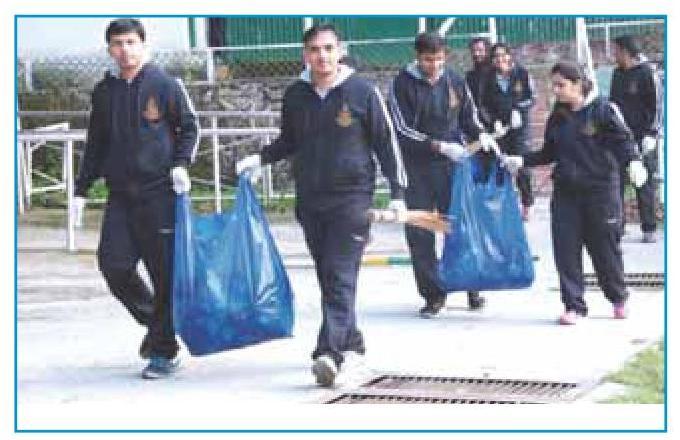
OFFICER TRAINEES DOING SHRAMDAN
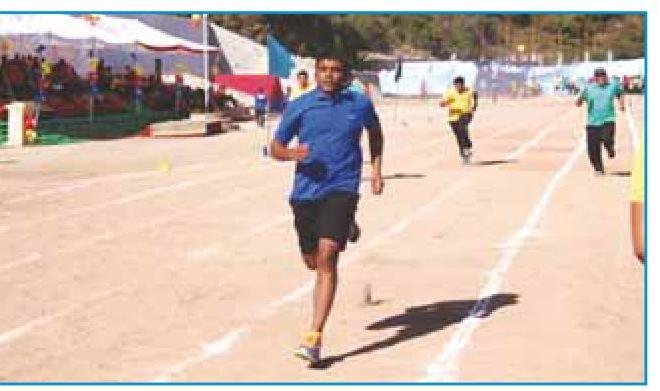
ATHLETIC MEET
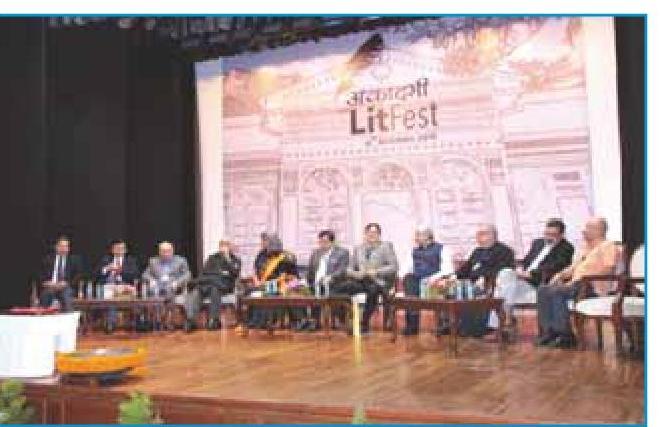
LITFEST IN OCTOBER 2016
8.5 To provide a forum for showcasing the multifarious talents of the Officer Trainees, various cultural programmes are organized. The A.K. Sinha One Act Play Competition displays the acting skills of the trainees. Apart from these, cultural programmes and India Day were organized to instill in the trainees a sense of the diversity and oneness of the country. The trainees themselves highlight the cultural traditions of various parts of the country through exhibitions, cuisine and folk dances, etc. AFete was organized in order to inculcate the spirit of entrepreneurship among the trainees, proceeds of which go to the Society for Social Services.This year several debates and discussions were organized under the auspices of the Society for Contemporary Affairs on issues of topical interest
IAS Professional Course Phase-I (25 Weeks)
8.6 The IAS Officer Trainees of the 2015 batch (total 118 including 03 Officers Trainees from Royal Bhutan Civil Service) underwent the IAS Professional Course Phase-I from December21, 2015 to June10, 2016. Traditionally a 26 weeks course, the academic component was reduced by a week this year by the Government. This course aims at developing professional skills in handling a large range of responsibilities that an officer shoulders within the first ten years of service. Emphasis is laid on understanding public systems and their management, together with a grounding in Public Administration, Law, Economics, Management and Computer applications. During the first part of Phase-I, the Officer Trainees were sent on a 9 weeks Winter Study Tour (Bharat Darshan) comprising of attachments with the three Armed Forces, Public Sector, Private Sector Units,
Municipal Bodies, Voluntary Agencies, and civil administration in challenging areas, etc. After completion of IAS Phase-I, they were relieved on June10, 2016 for their District Training as part of IAS Professional Course Phase-II.
District Training (49Weeks)
8.7 During the year-long District Training, the Officer Trainees learn about the various facets of administration at the district level. During this period they are under the direct charge of the District Collector and the State Government. They get an opportunity to obtain first-hand knowledge of the work of the Collector/ District Magistrate and various other institutions in the State government, along with orientation training at the State Administrative Training Institute. Most of the State Governments give them an opportunity of holding independent charge as Tehsildar/ Mamlatdar, Sub Divisional Magistrate, Block Development Officer and/or Executive Officer of a Municipality. The 2015 batch of the IAS will return to the Academy for their second phase of professional training commencing on May 22, 2017.
IAS Professional Course Phase-II (06 Weeks)
8.8 While theoretical concepts are sought to be imparted in the Foundation and Phase-I courses, the ground level delivery mechanisms are expected to be imbibed during District Training. Phase-II is a time to debrief and share experience and good practices from the various states of the country. The course content of Phase-II is designed to consolidate the learning and assimilation of the district experience with the theoretical constructs taught earlier. A total of
181Officer Trainees (including 5 trainees of 2013 batch and 1 trainee of 2012 batch and 03 Officers of Royal Bhutan Civil Service) underwent the Phase II course organized from June 20, 2016 to July 29, 2016. Upon completion of the Phase II course, the officers proceeded for 3 months deputation to the Government of India as Assistant Secretaries for first-hand experience of Government of India functioning.
Induction Training Programme for officers promoted to IAS
8.9 The Academy organizes Induction Training Programme for officers promoted to the IAS from the state civil services. The aim of these courses is to update levels of knowledge, skills and information and to provide opportunities for exchange of ideas, views and experiences with people who have developed expertise in different sectors of national development. The underlying focus of the course is to provide the Induction Course participants an allIndia perspective. The course, which was earlier of duration of eight weeks with about two weeks of
exposure visit, has now been reduced to six weeks. The $118^{\text {th }}$ edition of the Induction Training Programme had 56 participants from AGMUT; Assam, Gujarat, Manipur, Maharashtra, MP, Punjab, UP and West Bengal and was held from August, 1 to September 10, 2016. The programme aimed at training and sensitizing officers from the state services for the next level of governance and administration. The course included a Study Tour within India and to Seoul, South Korea to familiarize participants with successful interventions in various areas of governance. Participants were evaluated by means of a mid-term exam, policy memo and presentations and an overall assessment based upon peer review, discipline and participation in the programme.
In order to clear the backlog, 3 batches of Induction Training Programme (ITP) for promotee IAS officers have been conducted at three state training institutes viz. Administrative Training Institute (ATI) West Bengal from June 6 to July 29, 2016, Institute of Management in Government
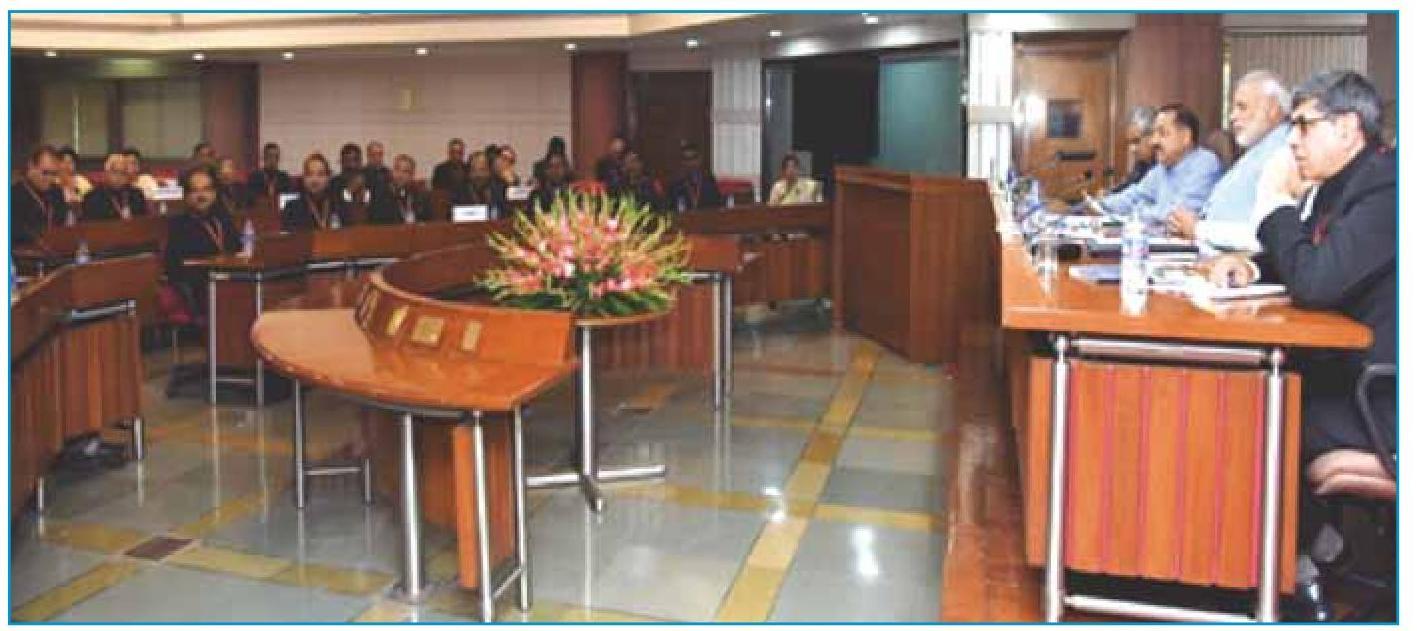
Hon’ble Prime Minister Interacting with ITP Participants in Delhi
(IMG) Kerala from April 25 to June 3, 2016 and Dr. Marri Channa Reddy Human Resource Development Institute (Dr. MCR HRD Institute) Hyderabad from March 28 to May 6, 2016. A total of 64,34 and 65 Officer Trainees had attended the ITP at ATI West Bengal, IMG Kerala and Dr. MCR HRD Institute Hyderabad respectively. One more batch of Induction Training Programme is scheduled to be held at ATI West Bengal from January 16 to February 24, 2017 and total 104 officers have been nominated for this training programme out of which about 60 participants are likely to attend the training programme.
Mid Career Training Programme (MCTP)
8.10 The issue of mandatory and structured midcareer training for IAS Officers was formalized with the introduction of the Mid-Career Training Programme (MCTP) in 2007. The objective of MCTP was to equip officers to handle the next, higher level of responsibilities at certain identified stages of their careers; broadly when they were primarily working in the field (7-9 years), at the policy formulation stage (15-18 years) and inter-sectoral policy formulation and implementation stage (27-28 years). These three stages were named Phase III, IV and V
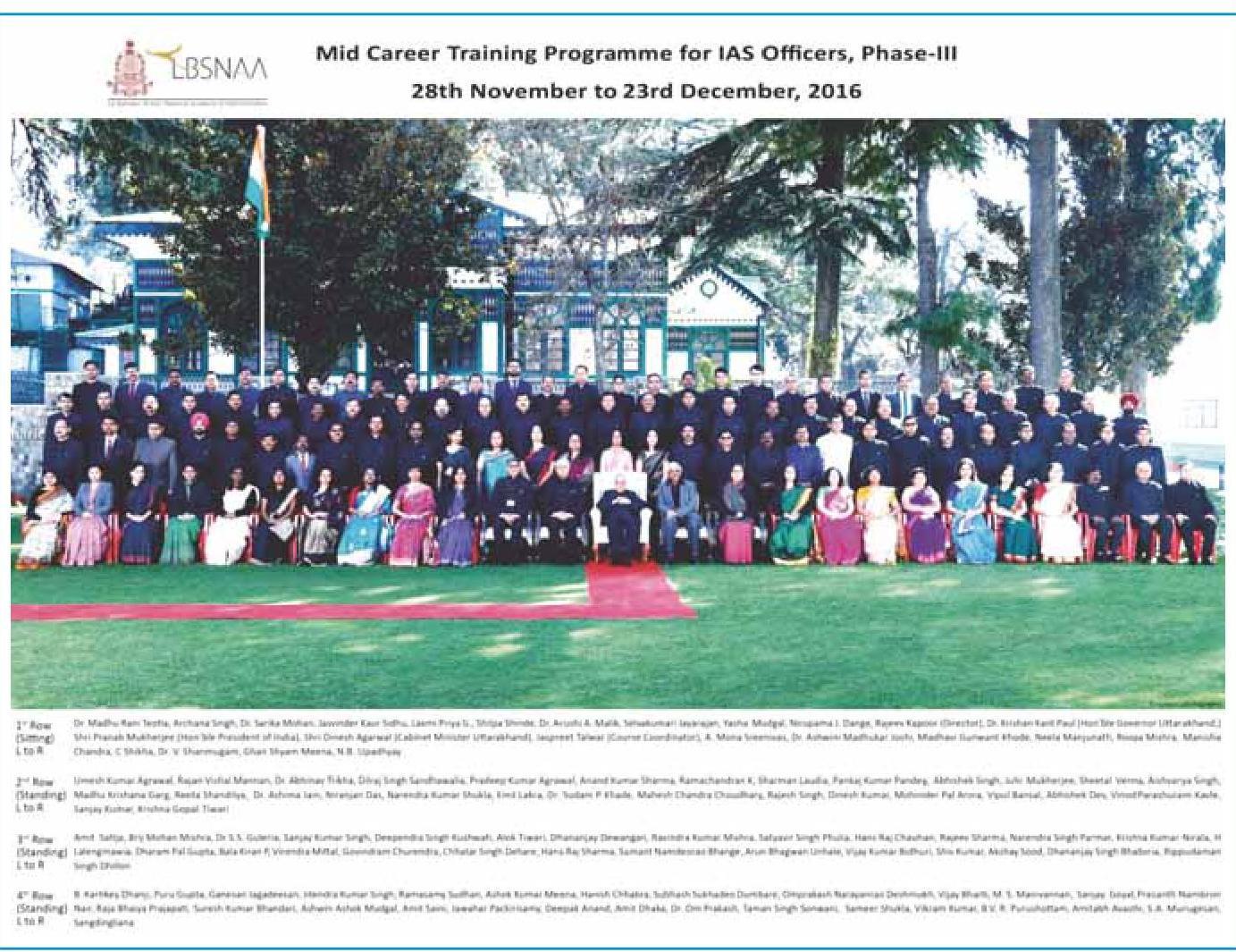
GROUP PHOTO OF IAS PHASE-III COURSE ( $10^{1 m}$ ROUND)
respectively. In the first three-year cycle, these programmes were outsourced by the Ministry to international/ national institutions of repute. However, since 2010, the mandate for the design and delivery of the programme has been devolved by the Government to the Academy. The MCT Programme was reviewed by Government and its durations were shortened. The revised programme is as follows: Phase III (4 weeks); Phase IV (4 weeks including 1 week Foreign Study Tour) and Phase V (3 weeks).
Phase III Course (10 th Round)
8.11 The Phase III course targets the officers of 7-9 years of seniority. The Academy organized this 4 weeks course from $28^{\text {th }}$ November, 2016 to $23^{\text {rd }}$ December, 2016. The focus of the course was on service delivery, project appraisal and implementation as well as on key governance
challenges. Inputs also covered leadership and negotiation. Total 104 participants from 2004 to 2008 batches underwent the training course.
Phase IV Course (11 th Round)
8.12 The Phase IV Course targets middle level officers (of 15-18 years seniority) with a thrust on Public policy. Besides enhancing domain knowledge of the participants, especially in the realm of various aspects of public policy, the Course also aims at broadening their perspective and developing soft skills. As part of the restructured MCT programme, the duration of the course was reduced to 4 weeks. 57 participants attended the course organized from June 27 to July 22, 2016. The Course included a short Foreign Study Tour to the Lee Kuan Yew School of Public Policy, National University of Singapore.
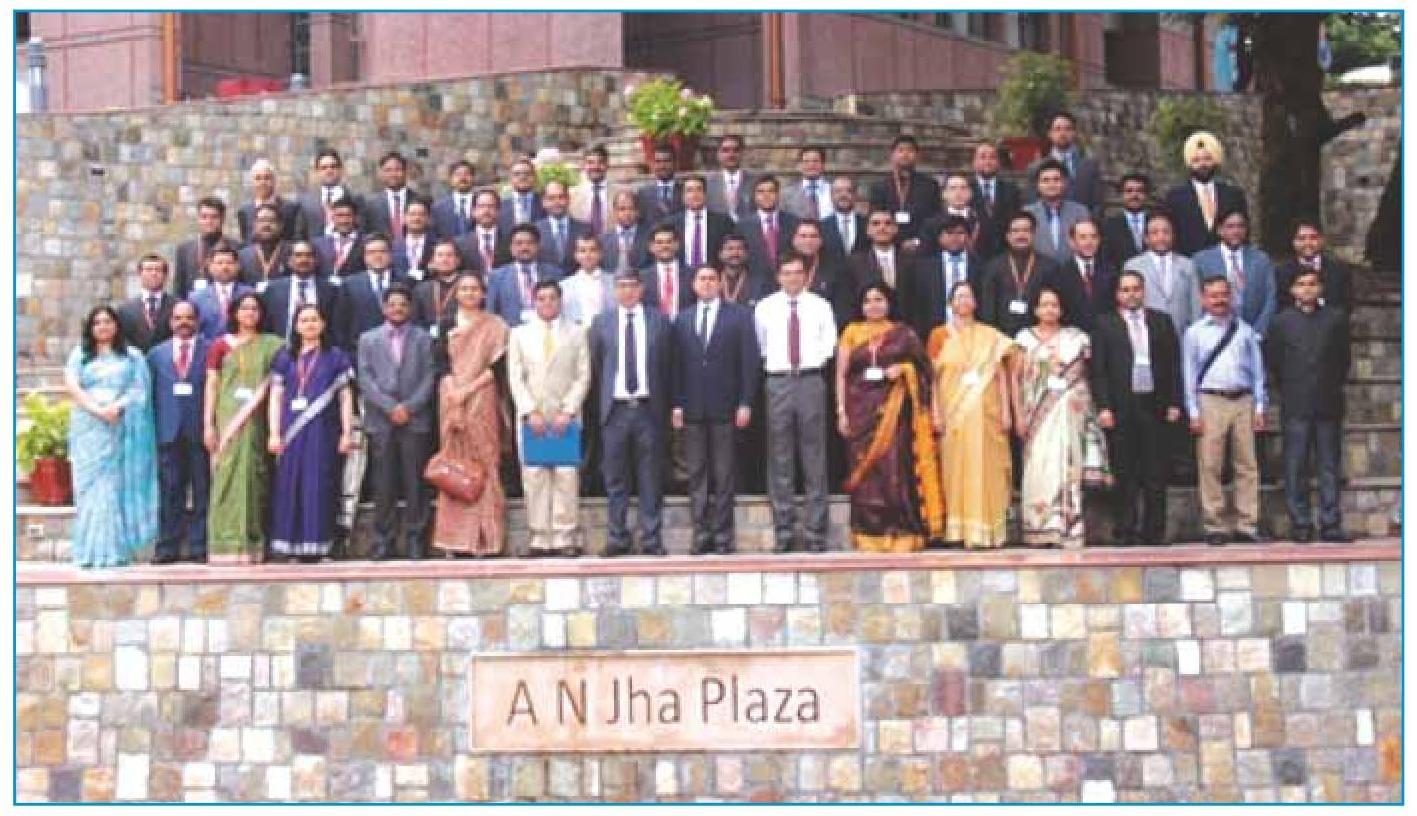
GROUP PHOTO OF IAS PHASE-IV COURSE (11 TH ROUND)
Phase V Course ( $10^{\text {th }}$ Round)
8.13 The Phase V Course aims at developing strategic leadership skills in senior level IAS Officers (27-30 years seniority) for effective
inter-sectoral policy formulation and strategic leadership in government. 88 officers drawn from 1986 to 1989 batches attended the course organized at the Academy from October 3 to 21, 2016.
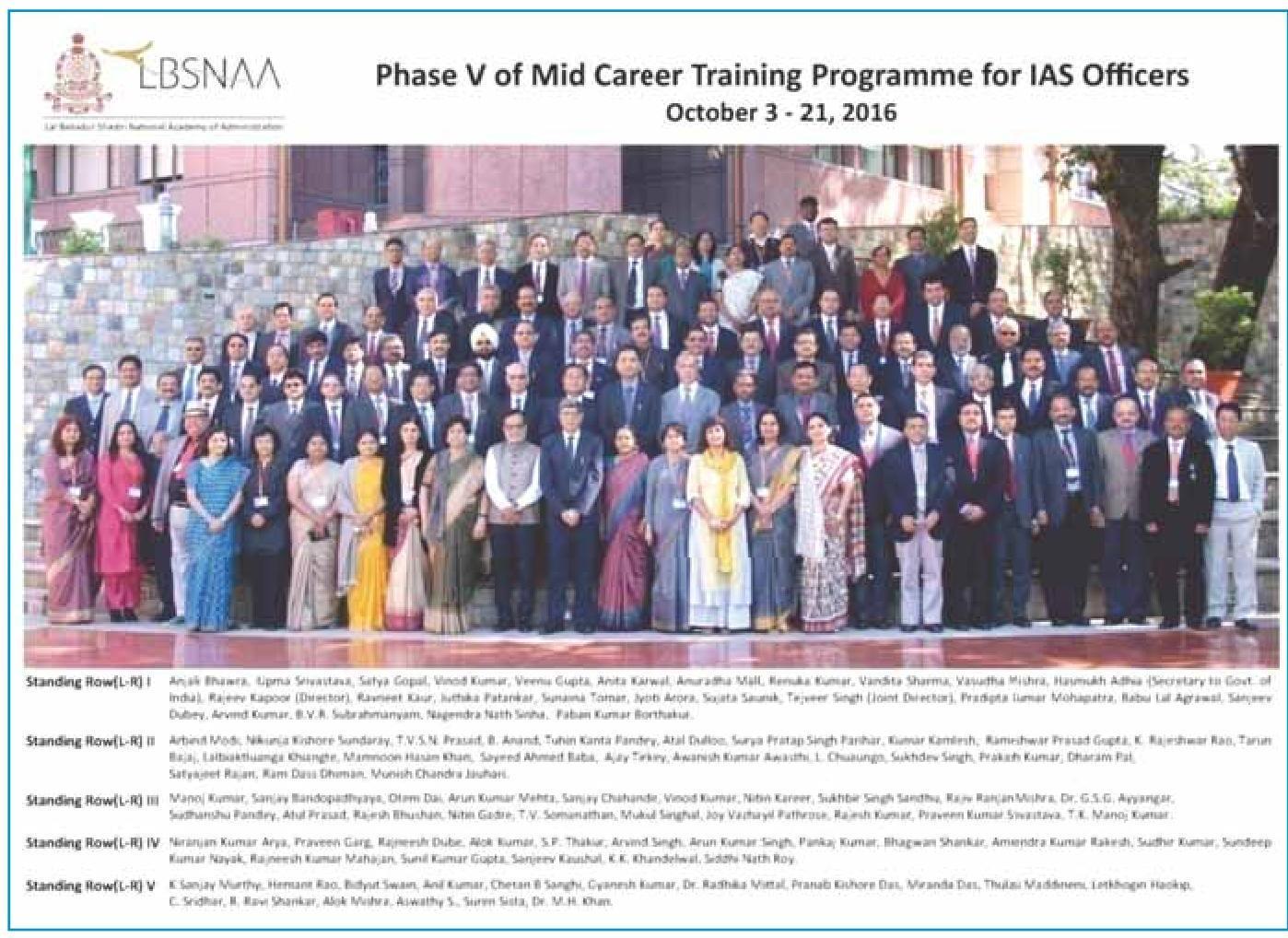
GROUP PHOTO OF IAS PHASE-V ( $10^{\text {TH }}$ ROUND)
Other In- Service Training Courses/ workshop/ seminars
8.14 The Academy annually conducts short duration courses (ranging from one to two weeks) on a variety of subjects such as Joint CivilMilitary Course on National Security, Courses on Gender, Disaster Management, etc.
Golden Jubilee Reunion
8.15 The Academy organizes a reunion every year for Officers who joined the service 50 years back. The first was held in 1997, the Golden Jubilee Year of the new nation, where the ICS and IAS Officers, who were in service at the time of independence, participated. Since then, the retired officers are called every year for a period of two-
three days to share their rich experience with the faculty and Officer Trainees. The Golden Jubilee Reunion for 88 officers of the 1966 batch (from various civil services who underwent FC at the Academy) was organized on May 30-31, 2016. The Reunion commenced with the inaugural ceremony on May 30, followed by a group photograph in the A.N. Jha Plaza. The participants were taken for a walk around the Academy
campus before lunch and post-lunch there was a two hour interaction with the Officer Trainees of the Phase-I 2015. The participants also had a session in small groups wherein they deliberated on issues of importance for the civil services in the present context before the Reunion come to a close with the valedictory ceremony on May 31, 2016.
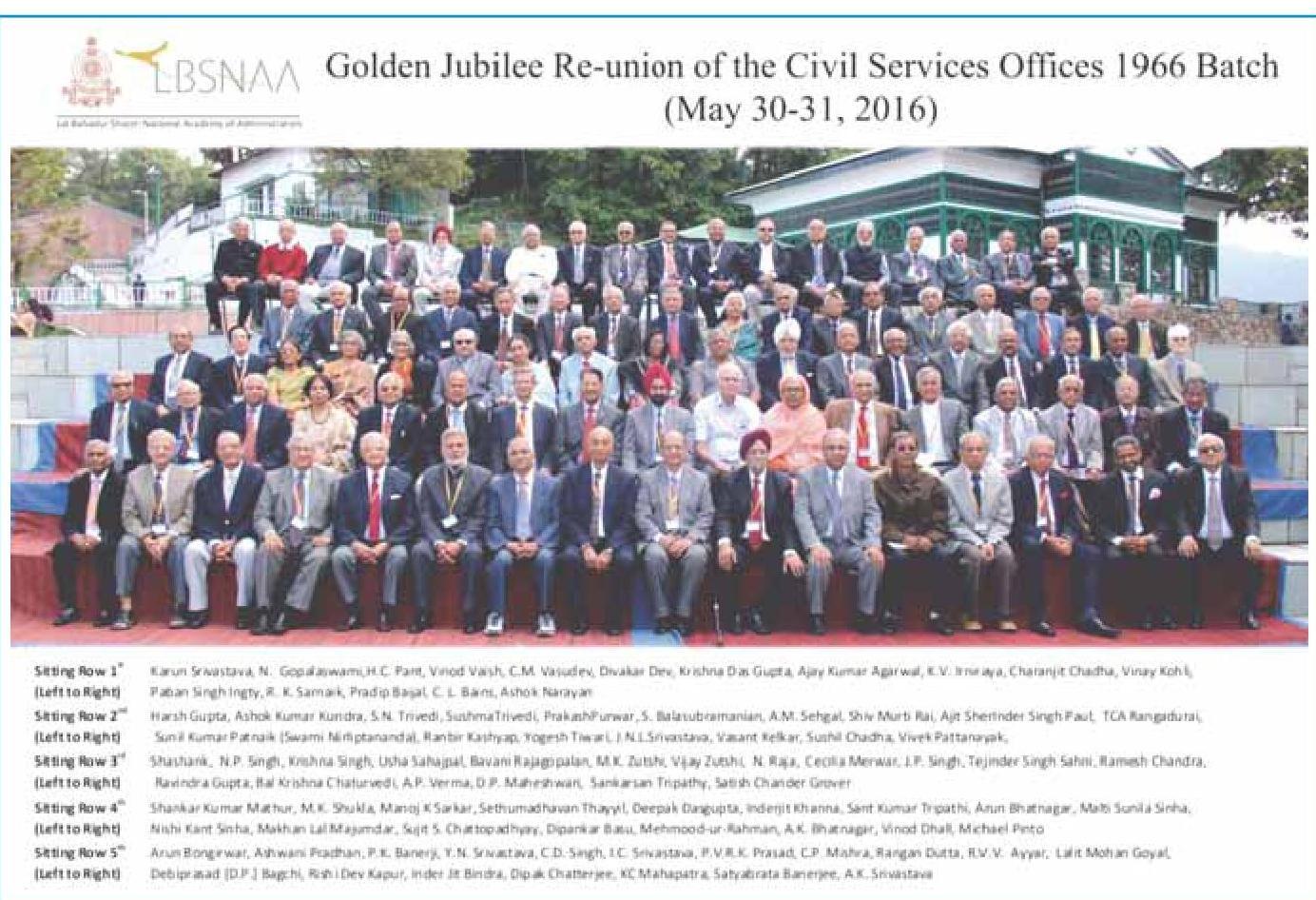
GOLDEN JUBILEE REUNION OF 1966 BATCH
Joint Civil Military Training Program
8.16 The Academy conducted a Joint Civil Military Training Programme on National Security from June 13 to 17, 2016. The course is meant for Director or Joint Secretary level
Officers of IAS, IPS, IRS, IRTS, IFS, IDAS, IB; Brigadier/Colonel Level officers of Armed Forces; DIG/IG Level officers of Para Military Forces, besides representatives of Media and Private Sector organizations.
The Joint Civil-Military Programme on National Security was initiated in the year 2001 following the recommendations of GoM on National Security pursuant to the Kargil Review Committee with the aim of fostering structured interface between Civil Servants and Armed Forces officers for a shared understanding of National Security. Participants are drawn from the Civil Services, Armed Forces, and the Central Armed Police Forces.
Research Centres in the Academy
8.17 The centres of the Academy have been established with an aim to provide an avenue for initiating research in key areas of governance both from policy as well as implementation perspectives. The research is supposed to feed into the training curriculum and provide it with fresh insights. These centres are mostly funded either by line ministries, like CRS, or are selfsustaining like the NGC and CDM and collaborate with various national and international funding agencies. Various Research Centres have been set up for undertaking actionresearch on domains linked to Academy’s mandate and to feed into training inputs. These are as follows:
Centre for Rural Studies (CRS)
8.18 The Centre coordinated the two week programme on ‘Land Administration and Management’ for the Officer Trainees of IAS2015 batch during their Phase-I training. The Centre also coordinated and evaluated Village Study Assignments (Land Reforms and Socio Economic Reports) for Officer Trainees of IAS2014 batch during district training.
The Centre published ‘Identifying Existing Capacities to execute the National Land Records Modernization Programme: An Appraisal in Maharashtra, West Bengal and Madhya Pradesh’ and ‘Best Practices Study on Land Resources Management in India: Karnataka, Maharashtra, Haryana and West Bengal’. The Centre brings out a biannual journal ‘Journal of Land and Rural Studies’ which focuses on issues land administration and rural development.
Centre for Disaster Management (CDM)
8.19 Ministry of Home Affairs, Government of India assisted the Academy in setting up the Centre for Disaster Management for acting as a nodal institution for imparting training on various aspects of Disaster Management with special focus on Incident Command System. Apart from conducting training programs the centre has been involved in formulation of national strategy for adaptation of the global best practices to suit Indian conditions in the field of disaster management as well as other research projects related to Disaster Management and Climate Change. The Centre organized two short-duration training programmes on Disaster Management and Risk reduction for officers belonging to the IAS. In addition, it also provides inputs in various training courses on disaster management and climate change, use of IT, GIS applications in Disaster Management, conducting research projects, documentation of best practices, development of case studies, teaching materials etc. Centre has also initiated the publication of an international journal titled “Disaster Response and Management” with ISSN number (ISSN: 2347-2553) and an annual book titled “Disaster Governance” with ISBN number (ISBN-.978-81-
928670-1-4) apart from the other research publications.
National Gender Centre (NGC)
8.20 The National Centre for Gender Training, Planning and Research (National Gender Centre) was established in 1993 and registered as a society under the Societies Act, 1860 in 1998. NGC is a capacity building centre which functions as part of the Academy. The main aim of the Centre is to work with a global network of partners and to mainstream gender and child rights issues in policy, programme formulation and implementation in Government so as to establish gender as a priority concern in government and to ensure the equitable development of men, women and children. The Centre is involved in training of civil servants at induction level as well as in service level on gender and child rights issues through courses and sensitization inputs to develop a gender perspective.
8.21 This year the Centre organized a Policy Conclave on “Gender Equality and Child Rights: Sharing Knowledge & Developing an Agenda for Action”, was held on January 28-30, 2016 at LBSNAA. Organized by the National Gender Centre, LBSNAA with the support of UN Women Office for India, Bhutan, Maldives \& Sri Lanka and UNICEF India Country Office, the conclave was attended by more than 120 participants, including representatives from Government of India, representatives from 18 state governments, members of State Commissions for Women, and State Commissions for Protection of Child Rights, academics, NGO representatives, development practitioners and retired IAS officers.
8.22 The broad objective of the conclave was to impact on, and feed into gender and childsensitive policies at the national and state level. The Keynote Address for the conclave was delivered by Dr. Gita Sen, Distinguished Professor \& Director, Ramalingaswami Centre on Equity \& Social Determinants of Health, Public Health Foundation of India (PHFI) on “Economic Growth, Development and Gender Equality”. The programme included plenary sessions on (i) Policy Approaches \& Challenges in realizing Gender Equality and Child Rights (ii) Patriarchy, Masculinity and Intersecting Identities (iii) Learning from Good Practices and (iv) Delivering Gender and Child Sensitive Outcomes: A Governance Perspective. Specific thematic issues were also focused on in parallel sessions: Violence against Women \& Children and Trafficking of Women \& Children; Health \& Nutrition; Gender and Employment; and Gender, Children and Social Protection.
Centre for Public Systems Management (CPSM)
8.23 The Centre for Public Systems Management was set up in 2016 by reconstituting the existing National Centre for Sustainable Community Systems (NCSCS) for more broadbased coverage of issues in public systems and their management. The Centre partnered with the Leadership Academy for Development (LAD) of Stanford University, USA to organize a course on Role of Public Policy for Private Sector Development from August 8 to 12, 2016. The course was led by Prof. Francis Fukuyama of Stanford University and Prof. Robert Kent Weaver of Georgetown University and attended by 25 participants, including 20 middle-level IAS
officers. Department of Economic Affairs (DEA) agreed to defray the cost of participation of IAS officers in the course.
The Academy Spirit
8.24 LBSNAA seeks to imbue civil servants with the required attitude and values expected in public service. The skills and knowledge required by a professional civil servant are relatively easier to impart, and these have traditionally been the strength of the Academy. However, to positively influence in the brief period available to us, the attitudes and values of intelligent young persons in their mid-twenties and thirties, coming from diverse backgrounds, is a more challenging task.
8.25 It is generally argued that for public service one needs integrity, moral courage, empathy with and respect for the underprivileged, and freedom from any sectarian prejudices based on religion, region, caste, class or gender. To nurture these values, Officer Trainees are encouraged to participate in diverse social activities. They are given responsibilities for improving the Lalita Shastri Balwadi School, where LKG/UKG & Class-I are conducted at a concessional rate for the children of the employees and the public besides conducting regular coaching classes for poor students of the neighborhood. Officer Trainees also do shramdaan to clean their premises and to instill a dignity of labour. Emphasis on caring for the poor, listening to the people, providing safety nets for the vulnerable, and being open and transparent runs as a continuous thread in all the courses and interactions. In addition, Trainees are divided into counselor groups where they are able to articulate their views in an open and frank atmosphere. This
forum serves as a great means of eliciting their views and conveying the right messages to them.
The Academy as Alma Mater
8.26 All Officer Trainees in the All India Services and Central Services begin their careers from the proverbial “gaumukh” of the civil service, the Lal Bahadur Shastri National Academy of Administration at Mussoorie. As a result, this institution provides a foundation that paves the way for lifelong professional and personal associations among officers across different civil services. These officers look back to the Academy with great nostalgia and also draw inspiration from the values and ideals instilled in them during their formative years.
Recent Training Initiatives
8.27 Some of the recent initiatives taken by the Academy in the field of imparting improved learning inputs through engagement with national institutions of repute are as follows:
- MoU signed on $22^{\text {nd }}$ March, 2016 with JPal, South Asia (Abdul Latif Jameel Poverty Action Lab) through Institute for Financial Management and Research, Chennai.
- MoU signed on $8^{\text {th }}$ April, 2016 with National Institute of Public Finance \& Policy, New Delhi
- MoU signed on $12^{\text {th }}$ May, 2016 with University of Pennsylvania Institute for Advanced Study of India, New Delhi
Facilities
8.28 The Academy is well-equipped with good training infrastructure in terms of academic
buildings, classrooms, hostels and other support infrastructure. Some of the key infrastructure facilities are given below:
- Academic & Administrative Blocks
- Karmashila
- Dhruvshila
- Gyanshila
- Aadharshila
- Gandhi Smriti Library – stocks 1.75 lac books, 300 journals and e-resources
- Officers Mess – can cater to around 500 persons at 3 locations
- Sports – well-equipped Officers Club, Riding Ground and Shooting Range
- Health – well-equipped Medical Centre
- Executive Hostels – 4 executive hostels with 167 rooms
- Officer Trainee Hostels – 3 hostels with 131 rooms
- Wi-fi campus
Faculty
8.29 The Faculty comprises a healthy blend of senior administrators and academicians and researchers. The administrators combine the richness of their field experience with strong academic achievements to provide a stimulating atmosphere for learning. The Academy is presently headed by the Director Smt. Upma Chawdhry, IAS, an officer of the 1983 batch of Himachal Pradesh cadre in the rank of Secretary to the Government of India.
For upgradation of Faculty Skills, Training of Trainers programme are scheduled to be organized on Public Private Partnerships,
Leadership and Negotiation during January February 2017.
INSTITUTE OF SECRETARIAT TRAINING AND MANAGEMENT
Introduction
8.30 The Institute of Secretariat Training and Management (ISTM) is imparting training to the officers of the Central/State Governments, Public Sector Undertakings \& Autonomous Bodies. Originally set up with the objective of conducting foundational and in-service training programmes for Assistants and Section Officers of the Central Secretariat, the range of the activities of the Institute has increased exponentially over the last six decades. In addition to the in-house training programmes, the Peripatetic Training provided by the Institute to the officials of State Governments and Union Territories in Behavioral Skills, Management Techniques, Financial Management and Office Management are of particular significance. On specific request from Central Government Departments, Autonomous Bodies, Public Sector Organizations, the Institute organizes special programmes addressed to the specific customer needs in different areas.
8.31 From the year 2007-08, ISTM is also involved in implementation of the Central Secretariat Service Cadre Training Plan (CSSCTP) and from 2011 onwards Central Secretariat Stenographer’s Service Cadre Training Plan (CSSS-CTP), which envisage mandatory training programmes having linkages with career progression up to Director level officers.
Training Programmes
8.32 ISTM conducts following programmes in various categories:
(a) Foundational and in-service Courses conducted as per new CSS and CSSS Cadre Training Plan
(b) Personnel Administration and Office Management
(c) Financial Management
(d) Management Services
(e) Behavioral Training
(f) Training of Trainers
(g) Peripatetic Training Programmes
(h) Right to Information
(i) Workshop on Sexual Harassment of Women at Workplace
(j) Workshop on Citizen Centric & Service Delivery Approach
(k) Organization Specific Programmes/ Cadre Specific Programmes
(l) Five days special programmes for Department of Personnel \& Training
8.33 Number of Training programme and Training weeks scheduled and conducted during 2016-17
| Table 1 | ||||
|---|---|---|---|---|
| S. No. |
Programme | No. of Programmes |
Training weeks | |
| 1. | Number of programme scheduled during 2016-17 | 304 | 621 Weeks 1 days | |
| 2. | Programmes Conducted during 1.4.2016 to 15.12.2016 | 188 | 359 Weeks 3.5 days (5171 trainees) |
|
| 3. | Programme to be conducted 16.12.2016 to 31.03.2017 | 116 | 261 Weeks 2.5 days |
8.34 Foundational Training Programmes for Assistant Section Officer Direct Recruit- ASODR, during 2016-17
| Table 2 | ||||
|---|---|---|---|---|
| No. of programmes |
ASO-FTP (Batch No.) |
No. of Participants |
Place of Training |
Duration |
| 1. | 259 | 57 | ISTM | $19.09 .2016-02.12 .2016$ |
| 2. | 260 | 80 | ISTM | -do- |
| 3. | 261 | 80 | ISTM | -do- |
| 4. | 262 | 78 | HIPA, Gurgaon | -do- |
| 5. | 263 | 58 | Chandigarh | $03.10 .2016-16.12 .2016$ |
| 6. | 264 | 52 | Hyderabad | $07.11 .2016-20.01 .2016$ |
8.35 Special Programmes for Officers of DoPT
(a) Eleven Special Training Programmes on File Management for officials of Department of Personnel & Training, were conducted during 2016 – 2017 (up to 15.12.2016) at ISTM
(b) Twenty-nine numbers of one-hour training programmes were conducted for officials of Department of Personnel \& Training at North Block, New Delhi, on ‘Preventive Vigilance’ and ‘Ethics’ and ‘Record Management’ as on $15^{\text {th }}$ December, 2016.
8.36 Other Training Programmes
Sixty-eight Organization/Cadre Specific Programmes were conducted for various Central Ministries/Departments, States, UTs, Public Sector Undertakings (PSUs) and Autonomous bodies (up to 15.12.2016). Thirty-one more Organisations/Cadre specific programmes are planned (from 16.12.2016 to 31.03.2017). One Capacity Building Training Programme for State Secretariat Service officers of North Eastern States (31 participants) has been conducted from 28.11.2016 to 09.12.2016.
8.37 Peripatetic Programmes
Thirty-five Peripatetic Programmes have been planned during 2016-2017. Twenty Peripatetic Training Programme have been conducted (upto 15.12.2016), out of which seven for Chandigarh Administration, four for Andaman \& Nicobar Administration, five for Puducherry Administration, four for Lakshadweep Administration \& one for Sikkim Administration.
8.38 Consultancy Projects
ISTM is also engaged in the research and consultancy projects. The consultancy projects relating to following Government Departments/ Organisations are being handled at present in the ISTM:
(A) Audit of proactive disclosure under RTI Act, 2005
i. Ministry of Road Transport and Highway
ii. Ministry of Home Affairs
iii. Department of Industrial Policy and Promotion
iv. Department of Administrative Reforms and Public Grievances
v. Bhavini, Department of Atomic Energy, Kalpakkam
vi. Department of Space, ISRO
vii. Indian Institute of Technology, Delhi
(B) Review of Rules, Regulations and Recruitment Rules of Gandhi Samiti and Darshan Samiti (GSDS).
New Initiatives
8.39 Inclusion of additional online registration module in Training Management Information System (TMIS)
The Training Management Information System (TMIS) project was initiated in the year 2011-12 and it has become operational, as far as work relating to co-ordination and administration are concerned. As part of further development under TMIS, online registration for ADR and SDR training programmes has started during 2015-16. Facility for writing of Daily Diary and filling up of
choice of Departments has also been enabled in the system during 2016-2017.
8.40 Introduction of new topics/Courses
(a) The first workshop on ‘Sexual Harassment of Women at Workplace (Prevention, Prohibition and Redressal) Act, 2013’ was organized at ISTM from 18.08.2016 to 19.08.2016 for two days
(b) Sessions on Application of Space Technology tools in governance has been introduced in various training programme to create awareness about the usage of Space technology tools and its applications
(c) Screening of video films/video spots obtained from Bureau of Energy Efficiency is being held for participants for promoting energy conservation.
(d) Sessions on Organ Donation is being organized in training programmes to create awareness among the trainees
(e) Inventory control module has been developed and operationalized
(f) Seminar on ‘Economic Growth and Challenges’ was organized on 14.05.2016 for Capacity Building of Faculty
(g) A Module / Session on Swachh Bharat Abhiyan has been introduced in training programmes to create awareness among the trainees
(h) A new Module on Government eMarketplace (GeM) is being introduced in training programmes relating to Purchase Management.
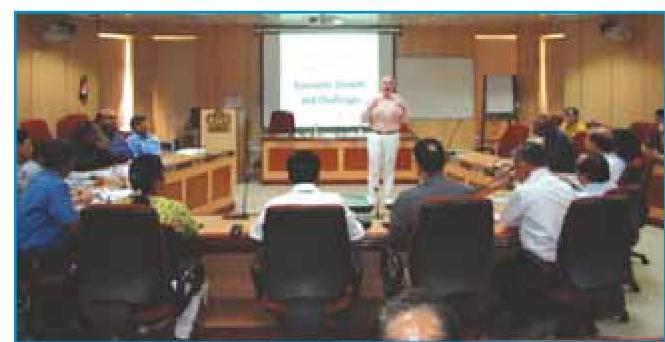
8.41 Presentations on Eight Thematic Areas
On the directions of Hon’ble Prime Minister and based on the recommendations of group of Secretaries, eight presentations on the following topics have been included in the ongoing induction training programme for Assistant Section Officers (Direct Recruit) being conducted at ISTM, for inculcating citizen centric governance:
(a) Good Governance-Challenges and Opportunities
(b) Employment Generation Strategies
(c) Farmer-Centric Initiatives in Agriculture and Allied Sectors
(d) Education and Health-Universal Access and Quality
(e) Innovative Budgeting and Effective Implementation
(f) Accelerated Growth with inclusion and Equity
(g) Swatch Bharat and Ganga RejuvenationPeople’s Involvement and Sustainability
(h) Energy Efficiency and Conservation.
8.42 Blood Donation
During the year from 01.04.2016 to 15.12.2016, one blood donation camp was organized at ISTM in which 105 trainees and members of faculty donated blood.
8.43 Public Service
The trainees (present and past) and also some of the faculty members visit on regular intervals to Rain-Baseras and dharmashalas of major hospitals of Delhi and arrange for medicines, radiological and pathological tests to the poor patients as prescribed by doctors. In winters, they also distribute woolen blankets/ clothes in the odd hours of the day to the really needy people. Through these initiatives it is expected that these officials/officers will be able to develop a positive
attitude which is expected to be reflected in their people-friendly, responsive and sensible approach at work.
8.44 People Connect Forum
ISTM has developed a “people connect” portal and hosted on its website on 24.01.2016.The platform provides opportunity to the participants (present & past) and other Central Government employees to disseminate information, share knowledge and experience on various issues regarding rules and their interpretation etc.
Chapter 9
ADMINISTRATIVE VIGILANCE DIVISION
9.0 Administrative Vigilance Division-I is responsible for examination of disciplinary cases in respect of IAS officers working under the Central Government. The Division also processes cases referred by the State Governments and Ministries / Departments under Government of India on the following issues:
- Proposals from States seeking to impose major penalty of dismissal / removal / compulsory retirement on members of Indian Administrative Service;
- Proposals from States seeking permission under the AIS (DCRB) Rules to initiate action against retired members of IAS;
- Proposals from States for imposing penalty of cut in pension;
- Proposals to initiate disciplinary proceedings / suspension of IAS officers working under the Government of India;
- Appeal against suspension submitted by IAS officers serving in the States;
- Requests for sanction for prosecution under the Prevention of Corruption Act, 1988 against the above categories of officers;
- Advice / clarification to the State Governments / Departments on the procedural aspects of disciplinary proceedings;
- Provides information regarding vigilance status of IAS officers at the time of their empanelment / training / posting on deputation etc. To facilitate this function, a
Computerized Vigilance Information System is in operation with a central data base which can be accessed by the requisitioning Divisions of this Department concerned.
- Handling of Privilege Notices and Complaints from Members of Parliament against IAS officers received from the Lok Sabha / Rajya Sabha Secretariat.
Disciplinary Proceedings & Sanction for Prosecution
9.1 Final orders in disciplinary proceedings were issued in two cases during the period from 01.4.2016 to 15.12.2016.
9.1.1 Orders of sanction for prosecution under Prevention of Corruption Act, 1988 against IAS Officers were issued in 09 cases and sanction was denied in 03 cases from 1.04.2016 to 15.12.2016.
Complaints against IAS officers
9.2 During the period from 1.4.2016 to 15.12.2016, 359 complaints were received, 318 were processed and 274 complaints were finally disposed of with the approval of the competent authority.
Privilege Notices and Complaints from Members of Parliament against IAS officers
9.3 During the period 1.4.2016 to 15.12.2016, 05 new notices were received from the Lok Sabha / Rajya Sabha Secretariat and processed and 01 was finally disposed of.
Monitoring of Proposals of Sanction for Prosecution under provisions of Prevention of Corruption Act, 1988
9.4 In terms of para 2(ix) of DoP&T O.M. No. 399/33/2006-AVD.III dated 06.11.2006, the delayed cases of sanction for prosecution were reviewed by the Committee chaired by the Secretary (Personnel) on 19.04.2016, 03.06.2016, 12.08.2016 and 08.11.2016.
Disagreement cases in disciplinary matters
9.5 In order to bring about greater uniformity in existing disciplinary cases on behalf of the President, in cases where the President is the disciplinary authority and there is a difference of opinion between the CVC and the concerned Department, the Departments are required to consult the DoPT before taking a decision on not to accept the CVC’s advice. Similarly, disciplinary cases where Central Vigilance Commission advises major penalty and the UPSC favours a minor penalty or recommends exoneration, before the Disciplinary Authority takes a final view, the matter is to be referred to this Department for resolving the disagreement. This Division has disposed of 7 such cases till January, 2017.
Disagreement in the matter of Prosecution Sanction cases
9.6 Similarly, the cases of disagreement between the CVC/CBI and Sanctioning/ Disciplinary Authority in the matter of Prosecution sanction cases are required to be referred to DoP\&T for a final decision in terms of this Department’s O.M. dated $6^{\text {th }}$ November, 2006. This has been modified vide DoP\&T’s O.M. No. 372/19/2012-AVD-III dated 3rd May, 2012
providing that final decision for grant or denial of sanction for prosecution shall be taken by the Competent Authorities concerned even in cases they decide to differ with CVC’s advice after obtaining views of DoPT. Accordingly, the views of DoP\&T may be taken into account while passing final speaking order. This Division has disposed of 4 such cases till January, 2017.
Chief Vigilance Officer
9.7 The Administratie Vigilance Division (AVD) has been responsible for the appointment of Chief Vigilance Officers (CVOs) in Central Public Sector Enterprises (CPSEs) etc. It also deals with the matters relating to extension of tenure of the CVOs, their pre-mature repatriation and debarment of officers who fail to take up their assignments as CVO consequent upon their selection. In the year 2016-17, online system has been introduced for inviting applications from the officers as well as their cadre controlling authorities to simplify the process of receiving application for the post of CVOs in CPSEs. During the year 2016-17, (Upto January, 2017), 64 panels were sent to various Ministries/ Departments for finalizing selection of appointment of CVO in PSUs under their respective administrative control. Out of these, 32 officers have been appointed as CVOs in various CPSEs etc. During the same period, 05 CVOs have been granted extension of tenure after completion of initial tenure, 02 officers have been debarred from central deputation for not joining the post after their selection, 01 case of premature repatriation has been finalized, and appointment was cancelled in case of 02 officers.
Central Vigilance Commission
9.8 The Central Vigilance Commission (CVC)
was set up by the Government of India through a Resolution vide No. 54/7/64 dated 11.02.1964 and was accorded statutory status by the Central Vigilance Commission Act, 2003 (No. 45 of 2003), notified in the Gazette of India Extraordinary on 12.09.2003.
9.9 The Commission is an apex body for prevention of corruption in Central Government, Corporations, Government Companies, Societies and Local Authorities owned and controlled by the Central Government. The Commission is empowered to inquire or cause inquiries to be conducted into offences alleged to have been committed under the PC Act 1988 by certain categories of public servants and in terms of clause (b) of sub Section (2) of Section 8 of the Central Vigilance Commission Act, 2003 (45 of 2003) and subsequent notification issued vide 18th March 2004 and 12th September 2007. The categories of officers are:
- Members of All India Services serving in connection with the affairs of the Union and Group ‘A’ officers of the Central Government;
- Chief Executives and Executives on the Board and other officers of E-8 and above in Schedule ‘A’ and ‘B’ of Public Sector Undertakings of the Central Government;
- Chief Executives and Executives on the Board and other officers of E-7 and above in Schedule ‘C’ and ‘D’ of Public Sector Undertakings of the Central Government;
- Officers of the rank of Scale V and above in the Public Sector Banks;
- Officers in Grade ‘D’ and above in Reserve Bank of India, NABARD and SIDBI;
- Managers and above in respect of General Insurance Companies;
- Senior Divisional Managers and above in Life Insurance Corporation of India; and
- Officers drawing salary of Rs 8700/- per month (pre-revised) and above on Central Government DA pattern, as may be revised from time to time, in societies and local authorities owned or controlled by the Central Government.
9.10 The Commission is mandated to exercise superintendence over the functioning of CBI, monitoring cases taken up by CBI for investigation under PC Act and for giving directions to CBI. In addition to this, the Commission exercises superintendence over the vigilance administration of the Ministries /Departments/Organisations of the Central Government. The advisory role of the Commission extends to references received from Departments/Organisations of the Central Government in individual cases of officers covered under its jurisdiction and consists of a two stage mechanism i.e. on investigation /inquiry reports before initiating disciplinary action termed as first stage advice and on completion of disciplinary proceedings as to the nature of penalty or otherwise termed as second stage advice.
9.11 The Commission believes that transparency fair-play and objectivity in Governance hold the key to combat corruption and endeavours for ensuring integrity in all matters of public administration. The Commission has been emphasising on strong internal mechanisms based on good governance principles. The Commission on its part has been taking several
steps to ensure accountability & transparency in decision-making and to promote proactive anticorruption efforts by emphasising on leveraging technology through various measures like epayment, e-procurement, reverse auction and for extensive use of technological solutions for public service delivery and functional activities by all organisations which could reduce the scope for corruption and provide for greater transparency.
9.12 The Commission therefore, lays greater stress on the importance of preventive vigilance in curbing corruption. Preventive vigilance is broadly a package of measures to improve systems and procedures in a way so as to reduce scope for discretion and eliminate corruption. Preventive vigilance facilitates the process for making good decisions and their effective implementation. Several initiatives have been taken by the Commission on this front. The Commission believes that preventive vigilance measures will lead to better management and governance resulting in improved deliverance of services and operational results. The thrust on preventive vigilance has consolidated and strengthened existing systems and processes especially in the public sector and in government and has also led to some new initiatives and innovations. The initiative has also led to many organisations revising their manuals and introducing Standard Operating Procedures where it was not in existence. The Commission felt that the initiatives and innovations for various organisations need to be shared so that others also benefit from them. The concept notes on preventive vigilance of 20 organisations were compiled in the form of a booklet titled ‘Initiatives in Preventive Vigilance’ and widely disseminated.
9.13 One of the prominent initiatives for bringing in transparency, equity and competitiveness is the scheme of Integrity Pact for procurement/contracts in the Government. Integrity Pact (IP) is an effort in this direction. The Commission had observed that major procurement activities are increasing in Public Sector Banks/Insurance Companies/Financial Institutions and, therefore, Commission has directed to implement Integrity Pact in all Public Sector Banks, Insurance Companies and Financial Institutions. D/o Expenditure, M/o Finance vide OM No. 14(12)/2008-E-II(A) dated 19.7.2011 has also advised implementation of Integrity Pact for all Ministries/ Departments/ Organizations of Central Government. Over 150 Departments/ Organisations have adopted Integrity Pact for the procurements/contracts.
9.14 The Central Vigilance Commission has been designated as the agency to receive and act on complaints or disclosure on any allegation of corruption or misuse of office from whistle blowers under the “Public Interest Disclosure and Protection of Informers’ Resolution” (PIDPI), 2014, which is popularly known as “Whistle Blowers” Resolution. The Commission is also empowered as the designated agency to take action against complainants making motivated or vexatious complaints.
9.15 The Commission observes Vigilance Awareness Week every year as an outreach measure. In the year, 2016 Vigilance Awareness Week was observed from $31^{\text {st }}$ October – $5^{\text {th }}$ November, 2016 on the theme “Public Participation in Promoting Integrity and Eradicating Corruption”. The week is observed every year to generate awareness about the
menace of corruption and to sensitize public about the consequences of corruption and the ways to eliminate it. Apart from other outreach measures, the Commission this year envisaged a concept of “Integrity Pledge” to enlist support and commitment of the citizens and organizations for upholding the highest standards of ethical conduct, honesty and integrity. Two Integrity ePledges, one for the citizens and the other for corporates/entities/firms etc. especially in the private sector were launched and are accessible on the Commission’s website http://www.cvc.nic.in. Citizens and organizations taking the Integrity pledge were provided with a certificate acknowledging and appreciating their commitment to the cause of anti-corruption. Over 8 lakh citizens and 25000 organisations have taken the pledges till date and is increasing by the day. Ministries / Organizations had also conducted various activities such as lectures, panel discussions, debates, quiz, essay writing, slogans and poster competitions on moral values, ethics, good governance practices etc. for their employees and also youth and public at large. The outreach activities focusing on inculcating greater awareness on corruption and anti-corruption measures for students were held in colleges and schools including professional colleges/ institutions across the country. Activities in schools / colleges across the country covered over 500 cities / towns reaching out to several lakh students /youth. As a part of the activities to target the citizens “Awareness Gram Sabhas” were organized where short plays, nukkad nataks, display of posters and screening of films etc., were made for dissemination of awareness in Gram Panchayats to sensitize citizens on the ill effects of corruption this year. About one lakh such Gram
Sabhas were conducted covering a huge number of citizens across the country.
9.16 A National Seminar was also organized on $7^{\text {th }}$ November 2016 at Vigyan Bhavan which was followed by the Valedictory function of the Vigilance Awareness Week 2016. The National Seminar consisted of two panel discussions, on issues of contemporary relevance viz. “Public Participation in Promoting Integrity and Eradicating Corruption” and “Public Procurement”. During the valedictory function, the Prime Minister was the Chief Guest. The Prime Minister in his address, expressed concern over the deterioration of moral values and ethics in the society. He stated that a developing country like India cannot afford the luxury of corruption and dwelled on the need to generate awareness in the public on the negative effects of corruption. The Prime Minister acknowledged that technology plays a major role in bringing about transparency. He cited some instances of corruption he had come across and stressed on the need to thwart the designs of corrupt public servants who were bringing a bad name to the country. The Prime Minister concluded his address by appreciating the efforts of the Commission in involving public for eradicating corruption and promoting integrity.
9.17 The Commission accords utmost importance to developing skills of vigilance functionaries and the Commission’s officers. Several Training Programmes were held during the year at National Police Academy, Hyderabad, Gujarat Forensic Sciences University (GFSU), IIM Bangalore in which around 75 senior officers of the Government and the Commission participated. Two International customised
training programmes were also organised at the International Anti-Corruption Academy (IACA) at Vienna, Austria and at University of California at Berkeley (UCB) respectively in which 50 CVOs/officers of the Commission attended. These trainings exposed the officers to international best practices, anti- corruption laws and the initiatives on anti-corruption measures of other countries. During the year 2016, a training course for newly inducted CVOs was conducted by the Commission from 07.06.2016 to 10.06.2016 in which a total number of 40 CVOs participated.
9.18 Another initiative of the Commission is the monthly lecture series in which eminent speakers/personalities are invited to deliver lectures. In 2016, 12 eminent speakers delivered lectures in the Commission’s knowledge management efforts wherein senior executives/public servants of the Government PSUs/Banks, etc. attended. These lectures were also webcast by NIC to reach out to a wider audience across the country.
9.19 The Commission conducts its activities concerning inquiry or causing inquiry through the Chief Vigilance Officers (CVOs), who are the extended arms of the Commission. There are 200 posts of full time CVOs and 512 posts of part time CVOs. Vigilance activities in Ministries / Departments and other organisations are looked into by part-time CVOs, who are working in the concerned Ministry / Department / Organisations at sufficient seniority level. During the year 2016, the Commission considered the suitability of 111 officers recommended by the administrative authorities for appointment to the post of CVOs in different organizations. Names of 62 officers for
appointment as full time CVOs and 85 officers for appointment as part time CVOs in various Departments/Ministries/Autonomous Bodies were also approved by the Commission.
9.20 As per Section 14 of the CVC Act, 2003, the Commission submits an Annual Report of its activities to the President within six months of the close of the year under report. The report also contains a separate part on the functioning of the Delhi Special Police Establishment (DPSE) in so far as it relates to sub-section (1) of section 4 of the DSPE Act, 1946 (25 of 1946).
Lokpal & Lokayuktas Act, 2013 (No. 1 of 2014) \& Rules thereunder
9.21 In order to meet a long standing demand to establish a mechanism for dealing complaints on corruption against certain public functionaries, including corruption at high places, the Government had constituted a Joint Drafting Committee on 08.04.2011, consisting of five nominee Ministers from Government of India and five nominees of Shri Anna Hazare (including Shri Hazare himself), to prepare a draft of the Lokpal Bill. Based on the deliberations of the Committee, and on the basis of inputs from Chief Ministers of States and political parties, a draft Lokpal Bill was prepared. The Cabinet at its meeting held on 28.07.2011 considered the draft Lokpal Bill, 2011 and upon approval by the Cabinet, the Lokpal Bill 2011 was introduced in Lok Sabha on 04.08.2011. The said Bill was referred to the Department Related Parliamentary Standing Committee on Personnel, Public Grievances, Law and Justice on the $8^{\text {th }}$ August, 2011 for examination and report.
9.22 The Department Related Parliamentary Standing Committee after extensive discussion
with all the Stakeholders, in its 48th Report, made a number of recommendations suggesting major amendments in the Bill both as regards the scope and content of the Bill, including that necessary provisions be made, in the Union legislation, for establishment of Lokayuktas in the States, so as to provide leverage to the States where no such institution exists and to bring in uniformity in the laws relating to State Lokayuktas which are already in existence in a number of States. The Committee also recommended that Lokpal and Lokayuktas should be conferred Constitutional status.
9.23 Upon consideration of the recommendations of the Standing Committee, the Government withdrew the Lokpal Bill, 2011 pending in the Lok Sabha and introduced a new comprehensive Lokpal and Lokayuktas Bill, 2011 in the Lok Sabha on 22.12.2011 providing for establishment of Lokpal at Centre and Lokayuktas in States. Also, keeping in mind the recommendations of the Standing Committee that the Lokpal and Lokayuktas may be made Constitutional bodies, the Government also introduced $116^{\text {th }}$ Constitutional Amendment Bill, 2011 to provide for Constitutional status to these bodies.
9.24 These Bills were taken up for consideration by the Lok Sabha on 27.12.2011. The Lokpal and Lokayuktas Bill, 2011 was passed with certain amendments whereas the $116^{\text {th }}$ Constitutional Amendment Bill, 2011 could not be passed with requisite majority. The Lokpal and Lokayuktas Bill, 2011 was taken up for discussion and passing in the Rajya Sabha on 29.12.2011 but the discussion remained inconclusive. Subsequently, the Rajya Sabha adopted a motion on 21.05.2012 and referred the Bill to a Select Committee of the Rajya Sabha for examination and report. The
Select Committee of Rajya Sabha submitted its report to the Rajya Sabha on 23.11.2012. The recommendations of the Select Committee were examined and a proposal for moving official amendments to the Bill as reported by the Select Committee was considered and approved by the Cabinet in its meeting held on $31^{\text {st }}$ January, 2013. The Bill was finally passed by Rajya Sabha with amendments on 17.12.2013 and the Lok Sabha agreed to the amendments made by Rajya Sabha on 18.12.2013. The Bill as passed by both Houses received the assent of the President on 01.01.2014. The Act was brought into force with effect from $16^{\text {th }}$ January, 2014. The Lokpal and Lokayuktas Act, 2013 requires some amendments, inter-alia, so as to provide for situations where the composition of the Selection Committee is deficient/incomplete due to absence of Leader of Opposition in the Lok Sabha, etc. Accordingly, Lokpal & Lokayuktas and other related law (amendment) Bill 2014 was introduced in Lok Sabha on 18.12.2014. The same was referred to the Department-related Parliamentary Standing Committee on Personnel, Public Grievances, Law \& Justice for examination \& report. The Committee has submitted its report in the Parliament on 07.12.2015. The recommendations made in the said report are presently under active consideration of the Government and the Inter Ministerial Committee (Group of Ministers) is seized of the matter. Meanwhile, the Government moved the Lokpal and Lokayuktas (Amendment) Bill, 2016 seeking amendment to only section 44 of the Act. The said Bill was passed by both the houses of Parliament and after the assent of President on 29.07.2016 has become an Act tilted “the Lokpal and Lokayuktas (Amendment) Act,
2016″. This Amendment Act shall be deemed to have come into force on 16.01.2014.
Rules made under the Act
9.25 The Central Government, in exercise of powers conferred by sub-section (1) read with clause (b) of sub-section (2) of section 59 of the Lokpal and Lokayuktas Act, 2013, notified the Search Committee (Constitution, Terms and Conditions of appointment of members and the manner of selection of Panel of Names for appointment of Chairperson and Members of Lokpal) Rules, 2014 on $17^{\text {th }}$ January, 2014. A writ petition has been filed by Common Cause, a Registered Society, before the Supreme Court wherein, inter alia, challenge has been made to the validity of the said Search Committee Rules. During the course of hearing of the case by the Supreme Court on $5^{\text {th }}$ May, 2014, the Court was informed that the Government will re-examine the issue and make formal amendments in the Rules and only thereafter proceed further in the matter. Accordingly, Government examined the matter and necessary amendments in the Search Committee Rules were notified in the official Gazette on $27^{\text {th }}$ August, 2014.
9.26 A number of writ petitions were filed in various High Courts, challenging, inter alia, certain provisions of the Act and the Search Committee Rules. On Transfer Applications filed by the Government, the Supreme Court transferred these writ petitions from various High Courts to the Supreme Court. The purpose of the Transfer Petitions was to get authoritative pronouncement on all these issues, so that the institution of Lokpal can be made functional at the earliest. Two Writ Petitions filed in Madras High Court were withdrawn by the Petitioner.
The Whistle Blowers Protection Act, 2014
9.27 In order to establish a mechanism to receive complaints relating to disclosure on any allegation of corruption or wilful misuse of power of discretion against any public servant and to inquire or cause an inquiry into such disclosures and to provide adequate safeguards against victimization of the persons making such complaint and for matters connected therewith or incidental thereto, the Government introduced “The Public Interest Disclosure and Protection to Persons Making the Disclosure Bill, 2010” in the Lok Sabha on 26.08.2010. The Bill was referred to the Department Related Parliamentary Standing Committee. The recommendations of the Parliamentary Standing Committee were considered and the Cabinet in its meeting held on 13.12.2011 approved official amendments to the Bill which included renaming it as “The Whistle Blowers Protection Bill, 2011”. The Lok Sabha considered the Bill along with the Officials Amendments and passed it on 27.12.2011 and transmitted the Bill to the Rajya Sabha for discussion and passing. The Bill came up for consideration in the Rajya Sabha on 14.08.2012 during the Monsoon Session, 2012. The Bill was listed on a number of days subsequently, but the same could not be taken up during the said Monsoon Session. Notices for moving official amendments as well as for consideration and passing of the Bill were also given to the Rajya Sabha during the Winter Session, 2012 and the Budget, Monsoon & Winter Sessions of 2013 of Parliament but the Bill could not be taken up. The Bill as passed by Lok Sabha was finally passed by Rajya Sabha on $21^{\text {st }}$ February, 2014 and received the assent of the President on $9^{\text {th }}$ May, 2014. As the Bill was taken up on the last day of the last Session
of the $15^{\text {th }}$ Lok Sabha, the official amendments to the Bill (aimed at safeguarding against disclosures affecting sovereignty and integrity of India, security of State, etc.) were not moved. The proposed amendments are of crucial nature and, therefore, the Whistle Blowers Protection Act, 2014 can be brought into force only after necessary amendments are carried out in the Act. To make these amendments to the Act, the Government introduced the Whistle Blowers Protection (Amendment) Bill, 2015 in the Lok Sabha on 11.05.2015. After due debate and clause- by- clause discussion on the floor of the House, the Bill was passed by the Lok Sabha on 13.05.2015. Notices were given for its consideration and passing by the Rajya Sabha, in the Monsoon and Winter Sessions of 2015 of Parliament. The Bill was taken up for discussion in the Rajya Sabha during the Winter Session, 2015 and some Members participated in the discussion during the said Session, which however remained inconclusive. Notices for further consideration and passing of the said Amendment Bill were given in the Rajya Sabha during the Budget, $239^{\text {th }}, 240^{\text {th }}$ and $241^{\text {st }}$ Sessions of 2016 of the Rajya Sabha and the Bill was included in the List of Business of the House during all these Sessions except the $239^{\text {th }} & 240^{\text {th }}$ Sessions. The Bill is presently pending in the Rajya Sabha.
Prevention of Bribery of Foreign Public Officials and Officials of Public International Organisations Bill, 2011
9.28 The Government introduced the Prevention of Bribery of Foreign Public Officials and Officials of Public International Organizations
Bill, 2011 in Lok Sabha on 25.3.2011 in order to comply with Article 16 of United Nations Convention Against Corruption. The said Bill was referred to the Department Related Parliamentary Standing Committee. The Parliamentary Standing Committee submitted its report on the Bill on 29.3.2012. The Committee in its report made a number of recommendations, inter alia, for widening the scope of certain terms used in the original Bill and for comprehensively defining the term ‘undue advantage’, providing for uniform punishment in line with the domestic bribery law, etc. The majority of the recommendations of the Committee were accepted and the Cabinet, in its meeting held on 17.08.2012, approved the proposal to move official amendments to the original bill. A further set of amendments were also moved after amendment to the Prevention of Money Laundering Act, 2002. These official amendments could not be taken up for consideration by the Parliament and the said Bill lapsed with the dissolution of the 15th Lok Sabha. It was proposed to introduce a fresh Bill in Lok Sabha on the lines of 2011 Bill.
9.29 In order to meet India’s obligations under Article 16 of the UNCAC, it is necessary to put in place necessary legislation to criminalise foreign bribery and, for that purpose, it is necessary to introduce a fresh Bill, which is under consideration of the Government.
Chapter 10.
INTERNATIONAL COOPERATION
MANDATE
10.0 The Department of Personnel and Training is the nodal Department for anti-corruption. The primary tasks of this Division emanate from the follow up to the ratification of the United Nations Convention Against Corruption (UNCAC) and the other consequential International collaborative efforts, on global platforms. This Division acts in conjunction with specialized agencies like the Central Bureau of Investigation, the Enforcement Directorate and other line Ministries entrusted with the specific ancillary tasks within their respective administrative domain, viz. corporate governance, extradition matters, prevention of money laundering, mutual legal assistance treaties etc.
10.1 The United Nations Convention Against Corruption (UNCAC) is a universally binding international legal instrument to fight corruption at both domestic and global level and was adopted by the United Nations General Assembly in October 2003. The convention through its prescription aims to bring in rationalization and uniformity in legal frameworks and in the approaches in the fight against corruption. The prescriptions contain both mandatory and nonmandatory obligations. India signed the Convention in December 2005 and ratified the same in May 2011, after being satisfied of substantial compliance status of its domestic laws with the tenets of the Convention.
10.2 The Convention provides for a detailed mechanism for peer review of the status of implementation of its provisions by the Member States. Under this mechanism, the review of the state of implementation is undertaken by governmental experts from two other Member States. The self assessment report of compliance of domestic laws with the provisions of the UNCAC was concluded by a core group
consisting of officers drawn from different departments concerned with the domestic laws & acts connected to the various provisions of the Convention, including the CBI. The selfassessment report for India was prepared by the IC Division of DoPT and submitted to the United Nations Office on Drugs and Crime (UNODC) which acts as Secretariat for the UNCAC. Based on the self assessment report, India is being reviewed for compliance status of domestic laws with the provisions contained in Chapters III (Criminalization and Law Enforcement) and IV (International Cooperation) of the Convention. This Department has received the updated Country Report in respect of Chapter III of UNCAC from UNODC Secretariat which is under examination. Views of all the stakeholders viz M/o Home Affairs, M/o Corporate Affairs, M/o External Affairs, Central Bureau of Investigation, Department of Legal Affairs, Enforcement Directorate on the report are being examined. India is expecting an updated Country Report in respect of Chapter IV of UNCAC from the UNODC Secretariat.
10.3 The interaction on various global platforms specific to UNCAC related issues
during the year included India’s participation as indicated below:
| S. No. | Description | Period | Organized by | Venue |
|---|---|---|---|---|
| 1. | $7^{\text {th }}$ Session of Implementation Review Group Meeting (IRG) | $\begin{gathered} 20-24^{\text {th }} \ \text { June } 2016 \end{gathered}$ | UNODC | Vienna, Austria |
| 2. | $7^{\text {th }}$ Open Ended Intergovernmental Working Group Meeting on Prevention of Corruption by UNODC & 10th Working Group Meeting on Asset Recovery | $\begin{gathered} 22-24^{\text {th }} \ \text { August } 2016 \ \text { \&26-27 } \ \text { August } 2016 \end{gathered}$ | UNODC | Vienna, Austria |
| 3. | Resumed $7^{\text {th }}$ Session Implementation Review Group Meeting \& 5th Open-ended International Cooperation Meeting. | $\begin{gathered} 14-16^{\text {th }} \ \text { November } 2016 \ \text { \& 17-18 } \ \text { November } 2016 \end{gathered}$ | UNODC | Vienna, Austria |
10.4 India is also a Member of G-20 Anti Corruption Working Group for review of implementation of UNCAC provisions. This Group has evolved an action plan which inter alia requires the members of G-20 Group of countries to lead by example. The focus of this Group is towards the global financial system, particularly from the point of view of denial of entry or visa to corrupt officials, providing measures to protect whistle blowers, promote effective functioning of
anti corruption bodies and association of private and business sector in combating corruption. India has been participating in Anti Corruption Working Group (ACWG) meetings. In the Leader’s Summit of G20 held on 4-5 th September 2016 at Hangzhou, China, India, along with other Members of the G20, has endorsed its ACWG Annual Action Plan of Year 2017-18. India’s participation in this forum is as follows:
| S. No. | Description | Period | Organized by | Venue |
|---|---|---|---|---|
| 1. | $2^{\text {nd }}$ G20 Anti Corruption Working Group Meeting 2016 |
$9-10^{\text {th }}$ June 2016 |
G20 | London, UK |
| 2. | $3^{\text {rd }}$ G20 Anti Corruption Working Group Meeting 2016 |
$18-19^{\text {th }}$ October 2016 |
G20 | Paris, France |
| 3. | $1^{\text {st }}$ G20 Anti Corruption Working Group Meeting 2017 ( will be held) |
$24-25^{\text {th }}$ January 2017 |
G20 | Berlin, Germany |
10.5 The Organization for Economic Cooperation and Development Convention (OECD) on Combating Bribery of Foreign Officials in International Business Transactions
(OECD Anti Bribery Convention) is a multilateral international convention which contains prescriptions for criminalizing the supply side of the bribery of Foreign Public Officials in
International Business Transactions. This Convention entered into force from $15^{\text {th }}$ Feb 1999. India is not a signatory to the said Convention but has been a regular participant on this forum and its Working Groups as an Observer, so as to avoid multiplicity of similar activities as are covered under the UNCAC umbrella. India participated as a non member in the OECD Anti Bribery Ministerial Meeting held on $16^{\text {th }}$ March 2016 in Paris, France. India is also a founding member of Asian Development Bank (ADB)-OECD Anti Corruption Initiative and hosted the $16^{\text {th }}$ Steering Group Meeting and $7^{\text {th }}$ Regional Conference of the Initiative in New Delhi in September, 2011. The sole objective of such participation is to enhance capacity building and to stay in tune with the developments on the international level with respect to Foreign Public Officials.
10.6 As part of the capacity building exercise and so as to keep pace with the world on anti corruption issues, India, at the initiative of the then President, in 2011 conveyed its commitment of active and continued association with International Anti Corruption Academy (IACA) to foster exchange of information, research and training of Anti-Corruption personnel. International Anti Corruption Academy is a joint initiative of United Nations Office on Drugs and Crime, the Republic of Austria and European Anti Fraud Office. The parties to the Agreement of the Academy, enjoy participation in Assembly of Parties and also participate in the shaping of Academy’s curriculum and that there are no long term obligations or contributions, which are purely on voluntary basis. India acceded to the IACAon $29^{\text {th }}$ May 2013.
10.7 Tailor-made trainings are IACA’s individualized response to the unique challenges that a specific organization, corporation, or institution faces in preventing and fighting corruption. IACA delivered a tailor-made training on topics such as organizational integrity, corruption prevention, fraud detection, and good governance for a group of senior vigilance officers and officials from public sector companies in February 2016. Another training programme was held in November 2016 for Vigilance officers of India. IACA offers a global, postgraduate degree programme in anticorruption and compliance: the Master of Arts in Anti-Corruption Studies (MACS) which brings together professionals from around the world with related work experience in the public and private sectors, international and nongovernmental organizations, media, and academia. Indian officers participate in such courses.
10.8 India is the BRICS chair for year 2016 and this department is concerned with anti-corruption related matters for the BRICS group. In this regard, India had chaired three BRICS meetings in the calendar year 2016. The parameters of the BRICS Anti-Corruption Working Group (ACWG) were finalized during the 2nd BRICS Anti-Corruption meeting held on $8^{\text {th }}$ June, 2016, in London. Through the parameters, all the member countries agreed to conduct the BRICS Anti-Corruption Working Group Meetings at least twice every year and strengthen international cooperation on issues of focus among the BRICS member countries and enhancing the use of criminal and non-criminal tools to combat corruption, including through
cooperation on asset recovery. BRICS ACWG meetings act as a platform for all the member countries to discuss joint strategy in G20 ACWG and help in gathering support for promoting
shared goals. India’s participation details in the BRICS ACWG meetings in the financial year 2016-17 are as follows:-
| S. No. | Description | Period | Chaired by | Venue |
|---|---|---|---|---|
| 1. | $2^{\text {nd }}$ BRICS Anti Corruption Working Group Meeting 2016 |
$8^{\text {th }}$ June 2016 | India | London, UK |
| 2. | $3^{\text {rd }}$ BRICS Anti Corruption Working Group Meeting 2016 |
$17^{\text {th }}$ October 2016 |
India | Paris, France |
| 3. | $1^{\text {st }}$ BRICS Anti Corruption Working Group Meeting 2017 |
$22^{\text {nd }}$ January 2017 |
China | Berlin, Germany |
10.9 Apart from the direct interactions by the Department of Personnel and Training, there are other specialized areas for which the line Ministries are representing the Government of India in respect of specialized areas and the role of
this Department in such cases is specific to providing overarching support and inputs and such association on global platforms include participation in FATF, SAARC, Stolen Asset Recovery (StAR) initiative etc.
Chapter 11.
CENTRAL BUREAU OF INVESTIGATION
CBI – AN OVERVIEW
11.0 In the early stages of the World War-II, the Government of India realised that the vast increase in expenditure for war efforts had provided opportunities to unscrupulous and antisocial persons, both officials and non-officials, for indulging in bribery and corruption. In order to tackle the problem, the Government set up Special Police Establishment (SPE) under a DIG in the then Department of War, through an executive order in 1941, with mandate to investigate cases of bribery and corruption in transactions with which the War and Supply Department was concerned. At the end of 1942, the activities of the SPE were extended to include cases of corruption in Railways also, which was vitally concerned with the movement and supply of war materials.
11.1 In 1943, an Ordinance was issued by the Government, constituting a Special Police Force vested with powers for investigation of certain offences committed by officials of Central Government. As a need for a Central Government Agency to investigate cases of bribery and corruption was felt even after the end of the war, the Ordinance which lapsed on September 30, 1946, was replaced by Delhi Special Police Establishment Ordinance of 1946. Subsequently, the same year, Delhi Special Police Establishment Act, 1946 (DSPE Act) was enacted.
11.2 After promulgation of the DSPE Act, the superintendence of SPE was transferred to the Home Department and its functions were enlarged to cover all departments of the
Government of India. The jurisdiction of SPE was extended to all the Union Territories and the Act provided for its extension to the States with the consent of the State Government. The Headquarters of SPE was shifted to Delhi and the organisation was put under the charge of Director, Intelligence Bureau. However, in 1948, a post of Inspector-General of Police, SPE was created and the organisation was placed under his charge.
11.3 In 1953, an Enforcement Wing was added to the SPE to deal with offences under the Import and Export Control Act. With the passage of time, more and more cases under various laws other than Prevention of Corruption Act and violations of Import and Export Control Act also entrusted to the SPE. In fact, by 1963, SPE was authorised to investigate offences under 91 different sections of Indian Penal Code and 16 other Central Acts, besides offences under the Prevention of Corruption Act, 1947.
11.4 A growing need was felt for a Central Police Agency at the disposal of the Central Government, which could investigate not only cases of bribery and corruption, but also violation of Central fiscal laws, major frauds relating to Government of India Departments, Public Joint Stock Companies, Passport frauds, crimes on the High Seas, crimes on the Airlines and serious crimes committed by organised gangs and professional criminals. Therefore, the Government of India set up Central Bureau of Investigation by a Resolution dated 1st April, 1963 with the following Divisions:
(i) Investigation & Anti-Corruption Division (Delhi Special Police Establishment).
(ii) Technical Division.
(iii) Crime Records and Statistics Division.
(iv) Research Division.
(v) Legal and General Division.
(vi) Administration Division.
11.5 The Investigation \& Anti-Corruption Division (Delhi Special Police Establishment) was entrusted with the following mandates in the Resolution although it continued to derive its jurisdiction and powers from DSPE Act, 1946:
- $\quad$ Cases in which public servants under the control of the Central Government are involved either by themselves or along with State Government servants and/or other persons.
- $\quad$ Cases in which the interests of the Central Government or of any public sector project or undertaking, or any statutory corporation or body set up and financed by the Government of India are involved.
- $\quad$ Cases relating to breaches of Central Laws with the enforcement of which the Government of India is particularly concerned, e.g.:
(a) Breaches of Import and Export Control Orders.
(b) Serious breaches of Foreign Exchange Regulation Act.
(c) Passport frauds.
(d) Cases under the Official Secrets Act pertaining to the affairs of the Central Government.
(e) Cases of certain specified categories under the Defence of India Act or Rules with which the Central Government is particularly concerned. - Serious cases of cheating or fraud relating to the Railways, or Posts \& Telegraphs Department, particularly those involving professional criminals operating in several States.
- Crime on the High Seas.
- Crime on the Airlines.
- Important and serious cases in Union Territories, particularly those by professional criminals.
- Serious cases of fraud, cheating and embezzlement relating to Public Joint Stock Companies.
- Other cases of a serious nature, when committed by organised gangs or professional criminals, or cases having ramifications in several States, including Union Territories, serious cases of spurious drugs, important cases of kidnapping of children by professional interstate gangs, etc. These cases will be taken up only at the request of or with the concurrence of the State Governments/ Union Territories Administrations concerned.
- Prosecution of cases investigated by this Division.
11.6 CBI was further strengthened by addition of an Economic Offences Wing by a Government of India Resolution dated February 2, 1964. At this time, CBI had two Investigation Wings; one
called the General Offences Wing, which dealt with cases of bribery and corruption involving employees of Central Government/PSUs and the other Economic Offences Wing, which dealt with cases of violation of fiscal laws.
11.7 In September 1964, a Food Offences Wing was formed to collect intelligence regarding hoarding, black marketing, smuggling and profiteering in food grains and take up such cases having interstate ramifications in view of the situation prevailing at that time. It was merged in the Economic Offences Wing in 1968.
11.8 Over a period of time, some of the work originally allotted to the CBI was transferred to other organisations. Part of the work relating to Crime Records and Statistics Division was transferred to National Crime Records Bureau (NCRB) and that relating to Research Division was transferred to Bureau of Police Research &Development(BPR\&D).
11.9 With the passage of time, requests were made by various quarters for CBI to take up investigation even in conventional crimes like assassinations, kidnappings, hijackings, crimes committed by extremists, violation of Official Secrets Act, large scale Banks and Insurance Frauds, etc. and others complicated cases like Bhagalpur Blinding, Bhopal Gas Tragedy, etc. Since early 1980’s, Constitutional Courts also started referring cases to CBI for enquiry/ investigation on the basis of petitions filed by the aggrieved persons in cases of murders, dowry deaths, rape, etc. In view of these developments, it was decided in 1987 to have two Investigation Divisions in CBI, namely, Anti-Corruption Division and Special Crimes Division, the latter dealing with cases of conventional crimes as well as economic offences. Banking Frauds and
Securities Cell was created in 1992 to investigate cases related to Banking Frauds \& Securities Scams.
11.10 Even after the establishment of Special Crimes Division, Special Cells were created to take up investigation in important \& sensational cases of conventional nature, e.g. Special Investigation Team (SIT) was constituted in 1991 to investigate case relating to the assassination of Shri Rajiv Gandhi, Special Investigation Cell-IV was created in 1992 to investigate cases relating to the demolition of Babri Masjid in Ayodhya and Special Task Force was created in 1993 to take up investigation relating to bomb blast in Bombay.
11.11 Due to increased workload relating to Securities Scam cases and rise in economic offences with the liberalisation of Indian economy, a separate Economic Offences Wing was established in 1994. Accordingly, three Investigation Divisions were created in CBI:
(a) Anti-Corruption Division – To deal with cases of corruption and fraud committed by public servants of all Central Government Departments, Central Public Sector Undertakings and Central Financial Institutions.
(b) Economic Crimes Division-To deal with bank frauds, financial frauds, Import Export \& Foreign Exchange Violations, large-scale smuggling of narcotics, antiques, cultural property and smuggling of other contraband items, etc.
(c) Special Crimes Division – To deal with cases of terrorism, bomb blasts, sensational homicides, kidnapping for ransom and crimes committed by the mafia/underworld.
11.12 Pursuant to the direction of Hon’ble Supreme Court in Vineet Narain and Others vs. Union of India, the then Legal Division was reconstituted as the Directorate of Prosecution in July 2001.
11.13 CBI of today continues to derive its power to investigate from DSPE Act, 1946. Section 2 of the Act vests DSPE with jurisdiction to investigate offences notified under section 3 of the Act in the Union Territories only. However, the jurisdiction of the DSPE Act can be extended by the Central Government to other areas, including Railway areas and States under Section 5(1) of the Act, provided a State Government accords consent under Section 6 of the Act. The Executive Officers of CBI of the rank of SubInspector and above exercise all powers of a Station Officer-in-charge of the Police Station for the concerned area for the purpose of investigation. As per Section 3 of the Act, Special Police Establishment is authorised to investigate only those cases, which are notified by the Central Government from time to time.
11.14 Over the years, the Central Bureau of Investigation has emerged as a Premier Investigating Agency of the country, which enjoys the trust of the people, Parliament, Judiciary and the Government. In the last 74 years, the organisation has evolved from an Anti-Corruption Agency to a Multifaceted, Multi-Disciplinary Central Police Law Enforcement Agency with capability, credibility and legal mandate to investigate and prosecute offences anywhere in India. As on date, offences under existing 92 Central Acts, 34 State Acts and 275 offences under the Indian Penal Code have been notified by the Central Government under Section 3 of the DSPE Act.
11.15 With enactment of CVC Act, 2003, the superintendence of Delhi Special Police Establishment vests with the Central Government save investigations of offences under the Prevention of Corruption Act, 1988, in which, the superintendence vests with the Central Vigilance Commission. Director, CBI as Inspector-General of Police, Delhi Special Police Establishment, is responsible for the administration of the organisation. Director, CBI has been provided security of two year tenure in CBI by the CVC Act, 2003. The CVC Act also provides mechanism for selection of Director, CBI and other Officers of the rank of SP and above in CBI.
11.16 The Parliament has passed Lokpal and Lokayuktas Act, 2013 (Act No. 1 of year 2014) and amended the Delhi Special Police Establishment Act, 1946 to provide for selection of Director, CBI on the recommendation of a Committee consisting of the Prime Minister – Chairperson, the Leader of Opposition recognized as such in the House of the People or where there is no such Leader of Opposition, then, the Leader of the single largest Opposition party in that House – Member and the Chief Justice of India or Judge of the Supreme Court nominated by him/her Member.
11.17 In order to improve the organisational efficiency, the organization was restructured with effect from 1.1.2009. A new zone namely “Technical Forensic & Coordination Zone” (TFC) headed by IG / DIG was created at CBI Head Quarters, New Delhi with effect from $14^{\text {th }}$ January, 2010. This zone is not only responsible for Technological up-gradation of CBI including functioning of Technological and Forensic Support Units (TAFSU) but also strengthening inter-branch, inter-state and international
cooperation and coordination. The CBI has 17 investigative Zones and 63 investigative Branches under these Zones, besides three support Divisions/Zones viz. Policy, Administration and TFC. It has been ensured that each State is covered by at least one Branch / Unit of CBI.
11.18 Since CBI is investigating complex crimes and economic offences which involves evidence that is digital in nature, tools for sophisticated text mining, data analytics forensic accounting, fraud examination, digital forensic analysis to understand the modus operandi and establish the money trail, a Centralized Technology Vertical has been approved by Government on 20.09.2016 at a total cost of Rs. 99.19 crores.
11.19 Further, Government has approved setting up of a separate zone of CBI under nomenclature ‘AC HQ-II Zone’ by creation of 321 posts in Phase-I (2015-16) for investigation into VYAPAM cases and on 28.10.2015 for setting up of another separate zone of CBI under nomenclature ‘EO-III Zone’ by creation of 277 posts in Phase-I (2015-16) for investigation into PONZI/CHIT Fund Scam cases.
11.20 A Sports Integrity Unit has been established
in CBI in the year 2014 having all India jurisdiction for investigation/enquiry of matters concerning corruption in sports including sports bodies, match fixing, doping, illegal betting and any other offences related to sports by individual sportsmen or/their agents or /and the role of organized crime syndicates.
HUMAN RESOURCES
11.21 The total sanctioned strength of CBI as on January 1, 2017 was 7274 against which 5690 officers were in position with 1584 posts lying vacant. The vacancies existed in the ranks of Special/Additional Director (2), Joint Director (1), Deputy Inspector-General of Police (25), Senior Superintendent of Police (8), Superintendent of Police (37), Additional Superintendent of Police (2), Deputy Superintendent of Police (54), Inspector (256), Sub-Inspector (230), Assistant Sub- Inspector (19), Head Constable (61), Constable (369). The posts of 95 Law Officers, 90 Technical Officers, 303 Ministerial Staff and 31 Canteen staff at various levels were also lying vacant. A Comparative Manpower Chart for the last three years is given below:
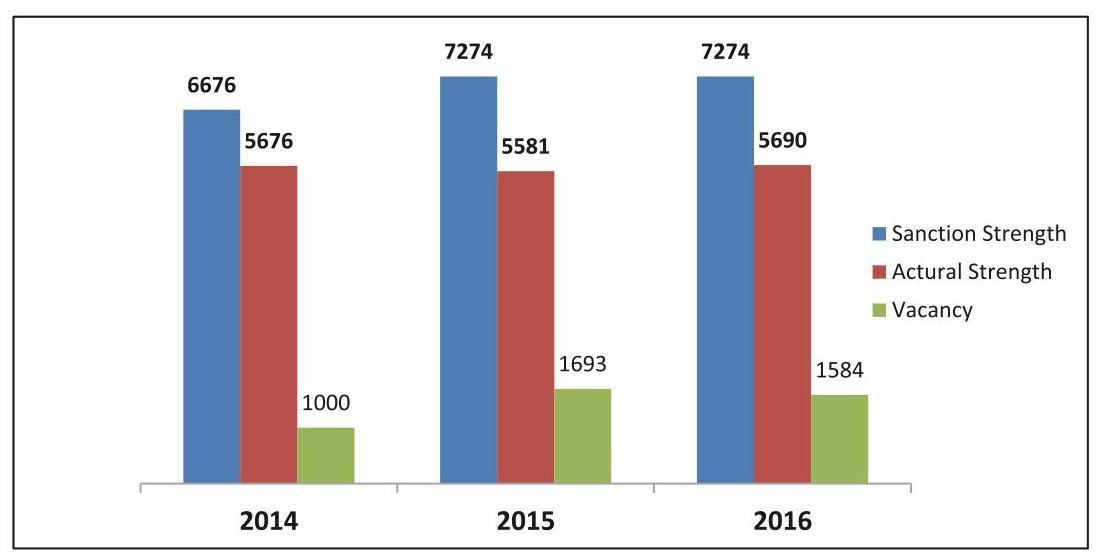
CRIME INVESTIGATION WORK
11.22 During 2016, 1047 Regular Cases / Preliminary Enquiries were registered. 28 of these were taken up on the requests of States Governments / Union Territories and 123 on the directions of the Constitutional Courts. 881 Regular Cases and 160 Preliminary Enquiries were finalised during the year. At the end of year, 1156 cases (RC/PE) were pending for Investigation / Enquiry. During the year, 954 Prosecutions were launched and judgements were received in 988 Court Cases. The Conviction Rate for the year 2016 was $66.8 %$. There were as many as 9429 Court Cases pending in various Courts at the end of year.
REGISTRATION
11.23 The 1047 cases registered during 2016 comprised 925 Regular Cases (RCs) and 122 Preliminary Enquiries (PEs). Out of these, 167 cases were registered for demand of bribe by public servants for showing official favours and 69 cases were registered for possession of Disproportionate Assets to known sources of their income. The comparative figures of registration of cases /enquiries during the last three years are depicted in the Bar Chart below:
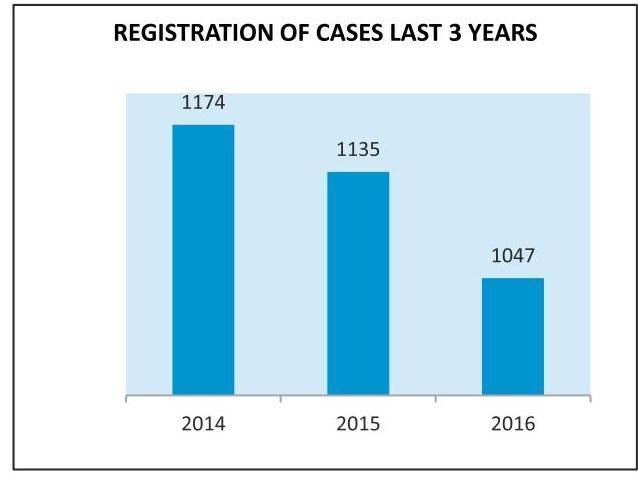
INVESTIGATION
11.24 During 2016, investigation was completed in 881 Regular Cases (RCs) and 160 Preliminary Enquiries (PEs). The following Bar Chart indicates the disposal of cases (RC/PE) enquiries from Investigation/Enquires during the last three years:
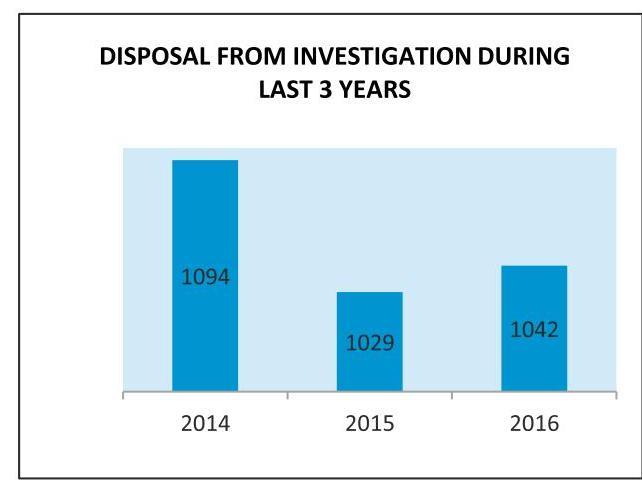
11.25 The following Pie Chart gives the mode of the disposal of cases [RCs/PEs] from Investigation/Enquiry during 2016:
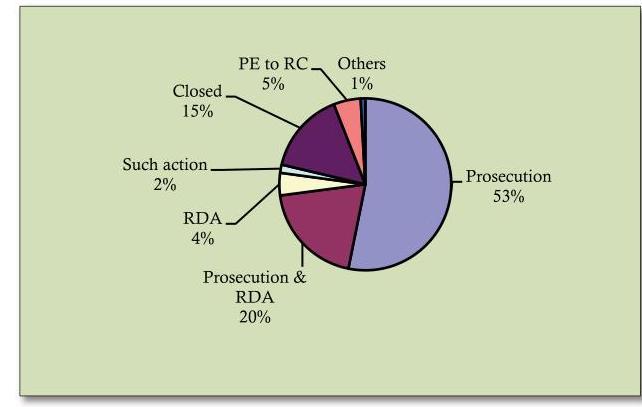
11.26 A total of 1156 cases [RCs/ PEs] were under Investigation/ Enquiry at the end of the year as against $1113 \mathrm{RCs} / \mathrm{PEs}$ under investigation/ enquiry at the end of 2015. The following Bar Chart shows the comparative figures for the last three years:
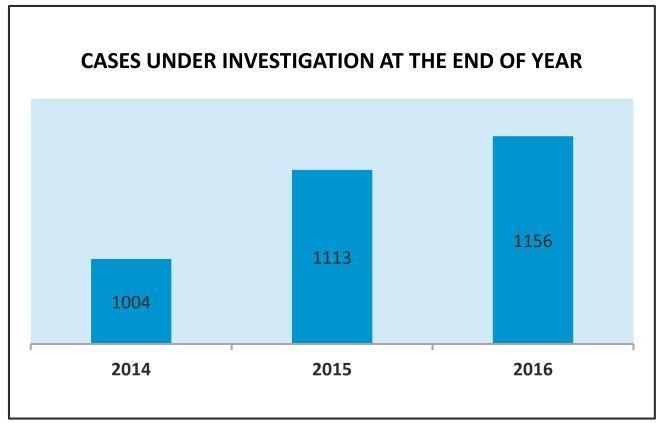
11.27 There were 454 cases under investigation for more than one year as on December 31, 2016. The following Bar Chart shows pendency of such cases at the end of 2014, 2015 and 2016:
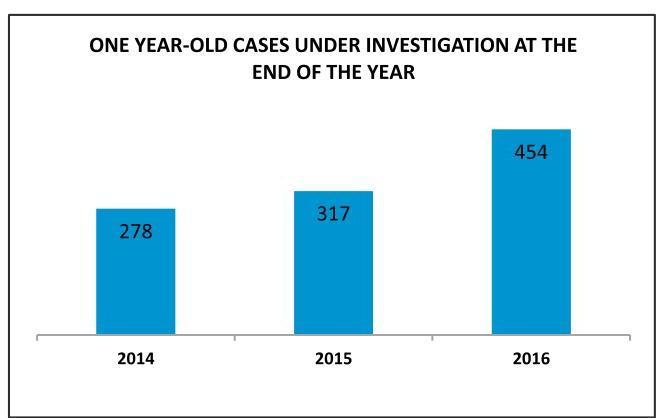
The figure has increased because of cases under further investigation have been added to the list.
TRIAL
11.28 During the year 2016, 954 Prosecutions were launched and Courts delivered Judgements in 988 Court Cases. Out of these, 621 cases resulted in Conviction, 274 in Acquittal, 35 in Discharge and 58 cases were disposed of for other reasons. The conviction rate was $66.8 %$. The Bar Chart below shows the disposal by courts during the last three years:
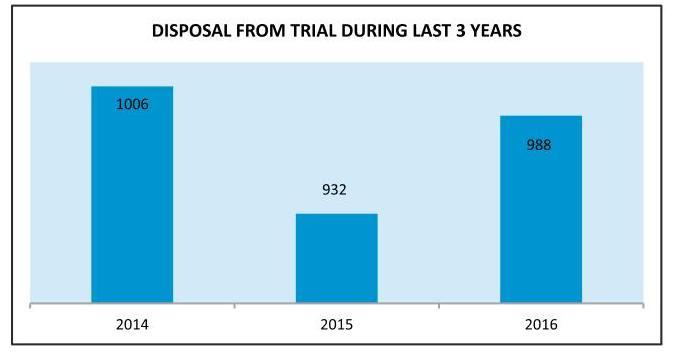
11.29 The following Bar Chart shows break-up of cases decided by the courts during the year 2016:
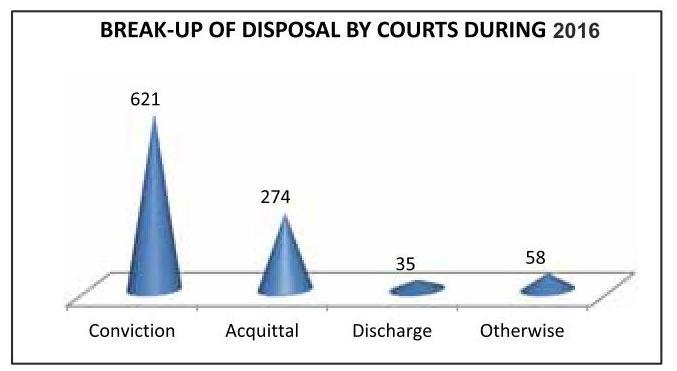
11.30 9429 trials were pending in various courts as on December 31, 2016. The Bar Chart below shows the number of pending under trial cases during last three years:
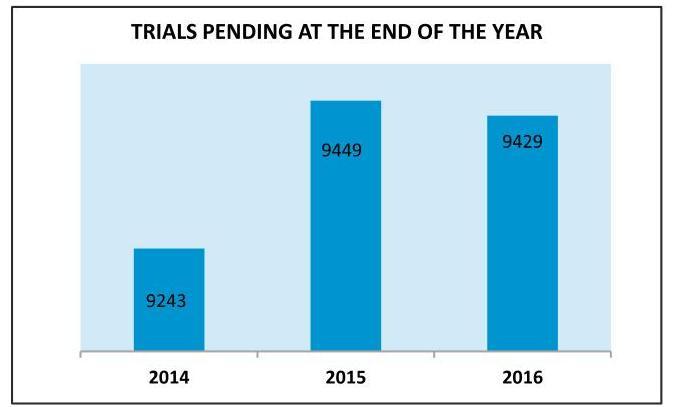
INTERNATIONAL INVESTIGATION AND COORDINATION
11.31 India joined INTERPOL in the year 1949. The Ministry of Home Affairs, Government of India by a circular dated $18^{\text {th }}$ March, 1949 issued to all State Governments and Union Territories, designated the Intelligence Bureau as the ICPOINTERPOL, the National Central Bureau for India. After the formation of CBI in the year 1963, vide its circular dated 17.10.1966, the Government of India, conveyed its decision that the Central Bureau of Investigation will henceforth be the representative of the country for the purposes of correspondence with the International Criminal Police Organisation (ICPO), popularly known as INTERPOL, its call sign for radio and wireless communication. Accordingly, the INTERPOL work was transferred to the Central Bureau of Investigation, an investigating agency under the administrative control of Department of Personnel and Training. All matters relating to the NCB India are, however, dealt with by the Ministry of Home Affairs, Government of India. The National Central Bureau (NCB)-India functions as an integral part of CBI, with Director, CBI being its ex-officio Head.
11.32 The mandate of NCB-India is to secure greater cooperation and share information amongst law enforcement organizations throughout the world. Pursuant to its delegated authority, NCB-India’s primary functions are:
- To facilitate international law enforcement cooperation;
- To transmit information of a criminal justice, humanitarian, or other law
enforcement related nature between domestic and foreign law enforcement agencies in INTERPOL member countries; and - To coordinate and integrate information in investigations of an international nature.
11.33 As the National Central Bureau for India, CBI is authorized unrestricted access to INTERPOL’s secure, encrypted communications network, as well as its entire array of investigative databases. Populated with millions of records contributed by INTERPOL’s 190 member countries, these databases contain vital investigative information on international fugitives, stolen and lost travel documents; missing persons, unidentified bodies, images of child sexual abuse and other matters of investigative interest. This capability facilitates law enforcement interaction in real time on investigative matters ranging from simple criminal history checks to the sharing of sensitive criminal intelligence and investigative leads targeting transnational organized crime groups.
11.34 In addition, NCB-India is exclusively responsible for securing the publication of INTERPOL Notices – a system of international lookouts or advisories used to assist law enforcement authorities in locating fugitives, identifying suspects and other investigative purposes on behalf of Indian law enforcement agencies and for ensuring that such notices published on behalf of other member countries are entered and maintained. NCB-India also supports the exchange of international humanitarian assistance requests involving such matters as death notifications and health & welfare checks
on Indians overseas, as well as foreign nationals in India.
11.35 NCB-India, part of International Police Cooperation Unit (IPCU) of CBI functions around the year on $24 \times 7$ basis. It is solely dedicated and equipped to assist the Indian law enforcement agencies and their foreign counterparts in overcoming the geographical and legal barriers that hinder the exchange of criminal investigative information and support across national administrations and boundaries.
11.36 NCB-India strives to coordinate Indian law enforcement actions and responses, ensuring that it is consistent with Indian interests and laws, as well as INTERPOLpolicies, procedures, and regulations.
CONFERENCES / WORKSHOPS ORGANISED DURING 2016
$17^{\text {th }}$ D.P.KOHLI MEMORIALLECTURE
11.37 The $17^{\text {th }}$ D. P. Kohli Memorial Lecture was delivered by Mr. Bob Paulson, Commissioner, Royal Canadian Mounted Police, on 20.10.2016. Mr. Bob Paulson spoke on $21^{\text {st }}$ Century Police Leadership, stating that transnational crimes require an internationally coordinated response.
11.38 The D.P. Kohli Memorial Lecture is a seminal event in the annual calendar of CBI. This is also an occasion for all ranks of CBI to pay homage to its founder Director, Late Shri Dharamnath Prasad Kohli, whose vision and ideals continue to inspire the members of this Organisation. Shri Kohli not only laid its foundation but also nurtured its core values and culture during its formative years from 1955 to 1968. It is a glowing testimony to his stellar contribution that today, the CBI is a premier
institution in the field of investigation, prosecution and international law enforcement co-operation.
THE $22^{\text {ND }}$ CONFERENCE OF CBI & STATE ACBX/VIGILANCE BUREAUx/EOWs
11.39 The $22^{\text {nd }}$ Conference of CBI \& State ACBx/Vigilance Bureaux/EOWs was inaugurated in New Delhi by Dr. Jitendra Singh, Minister of State (IC) Development of North Eastern Region, Minister of State PMO, Personnel, Public Grievances and Pensions, Department of Atomic Energy \& Department of Space. The police medals for meritorious service were also given away at the function. The valediction address was given by Shri Ravi Shankar Prasad, Hon’ble Minister for Law and Electronics \& Information Technology.
VISIT OF DELEGATIONS TO CBI HEADQUARTERS
11.40 The 7 member ministerial-level delegation from Cambodia visited CBI HQ on 25.04.2016. During the visit, discussions were held on matters related to pending LRs and capacity building. A multi-departmental and inter-ministerial delegation from Bangladesh visited the CBI HQ in July 2016 and exhibited a keen interest in forging further cooperation in the domain of AntiCorruption investigation. The delegation also visited the Central Forensic Science Laboratory to obtain an idea for securing assistance in the domain of Forensic Analysis.
FOREIGN VISITS OF CBI OFFICERS
11.41 During the year 2016, a total number of 43 CBI officers attended various international Capacity Building Programmes/training courses, investigations, etc.
LETTERS ROGATORY (OUTGOING)
11.42 During the year 2016, a total of 92 LRs were sent abroad out of which 43 LRs pertain to CBI cases and 49 pertain to State Law Enforcement and Central Law Enforcement agencies. During the year 2016, 65 Execution reports (relating to 55 LRs ) have been received from Foreign Law Enforcement Agencies. It was confirmed by Indian Law Enforcement Agencies including CBI that 22 LRs are fully executed in the year 2016. These 22 LRs include 14 LRs of CBI and 08 of State Police and other Law Enforcement Agencies. During 2016, 05 LRs were also treated as partially executed and closed. These include 04 LRs of CBI and 01 LR of State Police Agency. Further during 2016, 11 LRs were either returned/ withdrawn or disposed of. These include 08 LRs of CBI and 03 LRs of State Police Agencies. As on 31.12.2016, a total of 399 LRs are pending with other countries out of which 248 pertain to CBI cases and 151 pertain to State Police and other Central Law Enforcement Agencies.
LETTERS ROGATORY (INCOMING)
11.43 During the year 2016, as many as 99 Letters Rogatory (LRs) /Treaty Based Requests were received from various countries requesting to provide assistance in investigation of criminal matters. Execution Reports in 73 cases were sent to MEA after receiving the same from the various INTERPOL Liaison Offices (generally State CID/Crime Branch/CBI Branches) for onward transmission to the law enforcement agencies of the requesting countries. Besides these, 1 LR was closed and 6 LRs were returned un-executed. As on 31.12.2016, 103 LRs are pending for execution.
EXTRADITION/DEPORTATION
11.44 The data pertaining to Red Notices published, Red Notice subjects arrested in India/ abroad and Red Notice subject extradited to India during the year 2016 is as under:-
| Red Notices published by NCB-India | 87 |
|---|---|
| Fugitives wanted by India, arrested in India |
14 |
| Fugitives wanted by India, arrested/located in foreign countries |
36 |
| Fugitives wanted by other countries, arrested/located in India |
08 |
| Fugitives extradited/deported to India from foreign countries |
05 |
| Fugitives extradited/deported from India to foreign countries |
03 |
Details of the fugitives deported/extradited to India in 2016
11.45 During 2016, the IPCU, CBI facilitated successful deportation of 5 fugitives wanted by different Law Enforcement Agencies in India. These include:-
- KOYIYHAN KANDY ABDULLA (Red Notice No. A-7146/9-2015), Wanted by CBI/ACB/COCHIN: Koyithan Kandy Abdulla was wanted by CBI/ACB/Cochin for the charges of criminal conspiracy and cheating. The Authority of UAE has deported the above subject to IGI Airport, New Delhi on 28.01.2016 and was handed over to CBI/ACB/Cochin.
- Krushna Kumar Pillai PILLAY Krishnan Kumar @ K. P. (Red Notice No. A-428/1-2012), Wanted by Mumbai Police:- Krushna Kumar Pillai was wanted
by Mumbai Police for the charges of attempt to murder, Criminal intimidation to cause death or grievous hurt, Damage to property, use and illegally possession of fire arms, furtherance of common intention organised crime syndicate. Five Members team of Mumbai Police, led by Dy. Commissioner of Police, Mumbai, brought the fugitive/ extradited from Singapore on $27^{\text {th }}$ June, 2016.
- Samirbhai Vinubhai Patel (Red Notice No.A-614/3-2009), wanted by Gujarat Police:- Samirbhai Vinubhai Patel, wanted by Gujarat Police for the charges of Murder, attempt to murder. The subject was extradited from U.K. on 19.10.2016 by Air India flight A-172. The fugitive was escorted by SIT, Gandhinagar headed by IGP Ashok Kumar Malhotra.
- Abdul Saboor Kotta (Red Notice No.A-4150/7-2013), Wanted by Kerala Police:Abdul Saboor Kotta, wanted by Kerala Police for the charges of murder, unlawful assembly, rioting, criminal conspiracy and abetment, harbouring offender, disappearance of evidence, concealing design to commit offence. The subject was deported from Saudi Arabia on 29.11.2016. The Kerala Police team escorted the fugitive.
- Abdul Rauf Merchant (Red Notice No. A-924/2-2010), Wanted by Mumbai Police:-Abdul Rauf Merchant was wanted by Mumbai Police for the charges of Murder, possession and use of illegal prohibited firearms. The fugitive was handed over to Mumbai Police by
Bangladesh authority through IndoBangla border.
LOCAL PROSECUTION OF FUGITIVES WANTED BY OTHER COUNTRIES
11.46 In May 2016, in exercise of powers conferred by Sec. 3 of DSPE Act 1946(DSPE Act, 1946), the Central Government empowered and extended the jurisdiction of the CBI u/s 5 of DSPE Act to investigate and prosecute the offences committed outside the territorial jurisdiction of India. CBI has also been designated as the Nodal Authority to deal with and obtain sanction for prosecution from the MHA u/s 188 Cr.PC.
FUGITIVES WANTED BY OTHER COUNTRIES DEPORTED/EXTRADITED FROM INDIA (2016)
- ANIYI Babatunde, ANIYI Tunde @ BABATUNDE @ Aniyi(Red Notice No. A-594/1-2015), Wanted By USA:-
11.47 Aniyi Babatunde, wanted by US authorities for the offences of Conspiracy to Commit Wire Fraud and Impersonate a Government Official, Wire Fraud (5 counts) and Impersonation of an Officer and Employee of the U.S. The fugitive has been extradited to USA by flight no.UA 083 on 28.07.2016. The fugitive escorted by three USA officials. - Gaya S Gayatrinath, Wanted by USA:-
11.48 Gaya S Gayatrinath, wanted by US authorities for the offences of Conspiracy to commit bank fraud, wire fraud and mail fraud etc. The fugitive was extradited to USA on 05.10.2016. The fugitive was escorted by two USA officials.
- NADARASA Sabesvaran (Red Notice No. A-1181/2-1014), Wanted by Srilanka:-
11.49 NADARASA Sabesvaran, wanted by Srilankan authorities for the charges related to terrorism. He was deported to Sri Lanka on 23.10.2016 by Air India Flight No.AI-273.
INTERPOL Stolen and Lost Travel Documents (SLTD) Database:-
11.50 NCB, India has uploaded data relating to lost/stolen/revoked Indian passports into the INTERPOL SLTD Database being maintained by IPCU Branch. Further, till 31.12.2016, data of about 13.2 lakh Stolen/Lost/Revoked Indian Passports has been uploaded in the SLTD Database. During the year 2016, a total of 242 cases of use of revoked/lost/stolen passports were reported by foreign NCBs.
INTERPOL Global Communication System [IGCS] messages received during 2016:-
11.51 The four Regional Desks have received as many as 10380 requests/IGCS message/ letters from January 2016 to December 2016 regarding identity check, arrest message, conviction details, driving license check, identification of finger prints, missing persons, deportation, drug trafficking, searches and registration of thefts of antiquities stolen from India, etc. from various NCBs, PLOs and Indian Law Enforcement agencies/authorities. During the period under review, the four regional desks of NCB-India also worked in close coordination with other NCBs and rendered necessary guidance to them on various issues.
TRAINING
11.52 In the year 2016, CBI Academy and the three RTCs conducted a total of 140 courses and trained 3227 Officers/Officials.
| No. of Courses | No. of Participants | Total | ||
|---|---|---|---|---|
| CBI | Non-CBI | |||
| CBI Academy | 111 | 1422 | 1363 | 2785 |
| RTC, Kolkata | 12 | 144 | – | 144 |
| RTC, Mumbai | 10 | 137 | – | 137 |
| RTC, Chennai | 7 | 161 | – | 161 |
| Total | 140 | 1864 | 1363* | 3227 |
*includes 240 participants from Foreign Law Enforcement agencies.
11.53 Further, Advanced Training Courses in investigation of financial crimes are being organized by IIM Bangalore and advanced
courses in Law are being organized by National Law School University, Bangalore.
Chapter 12.
JOINT CONSULTATIVE MACHINERY
12.0 The Scheme for Joint Consultative and Compulsory Arbitration for the Central Government Employees was introduced in the year 1966 on the lines of the Whitely Councils in the U.K. The scheme provides a platform for constructive dialogue & discussion between the representatives of the staff side and the official side for peaceful resolution of all disputes between the Government as employer and the employees. The scheme was introduced with the objectives of promoting harmonious relations and securing the greatest measure of cooperation between the Central Government as the employer and the employees in matters of common concern and with the object of further increasing the efficiency of the public service combined with the well being of those employed.
12.1 The JCM Scheme provides for three tier machinery:
(i) the National Council as the apex body; (chaired by the Cabinet Secretary);
(ii) Departmental Councils at the level of individual Ministries / Departments including their attached and subordinate offices and (chaired by respective Secretaries); and
(iii) Regional / Office Councils to deal with mainly the local problems at the level of each individual office, depending on its structure. (Chaired by Head of office of respective organizations).
12.2 The scope of the JCM Scheme includes all matters relating to:
conditions of service and work;
welfare of the employees; and
improvement of efficiency and standards of work,
Provided, however, that
(i) In regard to recruitment, promotion and discipline, consultation is limited to matters of general principles; and
(ii) Individual cases are not considered.
12.3 Under the JCM Scheme, there have been continuous interactions with staff unions at the National level as well as at the Departmental level and a number of important issues have been resolved amicably through mutual discussions. 46 meetings of the National Council (JCM) have been held under the Chairmanship of Cabinet Secretary since the inception of the Scheme in 1966.
Anomaly Committee
12.4 Setting up of Anomaly Committee to settle the anomalies arising out of the implementation of the Seventh Pay Commission recommendations has been set up under the Chairmanship of Secretary (P).
Standing Committee Meeting
12.5 Meeting of the Standing Committee of the National Council (JCM) was held on $25^{\text {th }}$ October, 2016 under the chairmanship of the Secretary, Department of Personnel and Training.
ARBITRATION –
12.6 An important feature of the JCM Scheme is the provision for Arbitration in cases where there is no agreement on an issue between the Official Side and the Staff Side on matters relating to:-
pay and allowances;
weekly hours of work; and
Leave of a class or grade of employees.
BOARD OF ARBITRATION (BOA) –
12.7 A Board of Arbitration (BOA) comprising a Chairman (an independent person) and two
members, (nominated – one each by staff side and official side) functions under the administrative control of the Ministry of Labour. Awards of the Board of Arbitration are binding on both the sides, subject to the over-riding authority of Parliament to reject or modify the awards. Under JCM Scheme, 259 references have been made to Board of Arbitration for settlement of disagreement cases to date of which, 257 have been decided by BOA. Most of the awards which were in favour of the employees have been implemented, except a few which could not be accepted due to adverse effect on National Economy / Social Justice.
Chapter 13.
ADMINISTRATIVE TRIBUNALS
13.0 The Administrative Tribunals Act owes its origin to Article 323-A of the Constitution of India which empowers Central Government to set up Administrative Tribunals by an Act of Parliament for adjudication of grievances and disputes arising out of the conditions of service of an employee appointed to the public services and posts in connection with the affairs of the Union and the States. In pursuance of the provisions contained in the Administrative Tribunals Act, 1985, the Administrative Tribunals, set up under it, exercise original jurisdiction in respect of service matters of employees covered by the Act. As a result of the Supreme Court’s judgment dated 18th March, 1997 in the case of L. Chandra Kumar & Others Vs. UOI, the appeals against the orders of an Administrative Tribunal shall lie before the Division Bench of the concerned High Court.
13.1 The Administrative Tribunals are distinguishable from the ordinary courts with regard to their jurisdiction and procedure. They exercise jurisdiction only in relation to the service matters of the litigants covered by the Act. They are also free from many of the procedural technicalities of the ordinary courts. The procedural simplicity of the Act can be appreciated from the fact that the aggrieved person can also appear before it personally. Government can also present its cases through its departmental officers or legal practitioners. Further, only an affordable and nominal fee of Rs.50/- is to be paid by the applicants for filing the original before the Tribunal. Thus, the objective
of the Tribunal is to provide speedy and affordable redress to the aggrieved applicants arising out of employment or conditions of service.
13.2 The Central Administrative Tribunal was set up on 01.11.1985. At present, it has 17 regular Benches, 15 of which operate at the principal seats of High Courts and the remaining two at Jaipur and Lucknow. These Benches also hold Circuit sittings at other seats of High Courts. A statement showing the location of Central Administrative Tribunal Benches, the dates of their establishment and the number of courts in each of these Benches along with a list of places where they hold circuit sittings is given in Appendix-I.
13.3 The Tribunal consists of a Chairman and Members. It has also been the constant endeavour of this Ministry to ensure that the posts of Chairman and Members are filled up well in time and no post remains vacant for a long time. The Members of Central Administrative Tribunal (CAT) and State Administrative Tribunals (SAT) are drawn from judicial as well as administrative streams, so as to give the Tribunal the benefit of domain expertise both in legal and service matters. The sanctioned strength of the Chairman is one and sanctioned strength of the Members of Central Administrative Tribunal is 65 out of which 32 Judicial Members and 33 are Administrative Members. The appointment of Members in CAT is made on the basis of recommendations of a high powered Selection Committee chaired by a sitting Judge of Supreme Court who is nominated by the Chief Justice of
India. After obtaining the concurrence of Chief Justice of India, appointments are made with the approval of Appointments Committee of the Cabinet.
13.4 State Administrative Tribunals were also set up in the following States –
(i.) Andhra Pradesh
(ii.) Orissa
(iii.) Karnataka
(iv.) Madhya Pradesh
(v.) Maharashtra
(vi.) Tamil Nadu
(vii.) West Bengal
(viii.) Kerala
(ix.) Himachal Pradesh
The SATs in Madhya Pradesh, Himachal Pradesh and Tamil Nadu were abolished on the request of the concerned State Governments. Consequent upon formation of the new State of Telangana and in pursuant to request from State Government of Telangana, the functioning of the Andhra Pradesh State Tribunal in respect of the State of Telangana has been discontinued vide notification dated 15.09.2016. However, on the request of the State Government of Himachal Pradesh, SAT has been re-established in the State of Himachal Pradesh. State Government of Tamil Nadu has also requested now to re-establish the same.
13.5 The appointments to the vacancies in State Administrative Tribunals are made on the basis of proposals sent by the State Governments with the approval of the Governor. Thereafter, their appointments undergo the same process as the one in respect of Central Administrative Tribunal.
13.6 Since its inception in 1985 and up to 31.10.2016, the Central Administrative Tribunal received $7,31,183$ cases for adjudication (including those transferred from High Courts),
out of which $6,89,478$ cases have been disposed of leaving a pendency of 41,723 cases. On an average more than $94 %$ of the cases instituted during the year are disposed of. A statement indicating the institution, disposal and pendency of cases since inception of CAT is at Appendix-II.
13.7 Section 14(2) of the Administrative Tribunals Act, 1985 empowers the Central Government to extend the provisions of the Act to local or other authorities within the territory of India or under the control of Government of India and to Corporations or Societies owned or controlled by Government of India. In exercise of these powers, the Central Government had extended the provisions of the Act to 208 organizations so far.
13.8 In order to familiarize the newly appointed Members of CAT with the functioning of the Tribunal, a short Orientation Programme / Training is held from time to time. So far four such Orientation Programmes / Trainings have been held at the National Judicial Academy, Bhopal.
13.9 Further, for maintaining absolute integrity and promoting fair practices in the professional court dealings and keeping in view the general directions of the Hon’ble Supreme Court, the designated Selection Committee, in its meeting, has decided that a Judicial Member of CAT, who earlier practiced as Advocate in a Court in that station, should not normally be considered for posting in the CAT Bench of the same station.
13.10 Justice Shri Parmod Kohli is the Chairman of CAT. He has been appointed as Chairman, CAT with effect from 05.04.2016. Before his appointment as the Chairman, CAT, Justice Shri Kohli was the Chief Justice of Sikkim High Court.
APPENDIX-1
NAME, DATE OF SETTING UP, NO. OF COURTS AND ADDRESS ES OF VARIOUS BENCHES OF CENTRAL ADMINISTRATIVE TRIBUNAL
| S.No. | Name of the Bench | Date of setting | No. of courts | Address |
|---|---|---|---|---|
| 1. | PRINCIPAL | 01.11 .1985 | 6 | NEW DELHI |
| 2. | AHMEDABAD | 30.06 .1986 | 1 | AHMEDABAD |
| 3. | ALLAHABAD | 01.11 .1985 | 4 | ALLAHABAD |
| 4. | BANGALORE | 03.03 .1986 | 2 | BANGALORE |
| 5. | CHANDIGARH | 03.03 .1986 | 2 | CHANDIGARH |
| 6. | MADRAS | 01.11 .1985 | 2 | CHENNAI |
| 7. | CUTTACK | 30.06 .1986 | 1 | CUTTACK |
| 8. | ERNAKULAM | 01.09 .1988 | 2 | ERNAKULAM |
| 9. | GUWAHATI | 03.03 .1986 | 1 | GUWAHATI |
| 10. | HYDERABAD | 03.06 .1986 | 2 | HYDERABAD |
| 11. | JABALPUR | 30.06 .1986 | 1 | JABALPUR |
| 12. | JAIPUR | 15.10 .1991 | 1 | JAIPUR |
| 13. | JODHPUR | 30.06 .1986 | 1 | JODHPUR |
| 14. | CALCUTTA | 01.11 .1985 | 2 | KOLKATA |
| 15. | LUCKNOW | 15.10 .1991 | 1 | LUCKNOW |
| 16. | MUMBAI | 01.11 .1985 | 2 | MUMBAI |
| 17. | PATNA | 30.06 .1986 | 2 | PATNA |
STATEMENT SHOWING THE NAME OF BENCH AND PLACES WHERE CIRCUIT SITTINGSARE HELD
BENCH
- ALLAHABAD BENCH
- CALCUTTA BENCH
- CHANDIGARH BENCH
- MADRAS BENCH
- GUWAHATI BENCH
- JABALPUR BENCH
- BOMBAY BENCH
- PATNA BENCH
- ERNAKULAM BENCH
PLACES
Nainital
Port Blair, Gangtok
Shimla, Jammu,Srinagar
Pondicherry
Shillong, Itanagar, Kohima,
Agartala, Imphal, Aizwal
Indore, Gwalior, Bilaspur
Nagpur, Aurangabad, Panaji
Ranchi
Lakshadweep
APPENDIX-II STATEMENT SHOWING THE POSITION OF INSTITUTION, DISPOSAL AND PENDENCY OF CASES IN THE CENTRAL ADMINISTRATIVE TRIBUNAL SINCE INCEPTION UPTO 31.10.2016. (As provided by Central Administrative Tribunal, Principal Bench from time to time)
| S.NO. | PERIOD | INSTITUTION | DISPOSAL | PENDENCY AT THE END OF THE PERIOD |
|---|---|---|---|---|
| 1. | 1985 | 2963 | 30 | 2933 |
| 2. | 1986 | 23177 | 8934 | 17176 |
| 3. | 1987 | 19410 | 15084 | 21502 |
| 4. | 1988 | 19425 | 13769 | 27158 |
| 5. | 1989 | 18602 | 13986 | 31774 |
| 6. | 1990 | 19283 | 15495 | 35562 |
| 7. | 1991 | 21623 | 17552 | 39633 |
| 8. | 1992 | 25184 | 23782 | 41035 |
| 9. | 1993 | 27067 | 28074 | 40028 |
| 10. | 1994 | 26230 | 26409 | 39849 |
| 11. | 1995 | 25789 | 23668 | 41970 |
| 12. | 1996 | 23584 | 20667 | 44887 |
| 13 | 1997 | 23098 | 21981 | 46004 |
| 14. | 1998 | 21911 | 18394 | 49521 |
| 15. | 1999 | 22944 | 24566 | 47899 |
| 16. | 2000 | 25146 | 31398 | 41647 |
| 17. | 2001 | 25977 | 31953 | 35671 |
| 18. | 2002 | 25398 | 29514 | 31555 |
| 19. | 2003 | 25089 | 28076 | 28568 |
| 20. | 2004 | 23825 | 27735 | 24658 |
| 21. | 2005 | 21528 | 22408 | 23778 |
| 22. | 2006 | 18722 | 17774 | 24726 |
| 23. | 2007 | 17725 | 18674 | 23777 |
| 24. | 2008 | 18287 | 20352 | 21712 |
|---|---|---|---|---|
| 25 | 2009 | 24496 | 23681 | 22527 |
| 26. | 2010 | 26620 | 25477 | 23670 |
| 27 | 2011 | 25869 | 24750 | 24789 |
| 28 | 2012 | 27786 | 24259 | 28316 |
| 29 | 2013 | 27442 | 21654 | 34104 |
| 30 | 2014 | 27872 | 23767 | 38209 |
| 31 | 2015 | 26059 | 23051 | 41217 |
| 32 | Up to 31.10.2016 | 23052 | 22564 | 41723 |
| 7,31,183 | 689460 | 41723 |
Chapter 14
STAFF WELFARE
14.0 The Central Government is the largest single employer in the country and bears the major responsibility for looking after the welfare of a large number of employees spread all over the country. Realizing that improvement in the working and living conditions of the employees and their families leads to efficiency and high morale, the Department of Personnel and Training supports various staff welfare measures. A brief account of various welfare measures dealt with by Welfare Division is given below.
RESIDENTS’ WELFARE ASSOCIATION
14.1 In order to foster a spirit of mutual help and goodwill among residents of Government colonies and to promote social, cultural and recreational activities, Department of Personnel & Training (DoPT) has been encouraging formation of Central Government Employees Residents Welfare Associations (CGERWA). Every CGERWA seeking reorganization and grants-in-aid from Government is required to adopt Model Constitution prescribed by DoPT. At present, there are 94 recognized Associations. The members of the Managing Committee of these Associations are elected every two years under the provisions of a Model Constitution framed by the Department of Personnel and Training. This Department Sanctions grants-in-aid only to recognized Associations, subject to a maximum of Rs. 10,000/- per annum for an Association.
AREA WELFARE OFFICERS
14.2 The Area Welfare Officers (AWOs) are
nominated in residential colonies having a large number of Central Government employees. The AWOs serve as a link between the Government and residents in matters relating to the welfare of the Government employees living in various colonies. They also work as field officers in coordinating and maintaining liaison with various agencies of Government such as CPWD, CGHS, Police etc. Applications are invited from Gazetted Officers working in various Ministries/ Departments for being nominated as Area Welfare Officers for a period of two years. Officers desirous of being nominated as AWOs on voluntary and honorary basis are required to apply through their respective Ministries/Departments.
CENTRAL GOVERNMENT EMPLOYEES WELFARE COORDINATION COMMITTEES (CGEWCCs)
14.3 The Central Government Employees Welfare Coordination Committees (CGEWCCs) have been formed outside Delhi, at place where there are at least five Central Government Offices and the total number of Central Government Employees is not less than 1000. These Committees are responsible for coordinating the Welfare activities of the Central Government employees serving within their jurisdiction. The senior most officer at the station functions as the Chairman of the Committee. The quantum of grant based on the staff strength is sanctioned by the Department of Personnel and Training to the CGEWCCs.
CENTRAL CIVIL SERVICES CULTURAL AND SPORTS BOARD (CCSCSB)
14.4 The Central Civil Services, Cultural & Sports Board, a society registered under the Societies Registration Act, 1860 is the Central agency for promotion of Cultural \& Sports activities amongst the Central Government employees in the country. The Board was set up in 1964 as Central Secretariat Club in the Ministry of Home Affairs. Initially, the objective of the Board was to promote cultural and sports activities amongst the Central Government Employees located in Delhi only. Subsequently, Regional Sports Boards were set up in various cities. Financial grants in-aid are sanctioned every year by the Board to the Regional Boards.
ACTIVITIES OF THE BOARD
INTER MINISTRY
TOURNAMENTS 2016-17
14.5 The Board organizes Inter-Ministry Tournaments in 18 disciplines of sports. So far, the Board has organized Inter-Ministry Tournaments in Carom, Football and Swimming for the year 2016-17. Rests of the tournaments are being organized as per the calendar of the Board.
ALL INDIA CIVIL SERVICES TOURNAMENTS HELD DURING THE YEAR 2016-17
14.6 These tournaments, which are open to Central and State Government employees, aim to give an opportunity to the civil servants to meet and interact with each other and compete. All India Civil Services Swimming Tournament was held from $18^{\text {th }}$ to $20^{\text {th }}$ October, 2016 at
Gandhinagar, Gujarat. Central Secretariat Swimming team won the championship in the Tournament. Other AICS Tournaments would be organized in collaboration with different States/UTs.
SCHEME FOR PROMOTION OF ADVENTURE SPORTS \& SIMILAR ACTIVITIES AMONGST CENTRAL GOVERNMENT EMPLOYEES
14.7 As a welfare measure, the CCSCSB launched a Scheme for promotion of adventure sports and similar activities amongst Central Government Employees working in the Ministries/Departments. The Scheme includes upto 10 days programme having components of environmental awareness, disaster management, team spirit, capacity building, and Swachh Bharat Campaign and activities like Trekking, Mountaineering, Rock-Climbing, Cycling in a difficult terrain, Skiing, Rafting, Para Sailing, Jungle Safari and Environmental Awareness Camps etc.
14.8 It is expected that participation by Central Government Employees in adventure sports and similar activities will give them a platform where they would learn lessons from nature and use the knowledge acquired for welfare of the society. It would also foster spirit of risk-taking, cooperative team work, capacity of readiness, vital response to challenging situations, endurance and environmental awareness.
BOARD’S AFFILIATION TO NATIONAL FEDERATION
14.9 The Board is affiliated to a number of sports associations/federations at the National level. Board’s teams participate in the National
Tournaments organized by these Associations/ Federations in Kabaddi, Hockey, Football, Carom and Chess.
TREKKING
14.10 The Board sponsors trekking programme for Central Government Employees in collaboration with the Youth Hostels Association of India. A part of expenditure on this programme is met by the Board.
SPORTS FACILITIES IN DELHI
14.11 The Board has a sports complex at Vinay Marg, New Delhi which has facilities for Football, Hockey, Cricket, Athletics, Lawn Tennis, Basketball, Volleyball and practice pitches for Cricket. The Board also maintains Lawn Tennis Courts at Brassy Avenue, Bharti Nagar and R.K.Puram Sector -13, New Delhi. Brassy Avenue, New Delhi has facilities for Volleyball and Cricket practice pitches also. There is facility for indoor games such as Table Tennis, Carrom and Chess at Nirman Bhawan, New Delhi.
COACHING FOR CHILDREN/ DEPENDENTS OF GOVERNMENT EMPLOYEES
14.12 The Board also conducts regular coaching in Cricket and Lawn Tennis for the children/dependents of Government employees at Vinay Marg Sports Complex, New Delhi. Coaching in Lawn Tennis is also available at Bharti Nagar and R.K. Puram Sector-13, New Delhi. The Board also organizes Summer Coaching camp in Basketball, Cricket, Football, Self-defence and Lawn Tennis for children/dependents of government employees.
PARTICIPATION OF GOVERNMENT EMPLOYEES AND THEIR FAMILIES IN SPORTING ACTIVITIES CONDUCTED IN COLLABORATION with BY SAI
14.13The Board has introduced Scheme for Swimming for Central Government Employees and their children in collaboration with Sports Authority of India at Major Dhyanchand National Stadium New Delhi. Under the Scheme, an hour slot is booked in National Stadium by the Board for the use of Government employees and their dependents families during the summer seasons (i.e. April to September) at nominal charges. Badminton, Table Tennis and Fitness Centre facilities are also extended to Government Employees under “Come and Play” scheme of Sports Authority of India to the employees and their families. Under this scheme, the amount charged by SAI is reimbursed to the beneficiary after deduction of nominal fee.
SETTING UP OF GYMNASIUM IN MINISTRIES/DEPARTMENTS
14.14 The Board has framed the Scheme for establishment of indoor Gymnasium, open Gym and augmentation of existing Gyms in Ministries/Departments. As a Staff welfare measure, the CCSCSB would provide financial assistance to the Ministries/Departments of Central Government for setting up of indoor & open Gymnasium and augmentation of existing Gyms.
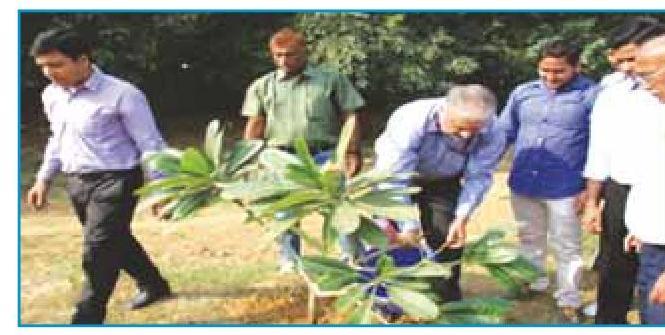
Dr. Devesh Chaturvedi, Joint Secretary, DoPT took part in plantation programme at Vinay Marg Sports Complex, New Delhi
GRIH KALYAN KENDRA
14.15 The Grih Kalyan Kendra (GKK) is a registered Society under the Societies Registration Act, 1860 and functioning under the aegis of Ministry of Personnel, Public Grievances & Pensions.
14.16 The basic objectives of the GKK, in brief are:-
a) To promote social, economic, cultural and educational activities for the welfare of Central Government Employees and their families.
b) To impart technical and vocational training in home crafts and other household arts for useful utilization of leisure time and for better and efficient housekeeping.
c) To organize and promote economic activities that may provide opportunities for gainful employment to families of Central Government employees for supplementing family income.
The GKK is administered by GKK Board.
14.17 The Board is responsible for the organization and administration of GKK. Additional Secretary (S\&V), DOPT, is the President of the GKK Board.
14.18 In pursuance of its objectives, GKK has been conducting the following activities:
a) Training classes in cutting, tailoring and embroidery for the housewives and grown-ups during their leisure hours.
b) Nursery education for children in the age group of 3 to 5 years.
c) Creches of Day Care Centres for children between the ages of 90 days and 10 years.
d) Recreational facilities like Health Club/Gym, Badminton and Tennis etc.
e) Coaching classes in Martial Arts, Yoga, Music, Dance, English Speaking Course, Computer, Brain Development, Fine Arts, Lawn Tennis etc.
14.19 The welfare activities run by Grih Kalyan Kendra are indicated in the table given below:
| Place | Numbers of Samaj Sadans/ Centers |
Craft Centres | Nursery Schools |
Creche Centres |
Health Club/ Gyms |
|---|---|---|---|---|---|
| Delhi | 40 | 8 | 15 | 11 | 9 |
| Mumbai | 7 | 4 | 4 | – | – |
| Chennai | 5 | 1 | 2 | 1 | 1 |
| Jaipur | 2 | 1 | – | – | – |
| Dehradun | 2 | – | 2 | – | – |
| Nagpur | 2 | – | – | – | – |
| Bangalore | 3 | – | – | – | – |
| Faridabad | 1 | 1 | 1 | 1 | |
| Kolkata | 1 | – | – | – | – |
| Ghaziabad | 1 | – | – | – | – |
| Total | $\mathbf{6 4}$ | $\mathbf{1 5}$ | $\mathbf{2 4}$ | $\mathbf{1 3}$ | $\mathbf{1 0}$ |
14.20 The Grih Kalyan Kendra has undertaken the following activities during 2015-2016.
i) 1945 children in Nursery Schools, 350 Students in Craft Centres, 218 Children in Creches, 194 Users in Health Clubs/ Fitness Centres, 1046 in Outsourced Activities and 2000 in Yoga Activity have been availing the facilities.
ii) DoPT launched a Yoga training scheme w.e.f. 01.04 .2015 in association with Morarji Desai National Institute of Yoga, New Delhi for the benefit of Central Government employees and their dependants free of cost. The training sessions are conducted in 28 locations in Delhi and 12 Samaj Sadans of Grih Kalyan Kendra outside Delhi. Yoga Trainers have been selected by Morarji Desai National Institute of Yoga (MDNIY), New Delhi. These trainers have been engaged by Grih Kalyan Kendra, on contract basis for a period of one year. Government has allocated Rs. 2 crore for the scheme of Yoga Training sessions under the Non-Plan Head in 2016-17.
iii) 800 participants of Yoga Training Session at various Samaj Sadans in Delhi attended the International Yoga Day held on 21.06.2016. International Yoga Day was celebrated at the Samaj Sadans located outside Delhi namely, Kolkata, Chennai, Mumbai, Nagpur and Dehradun.
KENDRIYA BHANDAR
14.21 Objectives of the organization:
The Central Government Employees Consumer
Cooperative Society Ltd., New Delhi, operating in the name of KENDRIYA BHANDAR was set up in 1963 in pursuance of the Cabinet decision as a welfare project for the benefit of the Central Government Employees. The society endeavours to serve the Central Government Employees and general public at large by providing quality goods of daily needs at reasonable prices and consumer items through its retail stores. The range of items which Kendriya Bhandar provides includes goods, grocery items, stationery and medicines etc.
Multi State Cooperative Society:
14.22 The society is registered under MSCS Act 2002, as a Multi State Cooperative Society and operates in Delhi and other States of the country.
Network:
14.23 The society operates a network of 143 stores/branches in Delhi, Maharashtra, Tamil Nadu, Andhra Pradesh, Karnataka, Cochin, Daman, Goa, Gujarat, Uttar Pradesh, Uttarakhand, Rajasthan, Madhya Pradesh, West Bengal, Jharkhand, Assam, Haryana, Punjab and Chandigarh etc.
14.24 At Delhi, Kendriya Bhandar (KB) has a chain of 102 nos. grocery/ consumer retail stores and 05 Exclusive Stores for medicines. At grocery/ consumer stores, all items of consumer goods, grocery items and certain stationery items are being sold. In addition, KB have exclusive Counter at East Block and West Block, R.K Puram, New Delhi for sale of stationery and other products. In other parts of the country, our valuable customers are being served through the network of stores/ branches as per the details given hereinabove.
14.25 Kendriya Bhandar has opened Three Jan Aushadhi Generic Drug Shops in GTB Hospital, DDU Hospital and Shastri Bhawan as a part of Jan Aushadhi Project of the Department of Pharmaceuticals, Govt. of India.
SHARE CAPITAL
14.26 As on $31^{\text {st }}$ March 2016 Kendriya Bhandar had a paid-up capital of Rs. 98.26 lakhs of which Rs. 68.18 lakhs have been subscribed by the Central Government and the rest by individual members.
MODERNISATION / AUTOMATIONS EFFORTS
14.27 Kendriya Bhandar has also undertaken the modernization of its retail stores including renovation, computerization etc. in order to provide a pleasant shopping experience to the customers and accordingly over 10 stores have been modernized during the last one year. This has also resulted in increase in customers footfall and significant increase in retail sales.
SALES AND FINANCIAL PERFORMANCE
14.28 Kendriya Bhandar has registered significant growth in the recent past. Total sales during the year 2015-16 were Rs. 1020.86 crore and the Net Profit after tax was Rs.4.25 crore respectively.
14.29 Kendriya Bhandar has declared a dividend of $10 %$ for the year 2015-16. Kendriya Bhandar is likely to achieve a turnover of Rs. 900 crores (approx) during the financial year 2016-17.
BENEFITS TO CUSTOMERS
14.30 The Society has been able to maintain competitive prices for various products sold by it
as compared to those prevailing in the market. In fact, selling prices prevailing in Kendriya Bhandar now are deemed as the benchmark in the market.
14.31 For better quality control, pre-testing of grocery items before distribution to stores has been introduced and testing of random samples picked from shelves of stores is also being continued. These steps ensure that the quality of goods sold is maintained for better consumer satisfaction.
14.32 Billing to customers has been computerized in 66 stores. As a new initiative, the bar code scanning system is being provided in all these stores. Further, display panels are being provided for convenience of customers so that they can point out discrepancy in rates of any item at the time of billing.
14.33 CCTV cameras have been provided in 35 stores as preventive measure against shop lifting, theft etc. Credit Card Machines have so far been installed in 37 stores and being provided in remaining stores in phased manner. Payment through mobile phones on “Paytm App” has also been enabled in six stores on trial basis.
14.34 The Society has been involved in welfare activities and has always assisted the Central Government and the Govt. of NCT of Delhi in arresting the price rise at the time of crisis.
14.35 Kendriya Bhandar has been working closely with M / o Consumer Affairs, Food & Public Distribution, Govt. of India for containing the prices of pulses by selling Arhar, Urad \& Chana dals at lower prices through its 101 retail stores in Delhi. The initiative taken by Kendriya Bhandar has been appreciated by M / o Consumer Affairs, Food \& Public Distribution, Govt. of India.
THE CIVIL SERVICE SOCIETY (SANSKRITISCHOOL)
14.36 The Civil Service Society is a society registered under the Societies Registration Act. The Society was set up in February 1995, by the wives of the officers of the All India and Allied Civil Services. The wife of serving Cabinet Secretary is the Chairperson of the Civil Services Society. The office of the Society is on Dr. S. Radhakrishnan Marg, Chanakyapuri, New Delhi110021 .
Aims and Objectives
14.37 The aims and objectives of the society, inter alia, are as under: –
- To establish progressive schools or other educational institutions in Delhi or outside Delhi, open to the children of officers of the All India and Central Services. Depending on the availability of seats, children of officers of the Public sector or non – government servants may also be admitted, at the discretion of the Governing Body.
- To impart sound and liberal education to boys and girls during their impressionable years – a type of education that will lay stress on character building, team work, esprit de corps, physical development and will infuse in school children a spirit of adventure, fair play and justice.
- To develop among its students a feeling of pride in Indian culture and to produce citizens who will truly be global and rise above social, communal, religious and provincial prejudices.
14.38 The Society started its first school with the
strength of 32 students, the Sanskriti School, in New Delhi, in the year 1998. The Chairperson of the Society is also the Chairperson of the School. Sanskriti School is recognized integrated coeducational school, affiliated to the CBSE, offering education from Nursery through Class XII.
14.39 The Society believes that every child can and must realize his/her full potential, and towards this end, must be enabled through appropriate means. With this in mind, the School has Learning Centre with Special Educators and counsellors guidng children who have special needs, through an Individual Education Program (IEP).
14.40 Likewise, for those from the relatively less privileged sections of society, the Society runs a parallel school Umang in the afternoon. Efforts are also made to mainstream some of the children. These children from the economically weaker sections are admitted through the admission process under the Delhi Education Act.
14.41 The Civil Services Society has set up a Centre for Excellence to promote teacher training initiatives. It has instituted the Sanskriti Lecture Series to motivate students by exposing them to thought processes of eminent persons.
Management
14.42 The general management of the affairs of the Society is vested in its Executive Committee.
14.43 The general management of the affairs of Sanskriti School is also guided by the Managing Committee.
Activities
14.44 As on date, Sanskriti School has 2863 students on its rolls from Nursery to Class XII. It
has well stocked libraries, smart classrooms, laboratories, a gymnasium, a football field and a swimming pool. Apart from the prescribed curriculum, Sanskriti School offers its students a choice of sports and games, like cricket, football, basketball, table tennis, swimming and wide ranging co-curricular activities like yoga, chess, theatre, music, dance, quiz, public speaking, paper craft, etc.
Finance
14.45 The Society has no income of its own other than the annual subscription of the members. For Sanskriti School, the source of income is the fees collected from the students.
CIVIL SERVICES OFFICERS INSTITUTE (CSOI)
INTRODUCTION
14.46 The Civil Services Officers’ Institute is a registered society under the Societies Registration Act and was set up in February 1998. CSOI was allotted a building at K.G. Marg, M.S. Apartments complex in 1998 which was later reappropriated by CPWD to provide facilities of an institute. Subsequently, land was allotted to CSOI in 2002 at Vinay Marg, Chankyapuri measuring 4.23 acres by Ministry of Urban Development, GOI. The new building was constructed by NBCC at a cost of Rs. 44.33 cr and it became operational with effect from December 2012. The Governing Council of CSOI took a decision to run both the Institutes at their respective locations in view of increased membership.
AIMS AND OBJECTIVES
14.47 The aims and objectives of the CSOI inter alia include:-
(i) To promote welfare of the officers of the Civil Services and bring them together under one umbrella to secure complete integration of the services and to build a corps of officers imbibed with the spirit of co-operation in all aspects of Civil Services.
(ii) To hold, organize, arrange and conduct seminars, symposiums, talks, debates, workshops, lectures and other means of dispensing education to meet the needs and challenges of modern day Civil Administration.
(iii) To print and publish journals, periodicals and manuals to keep the civil servants abreast with modern day developments in Civil Administration.
(iv) To acquire and promote modern skills of Civil Administration and harmonize between different fields of Civil Administration by disseminating or exchanging knowledge thereof and by providing such other facilities as would lead to their universal application.
(v) To establish and maintain libraries and information system to facilitate study of Civil Administration at International level and spreading information in regard thereto.
(vi) To organize and maintain, on no-profit-noloss basis, limited residential accommodation for the members of the Society coming to participate in the activities of the Association and of other bodies with
cognate objectives, as well as nonmembers, invited to participate in the activities of the Association.
MANAGEMENT
14.48 CSOI is managed by a Governing Council headed by Cabinet Secretary, an Executive Committee headed by Secretary (DoPT), and a Working Committee headed by Additional Secretary (DoPT).
DEPARTMENTAL CANTEENS
14.49 As a measure of Staff Welfare, Departmental Canteens/Tiffin Rooms have been set up in the Central Government Offices/ Establishments to make available beverages, snacks and meals prepared in hygienic conditions, to the employees at reasonable rates. At present about 1,000 Departmental Canteens/Tiffin Rooms are functioning in various Central Government Offices all over India. With a view to bringing about cleanliness, quality of service etc. detailed instructions are issued from time to time including orders on policy matters. Detailed instructions on functioning of Departmental
Canteen are contained in Administrative Instructions on Departmental Canteens in Government Offices and Industrial Establishments.
14.50 Important instructions/orders issued during 2016-17:-
i. Organization of Training Programmes for Cook Category at various Institutes of Hotel Management.
ii. Scholarship is granted to eligible wards of canteen employees from the Discretionary fund of Director (Canteens).
iii. Grant of funds for modernization of Non-Statutory Department Canteens.
iv. Implementation of Food Safety & Standards Act, 2006 and Rules \& Regulations there under.
v. Issue of consolidated instructions on various aspects of functioning of canteens.
Chapter 15.
RIGHT TO INFORMATION
MANDATE
- Administration of the RTI Act and Rules including amendments thereof.
- Issue of Guidelines and clarification on RTI.
- Implementation of the centrally sponsored plan scheme titled ‘Improving Transparency and Accountability in Government through Effective Implementation of RTI Act’.
- Management of RTI online web portal.
- Administrative matters of Central Information Commission.
- Selection of Chief Information Commissioner and Information Commissioners in the Central Information Commission.
- Framing of Right to Privacy Law.
SALIENT FEATURES OF THE RIGHT TO INFORMATION ACT, 2005
15.1 To set out a practical regime for securing information by citizens from the Public Authorities and to promote transparency and accountability in the working of all Public Authorities, the Parliament enacted the Right to Information Act in 2005.
15.2 The Act is comprehensive and covers disclosure of information on almost all matters of governance. It is applicable to Government at all levels- Union, State and Local and also to the bodies owned, controlled or substantially financed directly or indirectly by the Government. It covers all legislative bodies, the judiciary, the executive and all Constitutional bodies.
15.3 The Act casts an obligation on public authorities for suo-motu disclosure/publication of large amount of information. It also requires the
public authorities to supply information called for by any citizen and to permit him to inspect the documents and collect samples of various works. The procedure for seeking information is very simple. A person seeking information has to make a request to the concerned Public Information Officer indicating the information required. The request may be sent either by post or be submitted in person. It can be made in Hindi or English or in the official language of the area in which the application is made or online if such facility exists with the public authority.
15.4 The Act creates an elaborate machinery to ensure supply of information which consists of Public Information Officers, Assistant Public Information Officers, Departmental Appellate Authorities, independent Central and State Information Commissions etc.
15.5 The Act requires supply of information on
time bound basis. A Public Information Officer is required to send information called for at the specified address within 30 days. In case of information concerning the life or liberty of a person, the information is provided within forty eight hours. If the information is not provided within the prescribed period, the Act makes provision for imposition of stringent penalty on the Public Information Officer. The Public Information Officer may have to pay a penalty of Rs. 250 per day of delay subject to a maximum penalty of Rs. $25,000 /-$.
15.6 The information Act has created a system of two appeals. If an applicant does not get information within the prescribed period or the applicant is not satisfied with the reply given to him, he can make first appeal within 30 days to the Departmental Appellate Authority who is generally the next superior officer to the Public Information Officer. If the applicant is not satisfied with the decision of the First Appellate Authority, he can file a second appeal to the Central Information Commission or the State Information Commission, as the case may be, within 90 days.
15.7 The provisions of the Act have been made over-riding in character, so that the scheme is not subverted through the operation of other minor Acts. However, certain types of information pertaining to security of the country, scientific or economic interest of the country and information on trade secrets, etc. are exempted from disclosure. Certain security or intelligence organizations, have been exempted from disclosing any information except pertaining to
corruption or violation of human rights. Such organizations are required to designate Public Information Officers and First Appellate Authorities to deal with applications and appeals relating to information pertaining to corruption or violation of human rights.
CENTRAL INFORMATION COMMISSION
15.8 The Government of India has constituted the Central Information Commission and all the 27 States to which the Act applies have constituted State Information Commissions. These Commissions are high powered independent bodies which, inter-alia, can look into the complaints made to them and decide the appeals. The Commissions have power to impose penalty on the defaulting Public Information Officers. Central Information Commission entertains complaints and appeals in case of offices, financial institutions, public sector undertakings, etc. under the Central Government and the Union Territories while the State Information Commissions entertain appeals pertaining to offices, financial institutions, public sector undertakings, etc. under the concerned State Government.
15.9 The Central Information Commission, when constituted initially, had five Commissioners including the Chief Information Commissioner. During the last 2 years (2014-15 & 2015-16), the Government has strengthened the Commission by appointment of one Information Commissioner in 2015 and the Chief Information Commissioner in 2014, 2015 \& 2016. The Commission has now 10 Information Commissioners (ICs) headed by One Chief
Information Commissioner. For the first time, the Commission is working on full strength.
RIGHT TO INFORMATION RULES, 2012
15.10 In supersession of the Central Information Commission (Appeal Procedure) Rules, 2005 and the Right to Information (Regulation of Fee and Cost) Rules, 2005, the Right to Information Rules, 2012 have been notified in the Gazette of India on 31st July, 2012.
15.11 The Right to Information Rules, 2012 provide that a request for obtaining information shall be accompanied by an application fee of rupees ten by way of cash against proper receipt or by demand draft or bankers’ cheque or Indian Postal Order payable to the Account Officer of the public authority. The applicant may have to pay fee in addition to application fee for obtaining documents or for inspecting the documents as follows:
(i) Rs. 2 for each page in A-3 of smaller size of paper;
(ii) Actual cost or price of a photocopy in larger size paper;
(iii) Actual cost or price for samples or models;
(iv) Rupees fifty per diskette or floppy;
(v) Price fixed for a publication or rupees two per page of photocopy for extracts from the publication;
(vi) No fee for inspection of records for the first hour of inspection and a fee of rupees 5 for each subsequent hour or fraction thereof; and
(vii) So much of postal charge involved in
supply of information that exceeds fifty rupees.
15.12 The persons below poverty line are not required to pay any fee for seeking information.
15.13 The RTI Rules, 2012 also prescribe the procedure for deciding appeals by the Central Information Commission. The Rules provide for the following aspects of the appeal:
(i) Documents to be enclosed with the appeal;
(ii) Return of Appeal
(iii) Process of Appeal
(iv) Procedure for deciding appeals
(v) Presence of the appellant before the Commission
(vi) Presentation by the Public Authority
(vii) Service of notice by Commission
(viii) Order of the Commission
RTI WEBSITE
15.13 There is a dedicated website on RTI www.rti.gov.in, which contains valuable information including circulars, notifications and Guides on RTI, search facility for locating CPIOs and Appellate Authorities in Central Government etc. It has a linkage with other RTI related sites as well.
CENTRALLY SPONSORED PLAN SCHEME ON RIGHT TO INFORMATION
15.14 The Government has launched a Centrally Sponsored Plan Scheme “Improving Transparency and Accountability in Government through Effective Implementation of the Right to Information Act” in August, 2010 to undertake
activities in the area of awareness generation and capacity building. Under the scheme, the State Administrative Training Institutes and State Information Commissions are given support through release of grants for awareness generation and training programmes of all stakeholders. The total outlay of the scheme under XII Five Year Plan is Rs. 110.36 crores. During the last two years i.e., 2014-15 and 2015-16 (upto $31^{\text {st }}$ March, 2016) an expenditure of Rs. 20.29 crores has been incurred under the Scheme. During the current F.Y i.e 2016-17, an amount of Rs 3.92 crores has been released till 16.12.2016.
TRAINING:
15.15 The above Plan Scheme has components of training of Public Information Officers / First Appellate Authorities of Centre as well as States. On the training of State PIOs, a sum of Rs.1.94 crores was released to Administrative Training Institutes during the current year up to 16.12.2016.
MASS MEDIA CAMPAIGN ON RTI:
15.16 The component of awareness generation includes mass media campaign and publication of guidebooks. During the year under review an expenditure of Rs. 0.16 crores was incurred on these components. Guide books on RTI are now being published online.
INTERNSHIP ON RTI:
15.17 Considering the need to consolidate and document the experiences of the Ministries/Departments of Government of India in the implementation of RTI, its successes, constraints in implementation, to identify the
areas which need more attention, to address the gap areas and to see what more needs to be done to help achieve the objectives of the Act, DOPT provides Short Term Internships to Undergraduates pursuing the five year integrated course in Law and pursuing Graduation in Law to conduct an analysis of RTI application in Select Public Authorities. During the year under review, Internship was offered to three interns under RTI Internship Programme.
RTI FELLOWSHIP:
15.18 The RTI fellowship of 3-month duration is awarded every year to four fellows in the age group of 25-40 years from the field of Media/Journalism/Civil Society Organizations associated with RTI/RTI Trainers to conduct field based research on themes relating to RTI with the aim that the research output will enhance our understanding of the status of the implementation of the Act, including its success, constraints in its implementation and how those are being/could be overcome and what more needs to be done to help achieve the objectives of the Act. During the fellowship period each fellow is granted a total stipend of up to Rs.2.00 lakhs. The fellowship has been started from 2010. In the year of 2015 RTI Fellowship was awarded to four fellows.
REGIONAL WORKSHOPS & NATIONAL WORKSHOP:
15.19 The Plan Scheme also envisages organization of Regional Workshops and a national workshop to provide a forum for sharing of best practices, success stories and for panel discussions with the aim of collating and
publishing of learnings from these workshops for wider disseminations. During the months of May and June of current F.Y. 2016, four Regional Workshops have been organized in Delhi, Kolkata, Mumbai and Bengaluru on RTI online portal to cover more Central Public Authorities.
RTI CELLS IN MINISTRIES / DEPARTMENTS
15.20 Department of Personnel & Training provides a one-time grant of Rs.50, 000/- under the Plan Scheme for setting up RTI Cells in the Central Ministries / Departments to streamline receipt and disposal of RTI applications / appeals and orders. During this year, so far 1 Central Public Authority has availed of funds to set up RTI Cells.
RTI LOGO
15.21 With a view to creating a brand for the Right to Information, a logo given below had been adopted for the RTI on $28^{\text {th }}$ October, 2010. The logo is very simple and iconic. A sheet of paper with information on it, and the authority figure behind it – are providing the information. This represents the two key stakeholders in the process of sharing information under the RTI Act.

RTI ONLINE PORTAL
15.22 A web portal namely ‘RTI Online’ has been launched to provide a facility for the Indian Citizens to file online RTI applications and first appeals and also to make online payment of RTI
fees. The prescribed fee can be paid by the applicant through internet banking of State Bank of India and its associate banks as well as by Credit/Debit cards of VISA / Master, through the payment gateway of SBI linked to RTI Online portal.
15.23 The RTI online portal provides for sending online replies to applications and appeals, though reply can be sent by regular post also. For the successful implementation of this facility, extensive training to the CPIOs / FAAs has been provided by DoPT, with the help of NIC. As on 18.01.2017, 1548 Public Authorities have been aligned under this portal. This facility has also been started in Hindi language from $3^{\text {rd }}$ March, 2016.
SUO MOTU / PROACTIVE DISCLOSURE
15.24 Section 4(1)(b) of the RTI Act lays down the information which should be disclosed by Public Authorities on a suo motu or proactive basis. Sections 4(2) and 4(3) of the Act prescribe the method of dissemination of this information. In order to improve the proactive disclosure, Government of India constituted a Task Force on Suo motu disclosure in May, 2011. After considering the recommendations of the Task Force, the Government of India has issued guidelines to Central Ministries / Departments for Proactive Disclosure under section 4 of the RTI Act on 15.4.2013. These guidelines envisage –
(a) Suo motu disclosure of more items under section 4,
(b) guidelines for digital publication of proactive disclosure,
(c) detailing of certain clauses of section 4(1)(b) to make disclosure more effective
(d) compliance mechanism for suo motu disclosure
(e) Personal information of an individual not to be disclosed, if it serves no public interest.
15.25 As per the guidelines, Public Authorities may publish information relating to procurement, public private partnerships, transfer policy and orders, RTI applications, CAG and PAC paras, citizens’ charter, discretional and nondiscretionary grants, foreign tours of Prime Minister and Ministers.
15.26 The guidelines further provide that each Central Ministry/ Public Authority should get its proactive disclosure package audited by a third party every year and that such audit should be communicated to the Central Information Commission annually through publication on their own websites along with the names of the third party auditors. Under these guidelines it is mandatory that a senior officer of the level of Joint Secretary in the case of Ministry/Department and Additional HoD in the case of attached/subordinate offices is nominated as nodal officer for ensuring compliance with the proactive disclosure guidelines.
15.27 State Governments have also been requested to consider issuing similar guidelines, along with templates for disclosure at various levels, for better implementation of suo motu
disclosure at State level. Four areas have been identified for development of templates viz. Public distribution system, Panchayats, MGNREGA and Primary and Secondary Schools.
15.28 A facility to upload the reply of RTI applications and first appeals on the respective website of the Ministry/Department has been started from $31^{\text {st }}$ October, 2014. All the Ministries/Departments of Govt. of India have been requested to upload the reply to RTI application and first appeal on their respective websites, except the replies relating to the personal information of an individual, if they do not serve any public interest.
$2^{\text {nd }}$ BEST IN THE WORLD
15.29 Right to Information Act, 2005 has been rated second globally in a study conducted by the Access Info Europe and the Centre for Law & Democracy. Both the institutions are Human Rights Organisations working in Europe and Canada respectively. The RTI rating provides a numerical assessment for rating for the overall legal framework for the Right to Information in a country, based on how well that framework gives effect to the right to access to information held by public authority. The rating is limited to measuring the legal framework and does not measure the quality of implementation. Out of 95 countries, where the law is applicable, India has been placed second, after Serbia.
Chapter 16.
GRIEVANCE REDRESSAL MECHANISM & CITIZENS’ CHARTER
Citizens’/Clients’ Charter and Sevottam Compliant Public Grievance System of the Department:
16.1 The Citizens’/Clients’ Charter of the Department was reviewed by the Task Force constituted by the Department. The Task Force appreciated the efforts of the Department and suggested some changes/modifications which were duly carried out and the revised Charter has been uploaded in the website of the Department. The revised citizens’/clients’ charter of the Department contains the services provided by the various Divisions, name and contact, details of the responsible officer, service standards and time taken, process involved and documents required. The charter also contains the name and contact details of public grievance officer. The services included in the citizens’/clients’ charter are:
i. Processing of proposals for ACC approval.
ii. Allocation of Service on the basis of result of Civil Services Examination (Display on website of this Department)
iii. Nomination of candidate to whom service allocated for Foundation Course (Display on website of this Department).
iv. Release of holiday list for the Government Departments/ organisations.
v. Release of Grants-in-aid to staff side Secretariat of National Council (JCM).
vi. Grant of advice on disagreement cases
with UPSC on disciplinary matters.
vii. Clarification on ACRs/APARs.
viii. Processing for extension of ad-hoc appointments/Grant of approval
ix. Processing of proposals for framing / amendment / relaxation of RRs (including proposals received online on RRFAMS).
x. Cadre Clearance for Deputation.
xi. NOC for filling up of posts in Government organisations.
xii. Nomination of officers under domestic Funding of Foreign Training – Long Term Training Programmes ( 6 months 1 year) \& Short Term Training Programmes (up to 6 months).
xiii. Nomination of officers for Advanced Professional Programme in Public Administration (APPPA).
xiv. Advice / clarification to Ministries/Departments on the issue of Reservation in services to SC, ST, OBC, PWD and Ex-Servicemen.
xv. Payment to vendors for invoices submitted, except air bills, submitted complete in all respects.
16.2 Review of implementation of Citizens’/Clients’ Charter is a continuous process and the Department is committed to include more services and improve service standards.
Public Grievances Redressal System
16.3 The Department is implementing the centralized Public Grievances Redress and Monitoring System (CPGRAMS), an online grievance redressal mechanism, developed and monitored by the Department of Administrative Reforms and Public Grievances (DARPG). During the period January 2016 to $15^{\text {th }}$ January, 2017 the Department had received 43523 grievances in CPGRAMS, out of which 36782 grievances were disposed of.
16.4 In addition, this Department receives grievances in printed/handwritten copies as well from citizens and forwarded by other Ministries/Departments of the Government of India. These Grievances are forwarded to various Divisions for examination and redressal. The grievances which do not pertain to this Department are forwarded to the concerned Ministries/Departments and the petitioner is informed accordingly.
16.5 Grievance redressal position, the obstacles which prevent as early resolution as well as measures to improve on the performance are discussed at regular intervals under the chairpersonship of both JS(PG) and Secretary(P). So far 10 meetings have taken place.
16.6 Joint Secretary, DoPT is the Nodal Officer of Public Grievances for DoPT. As per the instructions of Department of Administrative Reforms & Public Grievances, Wednesdays are observed as meeting-less days so that the citizens can meet the officers concerned with their grievances.
16.7 As part of the ongoing exercise undertaken by DARPG through Quality Control of India (QCI), qualitative evaluation of grievance disposal and the systemic changes which, if brought about, can bring down the number of grievances are the two crucial points on which priority attention is being paid.
Information and Facilitation Centre
16.8 Information \& Facilitation Centre (IFC) of this Department is functioning with a Help Desk for providing information to the citizens, both at North Block and Lok Nayak Bhawan. Apart from facilitating and guiding the citizens, the IFC disseminates information regarding Department of Personnel and Training and its activities. IFC has been set up with a view to facilitating easy accessibility for the citizen.
Chapter 17.
PROGRESSIVE USE OF HINDI IN OFFICIAL WORK
17.0 The Ministry continued to make concerted efforts to promote the use of Hindi in official work and to ensure compliance of the provisions of the Official Language Act, 1963 as amended in 1967 and Official Language Rules, 1976 framed thereunder. Various Orders/ Instructions issued from time to time by the Department of Official Language with a view to ensure proper implementation of the Official Language Policy of the Union are also implemented in the Ministry.
Machinery for Implementation and Translation
17.1 The Ministry has a full-fledged Official Language Division headed by a Joint Director (OL) with 01 (One) Deputy Director (Post Vacant) and 02 (Two) Assistant Directors (one post vacant) and other supporting staff. This Division caters to the needs of the Department of Personnel and Training. There is a separate OL section under a Deputy Director (Official Language) with necessary supporting staff in the Department of Administrative Reforms and Public Grievances. Likewise, there is also a separate OL section under 01 (One) Assistant Director (OL) with necessary supporting staff in Department of Pension and Pensioner’s welfare. Besides monitoring the implementation of the Official Language Policy and the Annual Programme, the Official Language Division arranges in-service training for the staff for learning Hindi Language, Hindi Stenography and
Hindi Typewriting. It also undertakes translation of the material received from various Sections/ Desks of the Department from English to Hindi such as General Orders, Standard forms, Notifications, Resolutions, Cabinet Notes (except the annexures relating to other Ministries/ Deptts.), Administrative and other Reports, Press Releases and Periodic statements/summaries etc. referred to in section 3(3) of the Official Language Act, 1963 in addition to Parliamentary and Budgetary matters.
Various Committees for Effective Implementation of Official Language Policy
17.2 Kendriya Hindi Samiti headed by the Hon’ble Prime Minister suggests various ways and means to the Ministries/Departments to promote the use of Official Language Hindi in the Official work. Last meeting of the Committee was held on 28.07.2011. The directions of the Committee are being implemented in the Department.
Hindi Salahakar Samiti
17.3 This is a high Committee consisting of 30 members. The Hindi Salahakar Samiti of this Ministry was reconstituted on 13.04.2014 after the constitution of $16^{\text {th }}$ Lok Sabha. The first meetings of the reconstituted Committee was held in New Delhi under the chairmanship of Hon’ble Minister of State (PP) on $8^{\text {th }}$ June, 2016 in which progressive use of Hindi in official work of the Ministry was reviewed.
Kendriya Rajbhasha Karyanvayan Samiti
17.4 Kendriya Rajbhasha Karyanvayan Samiti is headed by the Secretary, Department of Official Language which reviews the ongoing progress of the use of Hindi in all Ministries/Departments of Government of India. The directions of this Committee are being complied with in the Department.
Official Language Implementation Committee (OLIC)
17.5 The meetings of the Official Language Implementation Committee (OLIC) of the Department of Personnel and Training are held periodically in the Department to discuss the Quarterly Progress Reports and suggest the various measures for progressive use of the Official Language Hindi in the Department. The meetings of Rajbhasha Karyanvayan Samiti are being held regularly in the Department. Last meeting was held on 08.09.2016. The quarterly progress report related to Official Language Hindi is reviewed in the meetings of Official Language Implementation Committee (OLIC) and various measures are taken for progressive use of Official Language Hindi in the Department.
Official Language Implementation Committee (OLIC) of Attached Offices
17.6 All the attached/subordinate offices of the Ministry have their own Official Language Sections and they have their own Official Language Implementation Committee (OLICs). The meetings of Official Language Implementation Committee are held regularly in these offices and the representatives of the Department also attend these meetings.
SPECIFIC MEASURES TAKEN FOR PROMOTING THE USE OF OFFICIAL LANGUAGE HINDI
Quarterly Progress Report (QPR) and Annual Assessment Report
17.7 To assess the work done by the personnel in Hindi in their official work, a Quarterly Progress Report is compiled after collecting the data from various Divisions / Sections in a prescribed proforma and sent to the Department of Official Language on regular basis. Similarly, Annual Assessment Report is also sent to the Department of Official Languages.
Cash Awards and Incentive Schemes
17.8 Various incentive schemes of Department of Official Language to encourage officers and employees to do their official work in Hindi are in vogue in the Department. One such scheme is in vogue under this scheme. Cash awards are given to staff members who carry out their official work (Noting & Drafting) in Hindi.
Monitoring and Inspection
17.9 The progress made in Hindi for effective implementation of the Official Language Policy is reviewed on the basis of Quarterly Progress Report and Annual Assessment Report. The progress made in the progressive use of Hindi is discussed at length in the quarterly meetings of internal Official Language Implementation Committee in which remedial measures are suggested to remove the shortcomings found.
17.10 Besides, Divisions/Sections and the Attached Offices of the Ministry are inspected by Official Language Section of the Department of
Personnel and Training in a phased manner and necessary measures are taken and directions are given to overcome the practical difficulties experienced in the course of implementing the Official Language Policy of the Union.
17.11 During previous year, subordinate offices located at Lal Bahadur Shastri National Academy of Administration, Mussoorie, Central Bureau of Investigation, Mumbai and Staff Selection Commission, Kolkata were inspected on 15.11.2015, 13.11.2015 and 17.11.2015 respectively from the point of view of implementation of Official Language in their official work and the progressive use of Hindi in their work was reviewed. Thereafter, 5 Sections (Ad.I, Ad.II, Ad.III, Pay and CR Section) at Headquarters were insepected on 18.01.2016 to 20.01.2016 to take the stock of implementation of Official Language. Recently four attached offices of the Department i.e. Central Bureau of Investigation, New Delhi, Staff Selection Commission, New Delhi, Institute of Secretariat Training and Management, JNU Campus, New Delhi and Public Enterprises Selection Board, New Delhi etc. were inspected from 11-12 July, 2016 to take the stock of Official Language in their official work.
Organising Hindi Fortnight/Hindi Divas
17.12 Hindi Fortnight was organized in the Department from $14^{\text {th }}$ September to $30^{\text {th }}$ September, 2016. During this period Hindi Noting & Drafting, Hindi Essay, Rajbhasa Hindi aur Samanya Gyan Pratiyogita, Translation Competitions, Hindi Kahani Vistar, Hindi Ashubhasa and Hindi Kavya Path were organized
and the participants who secured first, second and third positions and also those who performed well were awarded with cash prizes and commendation certificates. Hindi Sangoshthi was also organized on this occasion in which officers and employees participated in a large number.
Hindi in Training Institutions
17.13 The two Training Institutions under the Ministry viz., Lal Bahadur Shastri National Academy of Administration (LBSNAA), Mussoorie and the Institute of Secretariat Training and Management (ISTM), New Delhi have made considerable progress in providing the training material in Hindi also. In LBSNAA, the teaching material of main subjects is provided in book form and translation of the lecture notes of the topics taken by the faculty members are provided immediately on the demand of trainee officers. ISTM has also its all the training material in bilingual form.
Hindi Workshops
17.14 Hindi Workshops are organized in the Department to remove the hesitation among the officers to do their official work in Hindi in which all the participants are given practical training of Hindi. During the period under review, three days Hindi Workshops was organized from 08.02.2016 to 10.02.2016. After this, one day Workshop was organized at North Block, New Delhi on $27^{\text {th }}$ July, 2016 in which some Hon’ble Members of Hindi Salahkar Samiti also participated. Under the chairmanship of Hon’ble MoS (PP) workshop was organized at CSOI, Vinay Marg, Chankyapuri on 21.12.2016. A large number of participants including senior officer participated
enthusiastically in this workshop. Thereafter, a workshop for employees was organized at North Block on 20.01.2017. A large number of employees participated in this workshop.
Rajbhasha Running Shield
17.15 With a view to promote competitive feeling among attached/subordinate offices for promoting Rajbhasha in the office work of the Department, an ambitious shield scheme entitled Rajbhasha Chal Vaijayanti Yojana was launched consisting of two parts. The first part is meant for the sections located at Headquarters under which
Rajbhasha Shield would be given to the section using Hindi in its official work more than any other section and the officers working there in Hindi would be rewarded. The second part of the scheme is meant for the Subordinate and Attached Offices – which would be applicable to all the Attached/Subordinate Offices i.e. Central Bureau of Investigation, Staff Selection Commission, Lal Bahadur Shastri National Academy of Administration, Institute of Secretarirat Training and Mangament in which provisons have been made to give the Rajbhasha Shield to the office doing its official work in Hindi more than any of the above four attached offices.
Chapter 18
FINANCIAL MANAGEMENT
Financial Management
18.1 The provision is for expenditure of the Ministry of Personnel, Public Grievances & Pensions in respect of:
a) Department of Personnel \& Training which is entrusted with the work relating to framing / interpretation of rules and regulations; recruitment, promotion and reservation policy; induction, training and refresher courses for all levels / grades of Civil Services posts; service conditions, career and manpower planning, vigilance, discipline and welfare activities of Central Government servants; investigation and prosecution in corruption cases and other serious crimes; redressal of grievances of public servants. The provision includes Grants-in-aid assistance to Residents Welfare Associations, Sanskriti School.
b) Department of Administrative Reforms \& Public Grievances which is entrusted with matters relating to Administrative Reforms, O\&M and policy, coordination and redressal of grievances including those pertaining to Central Government Agencies; hosting of Civil Service Day, PM’s Award, Chief Secretaries Conference etc.
c) Department of Pension \& Pensioners
Welfare which administers all activities relating to retirement benefits including Gratuity, Pension, fringe benefits to pensioners, etc.
18.2.1 The provision is for establishment-related expenditure of the Central Bureau of Investigation which is entrusted with investigation and prosecution in corruption cases against public servants, private persons, firms and other cases of serious crimes. This also includes provision for various schemes such as CBI eGovernance, Modernization of Training Centre, Establishment of Technical and Forensic Support Units, Construction of office / residence complexes for CBI branches, Comprehensive Modernisation of CBI branches/ offices.
18.2.2 The provision is for establishment-related expenditure of the Staff Selection Commission including expenditure on the conduct of examinations for recruitment of lower grade staff in Central Ministries/ Departments etc.
18.2.3 The provision is for establishment-related expenditure of the Central Administrative Tribunal which is entrusted with the redressal of grievances exclusively of public servants. This also includes provision for Purchase of Land and Construction of Building for various Benches of CAT.
18.2.4 The provision includes establishment related expenditure of Institute of Secretariat
Training & Management (ISTM), Lal Bahadur Shastri National Academy of Administration (LBSNAA)\& Training Division, DOPT. These Organizations arrange several training programmes including foundation courses, refresher courses, mid-career training, etc. so as to equip all levels / grades of Secretarial functionaries with adequate exposure to the latest rules and regulations, aptitude etc., expenditure on domestic / overseas travel, course fees etc. in respect of CSS / CSSS officials who are to undergo mandatory training at ISTM as a precondition for consideration for promotion to next higher grade have also been included centrally in the budget of this Ministry.
18.2.5 The provision is for establishment related expenditure of Public Enterprises Selection Board and Central Information Commission.
18.2.6 The provision is for establishment and construction related Charged expenditure for Lok Pal.
18.3 The provision is meant for reimbursement to State Governments towards House Building Advances paid to All India Service Officers.
18.4 This also includes provision for Training schemes like Training for all, Domestic Funding for Foreign Training, Upgradation of LBSNAA to a Centre of Excellence, Augmentation of Training Facilities at ISTM, UNDP- Strengthening of Human Resource Management.
18.5 This also includes Scheme provision for Department of Administrative Reforms \& Public Grievances scheme for Modernisation of Government Offices, Pilot projects on Administrative Reforms which consists of promotion of e-governance, fostering of good governance, learning from success, sevottam etc. It also includes allocation for Department of Pension’s scheme “Pensioners Portal”.
18.6 This also includes Scheme \& Establishment related provision for Grants to Indian Institute of Public Administration and Scheme provisions for Setting up of National Centre for Good Governance.
18.7 The provision includes Grants-in-aid assistance to GrihKalyan Kendra \& Central Civil Services Cultural \& Sports Board.
18.8 This also includes provisions for Scheme such as Construction of office building of the Central Information Commission, CIC’s Scheme on effective implementation of RTI Act. It also includes CIC’s allocation for Dak digitization, setting up of Video Conferencing facilities, preparation of publicity material on RTI, setting up of Call Centre and establishment of wing for transparency and accountability studies for CIC. Fund allocations in respect of DOPT’s scheme Propagation of RTI Act are also made.
18.9 Highlights of Plan and Non-Plan allocation/expenditure is as follows:-
The following Central Sector Plan Schemes are being implemented by this Ministry during the Twelfth Five Year Plan 2012-17:
| 1 | (a) Training for All – Support for Training Activities and Capacity Building for Project Appraisal (b) UNDP-SHRM-EAP |
|---|---|
| 2 | Domestic Funding for Foreign Training |
| 3. | Grant to IIPA |
| 4. | Augmentation of Training facilities in ISTM |
| 5. | Setting up of National Centre for Good Governance |
| Improvement of Infrastructure and up gradation of essential facilities at LBSNAA | |
| 6. | Upgradation of LBSNAA to a Centre of Excellence |
| Plan Schemes of CBI: | |
| 7. | Modernization of Training Centre of CBI |
| 8. | CBI e-Governance |
| 9 . | Purchase of land and construction of office complex for CBI, Mumbai office |
| 10. | Establishment of Technical and Forensic Support Units of CBI |
| 11. | Comprehensive modernization& Purchase of land/construction of office/residence buildings for CBI |
| Plan Schemes of CIC: | |
| 12. | Construction of CIC Office Building |
| 13. | Other Plan Schemes of CIC (effective implementation of RTIAct) |
| Propagation of RTIAct: | |
| 14. | Improving Transparency \& Accountability in Govt. through effective implementation of RTIAct: |
| 15. | (a) Plan Schemes for Administrative Reforms (b) UNDP Project- Strengthening of Public Administration \& Governance -EAP |
| 16. | Pensioner’s Portal |
18.10 NON PLANALLOCATIONS
Demand No-64,Ministry of Personnel,Public Grievances & Pension
(Rs. In crore)
| Actuals 2015-16 |
BE 2016-17 |
Actuals As on 25th Dec, 2016 |
RE 2016-17 |
BE 2017-18# |
|
|---|---|---|---|---|---|
| REVENUE | |||||
| Administration of Justice (CAT) (Major Head -2014) |
|||||
| Salary | 67.92 | 81.15 | 59.22 | 73.00 | 78.11 |
| Others | 15.97 | 22.85 | 11.93 | 19.86 | 15.92 |
| Total | 83.89 | 104.00 | 71.15 | 92.86 | 94.03 |
| Public Service Commission(SSC) (Major Head -2051) |
|||||
| Salary | 23.43 | 26.92 | 21.48 | 28.01 | 29.98 |
| Others | 120.60 | 140.39 | 63.62 | 84.10 | 167.33 |
| Total | 144.03 | 167.31 | 85.11 | 112.11 | 197.31 |
| Secretariat General Services (M/o Personnel, PG \& P) (Major Head -2052) |
|||||
| Salary | 60.67 | 55.94 | 56.70 | 79.58 | 85.15 |
| Others | 22.24 | 35.57 | 17.38 | 30.31 | 36.86 |
| Total | 82.91 | 91.50 | 74.09 | 109.89 | 122.01 |
| Police- Criminal Investigation and Vigilance (CBI and Interpol \&Coord Wing) (Major Head -2055) |
|||||
| Salary | 364.40 | 463.21 | 320.74 | 409.80 | 441.68 |
| Others | 80.18 | 187.44 | 102.94 | 157.18 | 115.84 |
| Total | 444.57 | 650.65 | 423.68 | 566.98 | 557.52 |
| Training(LBSNAA,ISTM \& Other Training Schemes) (Major Head -2070) |
|||||
| Salary | 35.32 | 45.34 | 20.64 | 32.94 | 30.83 |
| Others | 51.23 | 74.73 | 23.52 | 43.03 | 36.20 |
| Total | 86.56 | 120.07 | 44.16 | 75.96 | 67.03 |
| Lok Pal (Major Head -2062) |
|||||
|---|---|---|---|---|---|
| Salary | 0.00 | 2.90 | 0.00 | 0.00 | 1.45 |
| Others | 0.00 | 4.68 | 0.00 | 0.00 | 2.34 |
| Total | 0.00 | 7.58 | 0.00 | 0.00 | 3.79 |
| Other Expenditure (PESB & CIC) (Major Head -2070) |
|||||
| Salary | 7.66 | 9.34 | 8.04 | 10.57 | 11.31 |
| Others | 12.88 | 15.28 | 11.86 | 17.32 | 14.11 |
| Total | 20.53 | 24.62 | 19.90 | 27.89 | 25.42 |
| TOTAL(REVENUE) | |||||
| Salary | 559.40 | 684.80 | 486.82 | 633.89 | 678.51 |
| Others | 303.10 | 480.92 | 231.27 | 351.80 | 388.60 |
| Total | 862.50 | 1165.72 | 718.09 | 985.69 | 1067.11 |
| CAPITAL | |||||
| Capital Outlay on Police CBI-Motor Vehicles / Machinery \& Equipment (Major Head -4055) |
2.50 | 2.10 | 1.08 | 2.05 | 2.10 |
| Capital Outlay on Public Works | |||||
| Staff Selection Commission (Major Head -4059) |
0.00 | 0.01 | 0.00 | 0.00 | 0.01 |
| CAT- Purchase of land \& Construction of Buildings for various benches of CAT (Major Head- 4059) | 10.00 | 29.67 | 9.56 | 11.76 | 11.78 |
| Lokpal- Construction of Building (Major Head- 4059) | 0.00 | 1.00 | 0.00 | 0.00 | 0.50 |
| Loans \& Advances to State Government HBAtoAIS Officers(Major Head-7601) | 0.90 | 1.50 | 0.00 | 0.50 | 1.50 |
| TOTAL(CAPITAL) | 13.39 | 34.28 | 10.64 | 14.31 | 15.89 |
| GRAND TOTAL(GRANT NO 64) | 875.89 | 1200.00 | 728.73 | 1000.00 | 1083.00 |
18.11 Details of approved Plan Schemes of this Ministry for the 12th Five Year Plan (2012-2017)
There are 16 approved Plan Schemes of this Ministry for the 12th Five Year Plan with an overall allocation of Rs. 1385.00 crore. Two more new schemes proposed to be implemented from the financial year 201516. Scheme wise/ year-wise allocation and the names of the PlanSchemes are given below:-
(Rs. in Crores)
| Sl. | Name of the Programme/Scheme | Revenue Or Capital |
Annual Plan 2016-17 (BE) |
Revised Estimates 2016-17 |
Expenditure as on 25th Dec, 2016 |
Annual Plan 2017-18 |
|---|---|---|---|---|---|---|
| 1 | 2 | 3 | 4 | 6 | 7 | 8 |
| I | Plan Schemes of Training Division, DOP&T | |||||
| 1(a) | Training for All – Support for Training Activities and Capacity Building for Project Appraisal |
R | 23.69 | 26.69 | 19.46 | 28.00 |
| 1(b) | SHRM-UNDP Project- EAP | R | 1.87 | 1.87 | 0.41 | 1.35 |
| 2 | Domestic Funding for Foreign Training | R | 60.00 | 51.00 | 38.16 | 60.00 |
| 3 | Grant to IIPA | R | 4.15 | 4.15 | 3.11 | 5.93 |
| II | ISTM | |||||
| 4 | Augmentation of Training Facilities at ISTM | R | 1.67 | 1.47 | 0.66 | 2.21 |
| C | 1.25 | 0.48 | 0.02 | 0.81 | ||
| III Plan Schemes of LBSNAA | ||||||
| 5 | Improvement of Infrastructure and up gradation of Essential facilities at LBSNAA- Up gradation of LBSNAA to a Centre of Excellence | R | 15.00 | 14.00 | 7.20 | 11.00 |
| C | 16.00 | 13.70 | 7.33 | 16.00 | ||
| 6 | Setting up of National Centre for Good Governance | R | 5.00 | 5.00 | 5.00 | 6.00 |
| C | 0.10 | 0.00 | 0.00 | 8.70 | ||
| IV Plan Schemes of CBI | ||||||
| 7 | Modernization of Training Centre of CBI | C | 12.00 | 10.21 | 0.00 | 40.00 |
| 8 | CBI e-Governance | R | 10.00 | 6.00 | 2.33 | 15.37 |
| 9 | Purchase of land \& construction of office / residence complex for CBI Mumbai office | C | 9.00 | 15.30 | 9.81 | 0.00 |
(Rs. in Crores)
| SI. | Name of the Programme/Scheme | Revenue Or Capital |
Annual Plan 2016-17 (BE) |
Revised Estimates 2016-17 |
Expenditure as on 25th Dec, 2016 | Annual Plan 2017-18 |
|---|---|---|---|---|---|---|
| 1 | 2 | 3 | 4 | 6 | 7 | 8 |
| 10 | Establishment of Technical and Forensic Support Units of CBI | R | 2.00 | 2.00 | 0.12 | 20.00 |
| 11 | Comprehensive Modernization & Purchase of land/construction of buildings for CBI |
R | 7.00 | 11.00 | 6.96 | 6.77 |
| C | 35.00 | 28.70 | 11.56 | 53.86 | ||
| V | Plan Schemes of CIC | |||||
| 12 | Construction of CIC Head office building | C | 12.00 | 30.21 | 12.00 | 16.65 |
| 13 | Other Plan Schemes of CIC (Effective implementation of RTIAct) | R | 1.27 | 1.27 | 0.32 | 2.32 |
| VI | Plan Schemes of IR Division, DOP\&T | |||||
| 14 | Propagation of RTI Act -Improving Transparency \& Accountability in Govt. through effective implementation of RTIAct. | R | 6.00 | 6.00 | 4.67 | 6.50 |
| VII | Plan Schemes of AR\&PG | |||||
| 15(a) | Plan Schemes for Administrative Reforms |
R | 23.00 | 23.00 | 12.05 | 29.53 |
| 15(b) | UNDP Project- Strengthening of Public Administration \& Governance -EAP | R | 2.00 | 1.29 | 0.04 | 3.00 |
| VIII | Plan Schemes of Pension \& PW | |||||
| 16 | Pensioner’s Portal Total Revenue Capital |
R | $\begin{array}{r} 2.00 \ 250.00 \ 164.65 \ 85.35 \end{array}$ | $\begin{array}{r} 4.66 \ 258.00 \ 159.40 \ 98.68 \end{array}$ | $\begin{array}{r} 3.17 \ 144.40 \ 103.68 \ 40.72 \end{array}$ | $\begin{array}{r} 6.00 \ 340.00 \ 203.98 \ 136.02 \end{array}$ |
18.12. AUDIT OBSERVATIONS IN RESPECT OF MINISTRY OF PERSONNEL, PUBLIC GRIEVANCES & PENSIONS
18.12.1 Public Accounts Committee
1 PAC Para is pending in this Ministry and the Lok Sabha Secretariat has been requested to provide extension of time for submission of Action Taken Report on this Para.
18.12.2 Comptroller \& Auditor General of India
No C\&AG paras are pending in this Ministry
18.12.3 Statutory Audit Paras
| S. No. | Name of the office | No. of outstanding paras as on 31/12/2015 |
No. of outstanding paras as on 15/12/2016 |
|---|---|---|---|
| 1 | Department of Personnel \& Training | 98 | 92 |
| 2 | Staff Selection Commission | 34 | 44 |
| 3 | Union Public Service Commission | 13 | 8 |
| 4 | Institute of Secretariat Training \& Management |
15 | 14 |
| 5 | Department of AR \& PG | 4 | 5 |
| 6 | Deptt. of Pensions \& Pensioners’ Welfare | 9 | 9 |
| 7 | Lal Bahadur Shastri National Academy of Administration |
4 | 4 |
| 8 | Central Administrative Tribunal | 33 | 40 |
| 9 | Central Vigilance Commission | 11 | 12 |
| 10 | Central Information Commission | 8 | 8 |
| 11 | Central Bureau of Investigation | 211 | 191 |
| Total | $\mathbf{4 4 0}$ | $\mathbf{4 2 7}$ |
All the concerned authorities have been instructed to take steps for early settlement of the audit objections.
Chapter 19.
DEPARTMENT OF ADMINISTRATIVE REFORMS AND PUBLIC GRIEVANCES
INTRODUCTION
19.0 The Department of Administrative Reforms and Public Grievances is the nodal agency of the Government of India for administrative reforms as well as redressal of public grievances relating to the States in general and those pertaining to Central Government agencies in particular. The Department endeavours to document and disseminate successful governance practices by way of audiovisual media and publications. The Department also undertakes activities in the field of international exchange and cooperation to promote public service reforms. The Department is headed by the Secretary, Department of Administrative Reforms & Public Grievances and Pensions \& Pensioners’ Welfare. Available Staff Strength is one Secretary, one Additional Secretary, two Joint Secretaries, 6 Directors/Deputy Secretaries and 16 Under Secretary level officers in the Department. There are 7 Divisions in the Department namely Administrative Reforms, Organization \& Methods, e-Governance, Documentation \& Dissemination, International Exchange \& Cooperation, Administration \& Coordination and Public Grievances. An organizational chart of the Department is at Annexure-II. Incumbency position of Under Secretary and above level officers is at Annexure-III. Information regarding steps taken by this Department for
Prevention of sexual harassment of women at workplace and welfare of SC, ST, OBC and Persons with Disability (PWD) are at Annexure-IV and Annexure-V respectively.
19.1 As per the Government of India Allocation of Business Rules, the following subjects have been allotted to the Department of Administrative Reforms \& Public Grievances:
- Administrative Reforms, including egovernance and dissemination of best practices.
- Organization and Methods.
- Policy, coordination and monitoring of issues relating to –
(a) Redress of public grievances in general; and
(b) Grievances pertaining to Central Government agencies. - (a) Research in public management;
(b) Liaison with State Governments, professional institutions etc. in public management matters. - Administration of Central Secretariat Manual of Office Procedure.
19.2 The following are the Vision, Mission and Functions of the Department:-
Vision
Excellence in governance for the benefit of all citizens.
Mission
To foster excellence in governance and pursuit of administrative reforms through:
- Improvements in government policies, structures and processes
- Promoting citizen-centric governance with emphasis on grievance redressal
- Innovations in e-Governance.
- Documentation and dissemination of best practices
Objectives
- Promoting administrative reforms in government policies and processes.
- Formulation of policy and coordination of issues relating to redress of grievances.
- Dissemination of governance knowledge and best practices.
- Promoting reforms through eGovernance.
FUNCTIONS
(i) Matters relating to administrative reforms.
(ii) Organization of Civil Services Day and Inter Services Workshops.
(iii) Capacity building, change management and Government Process Re-engineering to provide reform through e-Governance.
(iv) E-Office Mission Mode Project under NeGP.
(v) Organisation of National Conference on e-Governance and National awards on eGovernance.
(vi) Management of Public Grievance Redressal Mechanism.
(vii) Documentation and dissemination of Good Governance Practices – innovations, adaptation and replication.
PERFORMANCE (2015-16)
| Sl.No. | Objective | Targeted Activities |
|---|---|---|
| 1. | Formulation of policy and coordination of issues relating to redress of grievances. | (1.1) Review of pendency of grievances in Ministries/ Departments/ Organisations (including all subordinate offices) |
| (1.2) Training of CPGRAMS in Ministries. | ||
| (1.3) Capability building of State ATIs for bringing in service delivery in their respective State/ Government/ Department. |
| SLNo. | Objective | Targeted Activities |
|---|---|---|
| 2. | Dissemination of governance knowledge and best practices | (2.1) Organizing Conference of Secretaries of Administrative Reforms of the States / UTs. |
| (2.2) Providing financial assistance to States/UTs for professional documentation and dissemination of Good Governance practices. | ||
| (2.3) Regional Conference on the theme “Path-Breaking and High Impact Initiatives undertaken by the States in Citizen Centric Services Delivery System”. | ||
| (2.4) National Workshop on Implementation of Right to Services Acts in States/UTs in Jammu. | ||
| (2.5) $19^{\text {th }}$ National Conference on e-Governance on the theme “GATI- Governance with Accountability, Technology and Innovation” with focus sector “Financial Inclusion” in Nagpur, Maharashtra. | ||
| (2.6) Production of documentary films on good governance practices. | ||
| (2.7) In order to improve India’s ranking in the UN eGovernance Index, DARPG is working with Ministries/Departments, States/UTs and NIC to adopt the taxonomy and metadata approach based on the inputs provided by them and link the services to the http://services.india.gov.in/portal. | ||
| 3. | Promoting reforms through eGovernance | (3.1) Organizing National Conference on e-Governance and giving away of National Awards. |
| (3.2) Publishing of Compendium of select papers on issues of e-Governance, case studies of the awardees, compilation of national and international good governance practices. |
| SLNo. | Objective | Targeted Activities |
|---|---|---|
| 4.* | Transparency/Service delivery Ministry / Department | (4.1) Independent Audit of implementation of Citizens’/Clients’ Charter (CCC). |
| (4.2) Independent Audit of implementation of Public Grievance Redressal System. | ||
| 5.* | Administrative Reforms | (5.1) Prime Minister’s Awards for Excellence in Public Administration. |
| (5.2) Organising Civil Services Day. | ||
| (5.3) Development of case studies on best practices. | ||
| (5.4) Providing financial assistance to States/UTs for documentation of good governance practices. | ||
| (5.5) Promotion of Administrative Reforms through simplification of procedure such as abolition of affidavits and promotion of self certification. | ||
| 6.* | Improving Internal Efficiency/Responsiveness. | (6.1) Update Departmental strategy to align with Plan priorities/objectives of the Scheme. |
| 7.* | Ensuring compliance to the Financial Accountability Framework | (7.1) Timely submission of Action Taken Notes on Audit paras of C&AG. |
| (7.2) Timely submission of Action Taken Reports to the PAC Sectt. on PAC Reports. |
- Mandatory objectives
19.3 Important events/achievements of the Department
Right to Services and Grievances Redress Scheme
19.3.1 The Bill was introduced in the $15^{\text {th }}$ Lok Sabha but lapsed with the dissolution of the Lok Sabha. A Scheme for Delivery of Services and
Redress of Public Grievances is presently under consideration in consultation with all the Ministries/Departments. The Scheme proposes to cover all the Central Ministries/Departments and organization affiliated to them. The Scheme makes Publication of Citizen Charter containing the names of designated officers responsible for delivery of services, service standards and time
limits as well as the conditions under which a person shall be entitled for a prescribed service, mandatory. As per the proposed Scheme, there will be Central Grievance Redress Commissioners and first and second appellate authorities for handling grievances arising out of deficiencies in delivery of public services. It proposes administrative action against Government officials responsible for any wilful act or negligence causing a deficiency in public services delivery. The scheme has been submitted for consideration of Committee of Secretaries.
Adoption of Self-declaration and Selfattestation.
19.3.2 Affidavits are required in support of facts given by the applicants for issue of various certificates. Affidavits impose their own cost on the citizens buying stamp paper, locating a deed writer, payment to the Notary for attestation and, of course, the time and efforts consumed in these processes. On the other hand, affidavits have no particular sanctity in law unless specifically ruled by any statute. The information can be given by way of self declarations. Affidavits, therefore, can be replaced by self declaration, which is adequate for the purposes of law. Similarly attestation by the Gazetted Officers also can be replaced by self-certification. The applicant/ signatory continues to be responsible for the statement made. Thus practice of self declaration/certification needs to be adopted in place of affidavits/ attestation by Gazetted Officers to the extent possible.
19.3.3 In this background the DARPG has persuaded Ministries/Departments of the Govt. of
India and the State/UTs to review the requirement of Affidavits and Attestation by Gazetted Officers in various application forms. About 51 Ministries/Departments of the Central Government and majority of the States have already abolished requirement of Affidavit and Attestation by Gazetted Officers except where it is required under a statute. DARPG is pursuing with the Ministries/Department of GoI and the State/UTs, which have not adopted this practice through meetings/letters at highest level, so that citizens at large could get the benefit from the Govt.’s initiative. Even in the case of 51 Ministries who have adopted the processes, efforts would be made to widen and deepen the process across the Ministries/Departments concerned. Abolition of requirement of Affidavits and Attestation by Gazetted Officers in various services across the country would save the money, time and would definitely establish trust between Government and the Citizen.
IT based redressal and monitoring system of Grievances.
19.3.4 During the year action was taken for integrating the public grievance mechanism of PMO available on website www.pmoindia.gov.in with the pgportal.gov.in. Now, the grievances lodged to the PMO is being transferred to the Central Ministries/Departments and State Governments and monitored through the online CPGRAMS which is part of the pg portal.
19.3.5 The public interface of pg portal has been duly integrated with the pensioners’ portal and now an option has been provided to the users to lodge pension related grievances to the
pensioners’ portal by clicking the relevant option on the pg portal. This prevents the lodging of same grievance on pgportal and pensioner’s portal thus avoiding duplication.
19.3.6 For providing grass root access to the pg portal, the Common Service Centre has been duly integrated with it on trial basis so that a person can lodge a grievance on the pg portal through the Common Service Centre located in his area by paying a nominal fee.
19.3.7 A Mobile App has been launched on 21.10.2015 by the Hon’ble MoS(PP) which allows lodging of public grievances on android based mobiles by downloading the App from pg portal. The Action Status can also be viewed on the mobile itself.
19.3.8 For proper monitoring, the classification of grievances has been reviewed and fresh categorization done in consultation with PMO dividing the grievances into 20 main categories which can be further mapped to specific categories by the Ministries/Departments concerned as per the subject matter being handled by them.
19.3.9 Dashboards have been created for all the heads of the Ministries/Departments for accessing the relevant information pertaining to pendency of grievances in the respective Ministries/Departments and sub-ordinate organizations affiliated to them on CPGRAMS. User-ids and passwords have been duly provided to all concerned.
19.3.10 Draft Scheme for Delivery of Services and Grievance Redress has been formulated and
has been submitted to Cabinet Secretariat for consideration of Committee of Secretaries.
19.3.11 For better monitoring, the format of analytical reports generated online through CPGRAMS has been duly modified and additional reports created for the purpose. The colour coding of the Ministries/Departments have been done as per their performance on CPGRAMS. The format now includes receipts, disposals and $%$ disposals with reference to cases pending for 2-6 months, 6-12 months and more than one year.
19.3.12 Grievance Analysis Study has been entrusted to Quality Council of India for identifying grievance prone areas, root cause analysis and systemic reforms in respect of top 20 grievance receiving Ministries/Departments/ Organizations listed on pg portal.
19.3.13 An Award Scheme has been launched for recognising performance on CPGRAMS through issue of Certificate of Appreciation.
19.3.14 Extending CPGRAMS to State Governments / Union Territories. The codes for using the CPGRAMS, through the Internet, have been provided to all State Governments.
19.3.15 Extending CPGRAMS with local language interface to State Governments / Union Territories. CPGRAMS with local language interface, has so far been launched in all Departments of the Governments in the 9 States of Haryana (http:// harsamdhan.gov.in), Orissa (www.cmgcorissa.gov.in) Rajasthan (sugamrpg.raj.nic.in), Mizoram
(http://mipuiaw.nic.in), Meghalaya (http://megpgrams.gov.in), Union Territory of Puducherry.
CITIZENS’/CLIENTS’CHARTERS
19.3.16 The Citizens’/Clients’ Charters (CCC) was first introduced simultaneously in Central Departments and in all State Governments in May, 1997. In 2005, the CCC has been included as a module in QMS Sevottam Framework. The Citizen/Client charter of DARPG for 2015-16 has been prepared and duly uploaded on the web site of the Department.
19.3.17 The Department related Parliamentary Standing Committee on Personnel, Public Grievance, Law & Justice visited Madurai, Rameshvaram, Chennai, Bengaluru and Kochi on 27.1.2015 to 31.1.2015 for reviewing the status of grievance redress mechanism for the fishermen \& refugees in Tamil Nadu and for inter-alia reviewing the status of implementation of Citizens’ Charter and Public Grievance Redress Mechanism in Indian Overseas Bank, Tuticorin Port Trust, Indian Bank, Canara Bank, ISRO, Coffee Board and some other offices of Government of India located in the region. The Committee directed that action may be taken for strengthening of Grievance Redress Mechanism and for creation of Citizens’ Charter.
Prime Minister’s Award for Excellence in Public Administration:
19.3.18 The Hon’ble Prime Minister on Civil Services Day, 2015 on $21^{\text {st }}$ April, 2015 presented 17 Awards for the years 2012-13 and 2013-14 to the initiatives adjudged excellent in Governance.
Theme based discussions were also held with Experts as well as practicing and retired civil servants on social, health, agriculture and other key sectors A book “Tomorrow is Here” was also released on the occasion documenting earlier such awarded initiatives. The PM Award Scheme was revised and the Awards during CSD, 2016 were awarded to 10 best performing Districts in implementing four Priority programmes.
Replication of PM Award winning Initiatives of Good Governance in the States/UTs:
19.3.19 The Hon’ble PM had desired that the Award winning initiatives should be replicated in other parts of the country according to suitability of the States/UTs, so that advantages of best practices in good governance should reach to the every citizen of this country. As a part of follow up of the direction of the Hon’ble PM, Secretary, Department of Administrative Reforms and Public Grievances took up the matter with the State/UT Govt. by writing DO letters to Chief Secretaries/Administrators and also had meetings with Secretary, Administrative Reforms of the States/UTs through video conferencing, requesting them to identify PM Award winning initiatives for the year 2012-13 and 2013-14, thereafter send teams to study the initiative and conduct workshop to deliberate on replication of initiatives in the States. 24 States/UTs have identified projects during the year 2016-17 for replication. Replications have been completed in 186 locations in States/UTs and efforts are on to replicate in 162 more locations.
19.3.20 The expected impact of adopting/ replicating the best practices in various part of the country would be to percolate the benefits out of them to every common citizen in a time bound manner. This would also avoid additional expenditure in re-doing the ground work.
State Collaboration Initiative:
19.3.21 The guidelines for State Government for proposing initiative under State Collaboration Initiative has been revised to support replication of initiative/ best practices specially those that have been awarded PM Award for Excellence in Public Administration and National eGovernance Award
- With a purpose to build collaboration with the State Governments for improving public service delivery, State Collaboration initiative has been instituted by the Department.
- Till date, twenty eight projects were sanctioned under the scheme in the State of Andhra Pradesh, Assam, Bihar, Himachal Pradesh, Jammu & Kashmir, Karnataka, Kerala, Manipur, Odisha, Punjab, Puducherry and West Bengal.
Promoting E-Governance (National eGovernance Awards)
19.3.22 The Department of Administrative Reforms and Public Grievances and Department of Electronics \& Information Technology in association with one of the State Governments have been organizing the National Conference on e-Governance every year since 1997. This Conference provides a platform to the senior officers of the Government including IT
Secretaries of State Governments, IT Managers of the Central Government, and Resource Persons, Experts, Intellectuals from the industry and academic institutions etc. to discuss, exchange views and experiences relating to various egovernance initiatives.
$19^{\text {th }}$ National Conference on e-Governance was held on $21^{\text {st }}-22^{\text {nd }}$ January, 2016 at Nagpur, Maharashtra. Eighteen awards in twelve categories like ‘Excellence in Government Process Reengineering’, ‘Outstanding Performance in Citizen- Centric Services’, ‘Innovative Use of Technology in e-Governance ‘ etc. were given.
DARPG is organizing $20^{\text {th }}$ National Conference on e-Governance at Vishakhapatnam, Andhra Pradesh on 9 -10 January 2017, for which more than 461 nominations have been received for different categories of awards. The theme of this year’s Conference has been kept as “Digital Transformation” and Focus Sector is “Digital Transformation towards transforming India”.
Minimum Govt. Maximum Governance Initiatives (e-office Mission Mode Project)
19.3.23 e-Office is one of the Mission Mode Projects (MMPs), under the National e-Governance Plan (NeGP). The project is aimed at significantly improving the operational efficiency of Central Government Ministries and Departments through improvement in the workflow mechanisms and associated office procedure manuals. The DARPG is the nodal agency for implementing the project “e-Office”. Effective steps have been taken to expedite implementation of e-office in Central Government Ministries/Departments. 9 Central
Ministries and Departments have already implemented $100 %$ e-office and a total 54 Ministries/Departments are expected to implement $100 \%$ e-office by $31^{\text {st }}$ March, 2017.
19.4 Documentation & Dissemination of Good Governance Initiatives:
19.4.1 Financial Assistance to State Governments/UT Administrations for professional documentation and dissemination of ‘Good Governance Practices’-
The objective of the scheme is to provide financial assistance to support professional documentation and dissemination of good governance initiatives by the State/UT Governments with a view to sharing experience with each other and replicate elsewhere. Till date, this Department has granted financial assistance for professional documentation of 72 good governance initiatives of 21 different States/UTs.
The scheme of providing financial assistance to the State Governments/UT Administrations has been reduced with effect from the current FY. Till 2014-15, an amount of upto Rs. 3 Lakhs was granted for paper documentation but it has now been reduced to Rs. 2 Lakhs this Financial Year onwards. Further, the document will be in e-book form now and not in paper form as it used to be till 2014-15.
19.4.2 Series of Presentations on Best Practices:- In order to facilitate replication of the successful good governance initiatives in other states, a novel initiative was taken by the Cabinet Secretary in January 2005 with the introduction of the presentation series on best practices. Presentation is being organized before a select
group of Secretaries and senior officers of State Governments and Central Government Departments. Champions of the best practices are called for making the presentation. Already 24 such presentations on diverse topics were made which were well-attended by senior officers from the Central as well as State Governments. This year, the Department of AR\&PG organized National Workshop on Best Practices in Citizen Centric Governance on 10-11 th September, 2015 in Vigyan Bhavan, New Delhi. The event was inaugurated by Dr. Jitendra Singh, Hon’ble MoS (PP), and attended by Officers and Academicians including Secretaries to the Government of India, Chief Secretaries, Secretaries and other officers from the State Governments/ UTs, Faculty and trainees from Administrative Training Institutions, Resident Commissioners and Faculty members from renowned academic institutions in Delhi/ NCR. More than 300 delegates participated in the event from all over the country.
19.4.3 Publication of ‘Minimum Government Maximum Governance’ – A Quarterly Journal:
Department of Administrative Reforms and Public Grievances is bringing out a quarterly journal “Management in Government” (MIG) since 1969 in order to provide forum for frank exchange of views and opinions among administrators, academicians, scholars and others interested in public administration and public sector management. The focus of journal is on application of management techniques to practical situations of public administration as well as on conceptualization of principles of good
management based upon experience of live situations. The Department of AR&PG now renamed and launched first e-Book (Departmental Magazine) with the name of “Minimum Government – Maximum Governance” on 22.10.2015. The first issue of the e-Book is based on the best practices which were conferred PM Award for Excellence in Public Administration.
19.5 International Exchange and Cooperation:
19.5.1 The Department works as the nodal point in respect of matters relating to international cooperation in the field of Public Administration and Governance, which includes organizing programmes and visits of the foreign delegation to India and visits of Indian delegation abroad as part of projects / bilateral measures taken up in accordance with the Memorandum of Understandings (MoUs) / Agreements signed between India and other countries (bilateral or multilateral). The purpose of the international cooperation component is to enable the sharing of information, best practice and personnel across National Government.
19.5.2 MoUs in the area of Public Administration and Governance have been signed with seven countries, viz. France, Malaysia, Singapore, United Kingdom, China (under renewal) (bilateral), Brazil and South Africa (under IBSA trilateral). This has enabled exchange of visits and undertaking programmes/projects and activities in the field of Civil Services, Personnel Management, Public Administration and Governance. Department is also envisaging Leadership partnerships with ASEAN, SAARC,
African and CIS countries.
19.5.3 The Department of Economic Affairs on behalf of Government of India and United National Development Programme (UNDP) have signed the Country Programme Action Plan (CPAP) 2013-2017. CPAP 2013-2017 is also aligned with the main aims of the Government’s 12th Five Year Plan and with the 2013-2017 United Nations Development Action Framework (UNDAF).Department of Administrative Reforms \& Public Grievances (DARPG) is implementing partner for the Project titled “Strengthening of Public Administration and Governance” under Country Programme Action Plan (CPAP)2013-2017. Partnership is being leveraged for making India Top 10 in eGovernance (current ranking 118/193 nations). 7 Point Strategy and Annual Work Plan- 2015 is being finalized for same.
19.5.4 The Department is an institutional member of the International Institute of Administrative Sciences (IIAS) since 1998. Membership enables the Government of India in getting information on the latest development in the field of public administration through participation in international meetings and seminars organized by the IIAS as well as through various journals, documents and study reports prepared/issued by them. Partnership with IIAS and top 10 countries in field of Public Administration is being leveraged for Capacity Building of Central and State Government Officers in focus sectors – Smart Cities, eGovernance, Transport, Land, Commercial Taxes, Citizen Services, etc.
19.5.5 Commonwealth Association for Public Administration and Management (CAPAM)
with its headquarters at Ottawa, Canada, is a membership organization dedicated to strengthening public management and consolidating democracy and good governance throughout the Commonwealth. The Ministry of Personnel, Public Grievances and Pensions, Government of India became an institutional member of CAPAM in 1997. The membership enables the Government of India to keep pace with the latest developments in the field of public administration, through participation in various programmes of CAPAM viz; International Innovations Awards Programme, International Innovations Cascading Programme, International Meetings, Seminars and Conferences organized by CAPAM, as well as through various publications, journals and study reports issued by CAPAM. Partnership with CAPAM helps in rewarding Innovative government Initiatives on global platform.
19.5.6 Department signed an MoU on 25.01.2016 with Government of France on ‘Public Administration and Administrative Reforms’.
19.5.7 First Meeting of the India- UK Joint Working Group in the field of Public Administration and Governance Reforms was held in London, UK, on 28-29.01.2016.
19.5.8 In furtherance of the Programme of Action agreed between two sides during 2nd Joint Working Group meeting held in Singapore in January,2015, 14 Officers from Central and State Governments including PM Award and National e-Governance award winners were deputed to Singapore during 23 – 27 November, 2015 in Civil Services College, Singapore.
19.5.9 A Memorandum of Understanding (MOU) between India and United Kingdom was entered into on 11 November, 2015 with the objective to strengthen and promote cooperation between the two countries in the area of Public Administration and Governance
Chapter 20
ADMINISTRATIVE REFORMS
Prime Minister’s Awards for Excellence in Public Administration:
20.1 The Government of India has instituted “Prime Minister’s Awards for Excellence in Public Administration” scheme to acknowledge, recognize and reward the extraordinary and innovative work done by officers of the Central and State Governments including Districts. PM’s Awards are presented on Civil Services Day (CSD) held on $21^{\text {st }}$ April every year. From beginning of the Scheme in the year 2005-06 till Civil Services Day, 2015, 67 awards were conferred as an individual, team of Individuals and organization.
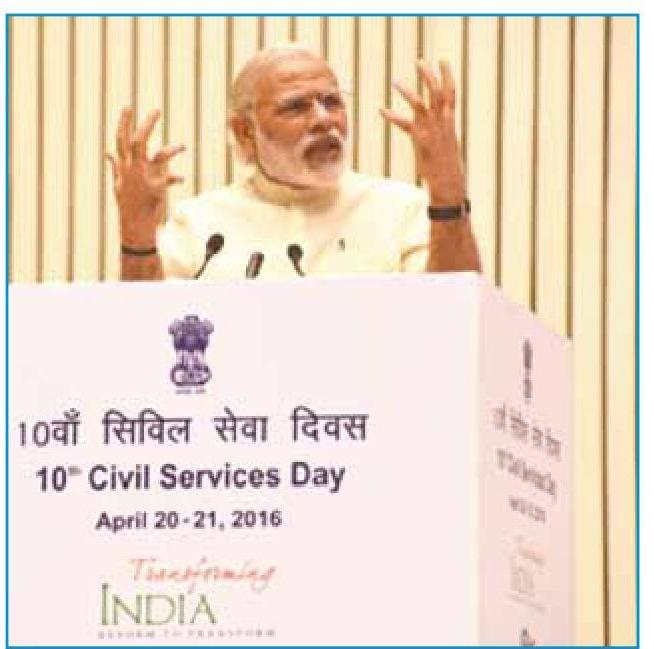
The Prime Minister, Shri Narendra Modi addressing at the $10^{\text {th }}$ Civil Services Day function, in New Delhi on April 21, 2016.
20.2 The PM Award Scheme was revised during
CSD, 2016. Four Priority Programmes namely Pradhan Mantri Jan Dhan Yojna, Swachh Bharat Gramin, Swachh Vidyalaya Abhiyan and Soil Health Card Scheme were identified for the PM Awards presented on CSD, 2016. The Awards were given to 10 best performing Districts in implementing these Programmes. Feedback from more than 3 lakh citizens was obtained through sample surveys, analysis of feedback was done, and field visits of 38 shortlisted districts were conducted while selecting the Awardees.
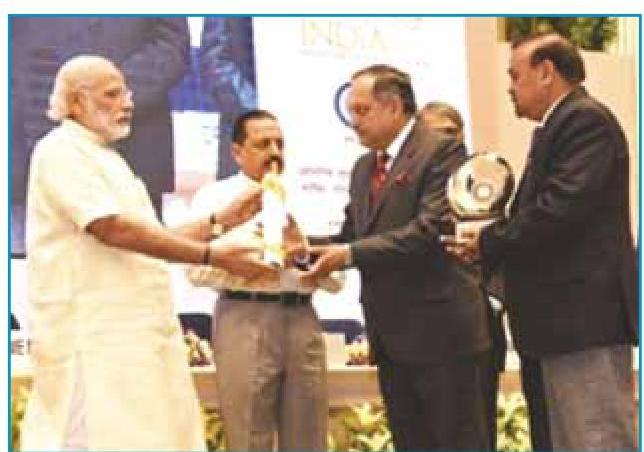
The Prime Minister, Shri Narendra Modi presenting the awards for Excellence in Implementation of Priority Programmes, at the $10^{\text {th }}$ Civil Services Day function, in New Delhi on April 21, 2016.
20.3 Priority Programmes for PM Awards to be given in 2017 are “Pradhan Mantri Krishi Sinchayee Yojana”, “Deen Dayal Upadhayay Gram JyotiYojana”, “Pradhan Mantri Fasal Bima Yojana”, “Start Up India”, Stand Up India” and “e-National Agriculture Market (e-NAM). “Districts / Implementing units are eligible for
Awards on the basis of outstanding work done in implementing these Priority Programmes.
20.4 Awards are also given for Innovations in the field of environment conservation, disaster management, water conservation, energy, education, health, women and child centric initiatives etc. Organisations of Central/State Government including Districts are eligible for Awards in Innovations.
20.5 DARPG has developed a PM Awards portal for online submission of application directly by the Central/State Government organizations. Link of portal is available at DARPG website i.e www.darpg.gov.in.
20.6 Application for PM Awards will be received online on designated portal and will be evaluated by three Committees i.e. Screening Committee chaired by Additional Secretary level officer, Expert Committee chaired by Secretary D/o AR&PG and Empowered Committee chaired by Cabinet Secretary. Citizen’s feedback of shortlisted Districts/ Organisations through Call Centre, on spot study report, presentation / interaction by the Districts will be taken into account in the selection process of PM Awards. Finally selected Districts /organisation will be presented Awards on Civil Services Day to be organised on 21.04.2017
20.7 Finally the Hon’ble Prime Minister selects best performing District/organization for the Award on the basis of recommendation of Empowered Committee.
Civil Services Day
20.8 The Government of India is celebrating April, 21 every year as ‘Civil Services Day’ as an occasion for the civil servants to rededicate
themselves to the cause of citizens and renew their commitment to public service and excellence in work. The first such function was held in Vigyan Bhavan, New Delhi on $21^{\text {st }}$ April, 2006. This date is chosen to commemorate the day when first Home Minister of the independent India, Sardar Vallabhbhai Patel addressed the probationers of Indian Administrative Services Officers in 1947 at Metcalf House, Delhi.
20.9 9 $9^{\text {th }}$ Civil Services Day was organized on $20^{\text {th }}$ and $21^{\text {st }}$ April 2015. PM Conferred 17 Awards for the years 2012-13 and 2013-14. Five Panel Discussions on Health, Nutrition, Education, Skill Development, Housing, Farmers \& Agriculture and Challenges of Civil Servants were organised during the two days function.
$20.10 \quad 10^{\text {th }}$ Civil Services Day was organized on $20^{\text {th }}$ and $21^{\text {st }}$ April 2016. Hon’ble Prime Minister Conferred Awards to 10 Best performing Districts. A short film of 10 Minutes on Awarded Districts was shown. Eight Panel Discussions on Replication of PM Awarded initiatives and 4 Priority Programmes were organised. An Exhibition showcasing Priority Programmes of GoI was organized. Two Books “The Change Makers” and “Transforming India” were released by Hon’ble Prime Minister during the Award function and one Book ‘Recreating Excellence” was released by Hon’ble Railway Minister in Inaugural function.
Replication of PM Award Initiatives of Good Governance in the States and UTs:
20.11 Hon’ble PM desired that Award winning initiatives should be replicated in other parts of the country according to suitability of the States/UTs, so that advantages of best practices in good governance should reach every citizen of
this country. Accordingly, some initiatives have been identified by the States/UTs for replication during the year 2015-16. D/o Administrative Reforms and Public Grievances has engaged Administrative Staff College, Hyderabad to provide technical assistance and hand holding support to the States/UTs in their efforts to replicate these best practices. This project is continuing in FY 2016-17.
State Collaboration Initiatives:
20.12 DARPG provides funds to the State Governments under scheme “State Collaboration initiatives” with a purpose to improve public service delivery. In the year 2014-15, DARPG funded approx. Rs. 13.23 Crores to 13 projects in six States. Scheme was revised in 2015-16 to include funding for replication of PM and National e-Gov. Awarded initiatives. In the year 2015-16, DARPG funded approx. Rs. 2.38 Crores to 9 projects in eight States. In the year 2016-17 (till Oct 2016), DARPG funded approx. Rs. 2.72 Crores to 5 projects in Three States.
20.13 Hon’ble PM desired that Award winning initiatives should be replicated in other parts of the country according to suitability of the States/UTs concerned, so that advantages of best practices in good governance should reach every citizen of this country. Many State Governments/ UTs have identified the best practices/ initiatives to replicate in the respective States/UTs as per their suitability. Department of Administrative Reforms and Public Grievances has engaged Administrative Staff College, Hyderabad to provide technical assistance and hand holding support to the States/UTs in their efforts to replicate these best practices. This project is continuing in FY 2016-17.
Launching of Replication Website of Good Governance Initiatives in the State/UTs
20.14 This Department in association with the ASCI, Hyderabad has developed a portal for replication of Good Governance Initiatives in the State/UTs. Portal has been placed on public domain for use of State/UTs Governments on their replication efforts. The link of the website is available at http://www.pmawardsreplication.in/ ASCI.php.
State Collaboration Initiatives:
20.15 DARPG provides funds to the State Governments under scheme “State Collaboration initiative” with a purpose to improve public service delivery. In the year 2014-15, DARPG funded approx. Rs. 13.23 Crores to 13 projects in six States. Scheme was revised in 2015-16 to include funding for replication of PM and National e-Gov. Awarded initiatives. In the year 2015-16, DARPG funded approx. Rs. 2.38 Crores to 9 projects in eight States. In the year 2016-17 (till December, 2016), DARPG funded approx. Rs. 2.82 Crores to 5 projects in Three States.
Chapter 21
PUBLIC GRIEVANCES
MANDATE
The Public Grievances Division is responsible for issuing policy guidelines and coordinating & monitoring of issues regarding redress of public grievances and staff grievances for the Central Government. In accordance with federal principle of governance, the grievances relating to States are forwarded to concerned State Government for appropriate action. The PG Division also coordinates the implementation of Sevottam which is a part of citizen centric quality management framework for better service delivery.
21.1 The Allocation of Business Rules, 1961, allocates to DARPG inter alia, the responsibility for Policy, Coordination and Monitoring of issues relating to (a) Redress of Public Grievances in general and (b) Grievances pertaining to Central Government Agencies, in particular. The Public Grievance Division is responsible for this activity since December 1987. From 1997, the Division has also been made responsible for several Citizen Centric Initiatives under the platform of ‘Responsive Government’. These include Citizens’ Charter, Information Facilitation Counters, and Quality Management System (QMS) framework called Sevottam, for bringing improvement in public service delivery on a continuous basis, that may result in Certification under Indian Standard 15700:2005 by Bureau of Indian Standards.
21.2. The management of Public Grievances today envisages reduction in arising of grievances, by bringing continuous improvement in Public Service Delivery through the extension of Quality Management System ‘Sevottam’ at the Centre as well as in the States. Statutory backing
for improvements in service delivery was sought to be given through the ‘Right of Citizens For Time Bound Delivery of Goods and Services and Redressal of Their Grievances Bill, 2011’ that had been introduced in the Lok Sabha on 20.12.2011. It lapsed with the dissolution of $15^{\text {th }}$ Lok Sabha. It is now proposed to initially implement a Scheme for Delivery of Services and Redress of Public Grievances.
21.3. The Public Grievances Division has undertaken the following activities during the year and before:-
21.3.1 GRIEVANCE REDRESS:
(i) An online system for grievance redress, called the ‘Centralized Public Grievance Redress and Monitoring System’ (CPGRAMS) has evolved since 2007. At present its upgraded version 5.0 is accessible at http://pgportal.gov.in and also through www.darpg.gov.in. It interlinks 139 Ministries/Departments/States/UTs and other Apex organisations in CPGRAMS. There are 26400 sub-ordinate users listed on it which includes subordinate and field offices also.
The number of subordinate users linked to CPGRAMS has increased from about 1500 in
2010-11 to over 26000 in 2016-17. CPGRAMS is also available in Hindi.
Grievance Receipts/disposal in CPGRAMS as on 31-12-2016
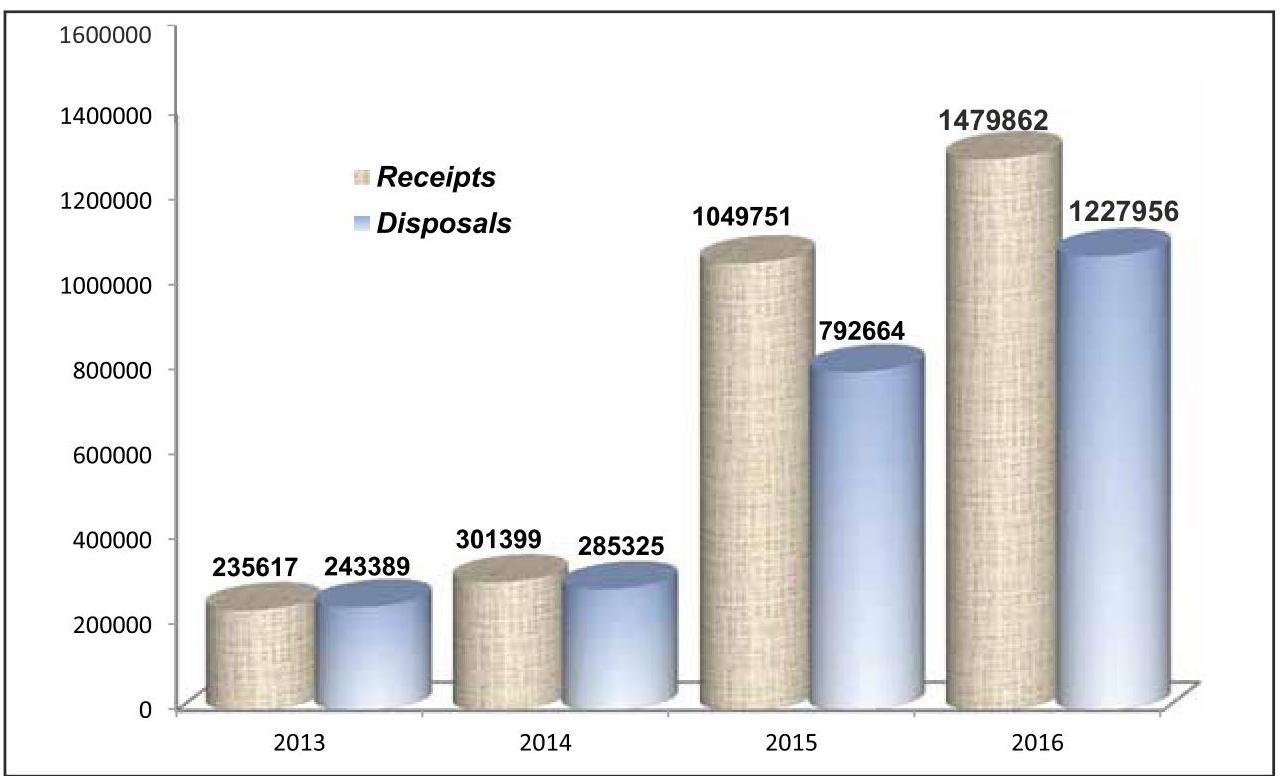
State Govt.
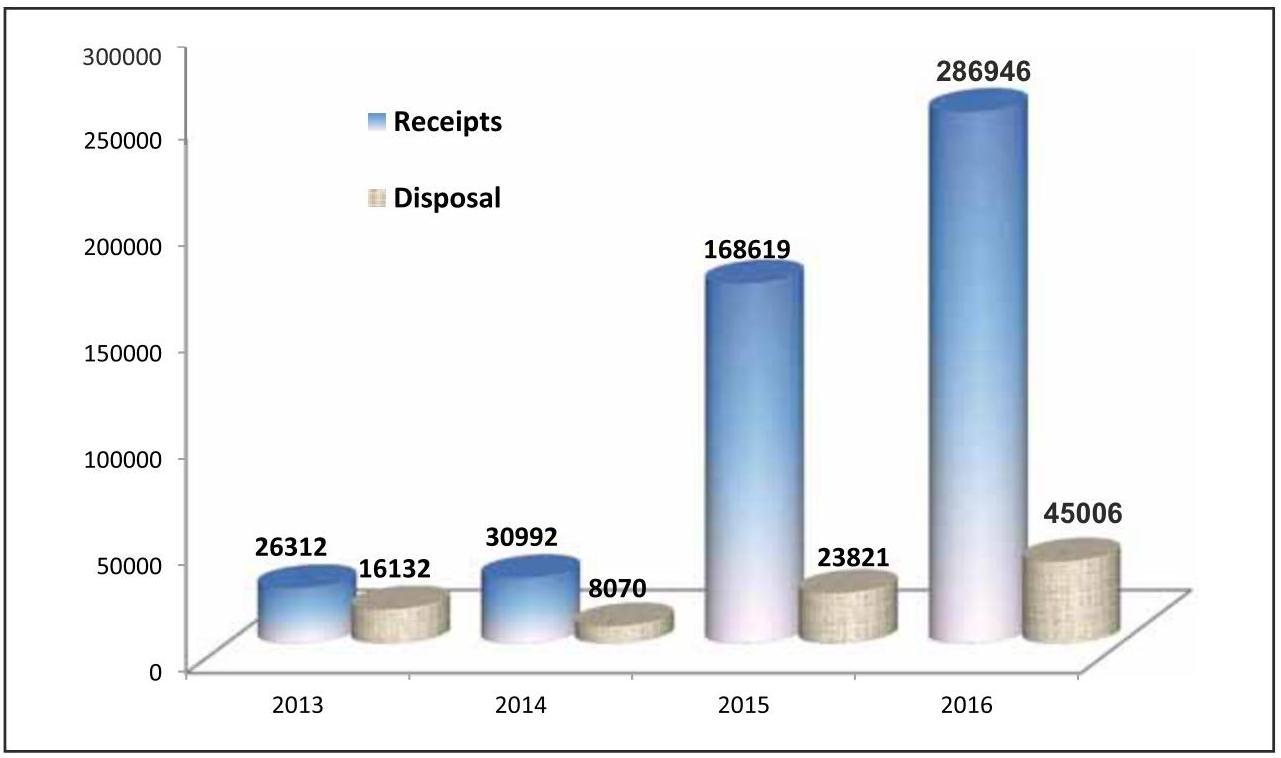
Central Govt.
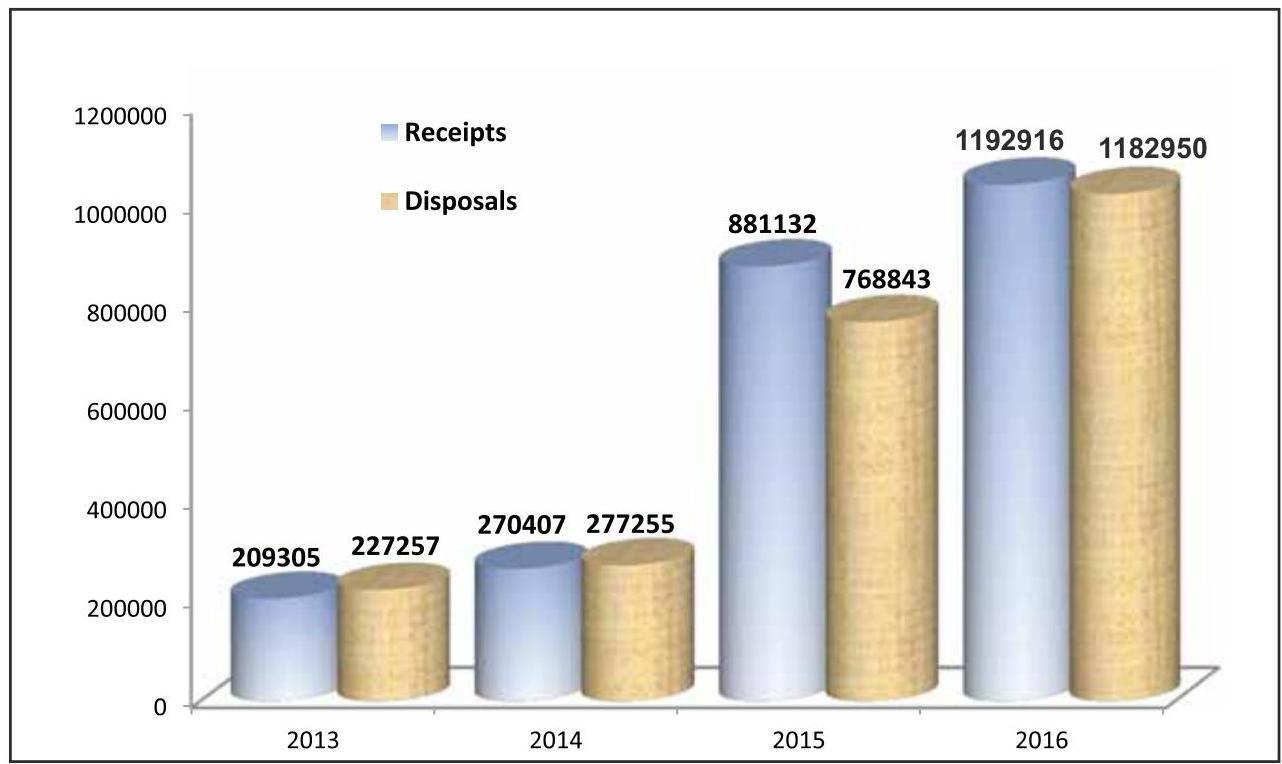
Figure Snapshot of PG Portal version 5.0 in English.
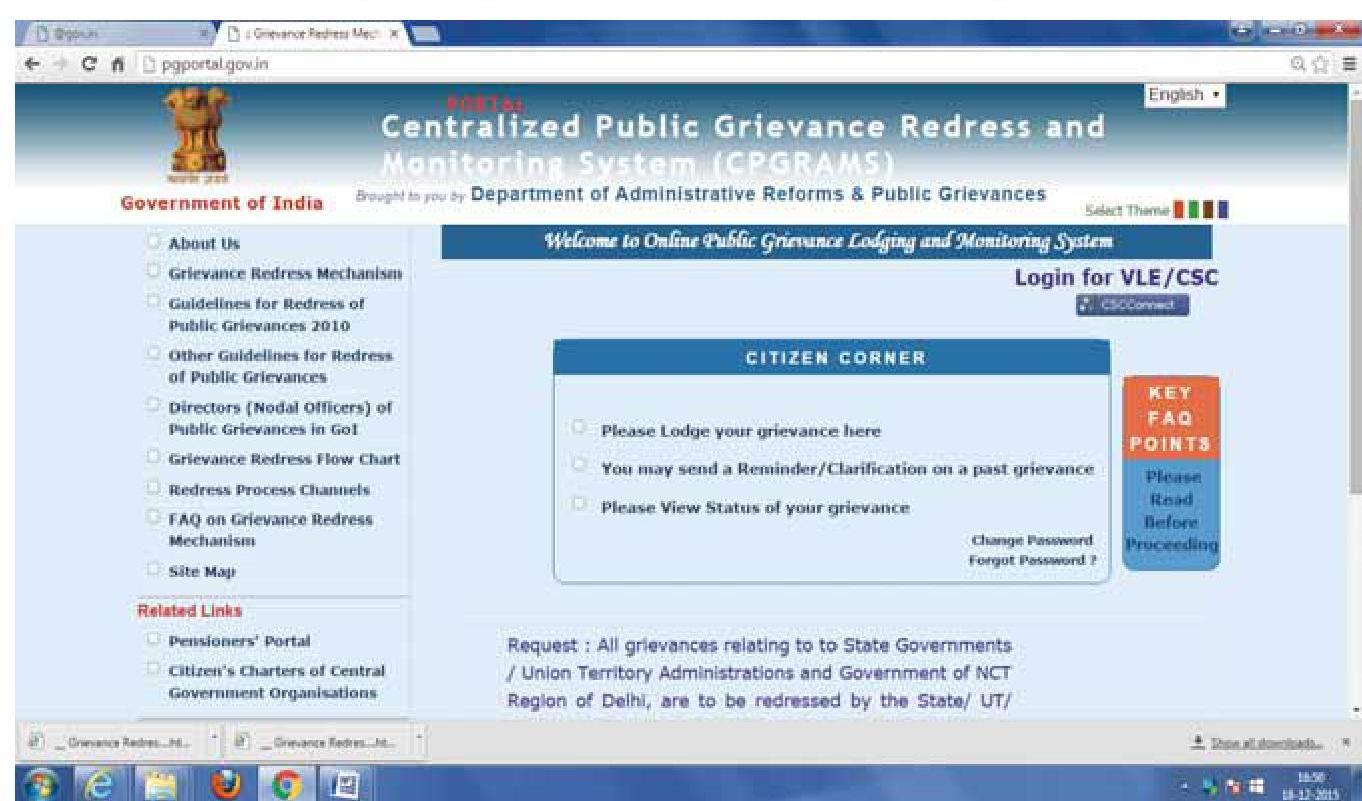
Figure Snapshot of PG Portal version 5.0 in Hindi.
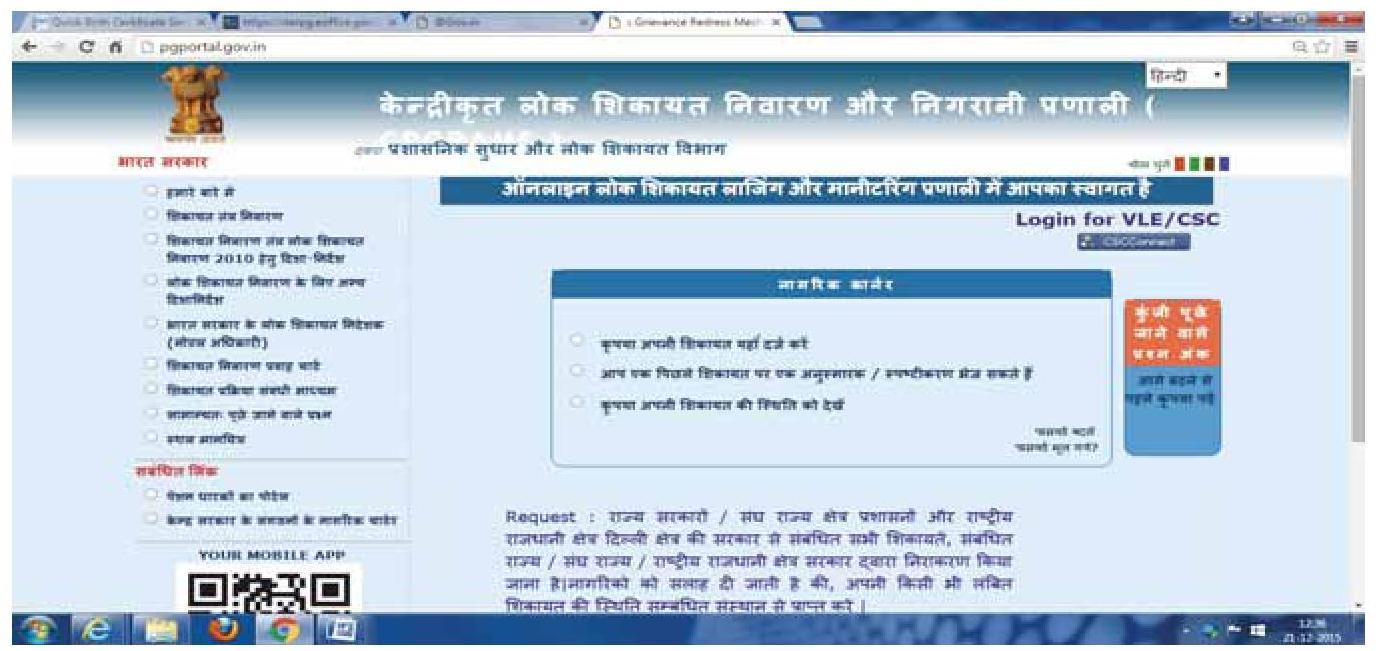
(ii) A meeting was held with the officials of 12 State Governments on 29.9.2016 for their input on Implementation of Right to Services Act in States. During the meeting, the participants also furnished the status of implementation of selfattestation and nomination for PM Awards in respective States.
(iii) The Department of Administrative Reforms and Public Grievances has received Quality Management System Certification 15700:2005 from the Bureau of Indian Standards (BIS). The Certification is a mark of Sevottam compliance. The Second Surveillance Audit was held in the Department by representative of BIS on 24.10.2016 and 25.11.2016. The working of the license was reported to be satisfactory.
(iv) For providing grass root access to the pg portal, the Common Services Centres
have been duly integrated with CPGRAMS. Now a person can lodge a grievance on the pg portal through the Common Services Centre located in his area by paying a nominal fee.
(v) Further improvement in the Mobile App that was launched on 21.10 .2015 by the Hon’ble MoS(PP) is now in process. Beta version of the Mobile App with more user friendly inter-faces and provision for one time registration has been prepared.
(vi) For proper monitoring, the classification of grievances has been reviewed and fresh categorization done by dividing the grievances into 20 main categories which can be further mapped to specific categories by the Ministries/ Departments concerned as per the subject matter being handled by them. Further drop down choices have also been provided by giving
the names of subordinate organizations under some of the respective Ministries/ Departments for the convenience of petitioners.
(vii) As per the recommendations of Department related Parliamentary Standing Committee, Grievance Analysis Study of the next 20 Ministries/ Departments listed on CPGRAMS receiving large number of grievances has also been started
(viii) A National Workshop on Implementation of Right to Services Acts in States/UTs
was held in Jammu during 11-12.11.2016. It was inaugurated by Dr. Jitendra Singh, MoS(PP). The Workshop was organized in collaboration with D/o Public Policy and Public Administration, Central University of Jammu and attended by Senior Officers from 17 States/UTs who made detailed presentations on the subject and also participated in the panel discussions. On the occasion, a Report of Research and Evaluation Study on the Prime Minister’s Awarded initiatives, conducted by IIDM, Bhopal was also released by MoS(PP).
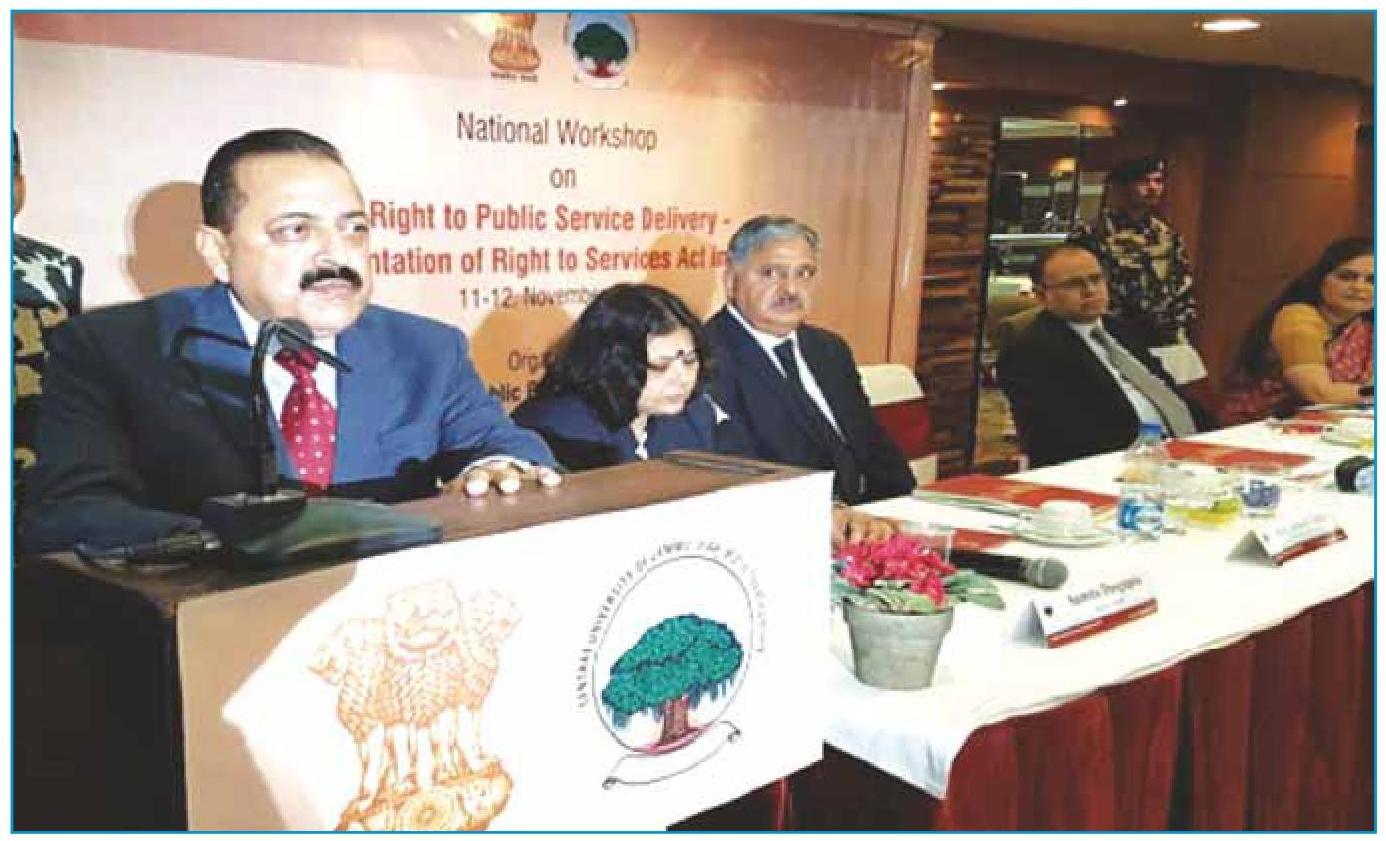
MoS(PP) addressing the gathering at National Workshop in Jammu
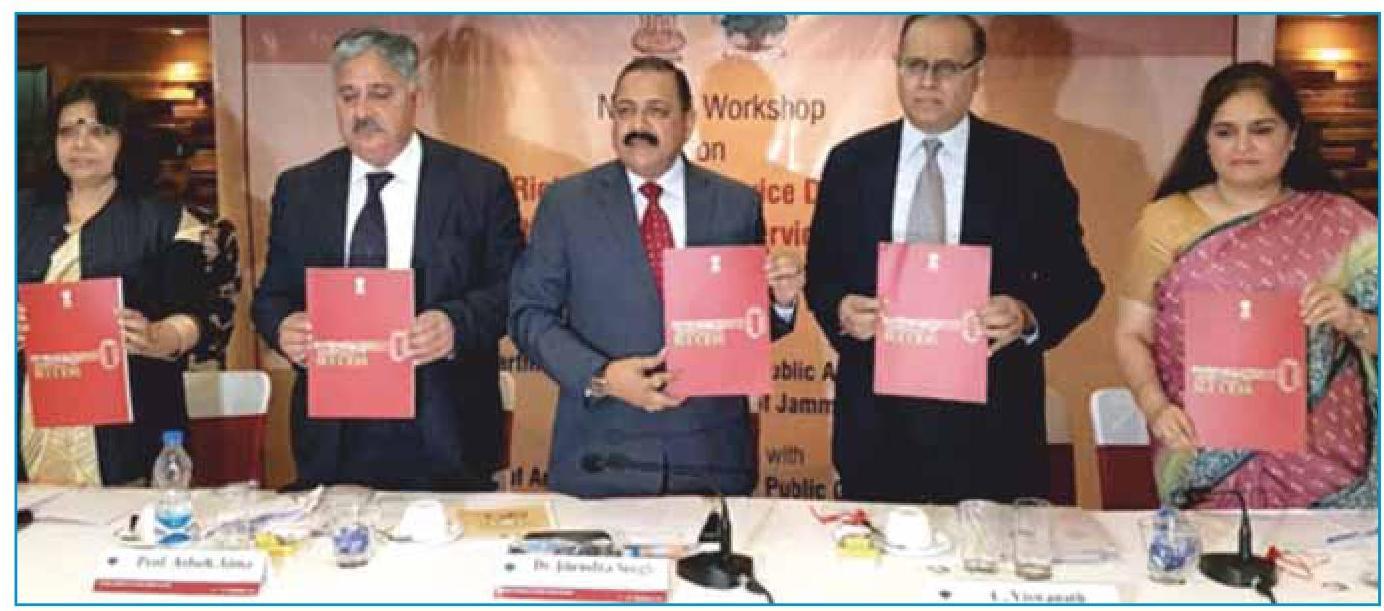
Book Release during the National Workshop at Jammu
(ix) Dashboard has been created for all the heads of the Ministries/Departments for accessing the relevant information pertaining to pendency of grievances in the respective Ministries/Departments and Subordinate Organizations affiliated to them on CPGRAMS. User-ids and passwords have been duly provided to all concerned.
(x) Draft Scheme for Delivery of Services and Grievance Redress has been prepared and was submitted to Cabinet Secretariat for consideration of Committee of Secretaries. Based on the directions of the Cabinet Secretariat, further action on the Scheme is under process.
(xi) For better monitoring, the formats of analytical reports generated online through CPGRAMS have been duly modified and additional reports created for the purpose. The colour coding of the Ministries/Departments have been done
as per their performance on CPGRAMS. The format now includes receipts, disposals and $%$ disposals with reference to cases pending for 2-6 months, 6-12 months and more than one year.
(xii) Reports of the Grievance Analysis Study conducted by Quality Council of India for identifying grievance prone areas, root cause analysis and systemic reforms in respect of top 20 grievance receiving Ministries/Departments/ Organizations listed on pg portal were duly circulated to the concerned Ministries/ Departments/ Organizations. For further action on recommendations, a Project Management Unit (PMU) has been set up in the Department for monitoring the reforms. A number of reforms have already been introduced by some of the Ministries/ Departments viz., automatic refunds on cancellation of Railway Tickets, Single Window Pension through disbursing
Banks, intensive mechanized cleaning of coaches, e-verification of Income Tax Returns, expeditious Income Tax Returns upto Rs. 50,000/- etc.
(xiii) Extending CPGRAMS to State Governments/Union Territories. The codes for using the CPGRAMS, through the Internet, have been provided to all State Governments. During the year, the Division has extensively used the System to forward public grievances to the State Governments concerned. From $1^{\text {st }}$ January 2016 to 31.12 .2016 a total of 8946 grievances have been sent to State Governments by D/o ARPG. Out of these 6888 were received electronically, and 2058 were received by post or given in person by the complainant. The inflow of State related grievances is in two forms (i) Through the CPGRAMS and (ii) through post. The grievances received by post are digitized and sent both through the System as well as by post to the State Government concerned. Redress response as received is sent by post, to the complainant.
(xiv) A Public Grievances Call Centre was started on pilot basis for reminding the concerned officials of 20 Ministries/ Departments/Organizations receiving maximum grievances. The PG Call Centre also collected feedback on some of the grievances disposed through CPGRAMS. Based on the pilot, the PG Call Centre has been extended till the end
of March, 2017. It is now reminding 40 Ministries/Departments for expediting action on public grievances.
(xv) During the year 2016, 5 review meetings were held for reviewing the status of pending public grievances in Ministries/Departments and expediting action on them. A total of 73 Ministries/Departments/Organizations participated. Two more reviews are also proposed to be held during 2016-17.
(xvi) An Award Scheme has been launched for recognising performance on CPGRAMS through issue of Certificate of Appreciation. The Scheme not only takes into consideration the number of grievances disposed by the Ministries/ Departments/Organizations, but also the feedback of the petitioners whose grievances have been closed in the System. Certificate of Appreciation was issued by the MoS(PP) on 2.6.2016 for the last quarter of 2015 and first quarter of 2016 to three Departments each viz., D/o Land Resources, M/o Skill Development & Entrepreneurship, D/o Financial Services and D/o Official Languages, D/o Consumer Affairs and D/o School Education and Literacy. For the second quarter of 2016, the certificate was issued to three Departments viz., D/o Chemicals and Petrochemicals, D/o Expenditure and D/o Defence on 4.10.2016.
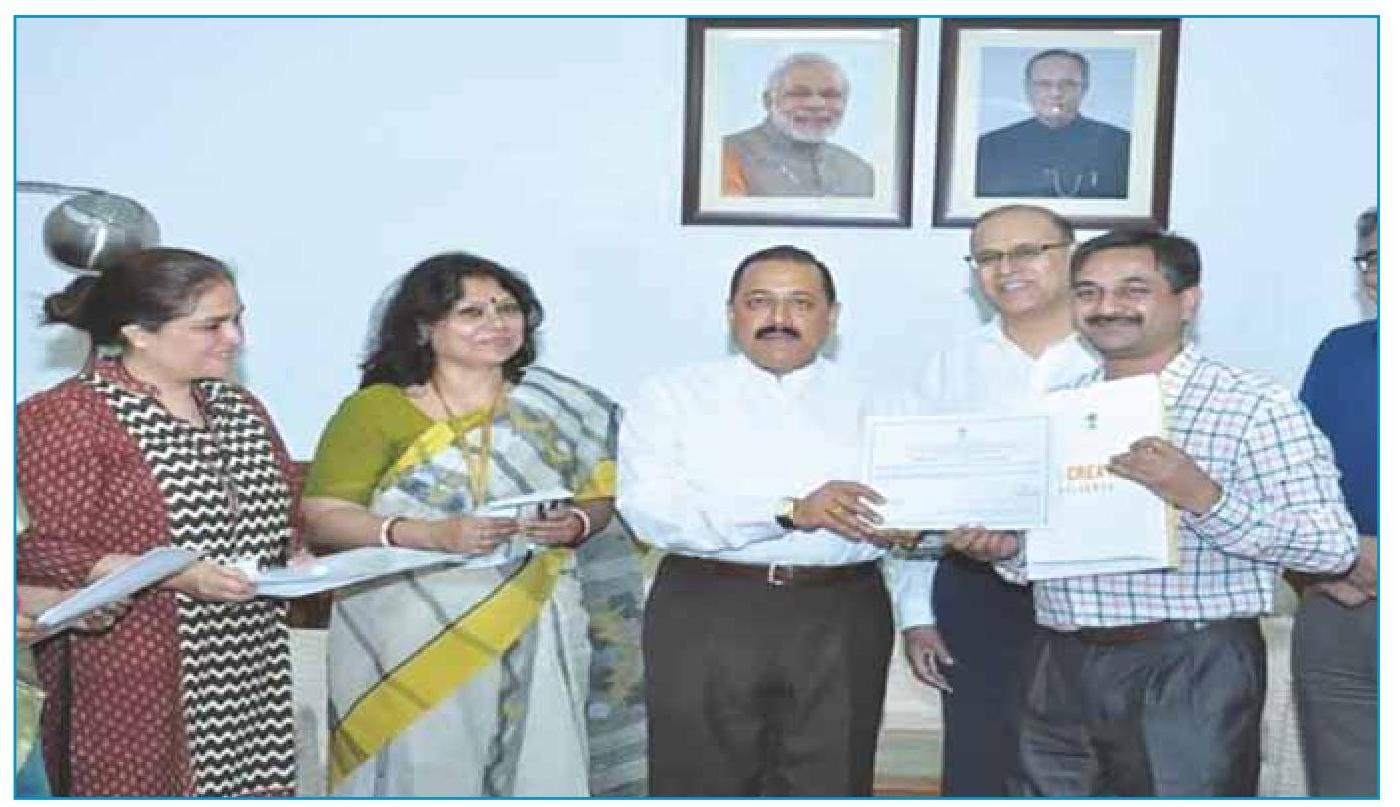
MoS (PP) with the Awardees who received the Certificate of Appreciation
xvii) During the year 2016, operational trainings on CPGRAMS have been regularly held in the Department on the last working Tuesday of every month.
(xviii) CPGRAMS with local language interface to State Governments/Union Territories. CPGRAMS with local language interface, has so far been launched in all departments of the Governments in the 8 States of Haryana (www.harsamdhan.gov.in), Orissa (www.cmgcorissa.gov.in) Rajasthan (www.sugamrpg.raj.nic.in), Mizoram (http://mipuiaw.nic.in), Meghalaya (http://megpgrams.gov.in), Union Territory of Puducherry (http://puduvaikural.puducherry.gov.in), Jharkhand (http://jharkahandsamadhan. nic.in) and Punjab (http://shikay atnivaran.gov.in.
21.3.2 PUBLIC SERVICE DELIVERY
Introductory:
(i) Quality Management System (QMS) Sevottam framework for bringing excellence in service delivery by Government organizations: A Quality Management System (QMS) ‘Sevottam’ framework has been developed for bringing improvements in the quality of public service delivery. This is a citizen centric initiative for institutionalizing an assessment-improvement framework for improving the quality of service delivery on a continuous basis through the involvement of Ministries / Departments and citizens. Sevottam includes three dimensions of a public service organization as follows: (a) Citizen’s / Client’s Charter that specifies the service delivery standards (b) Grievance Redress Mechanism that gets activated if the service delivery is not as per standards in the charter (c)
Service Delivery Capability of the organization to deliver service as per standards in the charter.
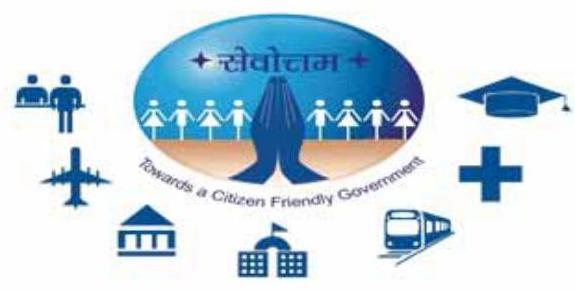
The logo adopted for Sevottam
(ii) Implementation of Sevottam has resulted in the certification under Indian Standard 15700:2005 for 17 offices under D/o Posts, 39 offices of CBDT/CBEC under D/o Revenue, as well as one office each under D/o Financial Services, Govt. of Uttar Pradesh, Kerala and Goa.
(iii) Strengthening of State Administrative Training Institutions and Central Training Institutions as part of capability building for time bound delivery of public services in the States. Under the Sevottam (Plan) pilot projects, a new Scheme for Strengthening of the State ATIs and CTIs, has been started from October 2012, for building capacity of the ATI to become consultants for implementing Quality Management System ‘Sevottam’ in all departments of the State Government, including replication of best practices from other States / UTs. For Sevottam Training Cells in the ATIs hardware has been purchased. 27 Faculty Members/ Consultants were trained in the first 2day Training of Trainers (ToT), on $18^{\text {th }}$ and $19^{\text {th }}$ September, 2013. Seven of these
ATIs viz. Himachal Pradesh, Uttar Pradesh, Punjab, Rajasthan, Haryana, Delhi and Tamil Nadu have been visited by the officers of PG Division for ground report on the working of Sevottam Cell in these States. A number of on-campus and off-campus training have been held by the ATIs for sensitising the officers of the State Government in implementation of Citizens’ Charter and Grievance Redress Mechanism. A meeting for reviewing the performance of the State ATIs was held in the Department on 16.6.2016. The ATIs have been told to achieve specific targets for implementation of Citizens’ Charter in the State Government and also facilitate certification of some specific departments under IS 15700:2005.
(iv) Based on the utilization certificate received and performance, the next installment of grant under the above scheme have been released during the year to the 5 State ATIs viz. Madhya Pradesh, Haryana, Rajasthan, Tamil Nadu and Punjab.
(v) A meeting of the Department related Parliamentary Standing Committee was held in the Parliament House Annexe on 8.2.2016 for reviewing the Public Grievance Redress Mechanism. A detailed presentation was made by Secretary, ARPG regarding the status and steps taken for further improvement which was appreciated by the Members.
21.3.3 CITIZENS’/CLIENTS’CHARTERS
i) The Citizens’/Clients’ Charters (CCC) was first introduced simultaneously in
Central Departments and in all State governments in May, 1997. In 2005, the CCC has been included as a module in QMS Sevottam Framework.
The Citizen/Client charter of DARPG for 2015-16 has been prepared and duly uploaded on the web site of the Department. The Contact details of the officers was updated during the year.
The Department related Parliamentary Standing Committee on Personnel, Public Grievance, Law & Justice visited Kolkata on 13-15.6.2016 and subsequently Bengaluru, Chennai and Bhopal from 19 to 25.6.2016 and Kochi on 19.12.2016 for inter alia reviewing the implementation of Citizens’ Charter and Grievance Redress Mechanism in the offices of Central Government. As per the recommendations, all the Ministries/ Departments have been advised to ensure that the Citizens’ Charter in respect of the Ministries/ Departments and also Subordinate Organizations are duly uploaded on the respective websites and updated periodically.
12.3.4 Main Initiatives of PG Division in
-
Grievance analysis study by Quality Council of India in respect of next 20 grievance receiving Ministries/ Departments/ Organizations listed on CPGRAMS.
- Setting up of a Project Management Unit (PMU) for monitoring reforms in 20 Ministries/Departments/Organizations for which the reports were circulated earlier.
- National Workshop on Implementation of Right to Services Act in the States held in Jammu during11-12.11.2016.
- A Public Grievances Call Centre for expeditious action on public grievances.
- Intensive review meetings and frequent trainings on CPGRAMS were held during the year 2016.
- A Twitter Seva is also under consideration for facilitating highlighting of issues/ grievances relating to this Department by concerned individual.
Chapter 22.
ORGANISATION AND METHODS DIVISION
MANDATE
- Formulation and simplification of common office procedures.
- Publication and updating of the paper based Central Secretariat Manual of Office Procedures (CSMOP), electronic based Central Secretariat Manual of e-Office Procedure (CSMeOP) and Record Retention Schedule (RRS).), electronic based
- Aiding and advising the Central Ministries/Departments and States/UTs Governments on O&M aspects.
- Implementation of the Plan Scheme of Modernization of Central Government offices located in the city of Delhi.
The Central Secretariat Manual of e-Office Procedure (CSMeOP)
22.1 With a view to integrate the Central Secretariat Manual of e-Office Procedure (CSMeOP) with e-Office procedure; the Department engaged the service of ISTM to prepare the second edition of the CSMeOP. The ISTM has submitted a draft of the CSMeOP, which is under consideration of the Department. The CSMeOP is expected to be released during this financial year. An inter-Ministerial Committee headed by the Additional Secretary, Department of Administrative \& Public Grievances has given its recommendations regarding Record Retention Schedule (RRS) of digitized records. The instructions on the subject are expected to be released during the financial year 2016-17 itself.
The Modernisation of Government Offices Scheme
22.2 In order to give catalytic effect to modernization of offices as an overall process of Administrative Reforms, the DARP\&G is implementing a Plan Scheme for Modernisation of Government offices located in the city of Delhi since the year 1987-88.
22.3 Under the Scheme the Department provides $75 %$ financial assistance of the total cost of the project, based on recommendations of Inter-Ministerial Screening Committee and the beneficiary has to chip in with $25 \%$ of the cost. Since the year 1987-88 to till date the DAR\&PG has extended a financial assistance of about Rs. 72.40 crores for financing 453 of modernization proposals. During the current Financial Year, DAR\&PG proposes to release Rs. 4.21 crores for financing 7 modernisation proposals.
Chapter 23
E-GOVERNANCE
National Conference on e-Governance
23.1 Department of Administrative Reforms and Public Grievances and Department of Electronics & Information Technology in association with one of the State Governments has been organizing the National Conference on e-Governance every year since 1997. This Conference provides a platform to the senior officers of the Government including IT Secretaries of State Governments, IT Managers of the Central Government, and Resource Persons, Experts, Intellectuals from the industry and academic institutions etc. to discuss, exchange views and experiences relating to various eGovernance initiatives.
23.2 Price Waterhouse Coopers Pvt. Ltd. (PWC) developed Case studies on selected e-Governance award winning initiatives viz., (i) SAMAGRA Portal- An initiative to implement Integrated Social Security Programme by creating a common integrated programme to facilitate paradigm shift from conventional demand model of governance. (ii) Track Child Online Tracking System for Missing Children (iii) Lost Report Application (iv) Delhi Traffic Police Mobile Application (v) BhamahahYojana/Financial Inclusion (vi) An initiative ASH Soft (The online Payment \& Monitoring System) Rajasthan State for their adoption/adaptation by various States/UTs.
23.3 The $20^{\text {th }}$ National e-Governance Conference was organized in Vishakhapatnam,
Andhra Pradesh on 9-10 th January, 2017 jointly by the Department of Administrative Reforms \&
Public Grievances, Ministry of Electronics \& Information Technology and State Government of Andhra Pradesh. The main theme of the Conference was “Digital Transformation”. During the conference, the National eGovernance Awards were given under 12 categories of excellence in the field of eGovernance. On the occasion, the Department also released for publications viz. (i) Background paper; (ii) Compendium of selected papers; (iii) Excellence in Governance; and Citations for National e-Governance Award Winners.
e-OFFICE
23.4 DAR\&PG is the nodal Department for implementation of e-Office project in Central Ministries/Departments. National Informatics Centre (NIC) is the technical partner of DARPG in this project. The e-Office Mission Mode Project (MMP) was launched in 2011-12 in phased manner. DARPG provides financial assistance to the Ministries/Departments for eoffice implementation.
23.5 Since the year 2011-12 upto till date DAR\&PG has extended financial assistance for eOffice implementation to 26 Ministries/ Departments through NIC/NICSI, the details of which are as under.
(2011-12)
| (i) | Ministry of Information \& Broadcasting |
|---|---|
| (ii) | Ministry of Labour and Employment |
| (iii) | Department of Fertilizers |
| (iv) | Department of Land Resources |
|---|---|
| (v) | Ministry of Urban Development |
| (vi) | Department of Chemicals and Petrochemicals |
| (vii) | Department of Financial Services |
| (viii) | Department of Revenue |
| (ix) | Ministry of Mines |
| (x) | Ministry of Panchayati Raj |
| (xi) | Department of Pension and Pensioners’ Welfare |
| (xii) | Ministry of Home Affairs |
| (2012-13) | |
|---|---|
| (i) | Department of Heavy Industries |
| (ii) | Department of Science and Technology |
| (iii) | Ministry of Parliamentary Affairs |
| (iv) | Department of Official Language |
| (v) | Department of Personnel and Training |
(2013-14)
| (i) | M/o Small & Medium Enterprises (MSME) – part |
|---|---|
| (ii) | Department of Agriculture and Cooperation |
| (iii) | Department of Rural Development |
| (iv) | Ministry of Steel |
| (v) | Office of Controller General of Patents |
| (vi) | Office of Register General of India |
| (vii) | Department of Consumer Affairs |
2015-16
| (i) | M/o Small \& Medium Enterprises (MSME) part |
|---|---|
| (ii) | Ministry of Steel |
2016-17
| (i) | Central Information Commission |
|---|---|
| (ii) | Department of Commerce |
23.6 Effective steps have been taken by DAR\&PG to expedite implementation of e-office in all central Government Ministries/Departments by conducting regular review meetings and also by establishing a project monitoring unit in the Department. 11 Central Ministries and Departments have already implemented $100 %$ e-office and a total 54 Ministries/Departments are expected to implement $100 \%$ e-office by $31^{\text {st }}$ March, 2017.
Workshop on e-Office
23.7 A workshop was organized to sensitize the Indian Administrative Service Officers of the 2013 Batch, who were deputed to the Central Ministries/Departments as Assistant Secretaries on deputation basis. They can play a pivotal role for initiating faster implementation of e-Office in their respective State Governments. Officials of all the Ministries/Departments of the Government of India also attended the workshop so as to learn about the process of implementation of e-Office.
23.8 In the workshop NIC made a presentation on e-office. Ministry of Panchayati Raj, which has achieved $100 \%$ target of e-office implementation, made a presentation on their success story. Department of Rural Development which achieved $80 \%$ target of e-office implementation at that time also made a presentation on their success story.
23.9 The Workshop was a success. A fruitful interaction took place and suggestions made in the interactive session of the meeting. The IAS probationers and officials of the Central Ministries/Departments were impressed upon the need to implement e-Office at the earliest possible time.
Chapter 24
INTERNATIONAL EXCHANGE AND COOPERATION
24.0 The Department of Administrative Reforms & Public Grievances (DARPG) deals with matters relating to international exchange and cooperation in the field of Public Administration and Governance, which includes, among other things, organizing programmes and visit of Indian delegations to foreign countries and visit of foreign delegations to India as part of projects / bilateral measures in furtherance of activities included in the Memorandum of Understandings (MoUs) / Agreements signed between India and other countries (bilateral or multilateral).
24.1 The aim of international exchange and cooperation component is to share information, best practices and personnel across national governments. Presently MoUs in the areas of Public Administration and Governance have been signed with seven countries, viz. France, Malaysia, Singapore, United Kingdom, China (bilateral), Brazil and South Africa (under IBSA trilateral). MoUs with China and Singapore are under renewal. MoU with these countries has enabled exchange of visits and undertaking programmes/projects and activities in the field of Civil Services, Personnel Management, Public Administration and Governance.
Cooperation with International Institute of Administrative Sciences (IIAS)
24.2 The Department is an institutional member of the International Institute of Administrative Sciences (IIAS) since 1998. IIAS
was established for the purpose of promoting the development of Administrative Sciences, better organization and operation of public administrative agencies, improvement of administrative matters and techniques and for the progress of International Administration. Additional Secretary (DARPG) is on the Council of Administration of IIAS in ex-officio capacity. Additional Secretary (DARPG) has been nominated Vice President for South East Asia and the Pacific region of IIAS for the term 2016-19. The membership enables the Government of India in getting information on the latest development in the field of public administration through participation in international meetings and seminars organized by the IIAS as well as through various journals, documents and study reports prepared/issued by them.
Cooperation with Commonwealth Association for Public Administration and Management (CAPAM)
24.3 The Commonwealth Association for Public Administration and Management (CAPAM), is a membership organization dedicated to strengthening public management and consolidating democracy and good governance throughout the Commonwealth. Since inception, CAPAM has grown to a network of over 1100 members across the Commonwealth countries. The Department became an institutional member of CAPAM in 1997. Secretary of the Department is on the Board of Directors of CAPAM.
24.4 The membership enables the Government of India to keep pace with the latest developments in the field of public administration, through participation in various programmes of CAPAM viz; International Innovations Awards Programme, International Innovations Cascading Programme, International Meetings, Seminars and Conferences organized by CAPAM, as well as through various publications, journals and study reports issued by CAPAM.
24.5 Secretary, Department of Administrative Reforms and Public Grievances was elected on Board of Directors of CAPAM for the term 2016-18.
24.6 CAPAM recognizes and promotes good governance through its award programmes given under four categories. The CAPAM International Innovations Awards celebrate the spirit of innovation in the public service by recognizing organisations that have made significant contributions to improving governance and services in the public sector.
24.7 India was the best performer and won $75 %$ of the total CAPAM awards. Out of 12 best initiatives shortlisted by the CAPAM, 6 pertained to Government of India and out of 6 shortlisted initiatives, following 3 initiatives won the CAPAM awards
(i) LADO (An innovative initiative for eradicating child marriages), Madhya Pradesh (PM Award 2013-14).
(ii) Scaling up Cervical Cancer Screening, Chennai, Tamil Nadu (PM Award 2008-09)
(iii) Revival of Sasur Khaderi – 2 Rivulet and its Origin Thirthora Lake in District Fatehpur, Uttar Pradesh (PMAward 2013-14)
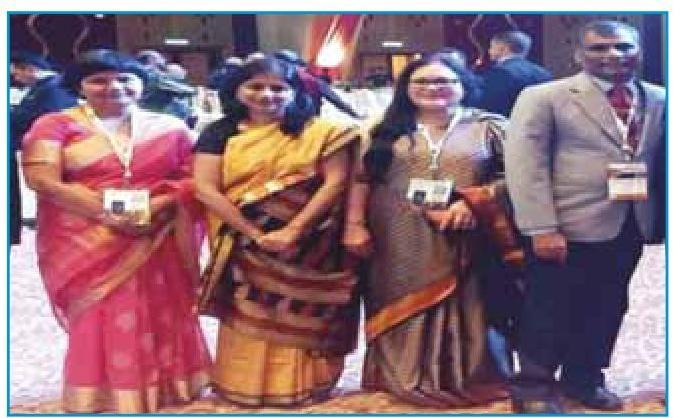
Indian Awardees during Awards presentation ceremony at Putrajaya, Malaysia during CAPAM Conference 2016
24.8 Out of four categories of CAPAM Innovation Award Programme 2016, India won CAPAM awards in three categories. Further, CAPAM’s one and only gold medal also went to the India for the Initiative “Scaling-Up Cervical Cancer screening” at the CAPAM Conference.
India-Brazil-South Africa (IBSA) Forum
24.9 Recognizing the emergence and consolidation of India – Brazil – South Africa (IBSA) initiatives and collaboration at regional and global level for promoting good governance and wishing to strengthen South-South cooperation, the three countries acknowledged that joint efforts and collaboration will position them as active players in helping to direct public administration and governance towards democratic values and social inclusion.
24.10 The Prime Minister of India, the President of Brazil and the President of South Africa met in Brasilia (Brazil) in September 2006 for the 1st Summit meeting of the India-Brazil-South Africa Dialogue Forum. Pursuant to the IBSA Summit decision as contained in the Joint Declaration issued on the occasion, an IBSA Working Group on Public Administration (WGPA) has been set up by the three countries. It has since held seven
meetings and adopted the areas of cooperation (i) integrated monitoring and evaluation, (ii) egovernance, (iii) human resource development, (iv) citizen oriented service delivery, (v) anticorruption and ethics, and (vi) accountability and transparency. Collaboration in these areas represents the essence of the MoU which was signed in October, 2007 in South Africa, during the $2^{\text {nd }}$ IBSA Summit.
24.11 The $7^{\text {th }}$ WGPA meeting was held in New Delhi in March 2011, where the Working Group decided a way forward in terms of an Action Plan for implementing the MoU in identified areas of interest.
India-China Cooperation
24.12 MoU on cooperation in the field of Civil Services, Personnel Management and Public Administration between Department of Administrative Reforms and Public Grievances, Government of India and the Ministry of Human Resources and Social Security of the People’s Republic of China was signed in May 2010 during the visit of President of India to China. Areas of Cooperation under the MoU are – (i) capacity building and skills upgradation, (ii) improved systems of public service delivery, (iii) human resources development – civil services, (iv) human resources management in public sector and (v) public sector reforms. It has since held four India-China Joint Working Group meetings, the last bilateral meeting was held in November 2013.
24.13 MoU with Government of China lapsed in May, 2015. Cabinet gave its approval to the signing of Memorandum of Understanding (MoU). Ministry of External Affairs is exploring the possibility of signing of the MoU by Ambassador of People’s Republic of China in
India on behalf of Chinese side and Secretary, DARPG, on behalf of Government of India.
India – Singapore Cooperation
24.14 As a part of its international collaborative efforts, the Department of Administrative Reforms and Public Grievances (DARPG) explored the possibility of sharing and exchanging administrative experiences with Singapore, particularly in the area of public administration and delivery of services, so as to improve upon the current system of governance and instill a greater sense of responsiveness, accountability, transparency.
24.15 Given the fact that high among the priorities of the two countries are public service reforms and good governance, a Memorandum of Understanding (MoU) between the two countries on cooperation in the field of Personnel Management and Pubic Administration was signed in November 2011. The areas of cooperation are – (i) capacity building and skills upgrading, (ii) improved systems of public service delivery, (iii) human resources management, (iv) public sector reform, and (v) leadership/talent development.
24.16 Two Joint Working Group meetings between the two countries under the MoU have been held, the last one was held in January 2015. .
24.17 Under the aegis of MoU and Programme of Action (PoA) agreed between the two sides during the India Singapore $2^{\text {nd }}$ Joint Working Group meeting, a 4-day training programme for a Group comprising 25 officers of Government of India and States/UTs including PM/National eGovernance Award winners was organized on the theme e-governance in Civil Services College, Singapore in July, 2016.
Indo-Malaysia Cooperation
24.18 An MoU on cooperation in the field of Public Administration and Governance was signed in November, 2013. Areas of Cooperation under the MoU in the field of Public Administration and Governance are – (i) human resources management, (ii) improved systems of public service delivery, (iii) e-governance, (iv) accountability and transparency, (v) capacity building and skills up-grading, (vi) quality of outcome, (vii) governance reforms of both countries, and (viii) any other areas of cooperation in the field of Public Administration and Governance to be jointly decided by the Participants Subsequently.
24.19 India-Malaysia third Joint Working Group Meeting on Public Administration and Governance was held in Kuala Lumpur, Malaysia in September 2015 to carry forward the implementation of MoU signed between the two countries. In furtherance to the Programme of Action agreed during Joint Working Group Meeting (a) 15 officers of Government of India / States and UTs including recipients of Prime Minister’s Award (Category I – Excellence in Implementing a Priority Programme) attended the training programme at National Institute of Public Administration (INTAN), Kuala Lumpur, Malaysia. in July, 2016; and (b) Ministry of Skill Development nominated 2 officers for ASEAN Skill Competition (ASC) 2016 held in Kuala Lumpur, Malaysia in September, 2016. Both the training programmes were funded by Government of Malaysia.
India – United Kingdom Cooperation
24.20 Department of Administrative Reforms and Public Grievances, has signed a MoU with the
Cabinet Office, Her Majesty’s Government of the United Kingdom (HMG), for ‘Cooperation in Public Administration and Governance Reforms’ in November, 2015.
24.21 The main objectives of the MoU are to strengthen and promote bilateral cooperation between the two countries in public administration and governance. The areas of co-operation under this MoU includes (i) sharing good governance practices in public administration, (ii) user led service design, (iii) reducing bureaucracy in service delivery, (iv) government process re-engineering, (v) building and developing staff capability, (vi) public grievance redress mechanism, (vii) local government reforms, (viii) reforms towards strengthening of social security, (ix) collaboration in strategies for promotion of ethics in Government, (x) collaboration between Government and industry on staff management, (xi) mechanisms for public engagement, (xii) crisis and disaster management and (xiii) digital transformation of government.
24.22 India-UK First Joint Working Group meeting was held in London, UK in January, 2016. Both sides shared their best practices in the area of public administration, governance reforms and online delivery of citizen-centric services and explored the possibilities of adopting suitable best practices in these areas.
24.23 Subsequently, a team comprising 4 senior Government Digital Service Officers led by Mr. Andy Beale, Chief Technology Officer, HMG, were in India in September, 2016 for a ‘scoping’ visit to firm up on the joint action plan on eGovernance, under the India-UK MoU on Public Administration and Governance Reforms.
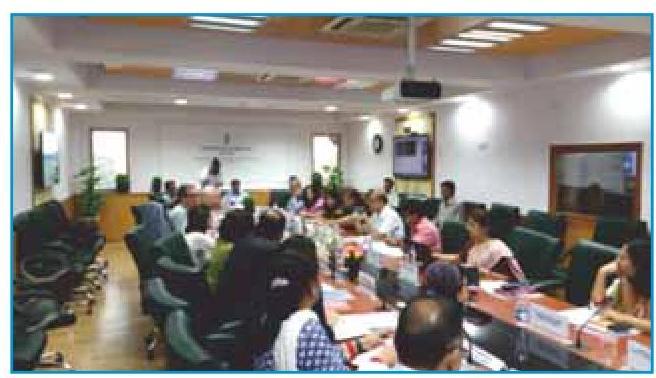
24.24 The 3-day visit started with an open -house presentation in presence of senior representatives from Central Departments, Govt. of India, chaired by Secretary, Department of Administrative Reforms and Public Grievances.
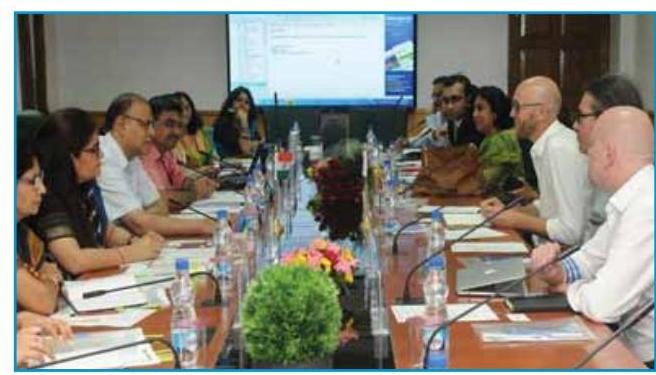
24.25 During the meeting, both sides discussed and shared best practices in e-governance, citizen-centric online delivery of services, good governance practices in public administration, user led service design, Government Process Reengineering etc. UK delegation made a presentation on “User-centricity Digital outreach Analytics”. From Indian side, presentations on (i) Initiatives under Retirement Benefit Scheme of Indian Civil service (ii) India’s experience in eProcurement (iii) e-Office implementation and (iv) Centralized Public Grievance Redress and Monitoring System (CPGRAMS) were made. The presentations were followed by openhouse/interactive session where officers of both the sides exchanged ideas. The GDS team also
visited Bangalore and was briefed on the significant state level developments around IT infrastructure, public procurement, e participation and online service delivery.
Partnership Agreement with Government of France
24.26 The Department of Administrative Reforms and Public Grievances, Ministry of Personnel, Public Grievances & Pensions has signed a Partnership Agreement in January, 2016 with Ministry for Devolution and Civil Service of the Government of France on ‘Public Administration and Administrative Reforms.
24.27 The main objectives of the Partnership Agreement are to strengthen and promote bilateral cooperation between the two countries in public administration and governance. The areas of co-operation under this Partnership Agreement includes, cooperation in the field of civil services, human resource management, public administration and administrative reforms for mutual benefit of the official and institutional level, in such areas as the Parties agree upon.
24.28 The first India-France First Joint Working Group meeting under the Partnership Agreement was held in June 2016. Both sides exchanged/ shared views in the area of public administration, governance reforms and online delivery of citizen-centric services and explored the possibilities of adopting suitable best practices in these areas.
GOI-UNDP Project “Strengthening Public Administration and Governance”
24.29 The Department of Economic Affairs on behalf of Government of India and United National Development Programme (UNDP) have
signed the Country Programme Action Plan (CPAP) 2013-2017. CPAP 2013-2017 is also aligned with the main aims of the Government’s $12^{\text {th }}$ Five Year Plan and with the 2013-2017 United Nations Development Action Framework (UNDAF).
24.30 Department of Administrative Reforms & Public Grievances (DARPG) is implementing partner for the Project titled “Strengthening of Public Administration and Governance” under Country Programme Action Plan (CPAP) 20132017. The project is fully funded by UNDP with a commitment of US$ 1 million for activities under the Project during 2013-17.
24.31 The Project aims to achieve (a) improved capabilities of institutions and individuals responsible for public administration and governance, deeper understanding of administrators on factors that contribute to success or failure of service delivery under Government programmes, and increased cooperation in the area of public administration globally including the South-South context.
24.32 Under the ongoing partnership with UNDP, the Department of Administrative Reforms and Public Grievances (DARPG) is working towards enhancing India’s ranking in the UN e-Government Survey. The UN eGovernment Survey is released bi-annually by the UN Department of Economic and Social Affairs (UNDESA). It is the global report that assesses the e-government development status of the 193 UN Member States. The survey serves as a tool for decision-makers to identify their areas of strength and challenges in e-Government and to guide e-government policies and strategies.
24.33 According to United Nations e-
Government Survey 2016, India’s rank has improved in the UN e-governance index. The Survey has shown India’s progress on the eGovernment Development Index, with a ranking of 107 out of 193 countries as against 118 in 2014. In E-participation, India ranks 27 as against 40 out of 193 in 2014. India ranks very high on the Online Services Index (OSI) with a score that increased from 0.5433 in 2014 to 0.7464 in 2016.
24.34. In order to further improve India’s ranking in the UN e-Government Index, a separate National Service Portal (http://services.india.gov.in/) has been launched by the National Informatics Centre (NIC). For this purpose, a 3-day Workshop with State/UTs and select Ministries/Departments of Government of India was organized in November, 2016 in New Delhi in conjunction with UNDP and NIC during which focused discussions were held on the online services of Ministries/Departments of Government of India and States/UTs with a view to refine the taxonomy based on the inputs from the participating Ministries/Departments / States \& UTs to adopt the taxonomy and metadata approach and link the services to the http://services.india.gov.in/ portal.
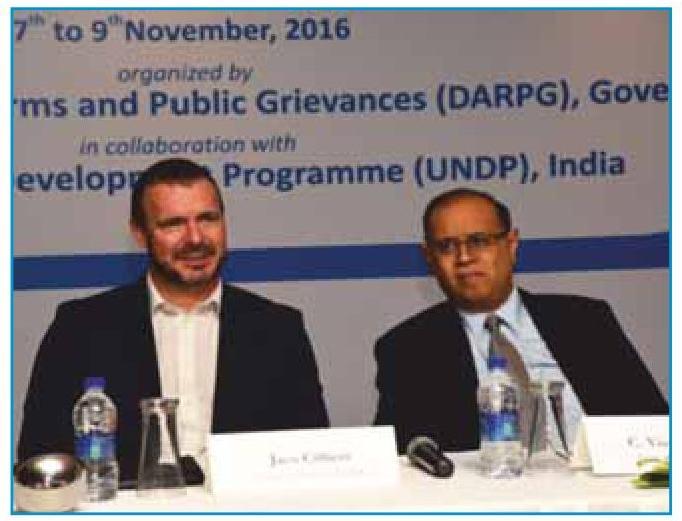
Foreign Training Programme for Senior/Middle Level Management Officers of Government of India and States/UTs
24.35 As part of its international collaborative efforts, Department has been exploring the possibility of learning and sharing the administrative experiences of other countries, particularly in the area of e-Governance and online delivery of public services.
24.36 During this year, the Department has organized two customized short-term Foreign Training Programmes on the theme ‘Minimum Government with Maximum Governance’ through e-Governance based Citizen Centric Online Services, for officers from Government of India and the States/UTs, including PM Award winners/National e- Governance Award winners in the Institute of Public Administration of Canada (IPAC), Toronto, Canada in August 2016 and the PBLQ, The Hague, Netherlands in September, 2016.
24.37 Participation of officers in these training programmes have helped them to understand the system of customer oriented public service delivery in Canada and Netherlands with reference to rapidly changing environments in the area of public service management.
$120^{\text {th }}$ Session of the International Institute of Administrative Sciences (IIAS) Council of Administration
24.38 Ministry of Personnel, Public Grievances & Pensions (Department of Administrative Reforms \& Public Grievances) is an institutional member of the International Institute of Administrative Sciences (IIAS). Additional Secretary/Special Secretary, Department of Administrative Reforms and Public Grievances, Ministry of Personnel, Public Grievances and Pensions, Government of India, represents the Department on the Council of Administration of IIAS. Mrs. Usha Sharma, Additional Secretary, DARPG will participate in the $120^{\text {th }}$ Session of Council of Administration scheduled to be held on 16- 17 February, 2017 in Brussels, Belgium
Chapter 25
DOCUMENTATION AND DISSEMINATION DIVISION
25.1 The Documentation and Dissemination Division of the Department primarily carries out the activities of documentation and dissemination of good governance practices of Central, States and Union Territory Governments with a view to facilitate sharing of experience with one another and replication elsewhere. The activities dealt by the Division are detailed below:-
25.2 Financial Assistance to State Governments/ UT Administrations for professional documentation and dissemination of ‘Good Governance Practices’ : The objective of the Scheme is to provide financial assistance to support professional documentation and dissemination of good governance initiatives by the State/UT Governments with a view to sharing experiences with each other and replicate elsewhere. So far seventy-two projects have been sanctioned. The scheme of providing financial assistance to the State Governments/UT Administrations has been revised w.e.f. financial year 2016-17. The professional documentation report will now be in e-Book form, instead of paper documentation, along with short documentary film and the amount of financial assistance is up to Rs.3.00 lakh.
25.3 Series of Presentations on Best Practices:
In order to facilitate replication of the successful good governance initiatives in other states, an
initiative was taken by the Cabinet Secretary in January 2005 with the introduction of this presentation series on best practices. Champions of the best practices make AV/ Power Point Presentation before senior officers of State Governments and Central Government Departments. 26 such presentations on diverse topics have been made which were well-attended by senior officers from the Central as well as State Governments.
25.4 Organizing Regional Conferences on “Learning from successes”: Regional
Conferences are organized on specific themes in association with various State/ Union Territory Governments with a view to bring National and State level organizations along with other stakeholders including NGOs, intelligentsia and media on the same platform to share experiences in the formulation and implementation of good governance practices. This year, $24^{\text {th }}$ Regional Conference on the theme “Path-Breaking and High Impact Initiatives undertaken by the States in Citizen Centric Services Delivery System” was held in the month of September, 2016 at Guwahati, Assam. The proceedings of the Regional Conference held at Guwahati are available on the department website i.e. www.darpg.gov.in.
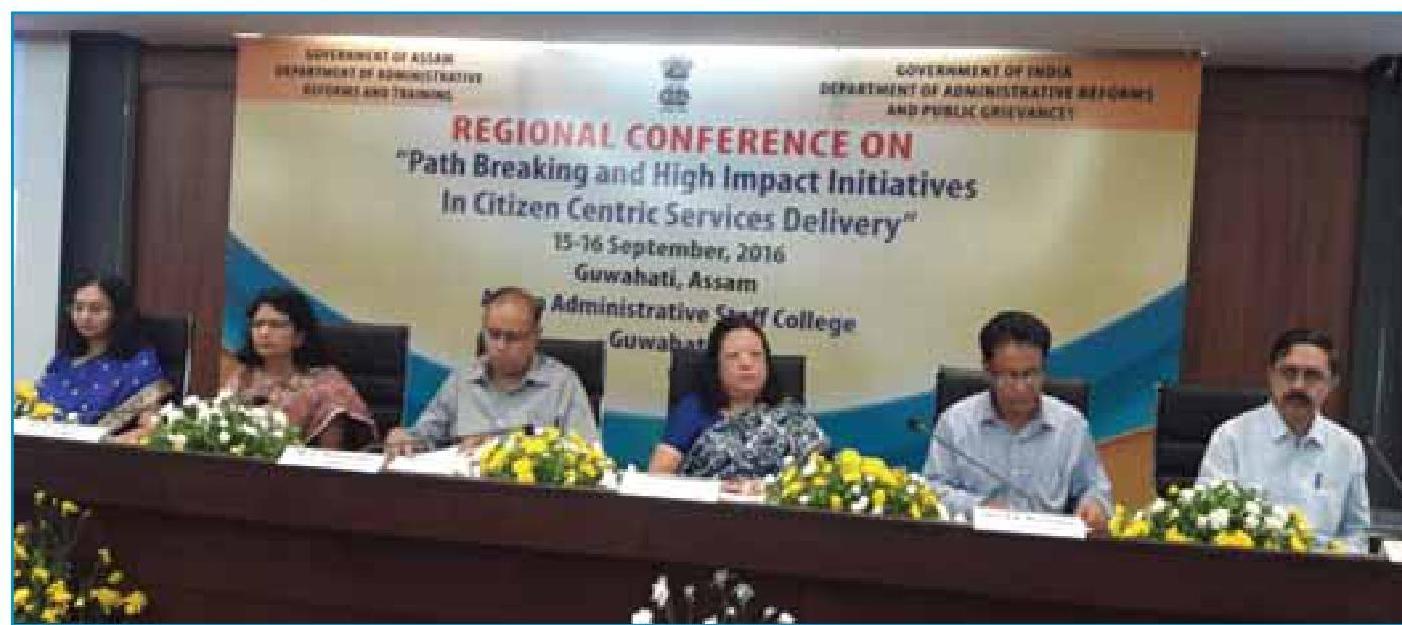
Shri C. Viswanath, Secretary, Department of Administrative Reforms & Public Grievances, in the two-day Regional Conference on “Path-Breaking and High Impact Initiatives undertaken by the States in Citizen Centric Services Delivery System”, in Guwahati, Assam on September 15, 2016.
25.4.1 This year, $25^{\text {th }}$ Regional Conference on the theme “Innovations in Citizen Centric Services Delivery” was held in the month of December, 2016 at Jaipur, Rajasthan. The presentations of the
Regional Conference held at Rajasthan are available on the department website i.e. www.darpg.gov.in.
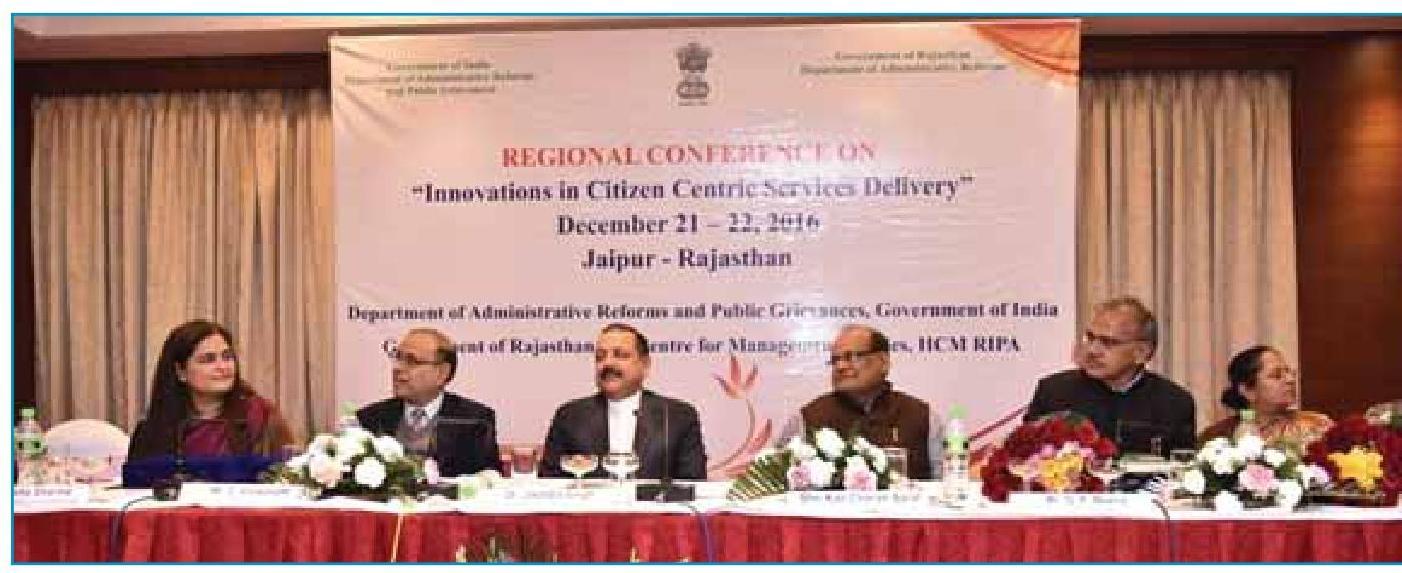
Smt. Usha Sharma, Additional Secretary, Department of Administrative Reforms and Public Grievance, Government of India; Shri. C. Viswanath, Secretary, Department of Administrative Reforms and Public Grievance, Government of India; Dr. Jitendra Singh, Minister of State (MoS) (Independent Charge) for the Ministry of Development of North Eastern Region, Prime Minister Office, Personnel, Public Grievances and Pensions, Department of Atomic Energy and Department of Space, Shri Kali Charan Saraf, Hon’ble Minister, Medical and Health, Government of Rajasthan; Shri O.P. Meena, Chief Secretary, Government of Rajasthan; Ms. Gurjot Kaur, Director General, Dr. HCM RIPA, Jaipur in the two-day Regional Conference on “innovations in Citizen Centric Services Delivery”, in Jaipur, Rajasthan on 21-22 December, 2016.
2016-2017
25.5 Publication of Books : This Division publishes books containing articles on select award winning good governance practices. These articles are on the initiatives which have been conferred Prime Minister’s Award or National eGovernance Awards. The Division has already
published a series of books on the subject. This year, three books namely ‘The Change Makers’, ‘Re-creating Excellence’ and ‘Transforming India’ have been published and released on the occasion of Civil Services Day, 2016.
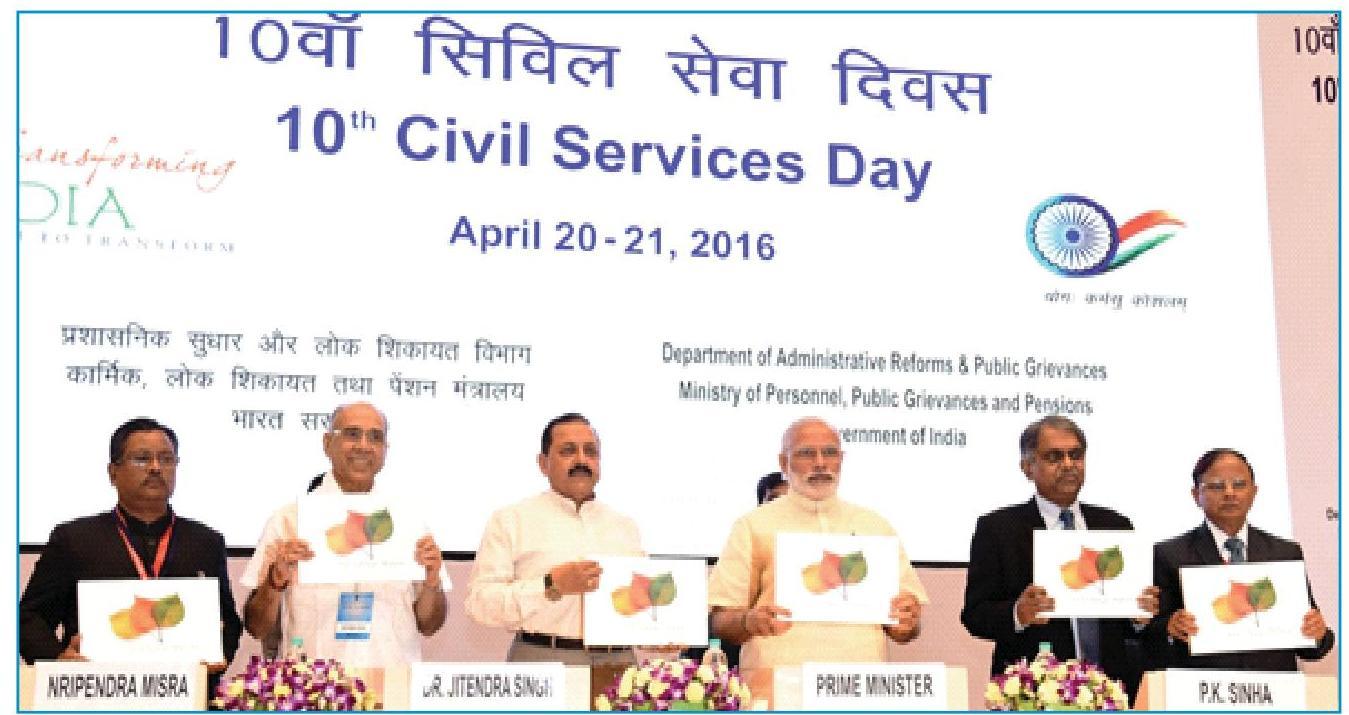
Shri Narendra Modi, Hon’ble Prime Minister of India releasing the book “The Change Makers” on the occasion of $10^{\text {th }}$ Civil Services Day held on 20-21 st April, 2016.
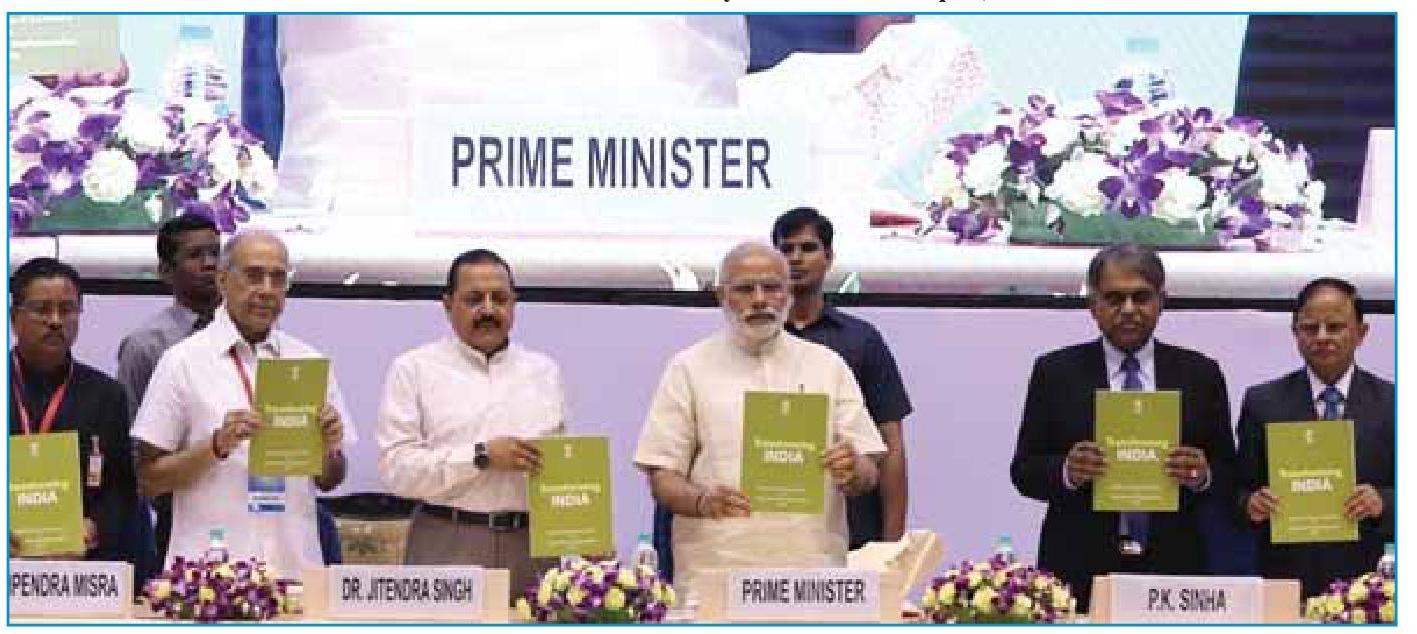
Shri Narendra Modi, Hon’ble Prime Minister of India releasing the book “Transforming India” on the occasion of $10^{\text {th }}$ Civil Services Day held on 20-21 st April, 2016.
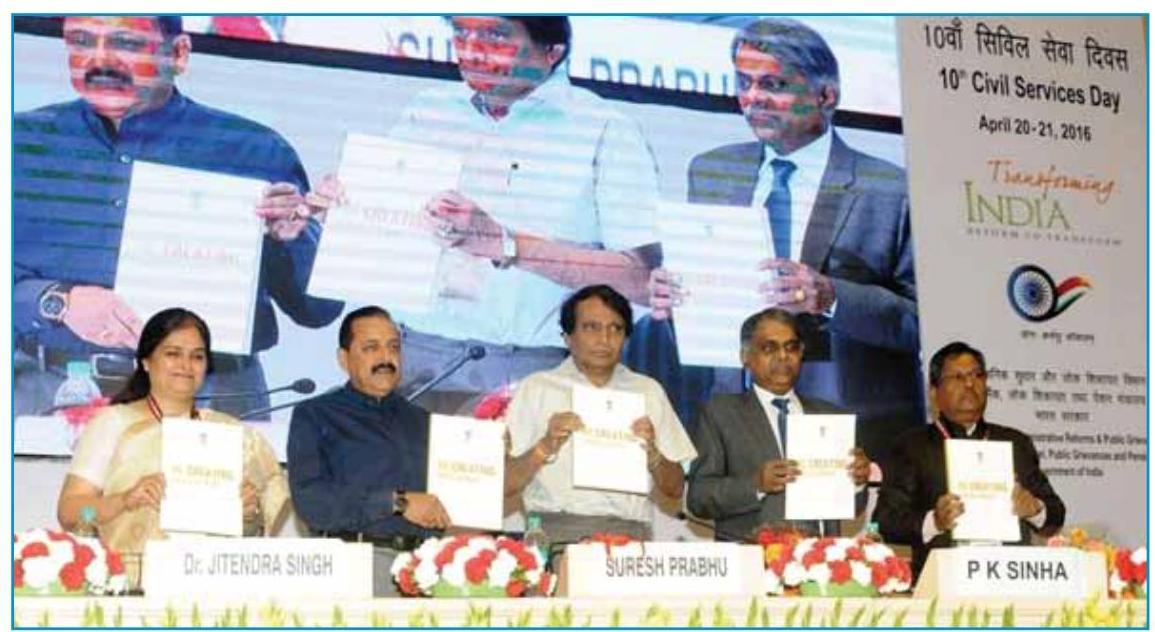
Shri Suresh Prabhu, Hon’ble Minister of Railways and Dr. Jitendra Singh, Hon’ble MoS, Development of North Eastern Region (I/C), Prime Minister’s Office, Personnel, Public Grievances & Pensions, Department of Atomic Energy, Department of Space releasing the book “Re-creating Excellence” on the occasion of $10^{\text {th }}$ Civil Services Day held on 20-21 April, 2016.
Exhibition on the occasion of Civil Services Day, 2016.
25.6 An exhibition on priority programmes of the Government was inaugurated by Dr. Jitendra Singh, Hon’ble MoS, Development of North Eastern Region (I/C), Prime Minister’s Office, Personnel, Public Grievances \& Pensions,
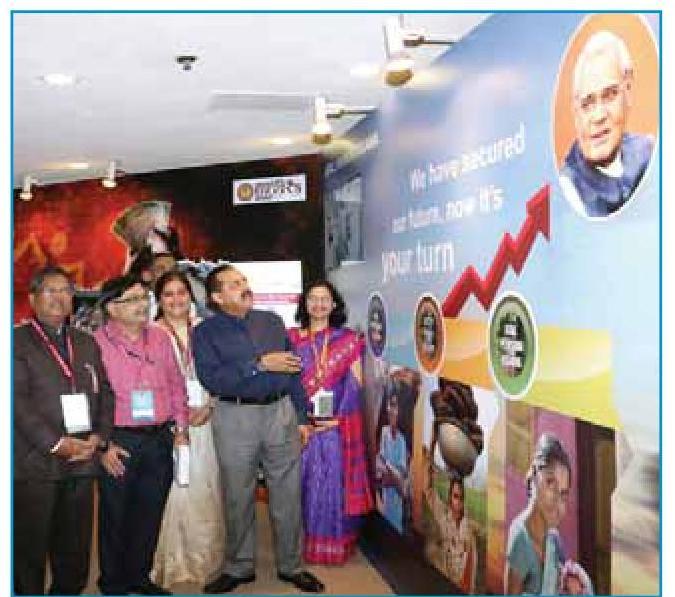
Department of Atomic Energy, Department of Space on the occasion of $10^{\text {th }}$ Civil Services Day held on 20-21 April, 2016.
25.7 Production of Documentary Films on Best
Practices: The Department is engaged in producing documentary films on best practices across the country. These films are immensely useful for the administrators as they facilitate dissemination of success stories and their replication. Seventy three such documentary films have been already produced so far. In current financial year, one film on 10 Awarded districts for excellence in implementing four priority programmes has been produced. One film on 10 select e-Governance initiatives was produced through DAVP for screening in the $20^{\text {th }}$ National Conference on e-Governance, scheduled on $9^{\text {th }}$ $10^{\text {th }}$ January, 2016 at Visakhapatnam. These films are available on the Department’s website, as well
as social media platforms such as twitter and facebook.
25.7.1 Two Panel discussions on Excellence in implementation of four priority programme of the Government of India were organized and telecast on DD National Channel on $21^{\text {st }}$ and $22^{\text {nd }}$ May, 2016. These discussions are also available on the Department’s website as well as social media platforms such as twitter and facebook.
25.8 Research & Evaluation Studies on Good Governance Initiatives: A Research and Evaluation Study on select 12 good governance
initiatives has been conducted by Indian Institute of Development Management, Bhopal for the year 2015-16. The report has been released by Dr. Jitendra Singh, Hon’ble MoS, Development of North Eastern Region (I/C), Prime Minister’s Office, Personnel, Public Grievances \& Pensions, Department of Atomic Energy, Department of Space on $12^{\text {th }}$ November, 2016 during the National Workshop on Public Grievances Redressal System held at Jammu. Soft copy of the report of Research \& Evaluation Study is available on the Department website i.e. darpg.gov.in.
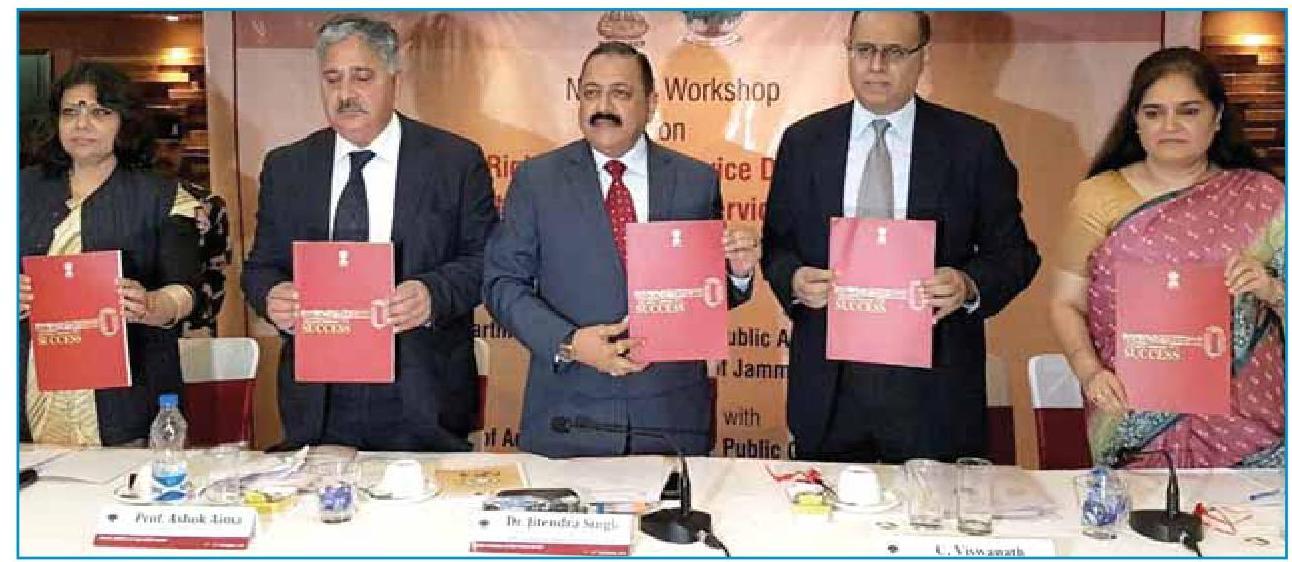
Dr. Jitendra Singh, Hon’ble MoS, Development of North Eastern Region (I/C), Prime Minister’s Office, Personnel, Public Grievances \& Pensions, Department of Atomic Energy, Department of Space releasing the Research \& Evaluation Study report.
25.9 Publication of ‘Minimum Government Maximum Governance’ – A biennial Journal: Department of Administrative Reforms and Public Grievances is bringing out a periodical journal “Management in Government” (MIG) since 1969 and now renamed “Minimum Government – Maximum Governance” and launched first e-Book” on 22.10.2015. The
DARPG has published 6 issues till date based on the best practices which were conferred Prime Minister Award for Excellence in Public Administration and National e-Governance Awards. The e-Book “Minimum Government – Maximum Governance” is available on the website of the Department at http://darpg.gov.in/journal-MGMG.
Chapter 26
HINDI SECTION
- Hindi Section of the Department of Administrative Reforms and Public Grievances is committed to comply with various guidelines issued by the D/o Official Language to promote the usage of Hindi language in the office.
- The main function of the Section is to render Hindi translation of the works given by various sections/officers of the Department and implementation of the official language Policy, which mainly include compilation of quarterly reports received from various sections of the Department and send it in an integrated form to the D/o Official Language in time; organizing quarterly meeting to discuss these reports,
organizing workshop and Hindi fortnight in the month of September every year. In addition, all the officers/sections are made aware of the guidelines issued from time to time by the D/o Official Language in connection with promotion of Hindi and their compliance is also ensured. Hindi Pakhwada was organized in the Department in September, 2016 wherein various competitions were held. i.e. Essay writing competition, Noting drafting competition, Translation and wordphrases and General Knowledge etc. Many officers/employees participated in these competitions and merit certificates and cash prizes were given to the winners of these competitions.
Chapter 27.
DEPARTMENT OF PENSION AND PENSIONERS’ WELFARE
MANDATE
27.0 The Department of Pension & Pensioners’ Welfare was set up in 1985 as part of the Ministry of Personnel, Public Grievances and Pensions to formulate policy and coordination of matters relating to retirement benefits of Central Government employees (Civil, Defence and
Vision
Active and dignified life for Pensioners
Mission
- Formulation of Pension Policy.
- Timely and Smooth payment of pension and other retirement benefits for Central Government Employees.
- Simplification of rules/guidelines and procedure and their dissemination.
- Facilitating prompt redressal of the pension related grievances.
Railway Pensioners). The Organisational Chart is at Annexure-VI and Incumbency position of Group ‘A’ Officers is at Annexure-VII. As per the Citizen’s Charter of Department of Pension \& Pensioners’ Welfare, the ‘Vision’ and ‘Mission’ are given below: - Promoting the welfare of pensioners.
27.1 The Department administers the following rules:
i. CCS (Pension) Rules, 1972
ii. CCS (Commutation of Pension) Rules, 1981
iii CCS (Extra-ordinary Pension) Rules 1939
iv. GPF(CS) Rules, 1960.
v. CPF (India) Rules, 1962
27.2 The approximate number of pensioners as on 31st March, 2016 is as follows:
| Category of Pensioners | No. of Pensioners |
|---|---|
| Civil | $10,18,336$ |
| Defence | $25,00,631$ |
| Postal | $3,15,666$ |
| Railways | $14,34,000$ |
| Telecom | $2,82,475$ |
| Total | $\mathbf{5 5 , 5 1 , 1 0 8}$ |
Pensioners’ Portal:
27.3 The Department of Pension & Pensioners’ Welfare has been implementing a web-based ‘Pensioners’ Portal’, a Mission Mode Project (MMP) under the National e-Governance Plan of Government of India. The Portal inter-alia provides for dissemination of pension related information as well as registration of pensioners’ grievances online. It has non-interactive and interactive components. The non-interactive part contains updated information on pension rules and various instructions issued there under etc. The interactive part involves personalized pension road map, online calculators for pension, family pension, etc. and online registration of grievances of pensioners and their redressal. More than 44.52 lakhs hits were received on Pensioners Portal (as on 18.01.2017)
Standing Committee of Voluntary Agencies (SCOVA):
27.4 A Standing Committee of Voluntary agencies (SCOVA) have been set up under the Chairmanship of MOS (PP) with a view to provide feedback on the implementation of policies/programmes of this Department besides mobilizing voluntary effort to supplement the Government action. The SCOVA consists of a Standing Group ( 5 members) and a Rotating Group ( 10 members). SCOVA was reconstituted in August, 2015. SCOVA meeting for the financial year 2016-17 was held on $27^{\text {th }}$ June, 2016 which was attended by representatives of various Pensioners Associations and the Ministries/ Department.
SCOVA Meeting held on $27^{\text {th }}$ June, 2016
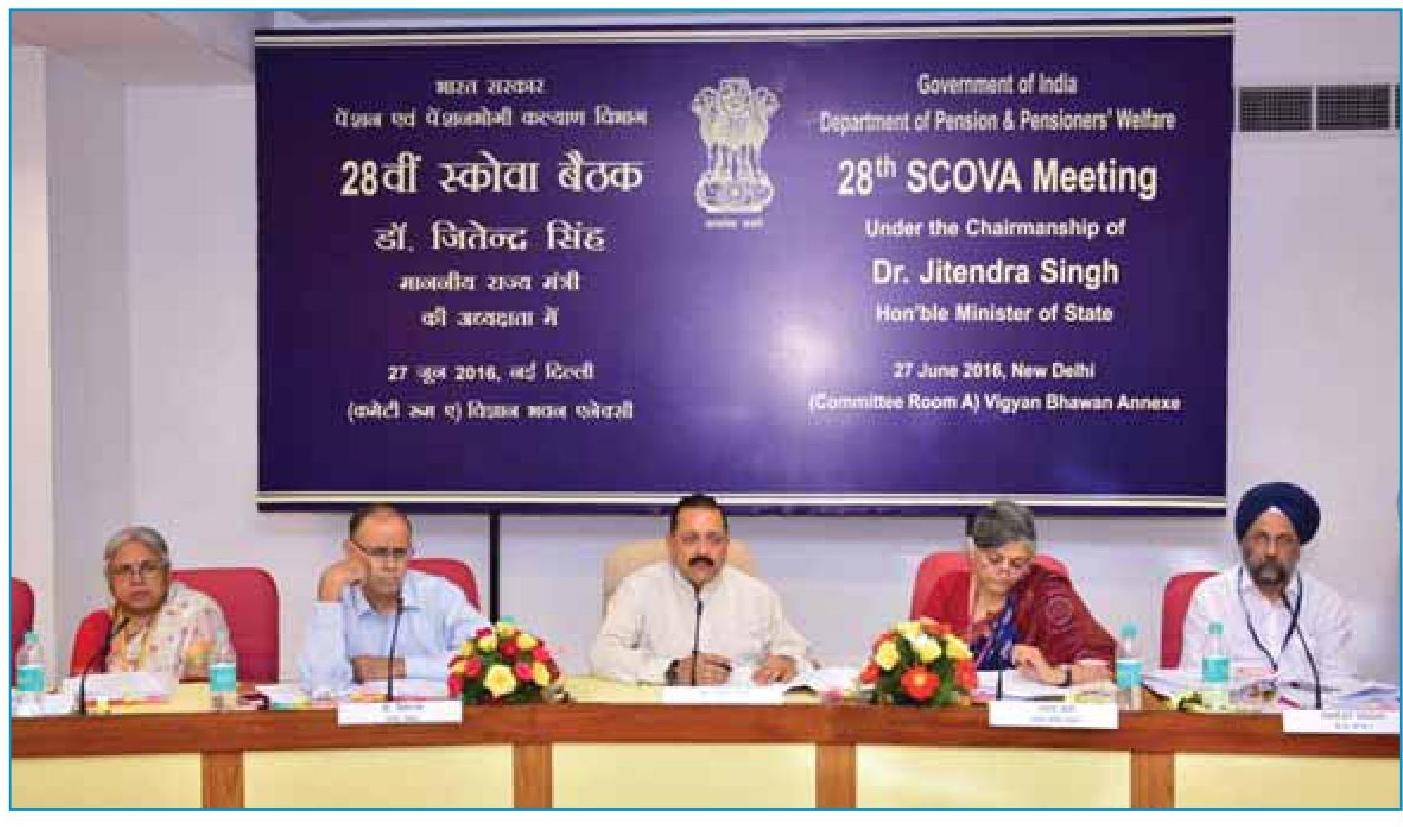
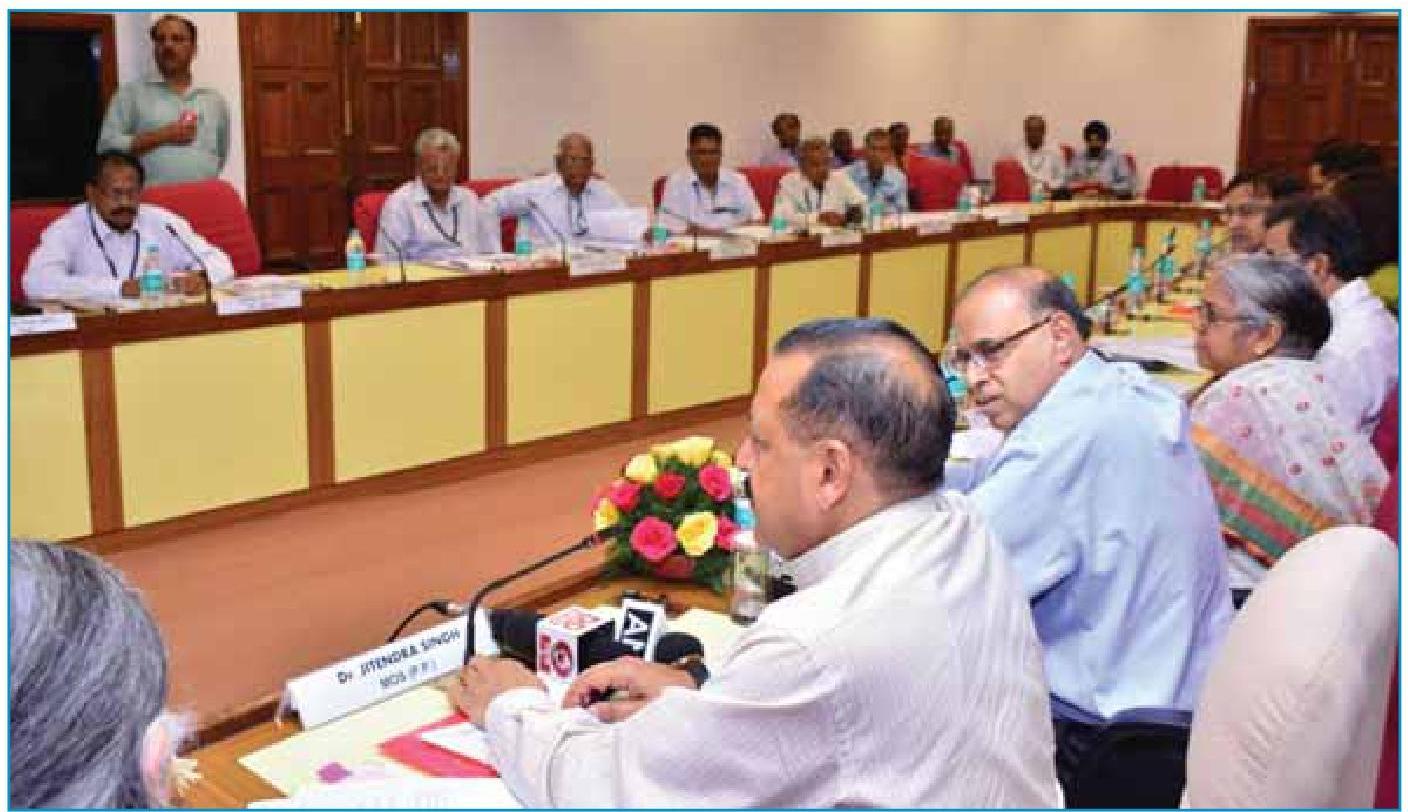
Dearness Relief to Pensioners/Family Pensioners:
27.5 Revised rates of Dearness Relief (DR) to Central Government Pensioners/Family pensioners on implementation of decision taken on recommendation of 7th CPC are admissible at following rates:-
| Date from which payable |
Rate of Dearness Relief per month |
|---|---|
| From 01.01 .2016 | No Dearness Relief |
| From 01.07 .2016 | $2 %$ of Basic Pension/ Family Pension |
For the convenience of all Ministries/ Departments and Banks/Treasuries/ Post Offices, orders are hosted on the website of this Department. This facilitates faster payment of enhanced DR by Pension Disbursing Authorities.
The process has been streamlined to ensure that enhanced DR orders are issued with a minimum time lag with reference to the orders for enhancement of D.A.
27.6 New Initiatives of the Department
(i) Sankalp
There are close to 40,000 fresh retirees from the Central Civil category every year. Given that the average life expectancy today is 69.2 years, whereas the age of retirement is 60 , it is apparent that a Government servant will have many years of active life left after retirement which could be fruitfully directed towards contribution to Society. A number of pensioners feel the loss of a daily routine as well as a feeling of not being wanted.
Keeping these factors in mind a new initiative called Sankalp has been taken up to
channelize experience and skill of retiring and retired Government servants towards meaningful interventions in Society. 19 Pensioners associations, 1964 pensioners and 16 organizations have been registered under Sankalp.
Under this initiative the Department is also conducting Pre-Retirement Counseling Sessions (PRCs) for employees retiring in near
future. 31 PRCs have been conducted till date which benefited 2463 retiring/retired personnel of various Ministries and Departments of Government of India. PRC covers aspects relating to timely payment of pension and processing formalities, CGHS benefits available to pensioners, investment options, preparation of Will and post retirement voluntary effort.
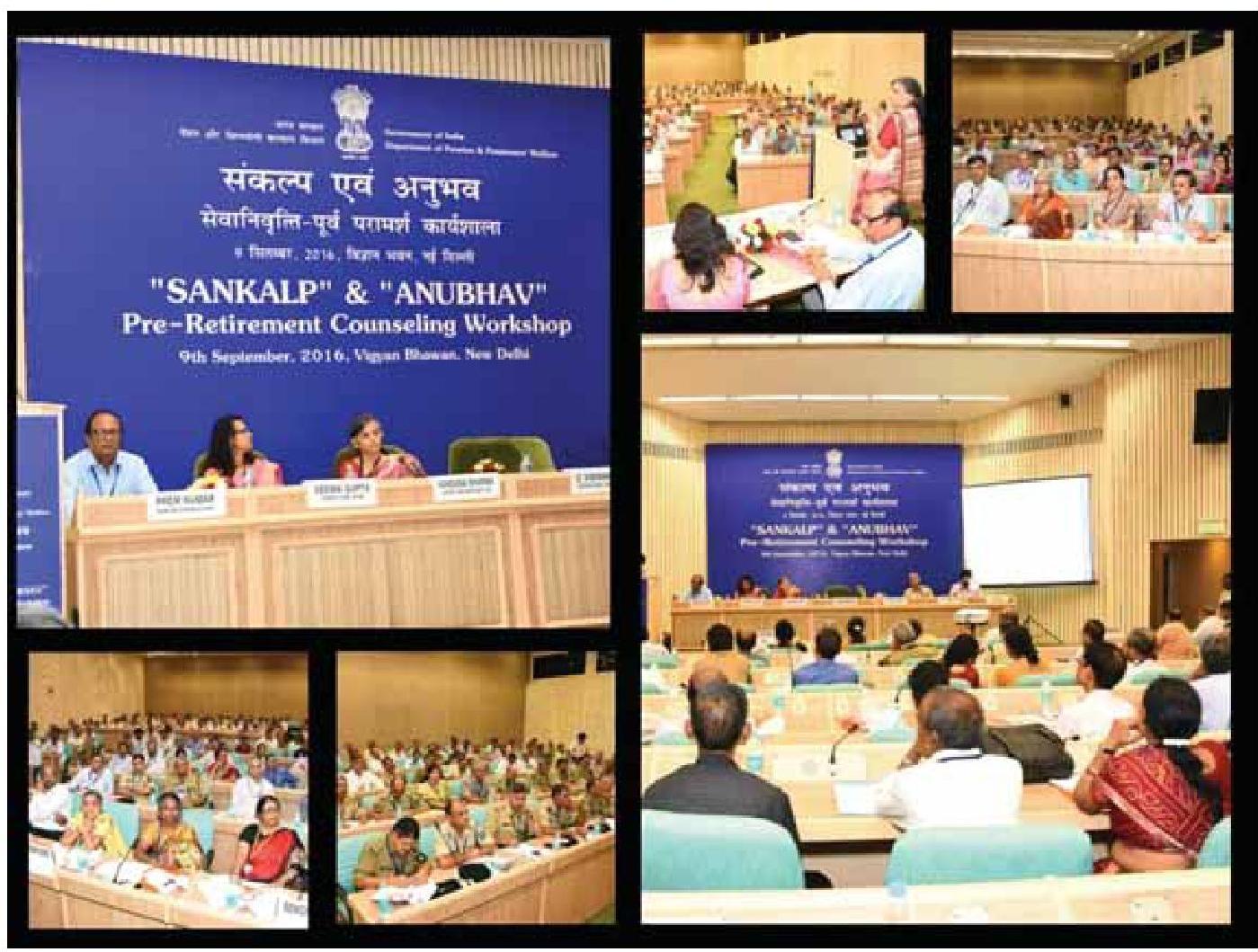
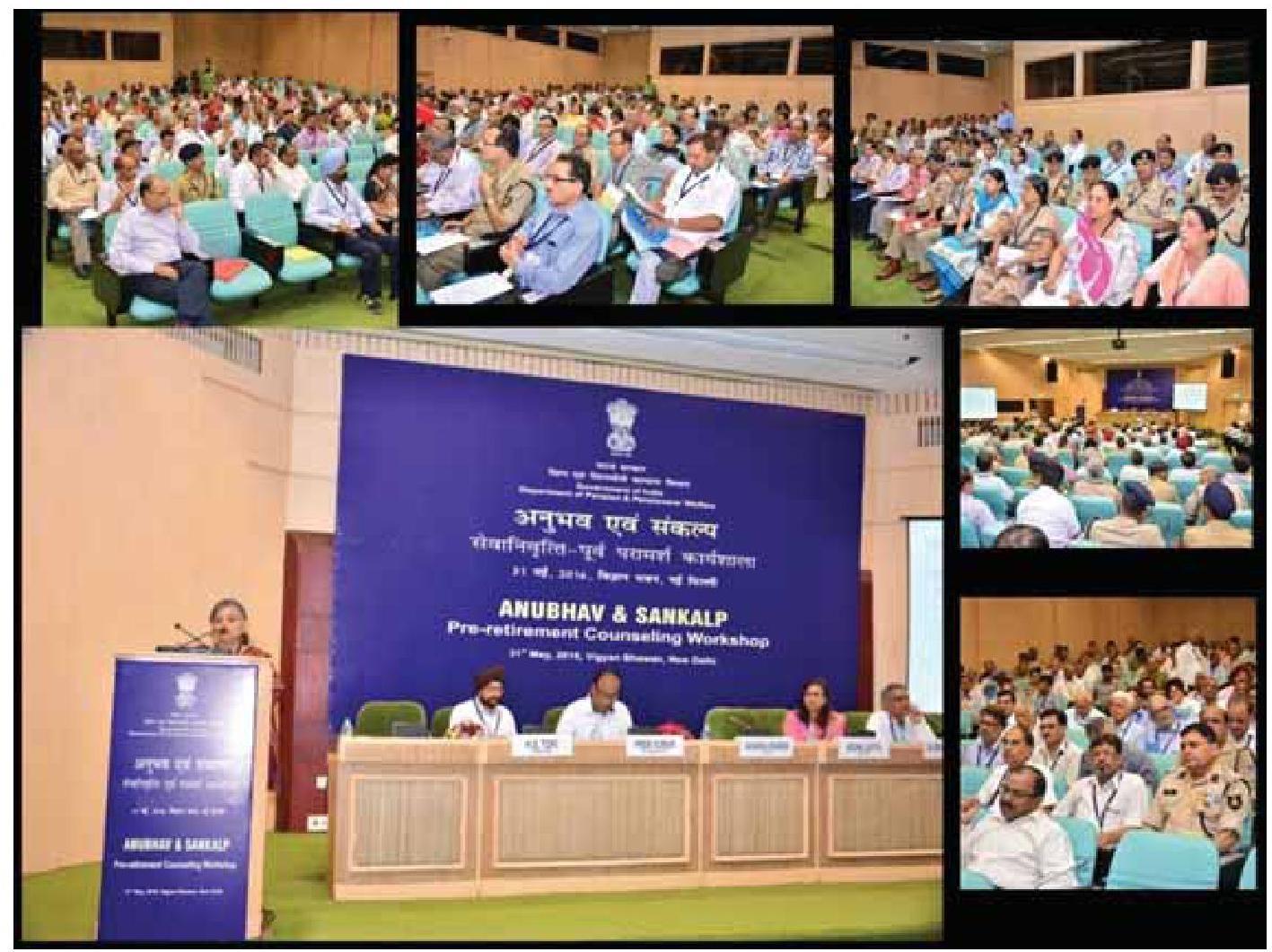
‘Training of Trainers’ on conduct of PRCs has been initiated to strengthen in house capabilities of Government Ministries/Departments to conduct Pre-retirement counseling for their retiring employees. The Department has conducted 07 ‘Training of Trainers’ workshops till date creating a pool of around 502 trainers.
The Department has also “adopted” 11 MCDs Schools for improvement of quality of education and environment of the Schools. Pensioners registered with SANKALP have volunteered for this activity. The Department has forwarded a list of Central Government Civil Pensioners registered under ‘Sankalp’ to various
Regional Centers at Staff Selection Commission who have detailed them for invigilation and Flying Squad duties in the Combined Graduate Level Exam, 2016. These pensioners will be engaged by SSC for duties in the forthcoming exams also.
(ii) Bhavishya -Online Pension Sanction and Payment Tracking System
Department of Pension & Pensioners’ Welfare has launched Bhavishya – an online system for tracking progress of pension sanction and payment. By keeping track of the progress as well as close monitoring of each pension case, it introduces transparency and accountability into
the system thereby plugging delays. The system benefits the retiring employees, pensioners and the Government authorities equally. The system allows online filing of application for pension by the retiring employees encapsulates the Pension Rules required for processing pension cases and generates all forms necessary for finalizing pension cases as well as reports needed for monitoring by the Departments.
In order to enforce accountability and transparency in all offices of Central Government Ministries/Departments except Railway, Defence, Post & Telecommunication, Bhavishya has been made mandatory for processing Pension cases w.e.f. $01 / 01 / 2017$.
(iii) Anubhav
On the directions of the Hon’ble Prime Minister of India, Department of Pension \& Pensioners’ Welfare has launched an online software, ‘Anubhav’ for sharing experiences of working with the Government. It is envisaged that over a period of time this will create a wealth of institutional memory with replicable ideas and suggestions. This tool in addition, gives opportunity to the retiring employees to invest his
experience, skill and time for growth of social capital of the country.
Instructions for use of this application have been issued vide OMs No. 4/2/2014-P\&PW (Coord.) dated 19.02.2015 \& 05.03.2015.
To create awareness and to sensitize the Ministries/Departments, following steps have been taken by the Department: –
- Workshop for the officers \& Head of Offices organized on 24/3/2015, 24/4/2015, 25/5/2015 and 26.11.2015.
- Combined work shop for retirees and the Head of Department on $19^{\text {th }}$ February, 2016 with participation of 375 , on $31^{\text {st }}$ May, 2016 with participation of 400 and $9^{\text {th }}$ September, 2016 with a participation of 300 at Vigyan Bhawan.
To encourage submission of write-ups an annual award scheme has also been launched. For the write-ups submitted up to February 2016 six awards were given away by Hon’ble Minister in the workshop held at Vigyan Bhawan on $19^{\text {th }}$ February, 2016. An independent agency Indian Institute of Public Administration (IIPA) was engaged for evaluating the published write-ups.
| $1^{\text {st }}$ Prize | Shri Pratap Kumar Panigrahi | Sr. Dy. Director General (BW), Department of Telecommunication |
|---|---|---|
| $2^{\text {nd }}$ Prize | Shri Natrajan A | Senior Section Engineer/Signal/HQ Railways |
| $3^{\text {rd }}$ Prize | Shri M. Balaraj | DRTC, Technical Officer ‘C’ Department of Defence Research \& Development (DRDO) |
Special Prize
| 1 | Shri Alok Rawat | Secretary (ARPG \& Pension) |
|---|---|---|
| 2. | Shri Jai Narain | Postman, Department of Posts |
| 3. | Shri Ravinder Kumar Sharma | Sr. Commandant, CISF |
Anubhav & Sankalp Workshop prize distribution on 19 February, 2016
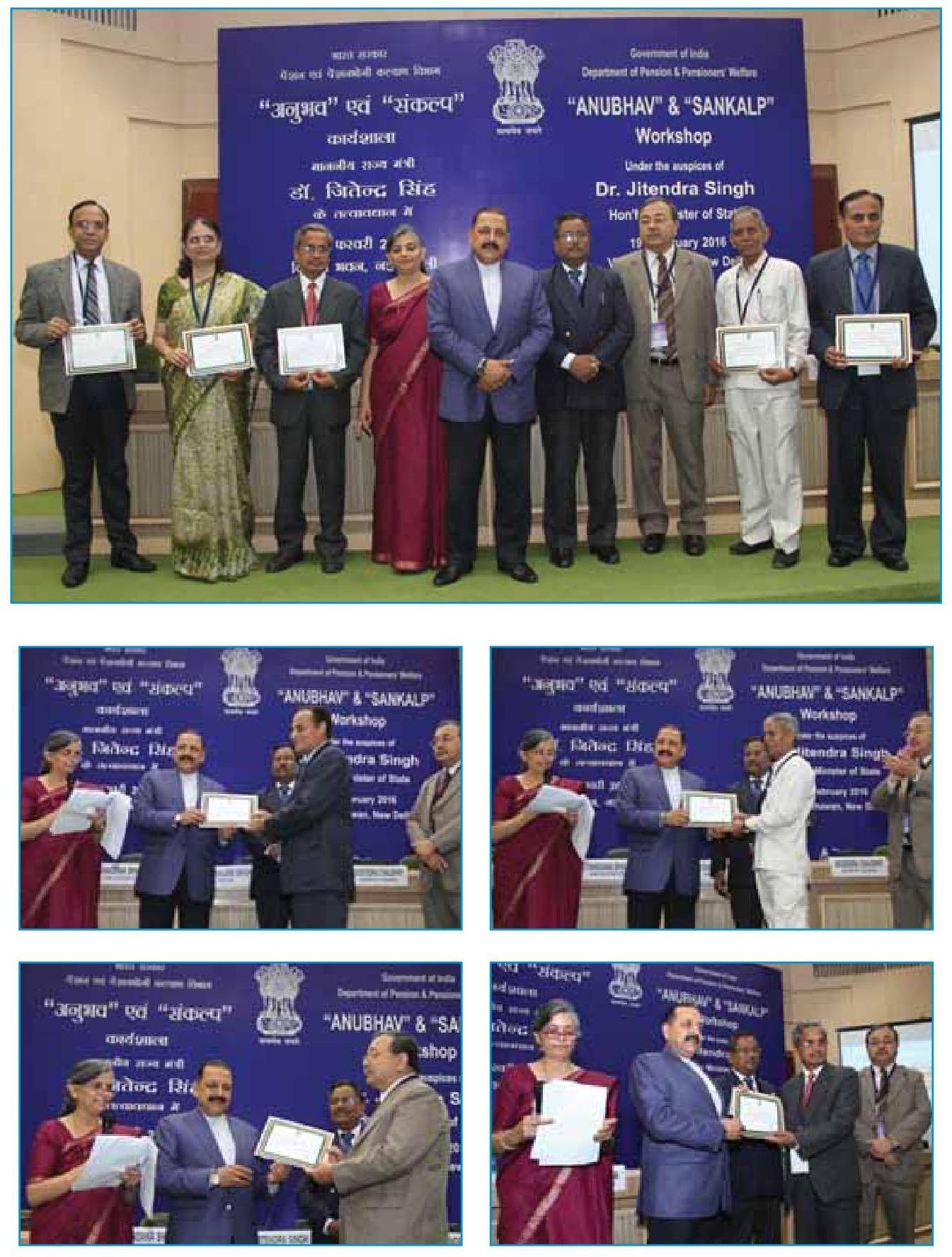
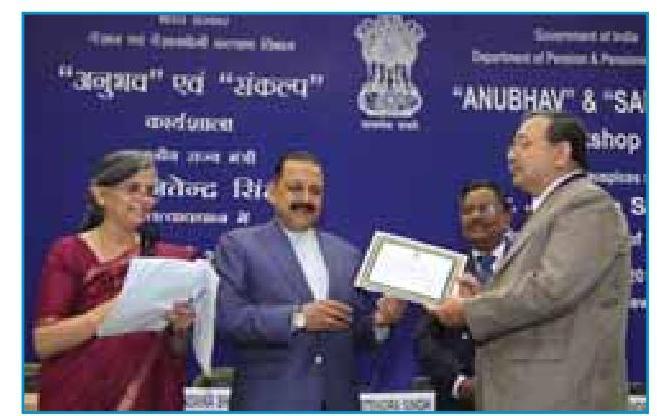
Ministries/ Departments have been requested to conduct workshops on ‘Anubhav’ for their retiring employees to facilitate upload of write-ups.
89 organizations have registered, 2693 write-ups have been published and 946 write-ups which have been uploaded are waiting to be published as on 18.01.2017.
(iv) Jeevan Pramaan
An Aadhar based scheme for online submission of digital life certificate was launched by the Hon’ble Prime Minister in November, 2014. The scheme benefits pensioners specially the old and infirm who can submit life certificate from the comfort of their homes anywhere in the country or abroad. 8.7 lakh pensioners availed this facility through banks from $1^{\circ}$ November, 2016 to $30^{\text {th }}$ December, 2016. The efforts made by the Department towards this include:-
(i) Meetings with Pensioners’ Associations
(ii) Participation in weekly video conferences conducted by the Department of Financial Services with the CMDs of Banks
(iii) Coordination with CMDs and the Heads of Central Pension Processing Centres for sensitising them while collecting information.
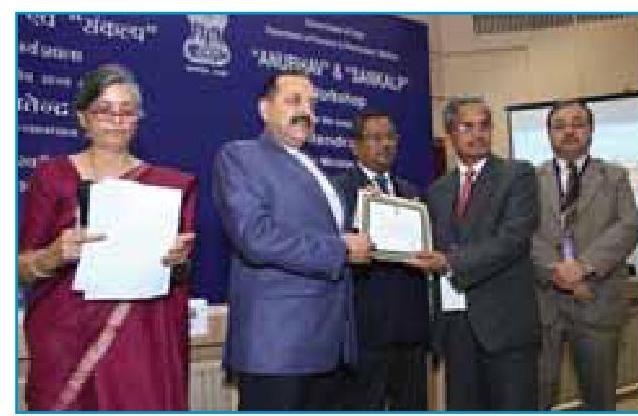
(iv) Departments of Posts, Telecommunication, Defence and Chairman, Railway Board were approached to garner their support in voluntary seeding of Aadhaar numbers.
(v) Video Conference with the District Authorities of many districts at the highest level.
(vi) The Call Centre set up by the department contacted most of the pension disbursing branches of banks and sensitized their staff about voluntary Aadhaar seeding.
(vii) Secretary’s DO letter to Chief Secretaries of all States/UTs to guide the district authorities to give all possible help to the banks at the district level in reaching out to and sensitizing the pensioners for voluntary seeding of pension accounts with Aadhaar numbers.
(viii) Publicity through audio, visual and print media to reach out the pensioners.
(xi) A team of Officers led by Joint Secretary visited the Zonal Offices and pension disbursing branches of various banks in Lucknow, Kanpur, Patna and Gaya to understand the problems being faced by the pensioners as well as the bank branches in seeding pension accounts.
The pension bank accounts seeded with Aadhaar numbers increased from $47 %$ as on 1st January, 2016 to above $88 \%$ as on 30th December, 2016.
(v) Other Initiative(s)
Instructions have been issued to all Ministries/departments to issue printed Plastic Identity Cards to the retiring employees with state emblem. In the Department of Pension & Pensioners’ Welfare a PVC Thermal printer has been procured for issuing Plastic Identity Cards to the employees retiring from Department of Pension \& Pensioners’ Welfare, Department of Personnel \& Training, DARPG and Department of North-Eastern Region.
Handling of various references and Centralised Pension Grievance Registration and Monitoring System (CPENGRAMS)
27.7 The Department of Pension \& Pensioners’ Welfare, being the nodal Department for pension and pension related matters, receives large number of references from Ministries/ Department/PSUs, etc. The Department renders advice on interpretation of Pension Rules and considers cases referred by Ministries/ Departments for relaxation of the provisions of Pension Rules.
27.8 The Department of Pension \& Pensioners’ Welfare has implemented the improved version of CPENGRAMS which integrates with the data base of Centralized Public Grievances Redressal and Monitoring System (CPGRAMS) under the administrative control of Department of Administrative Reforms \& Public Grievances. With this version, pension related grievances get
combined with public grievances and thus the Ministries/ Departments do not have to monitor grievances through two different applications.
27.9 During the period under report concerted effort were made to bring down the pendency of old grievances while maintaining the quality in disposal for which regular review meetings were held with the Nodal Officers of various Ministries/ Departments. As a result, 22847 grievances were disposed off during 01.04.2016 to 18.01 .2017 as compared to 19885 in the previous year ( 01.04 .2015 to 31.03 .2016 ).
The time limit to redress grievances is 60 days. During the period 01.04.2016-31.12.2016, $84.7 \%$ grievances were disposed of within 60 days as compared to $75.2 \%$ during the previous year ( 01.04 .2015 to 31.03 .2016 ).
Advertisement and Publicity
27.10 During the year under report, the Department sought a special additional allocation of Rs.2.66 crores for running a publicity campaign in print and electronic media. The aim was to sensitise Central Government Pensioners and family pensioners of their entitlements as well as new initiatives of the Government including submission of Annual Life Certificate in digital mode through Jeevan Pramaan. Advertisement was published in national and regional dailies across the country. A musical jingle was broadcast for a number of days over various radio channels. An advertisement video clip on Jeevan Pramaan was telecast on TV channels.
27.11 One training session was organized for officers of 26 Ministries/Departments to apprise them of latest changes in the Pension Rules.
Implementation of the Recommendations of 7th Central Pay Commission (CPC)
27.12 For Employees retired/retiring on or after 1.1.2016
Orders were issued on 4.8.2016 for regulating pension/gratuity/commutation of pension/family pension/disability pension/ex-gratia lump sum compensation, etc. of employees retired/retiring on or after 1.1.2016. In accordance with the above order:-
(i) There is no change in the pension fixation formula for those retired/ retiring on or after 1.1.2016.
(ii) The minimum pension would be Rs.9,000/- per month as against existing minimum pension of Rs.3,500/- per month.
(iii) The ceiling of gratuity has been increased from the existing Rs. 10 lakhs to Rs. 20 lakhs
(iv) A new slab of death gratuity has been added. The family of a Government servant dying while in service with a qualifying service of 11-20 years would be entitled to death gratuity @ 20 times of monthly emoluments as against the existing entitlement of 12 times of emoluments.
(v) The rates of ex-gratia lump sum compensation being paid to the families of employees who die in performance of duty has been increased from existing 10-15 lakhs to Rs.25-45 lakhs, depending upon the circumstances in which the death occurs.
27.13 For Pre-2016 Pensioners
Separate orders have been issued on 4.8.2016 in implementation of Government’s decisions on the recommendations of the Seventh Central Pay Commission for revision of pension of pre-2016 pensioners/family pensioners. In accordance with the above order, the pension as had been fixed at the time of implementation of the 6th CPC recommendations shall be multiplied by 2.57 for arriving at a figure of revised pension w.e.f. 1.1.2016.
7th CPC also recommended another option for revision of pension of past pensioners by notionally fixing the pay by giving the benefit of increments earned by the retiree in the scale from which he/she retired before 1.1.2016. The Govt. has decided that this option may be made applicable if its implementation is found feasible after examination by a Committee comprising Secretary (Pension) as Chairman, Member (Staff) Railway Board, Member (Staff) Department of Posts, AS&FA, Ministry of Home Affairs and CGA as Member. A Committee was accordingly constituted on 17.8.2016 to examine the feasibility of this Option. The committee has since submitted its report.
Compendium
27.14 Two compendiums on Pension related Orders issued during the year – 1.4.2014 to 31.03 .2015 \& 01.04 .2016 to 24.10 .2016 were published. These are also available on the Department’s website at the pensionersportal.gov.in and persmin.gov.in/ pension.asp.
27.15 The following important policy decisions were also taken during the year 2016 :-
(i) Orders were issued vide O.M. No. 38/37/08P&PW (A) dated 6.4.2016 providing that the revised consolidated pension of pre2006 pensioners shall not be lower than $50 %$ of the minimum of the pay in the Pay Band and the Grade Pay (wherever applicable) corresponding to the prerevised pay scale as per fitment table without pro rata reduction of pension even if they had qualifying service of less than 33 years at the time of retirement.
(ii) Instructions have been issued to all Ministries/Departments vide O.M. No.4/38/2008-P\&PW (D) dated 17.02.2016 and 04.08.2016 for increase in pension w.e.f. 01.01.2006 for the purpose of Dearness relief and additional pension for old pensioners, of absorbees who had drawn lump sum payment on absorption in Central Public Sector Undertakings/ Central /Autonomous Bodies and are in receipt of $1 / 3$ rd restored.
(iii) Option regarding commutation of additional amount of pension: As a recent policy initiative, it has been decided that the pensioners who retired from 01.01.2016 till 04.08 .2016 i.e the date of issue of orders for revised pay/pension based on the recommendations of the 7th CPC may be given an option, in relaxation of Rule 10 of CCS(Commutation of Pension) Rules 1981, not to commute the pension which has become additionally commutable on revision of pay/pension on implementation of recommendation of 7th CPC. The orders in this regard were
issued vide this Department’s O.M. No. 42/14/2016-P\&PW (G) dated 24.10.2016.
(iv) Order were issued vide O.M. No. 7/5/2012P\&PW (F)/B dated 26.08.2016 to extend the benefits of ‘Retirement Gratuity and Death Gratuity’ to the Central Government employees covered by new Defined Contribution Pension System (National Pension System).
27.16 Due compliance of the orders and instructions pertaining to the reservations of vacancies in favour of SC/STs and welfare of minorities issued by the government from time to time is ensured. A complaint committee to enquire into complaints of sexual harassment at work place has been constituted. There has been no complaint of sexual harassment during the period under report.
Hindi Pakhwara
27.17 A Hindi Pakhwara was organized by the Department in the month of September, 2016 to inculcate the spirit of use of Hindi in official noting drafting and communications. Competition in essay writing and noting \& drafting was organized for the staff members and suitable awards were given as incentive. Awards were also given for promoting dictation and Noting/drafting work by officials in Hindi.
Swachhta Pakhwada
27.18 This Department implemented Swachhta Pakhwada from $16^{\text {th }}$ May- $31^{\text {st }}$ May, 2016 and $1^{\text {st }}$ December, 2016 to $15^{\text {th }}$ December, 2016. During these Pakhwadas identified Pensioners Associations sensitized their neighbourhood. An extra drive of cleanliness of department premises was also carried out.
ANNEXURES
Annexure – I
Department of Personnel and Training
Incumbency Position of Group ‘A’ Officers in D/o Personnel and Training as on 01.01.2017
| Post | Name of Incumbent |
|---|---|
| Secretary(Personnel) | Shri B.P.Sharma |
| Additional Secretary | Shri Rajiv Kumar |
| Shri T. Jacob | |
| Joint Secretary | 1. Ms. Archana Varma |
| 2. Shri Jishnu Barua | |
| 3. Shri Devesh Chaturvedi | |
| 4. Shri G. Dev Tripathi | |
| Director | 1. Shri Anand Madhukar |
| 2. Shri Ashish Kumar | |
| 3. Ms. Gayatri Mishra | |
| 4. Smt. G. Jayanthi | |
| 5. Shri J. Srinivasan | |
| 6. Ms. Kimbuong Kipgen | |
| 7. Shri Mukesh Chaturvedi | |
| 8. Shri Mukul Ratra | |
| 9. Shri N. Sriraman | |
| 10. Ms. Pratima Tyagi | |
| 11. Shri Rakesh Kumar | |
| 12. Ms. Sumita Singh | |
| 13. Shri Sandeep Jain | |
| 14. Shri Subramanya M.S. Rao | |
| 15. Shri Utkaarsh R.Tiwaari | |
| 16. Shri V. K. Sinha | |
| 17. Shri N. Raja | |
| Principal Staff Officer | 1. Shri Neeraj Sagar |
| 2. Ms. Kusuma Padmanabhan |
| Post | Name of Incumbent |
|---|---|
| Deputy Secretary | 1. Shri A.K.Saha |
| 2. Shri Ashok Kumar Jain | |
| 3. Ms. Kavitha V. Padmanabhan | |
| 3. Shri Rajender Kumar | |
| 4. Shri B.V.R.C.Purushottam | |
| 5. Shri Sanjiv Kumar | |
| 6. Shri C.A.Jacob | |
| 7. Shri A.N.Narayanan | |
| 8. Shri Suresh Kumar | |
| 9. Shri G. Srinivasan | |
| 10. Shri Ashish Madhaorao More | |
| Senior Principal Private Secretary | 1. Shri S.C.Baweja |
| 2. Shri Satish Kumar Thakur | |
| 3. Smt. Harbhajan Kaur Gill | |
| 4. Shri Rajender Singh | |
| Principal Private Secretary | 1. Shri Ramesh Chand |
| 2. Shri Harish Kumar Chawla | |
| 3. Shri Krishna Kain | |
| 4. Shri Panna Lal | |
| 5. ShriYati Raj Sehgal | |
| 6. Shri Girish Kumar Ahuja | |
| 7. Shri P. Suresh | |
| 8. Shri R.K.Malhotra | |
| 9. Shri Munesh Chand | |
| Under Secretary | 1. Shri Anil Tripathy |
| 2. Shri Amit Srivastava | |
| 3. Shri Ajit Kumar | |
| 4. Shri Anil Bajpai | |
| 5. Shri Amit Srivastava |
| Post | Name of Incumbent |
|---|---|
| 6. Shri Arvind Thakur | |
| 7. Shri Avinash Chandra | |
| 8. Shri Anand Upadhyay | |
| 9. Shri Biswajit Banerjee | |
| 10. Shri Chattra Mani | |
| 11. Shri C.Ganesh Kumar | |
| 12. Shri Chandra Shekhar | |
| 13. Shri Chirabrata Sarkar | |
| 14. Shri Debabrata Banerjee | |
| 15. Shri Debabrata Das | |
| 16. Ms. Gracy Varghese | |
| 17. Shri I.P.Nagpal | |
| 18. Ms. Jayashree Chellamani | |
| 19. Shri Kamal Kishore | |
| 20. Shri K. Prakasham | |
| 21. Shri Kulbhushan Malhotra | |
| 22. Shri K.Salil Kumar | |
| 23. Shri K.C. Raju | |
| 24. Shri K. Srinivasan | |
| 25. Shri K. Srinivasan | |
| 26. Shri Lalan Prasad Sharma | |
| 27. Ms. Majula Juneja | |
| 28. Shri Madan Mohan Maurya | |
| 29. Shri Manoj Gupta | |
| 30. Shri Md. Nadeem | |
| 31. Shri Navneet Mishra | |
| 32. Shri O.P.Chawla | |
| 33. Shri P.K. Jaiswal | |
| 34. Shri P.K. Pattanaik |
| Post | Name of Incumbent |
|---|---|
| 35. Ms. Preeti Khanna | |
| 36. Shri Pankaj Gangwar | |
| 37. Shri Prem Chand | |
| 38. Shri Pushpender Kumar | |
| 39. Shri Poulose E.V. | |
| 40. Shri R.K. Nagpal | |
| 41. Shri R. Venketasan | |
| 42. Shri Rajesh Sharma | |
| 43. Shri Rajeshwar Lal | |
| 44. Shri Rajesh Kumar Yadav | |
| 45. Shri Raj Kishan Vatsa | |
| 46. Shri Raju Saraswat | |
| 47. Shri Subandu Basu | |
| 48. Shri S.P.R.Tripathi | |
| 49. Shri Sunil Kumar Mandi | |
| 50. Shri S. K. Prasad | |
| 51. Shri Sanjay Mehta | |
| 52. Shri Surya Narayan Jha | |
| 53. Ms. Sarita Nair | |
| 54. Shri Syed Imran Ahmed | |
| 55. Shri Sukdeo Sah | |
| 56. Shri Uday Bhan Singh |
Annexure – II
ORGANIZATION CHART OF DEPARTMENT OF ADMINISTRATIVE REFORMS AND PUBLIC GRIEVANCES AS ON 31 DECEMBER, 2016
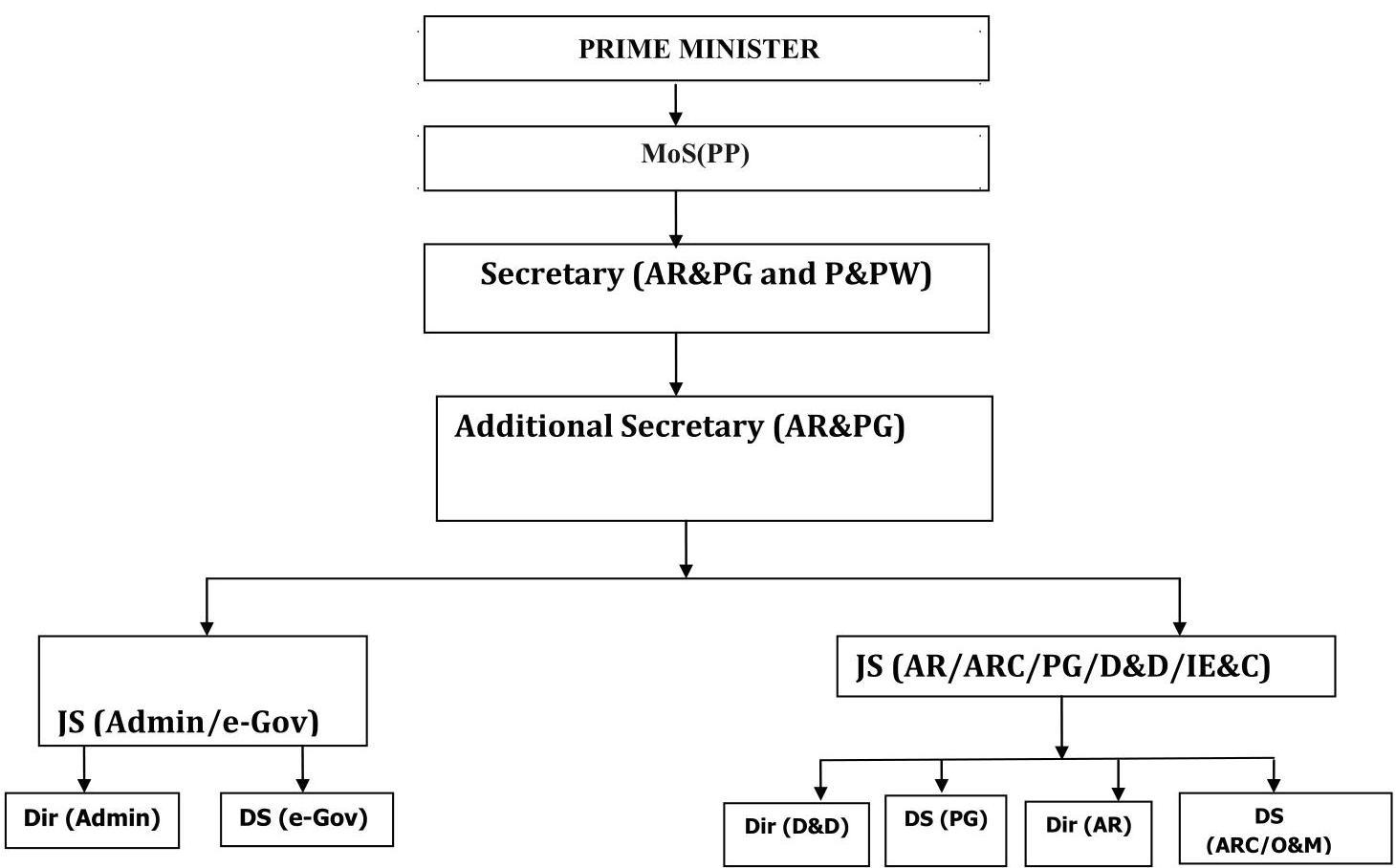
Annexure – III
Department of Administrative Reforms and Public Grievances
Incumbency Position of Under Secretary and above level Officers in D/o AR&PG as on 31.12.2016
| Post | Name of Incumbent |
|---|---|
| Secretary | Shri C. Viswanath |
| Additional Secretary | Ms. Usha Sharma |
| Joint Secretary | 1. Ms. Smita Kumar |
| 2. Ms. Kiran Puri | |
| Director | 1. Smt. Alpana Shukla Rao |
| 2. Shri Vanraj A. Chavda | |
| 3. Smt. Richa Gaharwar | |
| Deputy Secretary | 1. Shri Anurag Srivastava |
| 2. Smt. Sumita Dasgupta | |
| 3. Shri Raj Kumar | |
| Under Secretary | 1. Ms. Renu Arora |
| 2. Ms. Vibhuti Panjiar | |
| 3. Ms. Prisca Mathew | |
| 4. Shri Ajit Kumar Sah | |
| 5. Shri S.Bandyopadhyay | |
| 6. Shri Hemant Verma | |
| 7. Shri Jitendra Sihwag | |
| 8. Shri Din Dayal | |
| 9. Shri Jagdish Kumar Ambwani | |
| 10. Shri Dhananjay Kumar | |
| 11. Shri Pramod Bhardwaj | |
| 12. Smt. Pratibha Ahuja | |
| 13. Shri Khamchin Naulak | |
| 14. Shri Arun Kumar Sarkar | |
| 15. Shri Gya Prasad | |
| 16. Shri Alok Jagbharia | |
| PPS | 1. Shri A. Y. Anand Raj |
| 2. Shri Satish Kumar |
Annexure – IV
Department of Administrative Reforms and Public Grievances
Prevention of sexual harassment of women at work place
An Internal Complaint Committee has been constituted in Department of Administrative Reforms and Public Grievances for prevention of sexual harassment of women at work place comprising of following members:
(i) Smt. Smita Kumar Joint Secretary
- Chairperson
(ii) Shri. Anurag Srivastava, Deputy Secretary – Member
(iii) Mr. Prisca Methew, Under Secretary - Member
(iv) Ms. Hazel Siromoni, representative sponsored by YWCA - Member
Women employees are being made aware of existence of said Committee from time to time through circulars, display on notice boards and interactions. No complaint of sexual harassment from any of the women employees has been received during the year. However, to review the overall condition of working environment for women, the Committee met last time on 14.06.2016 and also decided to have regular interaction with women to give them comfort and security
Annexure – V
Department of Administrative Reforms and Public Grievances
Welfare of SC, ST, OBC and Person with Disability (PWD)
As on 31.12.2016, the incumbency position of SC, ST, OBC and Person with Disability (PWD) in the Group A, B and C category of Officials of Department of Administrative Reforms and Public Grievances is as under:
| Category | Total | SC | ST | OBC | PWD |
|---|---|---|---|---|---|
| Group-A | 27 | 3 | 2 | — | — |
| Group-B | 54 | 6 | 2 | 6 | $1(\mathrm{OH})$ $1(\mathrm{HH})$ |
| Group-C | 19 | 14 | — | — | — |
| 100 | 23 | 4 | 6 | 2 |
The Department has appointed a Nodal Officer to look into the complaints/ representations, if any received from SC, ST and OBC officials and as also to watch their welfare. As per instructions of DoPT, the Department is submitting annual report regarding SC, ST, OBC and PWD incumbents online through the URL “rrcps.nic.in”. No complaint from SC, ST, OBC and PWD officials is received during the year.
Annexure – VI
Department of Pension and Pensioners’ Welfare
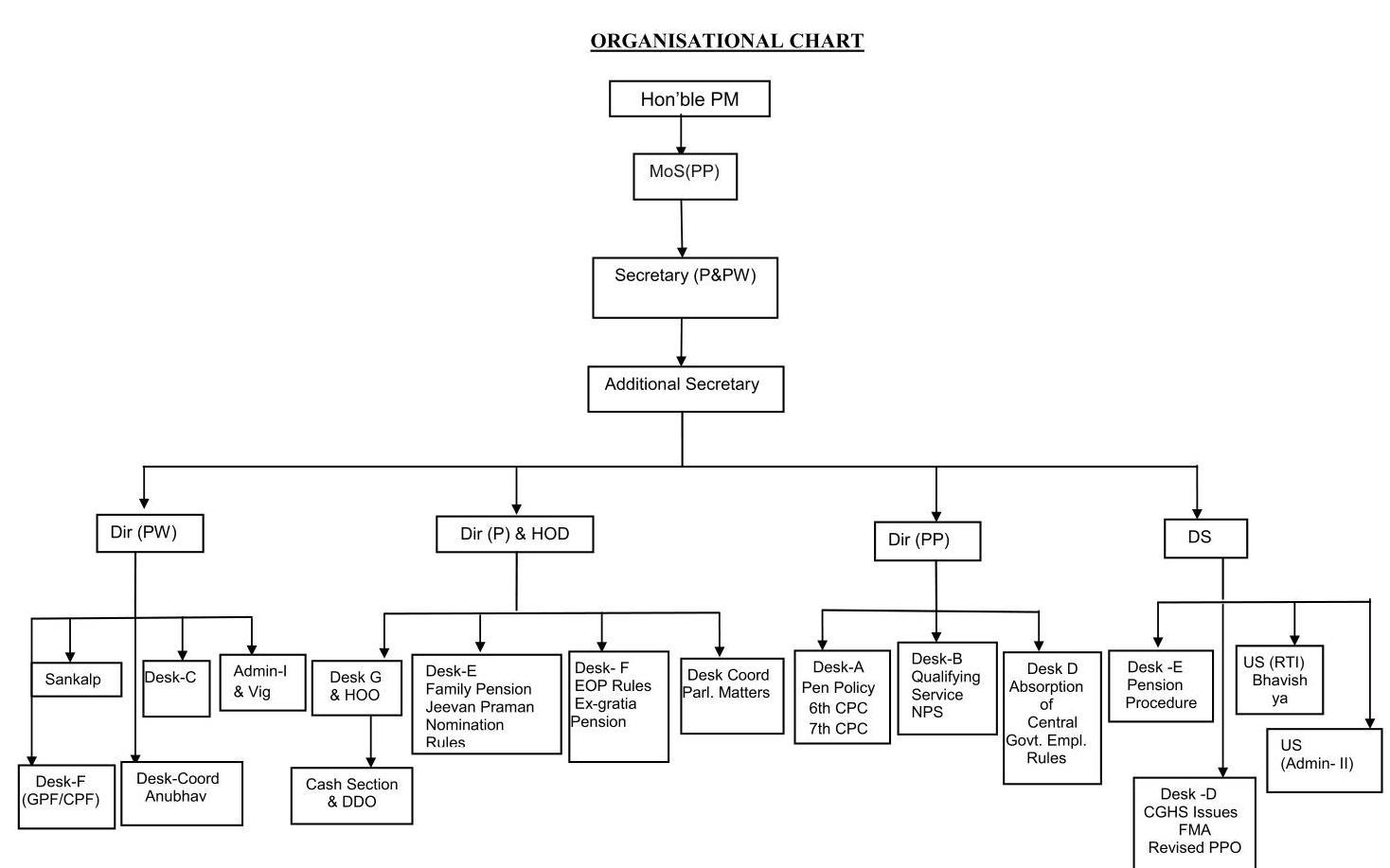
Annexure – VII
Incumbency position of Group ‘A’ Officers in D/o Pension & Pensioners Welfare as 08.12.2016
| Post | Name of the incumbent |
|---|---|
| Secretary | Shri C.Viswanath |
| Additional Secretary | Smt. Vandana Sharma |
| Director | Smt. Seema Gupta |
| Shri Harjit Singh | |
| Smt. Sujasha Choudhury | |
| Deputy Secretary | Shri Sanjay Wadhawan |
| Under Secretary | Shri D.K.Solanki |
| Shri S.K.Makkar | |
| Shri Charanjit Taneja | |
| Shri Manoj Kumar | |
| Shri S.Chakrabarti | |
| Shri Sanjoy Shanker | |
| Shri Ashok Kumar Singh | |
| Shri T.C.Verghese | |
| Shri Subhash Chander | |
| Assistant Director(OL) | Ms. Pushpalata Kumari |
.
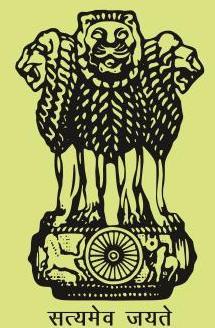
MINISTRY OF PERSONNEL, PUBLIC GRIEVANCES & PENSIONS GOVERNMENT OF INDIA
-
- Allocation against unreserved vacancies # Allocation in respect of one candidate is pending